"...I don't plan to cooperate with evil at any point."
Dr. Martin Luther King, January 14th, 1968
DR. ASPDEN'S RESEARCH
DR. ASPDEN'S RESEARCH
TOM BEARDEN'S REARCH
TOM BEARDEN'S RESEARCH
COSMIC CORE
THE BASICS
COSMIC CORE MENU
AXIS MUNDI
PRACTICAL APPLICATIONS - PART I
There are a great many New Age websites selling the new physics paradigm. It all sounds great and plausible. In fact, Quantum Physics makes
just about anything sound plausible, but I am looking for something tangible that can be engineered with today's materials and technology.
Over-Unity Devices are machines that inventors claim output more energy than they consume.
Perpetual Motion Machines have a long, sordid history going back centuries.
However, all pseudoscience claims and criticisms need to be examined in the light of my two favorite theories about the ubiquitous electron.
One-Electron Universe
The one-electron universe postulate, proposed by John Wheeler in a telephone call to Richard Feynman in the spring of 1940, is the hypothesis
that all electrons and positrons are actually manifestations of a single entity moving backwards and forwards in time.
Black Hole Electron
In physics, there is a speculative hypothesis that if there were a black hole with the same mass, charge and angular momentum as an electron,
it would share other properties of the electron.
So, one day, John Wheeler, a founding father of modern physics and Richard Feynman, a winner of a Nobel Prize in Physics, are on a phone chat
considering that one single electron filled the entire universe and was bouncing back and forth in time
from The Past to The Future, and back again, over and over.
I would have to say that this kind of conjecture, even though based on solid Nobel Laureate math, still sounds like Metaphysics.
In fact, Black Holes and Big Bang Singularities also based on solid math, still embrace the Metaphysical.
Where do you draw the line on informed speculation? Maybe pseudoscience critics can embrace the phrase, "the as yet unproven theory,
blah, blah, blah."
Now consider what is required for John Wheeler and Richard Feynman's speculation that electrons and positrons bounce back and forth in time. You need end points.
That is the only way a guitar string can vibrate. All vibrations need end points, a beginning and an end, and a medium to vibrate in.
A single vibration will eventually dampen when it is overcome by the viscosity of the medium in which it vibrates.
This is why we have electric bills.
It was once thought that there must be a Medium for vibrations to vibrate in, but somehow today's physicists say that
electromagnetic waves need no Medium. 19th century physicists believed that this was not possible, so they
called their hypothethical medium The Luminiferous Aether.
In the 21st century, The Luminiferous Aether has been replaced by The Active Vacuum, where all the particles
of our Shared Reality are born.
19th century physicists used the term The Luminiferous Aether, metaphysicians and psychics used the term
The Aether. This is not to denigrate metaphysicians and psychics, because as you will read, their information has shaped my point-of-view.
This very simple notion of a Medium seems to have escaped modern physicists. Plumbers have water,
electricians have copper lattice, and what theoretical physicists imagine is beyond my understanding.
In my job, I have to think about the physics of electrons working their way through a copper lattice.
It is all very physical and basic electrical theory applies.
Too many electrons, circuit breakers pop, not enough electrons, things never turn on, just some electrons,
logic states collapse into gray areas; the practical applications of the Electron are well-known.
A Room Temperature Superconducting Material is the Holy Grail in physics and electronics. Moving electrons in conducting materials
encounter resistance and generate heat and then dissipate the input energy.
When the losses become large enough, they overcome the input energy.
Superconducting Materials have little resistance to electrical currents and
thus could circulate forever in a coil. Most importantly, they reject the magnetic field that comes with all moving electrons.
But do we really understand what electrical current is?
There are a lot of crazy sounding theories out there about our Shared Reality. We can start at the top.
March 8, 2016
The universe is a hologram and other mind-blowing theories in theoretical physics
January 31, 2017
Theory claims to offer the first 'evidence' our Universe is a hologram
February 21, 2019
How Our Universe Could Emerge as a Hologram
Theoretical Physics is always exciting to think about, it is Starships, Time Machines, and perhaps even a Holographic Universe.
However, conventional physics requires that exotic materials must first be developed before faster-than-light space travel or time travel
can be realized.
These materials are needed to pry open wormholes, the infinitesimally small openings to time and space that appear
in The Active Vacuum.
Wormhole
A wormhole (or Einstein-Rosen bridge or Einstein-Rosen wormhole) is a speculative structure linking disparate points in spacetime, and is based on a special solution of the Einstein field equations. A wormhole can be visualized as a tunnel with two ends at separate points in spacetime (i.e., different locations, or different points in time, or both).
I suspect that the technology is already here to begin exploring some of the stranger concepts that the laws of modern physics allow. This why
the United States Navy is filing some very interesting patents lately.
April 18, 2019
Docs Show Navy Got 'UFO' Patent Granted By Warning Of Similar Chinese Tech Advances
April 18, 2019
The US Navy secretly designed a super-fast futuristic aircraft resembling a UFO, documents reveal
April 24, 2019
US Navy Patents a Triangular Aircraft Which Alters 'The Fabric of Our Reality'
October 15, 2019
Latest Navy "UFO Patent" is a Compact Fusion Reactor
October 19, 2019
Navy Patents UFO-Like Compact Nuclear Fusion Reactor And Hybrid Space/Sea Crafts
The most likely reason that the Navy has gone public with these new technology concepts and patents must be that the Commercial-Off-The-Shelf
(COTS) materials already exist to produce and control these stranger aspects of physical reality, such as the ability to manipulate time and space.
What the Navy has patented may be so basic to some of the unknown Laws of Physics that any research into these areas can now be legally challenged
by the claim of patent infringement. Therefore, I suspect less-than altruistic motives on the Navy's part in releasing these designs to the public.
I am one of those researchers who believe that electricity is really an asymmetry in time. In other words, every time a person turns on a lamp,
they are bending time and space to get electrons to move into a light bulb.
I have been following pseudoscience for a long time; in my freshman High School electronics class we were talking about Nikola Tesla.
That was 50-years ago this year in 2020.
After that long, you get of tired of reading and listening to The New Age Pablum that comes with Alternative Energy concepts
that challenge modern physics.
When I read or hear the term pseudoscience, I know it is being used as an insult and a whip of conformity. Whatever category that this
Website falls into, I just consider myself an Investigative Researcher into the nature of our Shared Reality.
I was lucky; I had good teachers when I was going to school. Most of them use to say, "There is no such thing as a bad question."
In the 1980s and 1990s, I was building and testing RL-10 rocket engines and the liquid hydrogen and liquid oxygen pumps for the space shuttle,
as well as getting invitations to climb around Atlas-Centaur rockets at Cape Canaveral.
It was a fellow rocketeer, also an Alternative Energy researcher,
who introduced me to the physics research of Tom Bearden.
I found the following pictures on the Internet. I know these two test stands on the left as well as any human being can; I worked on them for fourteen-years.
They have not changed in two-decades.
The picture on the right does not surprise me one bit.
I also once worked on the engine for the SR-71 spy plane, both production and experimental.
Many of the people I worked with built and tested the first throttleable liquid hydrogen rocket engine back in the 1950s.
There are a lot of unknown names that have contributed to the advance of aerospace science and humanity.

Is this the US Air
Force's secret 4,600mph spy plane?
Mystery 'hypersonic aircraft' is captured in Google Earth images of a Florida airbase, claims conspiracy theorist
That is no airbase. It is 64,000 acres of Florida swamp patrolled, back in the day, by men in white Broncos wearing nice suits who mysteriously appeared out
of nowhere when you were where you should not be.
Those were great, pioneering days, even working third-shift and fighting swamp mosquitoes while prepping rocket engines for test and listening
to Art Bell's radio program Coast to Coast AM in the background.
When I first heard Richard Hoagland being interviewed on Coast to Coast AM, I had already read everything that Tom Bearden had published
as well as having read Hoagland's bestseller, The Monuments of Mars. Bearden's work was the inspiration that made me go back to college.
Richard Hoagland's research has led me to discover the infamous ritual date of April 20th. Hoagland saw Nazis launching rockets for NASA;
I did a little more research and saw an International cabal who used that date, and the eve of that date, to murder people.
This has also led me to speculate on the spiritual aspects of Hoagland's Hyperdimensional Physics.
Hyperdimensional Physics suggests that ancient archeology on Mars may have been involved in energy production.
By analog and the ruins of many pyramids on Earth, that suggests that Earth and Mars have a shared past.
Hoagland's work sold me on The Ancient Astronaut Theory, which is probably better understood as the mythology behind Atlantis and Lemuria,
the two fabled lost civilizations in humanity's past. If, indeed, they were human civilizations.
Mars Anomalies
I think that there have been enough photographs from many NASA and European Space Agency Mar's platforms
that have validated Hoagland's original contention that an Egyptian-like monument building culture once existed on Mars.
Hubble's New "Runaway Planet":
A Unique Opportunity for Testing the Exploding Planet Hypothesis and... Hyperdimensional PhysicsPart I
Hubble's New "Runaway Planet":
A Unique Opportunity for Testing the Exploding Planet Hypothesis and ... Hyperdimensional Physics Part II
Art Bell
Richard Hoagland vs Tom Bearden - Hyperdimensional Physics
I completely understand the business motives behind Richard Hoagland's many big claims, the questionable results, the on-air arguments with Art Bell,
and all the Conspiracy Theory, Perpetual Motion Machine madness that goes hand-in-hand with this kind of material.
In the communications industry you have to stay relevant if you want to stay on the air. Even when most of the public will not understand the modest
successes of your experiments or theories, you still have to sell the small gains to earn a paycheck.
The Internet machine needs to be fed,
and that can backfire when your audience just does not understand the product you are trying to pitch.
Here is the one solid reality and history for all would-be inventors and violators of the accepted Laws of Physics, small,
questionable results will get you nowhere except branded as a pseudoscientist and a quack.
Martin Fleischmann and Stanley Pons brought Cold Fusion to the world's attention in 1989.
They were Real Scientists suddenly branded Pseudoscientists.
I try to filter out personality dynamics and weigh the information with which I am presented. Acceptance for me generally happens when I find corroborating
information from other sources. This Web Page is dedicated to bringing those sources to one place and asking a few important questions.
The theories and the work of Richard Hoagland, Tom Bearden, and many others, have been called pseudoscience.
Christopher Columbus was quite successful with the pseudoscience of his day.
It is pseudoscience until you build
something that works or you travel to some place that people said you could not reach.
The Cosmic Microwave Background is a good place to start when trying to determine how Time and Space came about,
and I enjoy my small part in helping scientists with these discoveries. I was part of the team that built and tested the
RL-10 rocket engines that put the COBE satellite into space.
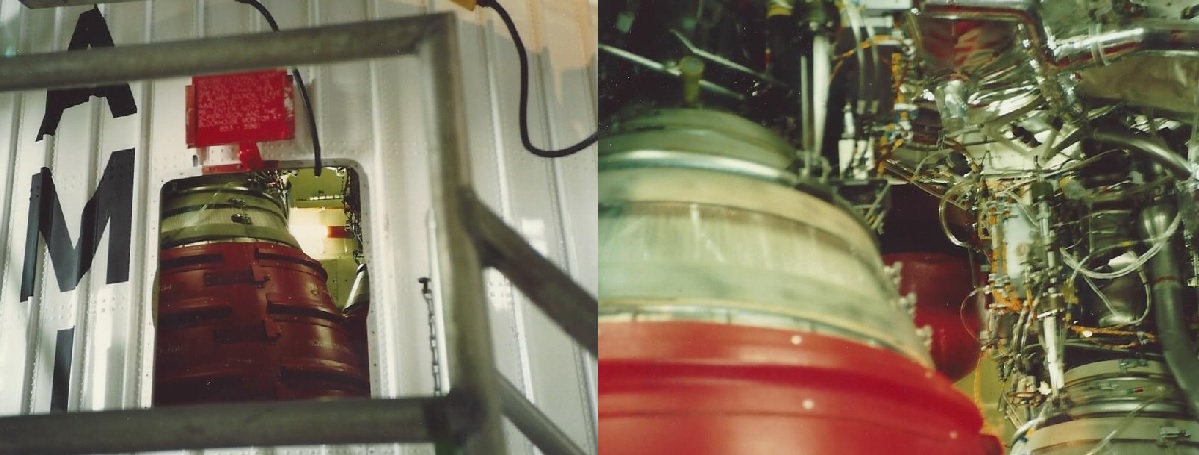
AN ATLAS-CENTAUR ROCKET
TWO RL10 ROCKET ENGINES THAT I HELPED BUILD AND TEST
Cosmic Background Explorer
The Cosmic Background Explorer, also referred to as Explorer 66, was a satellite dedicated to cosmology, which operated from 1989 to 1993.
Its goals were to investigate the cosmic microwave background radiation (CMB) of the universe and provide measurements that would help shape
our understanding of the cosmos.
The Cosmic Background Explorer, also referred to as Explorer 66, was a satellite dedicated to cosmology, which operated from 1989 to 1993. Its goals were to investigate the cosmic microwave background radiation (CMB) of the universe and provide measurements that would help shape our understanding of the cosmos.
The COBE satellite's resolution was primitive considering the CMB measurements made by the Planck satellite.
Planck (Spacecraft)
Planck was a space observatory operated by the European Space Agency (ESA) from 2009 to 2013, which mapped the anisotropies of the
cosmic microwave background (CMB) at microwave and infra-red frequencies, with high sensitivity and small angular resolution..
The Cosmic Microwave Background is now the reference frame for all movement within the universe.
Cosmic Microwave Background
The cosmic microwave background (CMB, CMBR), in Big Bang cosmology, is electromagnetic radiation as a remnant from an early stage of the universe,
also known as "relic radiation". The CMB is faint cosmic background radiation filling all space.
It is an important source of data on the early universe because it is the oldest electromagnetic
radiation in the universe, dating to the epoch of recombination.
The NASA COBE mission clearly confirmed the primary anisotropy with the Differential Microwave Radiometer instrument,
publishing their findings in 1992. The team received the Nobel Prize in physics for 2006 for this discovery.
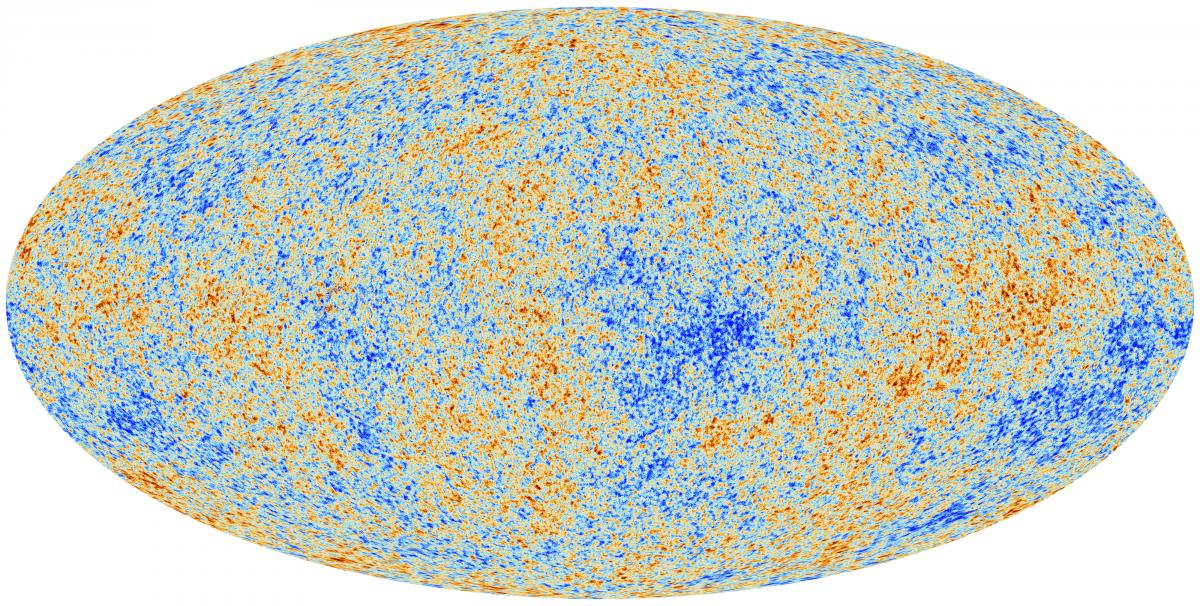
If you are going to build a Time Machine, you must first have a Master Clock and a Master Compass with
which to sail the seas of time. As part of the Solar System and the Milky Way Galaxy, Earth is moving at 631 km/sec relative
to the Cosmic Microwave Background.
One screw up with your Time Machine and you could be floating in space as the Earth and the Solar System quickly race out of your vision.
The problem in Alternative Energy Research, who's theory do you embrace.
I have built various devices, and they all worked, but I did not see anything that could not be explained by conventional physics.
Some small, efficient Alternative Energy designs claim to have been able to get moderate results, but you need expensive test equipment to measure
and exploit those very modest results.
And if you are good enough, like John Bedini working in conjunction with Tom Bearden and his theories, someone from
the United States government sticks his or her nose into your work. From there on out, it is tinfoil hat Conspiracy Theory
and another Perpetual Motion Machine.
I do not have the resources or patience for aimless tinkering, so I have been trying to work out the math and the theory.
The proper crystal technology offers a path forward, because the universe is one big liquid crystal. The crystal structure in laser diodes is an example as well as
the perovskite crystals that are being introduced to solar cell technology.
Looking for the perfect superconducting material, we do not want those electrons in our appliance circuits crashing
into copper lattice atoms and generating heat.
As you will read below, I want to build the correct model for exploiting Vacuum Energy before wasting anymore
money on experimenting with other researcher's concepts or designs.
That means examining all theories from the ground up, starting with The Big Bang.
I have linked the work of Dr. Harold Aspden, Tom Bearden, and the website Cosmic Core at the
Masthead if readers are interested in the details of what I present here.
In the Alternative Energy field everything is Nikola Tesla this and Nikola Tesla that. But what was Nikola Tesla's that?
The links at Cosmic Core can introduce readers to some of the basics. I recognize the path that the writer took to create this website.
I was already familiar with much of the material presented on this site.
I have a different opinion on more than a few concepts
presented in the those links, but they contain the important ideas of Buckminster
Fuller, Dr. Harold Aspden, and Tom Bearden. Cosmic Core is easy to read, has nice graphics,
and some of the concepts may be new to many people.
In the links below, Part I is the basics, Parts 7 and 9 can help readers understand what I present here. It introduces Fuller and Aspden's
math and their views that the universe is basically a large fluid crystal.
Engineering cannot begin until at least a model is built and the math work is complete.
COSMIC CORE
Article 98: Aether Physics - Part 1 - The Aether
COSMIC CORE
Article 102B: Physics - Aether Units - Part 7 - The Torus & Buckminster Fuller
COSMIC CORE
Article 104: Physics - Aether - Part 9 - Space Domains & Dr. Harold Aspden
Cold Fusion has been verified and is now referred to as Low Energy Nuclear Reactions.
November 14, 2019
Cold fusion: A potential energy gamechanger
Think it's a failure, a joke? Think again. Big investors are positioning themselves, Japan & US in the lead
November 16, 2019
Cold fusion 2: Japan wins with systematic method
November 19, 2019
Cold fusion 3: commercial future and Asia
Based on the research of Aspden, Fuller, Bearden, and others, I believe that "Low Energy Nuclear Reactions" are
a form of Cold Plasma Physics involving Fractional Charge.
Theoretical physics is one thing; practical application in the Real World is another thing.
In both 19th century Physics and Metaphysics, The Aether was considered the source of all
forces until the Michelson-Morley Experiment seemed to disprove The Aether's existence.
There are two points-of-view regarding The Aether.
Aether (classical element)
According to ancient and medieval science, aether, also spelled ćther, aither, or ether and also called quintessence, is the material that fills the
region of the universe above the terrestrial sphere.[1] The concept of aether was used in several theories to explain several
natural phenomena, such as the traveling of light and gravity.
There is the Metaphysical viewpoint of The Aether; and then there is the physicist's view point of The Aether.
Luminiferous Aether
Luminiferous aether or ether ("luminiferous", meaning "light-bearing") was the postulated medium for the propagation of light.
It was invoked to explain the ability of the apparently wave-based light to propagate through empty space,
something that waves should not be able to do. The assumption of a spatial plenum of luminiferous aether, rather than a spatial vacuum,
provided the theoretical medium that was required by wave theories of light.
The aether hypothesis was the topic of considerable debate throughout its history, as it required the existence of
an invisible and infinite material with no interaction with physical objects.
The Luminiferous Aether was disproven in 1887 by the Michelson-Morley Experiment.
Michelson-Morley Experiment
The Michelson-Morley experiment was an attempt to detect the existence of the luminiferous aether, a supposed medium permeating space that
was thought to be the carrier of light waves. The experiment was performed between April and July 1887 by Albert A. Michelson
and Edward W. Morley at what is now Case Western Reserve University in Cleveland, Ohio, and published in November of the same year.
Today, The Active Vacuum has replaced The Luminiferous Aether.
Vacuum Energy
Vacuum energy is an underlying background energy that exists in space throughout the entire Universe. Its behavior is codified in
Heisenberg's energy-time uncertainty principle. Still, the exact effect of such fleeting bits of energy is difficult to quantify.
The vacuum energy is a special case of zero-point energy that relates to the quantum vacuum.
19th century physicist Michael Faraday introduced Displacement Currents because he believed in the Aether.
Displacement Currents
In electromagnetism, displacement current density is the quantity appearing in Maxwell's equations that is defined in terms of the
rate of change of D, the electric displacement field. Displacement current density has the same units as electric current density, and it
is a source of the magnetic field just as actual current is. However it is not an electric current of moving charges, but a
time-varying electric field. In physical materials (as opposed to vacuum), there is also a contribution from the slight motion
of charges bound in atoms, called dielectric polarization.
The first point of discovery that I made was to learn that geometry matters. Everything in electronics depends on the proper geometric structure
of crystalline materials. It is Fermi Energy Levels that allow transistors to work.
As the head of IBM's European Patent Division, I believe that Dr. Harold Aspden had a very practical approach to engineering
the Aether or Active Vacuum. Therefore, I will refer to much of his research,
especially Aspden's math.
Dr. Aspden did not believe that photons traveled through space. The energy created at the Transmitting End
rattled the Vacuum Lattice, and the Vacuum Lattice at the Receiver's End recreated the photons.
This would be a form of Quantum Entanglement.
Therefore, large resonating crystal structures on any planet would have a very large effect on the Vacuum Lattice
surrounding and inclusive of that planet.
If you read Linda Moulton Howe's latest series of articles on The Dark Pyramid, you will discover that pyramids apparently
amplify Vacuum Energy at the vertexes, and the United States government needs electrical engineers and scientists to figure out how it all works.
May 18, 2020
Updated - Part 1: Western Electric Engineer Worked 700 Feet Underground At "Dark Pyramid" in Alaska
Dr. Aspden discovered how the constants of physics were derived. From his math, we can derive the exact same
numbers that we recognize in virtual particles.
G. A. STEWART'S METAPHYSICS
DR. HAROLD ASPDEN'S MASTERPIECES
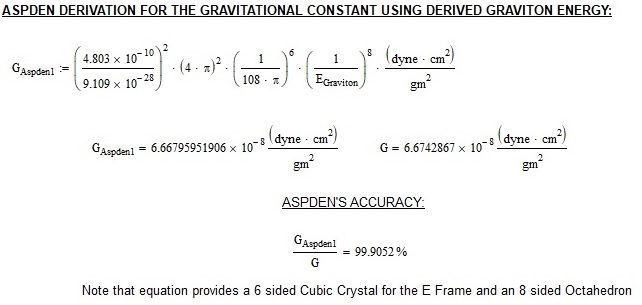

Readers should note that two astronomers have shown how galactic clusters have formed at the vertexes of a network of Octahedrals structures
throughout the universe.
As I noted 15-years ago after I transcribed Dr. Aspden's formulas that he was describing two reference frames, Cubic and Octahedral.
THE GRAVITY METRIC IS AN OCTAHEDRAL CRYSTAL
Magnetic Fields and Large Scale Structure In a Hot
Universe. III.
The Polyhedric Network
E. Battaner, E. Florido, J. M. Garcia-Ruiz
October 7, 1997
A primordial magnetic field lattice made up of magnetic flux tubes would then have originated a matter lattice made up of
cluster filaments. Taking into account some restrictions in the magnetic field configuration we speculate what type of matter
network this would have generated. The simplest lattice is made up of octohedra connected at their vertexes,
reminding us of a structure of superimposed egg cartons.
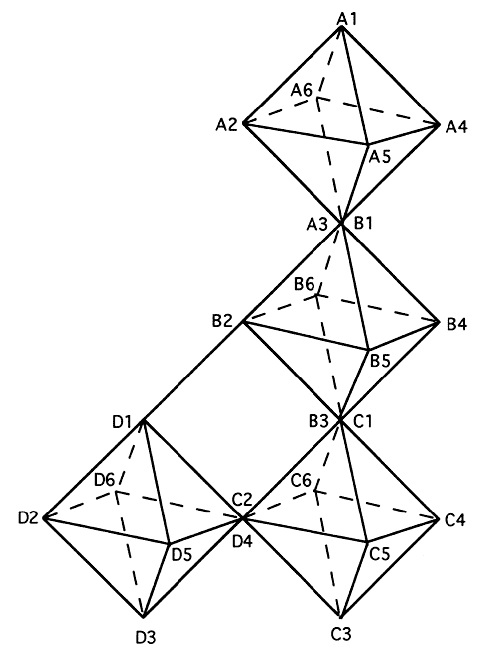
OCTAHEDRAL GALAXY ARRANGEMENT
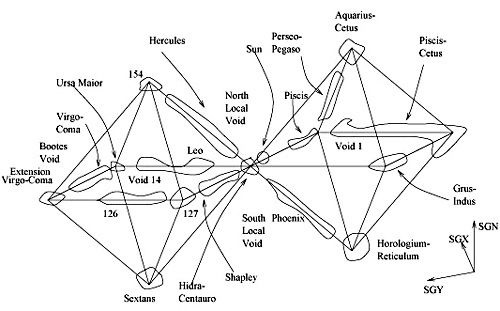
THE BATTANER AND FLORIDO 1998 STUDY
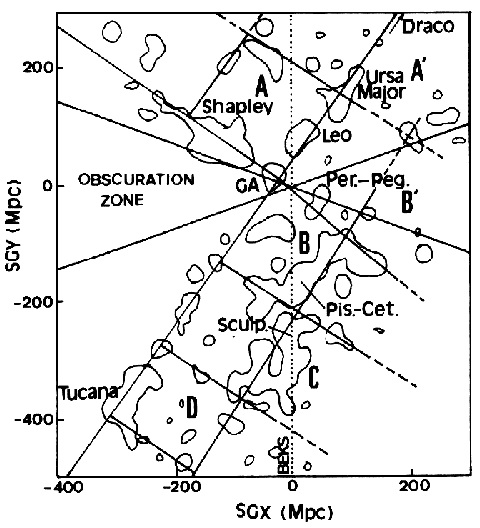
THE BATTANER AND FLORIDO 1998 STUDY
The Wheeler-Feynman One Electron Universe Theory allows me to speculate freely without the pseudoscience branding associated with
Ideas beyond the average critic's ability to understand. I am not a Nobel Prize winning physicist, but the rockets that I have worked on
have made physicists Nobel Prize winners.
Over the last fifteen-years, I have read much of Dr. Aspden's writings and created a special MathCad worksheet of
his formulas that I have painstakingly transcribed with my limited math skills.
In no way should my conjecture or thought experiments be considered part of Dr. Aspden's theories.
Several years ago, I watched David Wilcock's video series at Gaia.com on Dr. Aspden's research.
There were several serious mistakes made in one part of the series.
I tried to contact David Wilcock about the mistakes, but I have not heard back.
[#204] Modern Aether Science of Dr. Harold Aspden
Wisdom Teachings with David Wilcock
February 13, 2017S24:Ep12
As I mentioned, in my 1970s High School freshman electronics class, we were discussing the mysterious Nikola Tesla.
In the 1980s came the first Internet Free Energy Bulletin Boards, and then came the 1990s Internet.
PBS did a show on Free Energy researchers back in the 1990s, and the show did a fair job of interviewing
the top researchers in Alternative Energy; one of those researchers was Joseph Newman.
After Newman explained his theory, I began digging deeper. I was taking some very serious college courses at the time,
computers were getting better, and I had just purchased MathCad.
So, for various college classes like physics, chemistry, astronomy, and electronics, I had built large MathCad worksheets
from my textbooks that I still use to this day.
My physics worksheets had already been built, so I plugged Joseph Newman's hypothetical "Magnetic Gyroscopic Particle" into some of
those basic physic's equations.
Newman's Energy Machine
Newman's Energy Machine was a DC motor which the inventor, Joseph Newman, claimed to produce mechanical power exceeding the electrical power being supplied to it.
Newman's Magnetic Gyroscopic Particles moved at the speed of light on the surface of wire.
I was surprised that the ratio of the Magnetic Fields created by the speed of his Magnetic Gyroscopic Particles with the
actual Magnetic Field created by the speed of the electrons in the copper wire was The Fine Structure Constant.
It must be understood that every Bohr Electron Energy Level has its own Fine Structure Constant. The Electron is an energy onion. Technically,
the electric field of every single electron extends to the end of the universe.
The Electric Universe Model, better known as Plasma Cosmology, is how I tend to view the universe's dynamic structure. It is a better
explanation of the universe's large number of Voids and Super-Dense Areas with lots of galactic structure.
Many individuals who subscribe to The Electric Universe Model reject The Big Bang Model and the expanding universe.
I do not believe a Steady-State Universe is possible. Time's Arrow and entropy are self-evident. Nothing in the universe appears to be static; everything is cyclic.
There is enough evidence that The Big Bang Theory is correct.
It is up to the adherents of The Electric Universe Model to work Big Bang Theory into their model.
PLASMA COSMOLOGY
Plasma cosmology is a non-standard cosmology whose central postulate is that the dynamics of ionized gases and plasmas play important, if not dominant, roles in the physics of the universe beyond the Solar System.
Comparison With Mainstream Astrophysics
Standard astronomical modeling and theories attempt to incorporate all known physics into descriptions and explanations of observed phenomena, with gravity playing a dominant role on the largest scales as well as in celestial mechanics and dynamics.
To that end, both Keplerian orbits and Albert Einstein's General Theory of Relativity are generally used as the underlying frameworks for modeling astrophysical systems and structure formation, while high-energy astronomy and particle physics in cosmology additionally appeal to electromagnetic processes including plasma physics and radiative transfer to explain relatively small scale energetic processes observed in the x-rays and gamma rays.
Some of the places where plasma cosmology supporters are most at odds with standard explanations include the need for their models to have light element production without Big Bang nucleosynthesis, which, in the context of Alfvén-Klein cosmology, has been shown to produce excessive X-rays and gamma rays beyond that observed.
The sensitivity and resolution of the measurement of the CMB anisotropies was greatly advanced by WMAP and the Planck satellite and the statistics of the signal were so in line with the predictions of the Big Bang model, that the CMB has been heralded as a major confirmation of the Big Bang model to the detriment of alternatives.
The acoustic peaks in the early universe are fit with high accuracy by the predictions of the Big Bang model, and, to date, there has never been an attempt to explain the detailed spectrum of the anisotropies within the framework of plasma cosmology or any other alternative cosmological model.
THE COMPTON FREQUENCY
AND
THE FINE STRUCTUE CONSTANT
Our Shared Reality is created by these two constants of nature. Waves and particles meet right here.
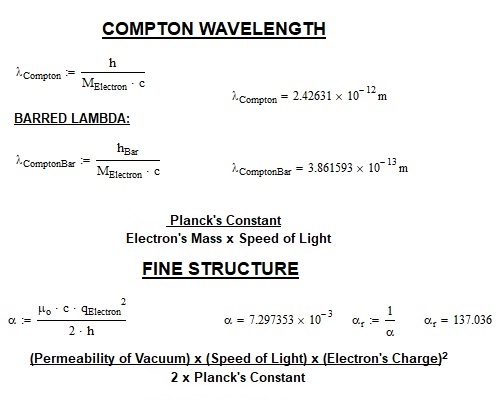
Not many people have sat down to look at the math behind The Compton Wave Length and The Fine Structure Constant.
Compton Wavelength
The Compton wavelength is a quantum mechanical property of a particle. It was introduced by Arthur Compton in his explanation
of the scattering of photons by electrons (a process known as Compton scattering).
When the Compton wavelength is divided by 2p, one obtains the "reduced" Compton wavelength (barred lambda), i.e.
the Compton wavelength for 1 radian instead of 2p radians:
1) The inverse reduced Compton wavelength is a natural representation for mass on the quantum scale
2) The inverse reduced Compton wavelength is a natural representation for mass on the quantum scale
3) The reduced Compton wavelength also appears in Schrödinger's equation
The Reduced Compton Wavelength is a natural representation of mass on the quantum scale.
The Non-reduced Compton Wavelength is a natural representation for mass that has been converted into energy.
Readers should note how I reduced these two equations to their simplest forms, and how Planck's Constant disappears when solving for
The Electron's Classic Radius.
The disappearance of Planck's Constant in the equation and the Electron's size may have to do with the
localization of the Electron Wave to a definitive form and the disappearance of Uncertainty.
I suspect the universe records every moment, even the probable ones, therefore, in a sense everything is analog.
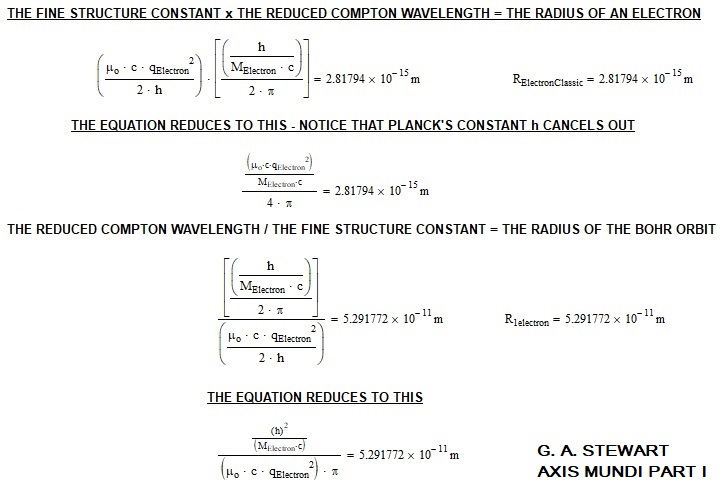
Here we see that the multiplication and division of these two essential constants of physics produces the electron's physical size and the size of the
orbit in which the electron revolves around the proton.
I suspect that in this beautiful inverted symmetry lie the secrets of the universe.
When I first took physics in college, The Quark Model was as new as electronic calculators. My Physics Professor,
the stereotypical Austrian Physics Professor, would not allow calculators in his class. Every test was done with a sliderule.
When I went back to college 22-years later, I was using MathCad to do my physics homework.
The actual learning part came from programming MathCad to do the work. This was an aspect to the new technology that my 1970's Physics
Professor had not considered.
MathCad allows users to play with the units of physics.
You cannot take physical units for granted if you want to understand nature. Memorizing famous dead scientists will not lead you to an
understanding of what is being observed and quantified.
The physical constants of nature, Permittivity and Permeability show up everywhere in physics and electronics.
Most students, engineers, and scientists just takes these important numbers for granted. I did too when I was in school.
When you break the units down to the basics you can see that these two constants have an inverse relationship with all force.
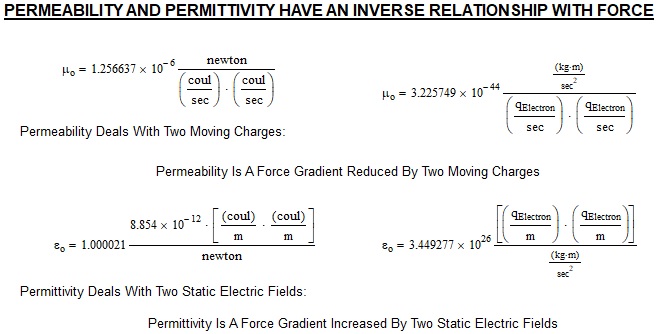
I have reduced the Charge Unit of the dead 18th century physicist, Charles-Augustin de Coulomb (coul),
to the charge on a single electron or proton, and I have reduced the Force Unit of the dead 17th century physicist,
Isaac Newton (newton), to just mass, length, and time.
Permeability deals with Force being reduced by two moving electrons. Also consider that two moving
electrons generate a magnetic field, and this is why Permeability is so important to magnetism and why magnetism is so important
to things that are Hot or Cold.
In the CGS system, the ratio of the Magnetic Density B Field to the Magnetic Strength H Field is set to 1,
because there are no electric currents or matter in the The Acvtive Vacuum to alter B and H Fields.
Magnetic Permeability
In empty, or free, space the magnetic flux density is the same as the magnetizing field because there is no matter to modify the field.
In centimetre-gram-second (cgs) units, the permeability B/H of space is dimensionless and has a value of 1.
In metre-kilogram-second (mks) and SI units, B and H have different dimensions, and the permeability of free space ( symbolized µ0) was defined as equal to 4p × 10-7 weber per ampere-metre so that the mks unit of electric current may be the same as the practical unit, the ampere. With the redefinition of the ampere in 2019, µ0 is no longer equal to 4p × 10-7 weber per ampere-metre and must be determined experimentally.
(However, [µ0/4p × 10-7] is 1.00000000055, still very close to its former value.)
Magnetic Permeability is also an important component of the equation for The Fine Structure Constant.
Permittivity deals with Force reducing the Electric Field of two static electrons. This is important for the capacitors in all
electronic components. All digital cameras take light, turn it into charge, and then turn that into a picture.
The Electric Fields of Protons and Electrons are the basic components of our Shared Reality. The one thing to keep in mind,
there is no such thing as an isolated electrical charge. Everything exists within larger Electrical and Magnetic Fields.
Do note that both Permeability and Permittivity require two charges. There needs to be two charges
because there are two reference frames to our Shared Reality.
Magnetism is really a transformation between
Reference Frames.
Classical Electromagnetism and Special Relativity
The theory of special relativity plays an important role in the modern theory of classical electromagnetism. First of all, it gives formulas for how electromagnetic objects, in particular the electric and magnetic fields, are altered under a Lorentz transformation from one inertial frame of reference to another.
Secondly, it sheds light on the relationship between electricity and magnetism, showing that frame of reference determines if an observation follows electrostatic or magnetic laws.
All charge exists within the Electric Fields of larger charged bodies. As you will read in this series, astronomers have recently discovered
Magnetic Bridges between galaxies. Therefore, it appears that nothing exists in isolation.
I came across the research of David Wilcock in his book, Divine Cosmos. This is an excellent source of information
and it is where I discovered the work of Dr. Harold Aspden.
As you will read in this series, Dr. Aspden has provided the mathematical theory on the structure of The Active Vacuum. Real Math leads to Real Engineering.
The Divine Cosmos, David Wilcox, 2005
7.6 THE SUPERCLUSTERS
Groups of galaxies are known to be gathered into sphere-shaped superclusters,
again suggesting that a larger-scale pattern of spherical energy fields is at work.
(It is actually more accurate to say that galaxies are formed from the energy fields that become superclusters.)
The breakthrough research of Dr. Halton Arp has revealed that our current method of calculating stellar distances
known as "redshift" is inaccurate, and that once we correct the distortions that were introduced, we find that the majority
of superclusters are truly spherical in shape, with the largest concentration of galaxies in their center.
7.10 CONNECTION BETWEEN SOLAR SYSTEM AND NEW QUANTUM PHYSICS
Another key discovery that connects the Solar System to our quantum model has been published by Richard Hoagland and
The Enterprise Mission, inspired by the pioneering work of Lt. Col. Tom Bearden.
The Divine Cosmos, David Wilcox, 2005
CHAPTER 07: SPHERICAL ENERGY STRUCTURES IN THE COSMOS
Lauer & Postman's data was then analyzed statistically in 1995 by Strauss et al., who concluded with a confidence level higher
than 95% that these observations of large-scale rotational velocity were accurate, thus ruling out all popular Big-Bang models
in the process, which cannot account for such large-scale structuring.
One of the fathers of astronomy, Johannes Kepler, was one of the first mathematical pioneers to posit that the universe is constructed of
nested energy spheres.
Johannes Kepler
Kepler claimed to have had an epiphany on 19 July 1595, while teaching in Graz, demonstrating the periodic conjunction of
Saturn and Jupiter in the zodiac: he realized that regular polygons bound one inscribed and one circumscribed circle at
definite ratios, which, he reasoned, might be the geometrical basis of the universe.
After failing to find a unique arrangement of polygons that fit known astronomical observations (even with extra planets added
to the system), Kepler began experimenting with 3-dimensional polyhedra. He found that each of the five Platonic solids could be
inscribed and circumscribed by spherical orbs; nesting these solids, each encased in a sphere, within one another would produce
six layers, corresponding to the six known planets-Mercury, Venus, Earth, Mars, Jupiter, and Saturn.
By ordering the solids selectively-octahedron, icosahedron, dodecahedron, tetrahedron, cube-Kepler found that the spheres could
be placed at intervals corresponding to the relative sizes of each planet's path, assuming the planets circle the Sun.
Kepler also found a formula relating the size of each planet's orb to the length of its orbital period: from inner to outer planets,
the ratio of increase in orbital period is twice the difference in orb radius. However, Kepler later rejected this formula, because
it was not precise enough.
The universe overall may be spherical but it is more complex than that; galaxy clusters show a clear pattern of dendrite expansion,
and this is fractal in nature.
Also, the source of this dendrite, Galaxy Current growth,
seems to be related to the large Galactic Voids between Galactic Filaments and Galactic Clusters.
I began examining The Electric Universe Model against The Big Bang Model.
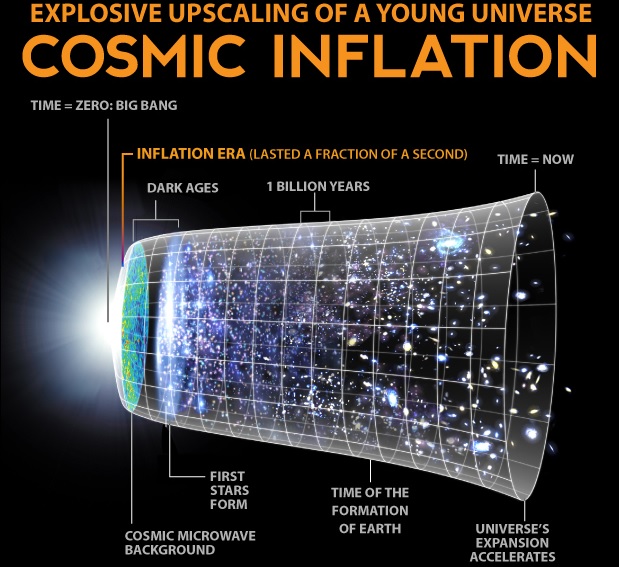
In 1997, two astronomers, Borge Nodland and John Ralston, were studying the electric fields of galaxies, and
they discovered a rotating polarization axis of galaxies from the Constellation of Sextans to the Constellation of Aquila.
I think that this is more than coincidental with the oldest universal structures being found near the Constellation Sextans.
The two driving factors in today's cosmological models are The Shapley Attractor, a gravity sink,
and The Dipole Repeller, a gravity repeller.
The Dipole Repeller is a new addition to astrophysics since I took college astronomy nearly
three-decades ago. Coincidentally, it is located in the Galactic Voids at the opposite end of Borge Nodland and John Ralston's
polarization cone from Sextans to Aquila.
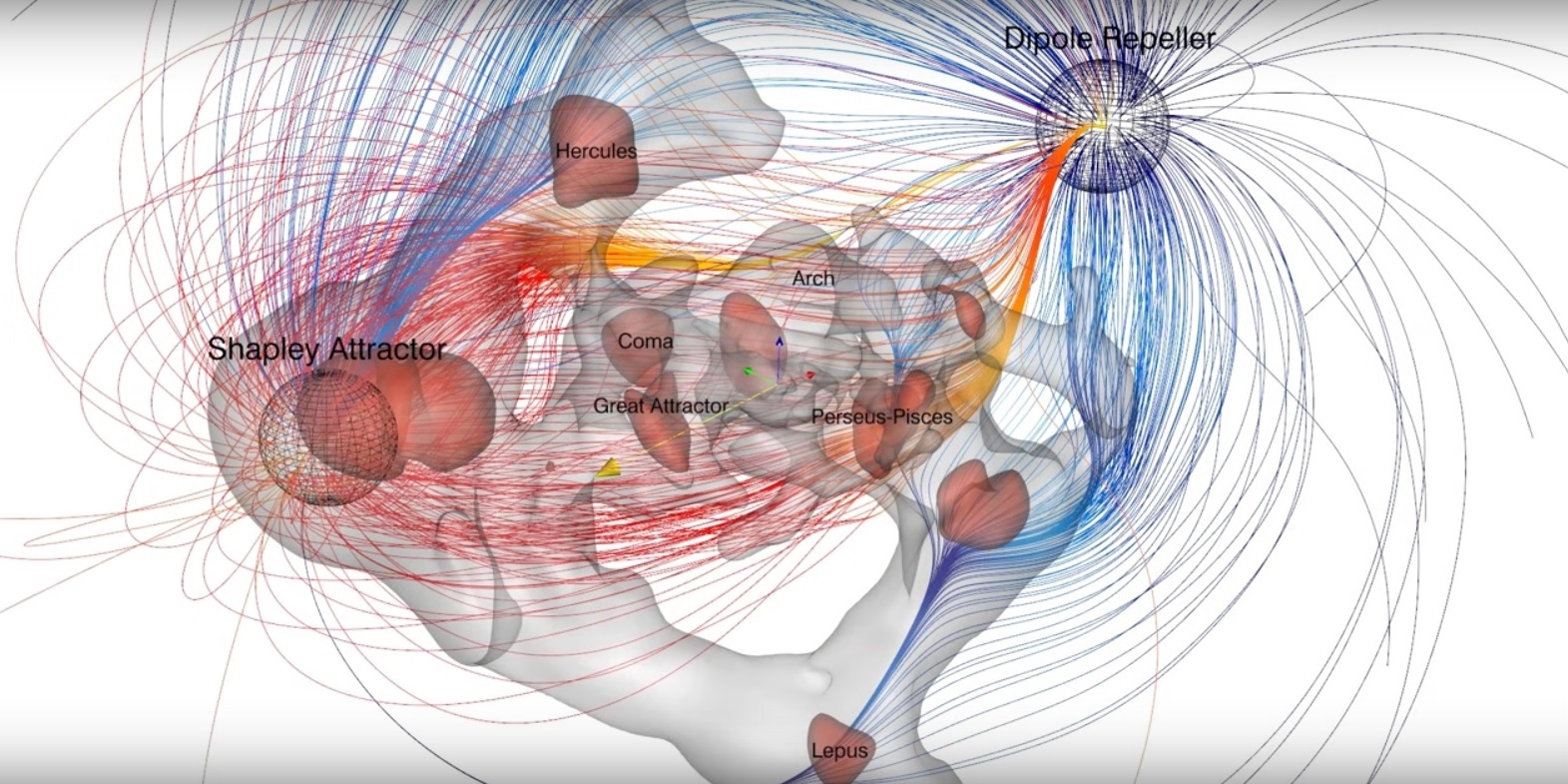
When you look at the universe on this scale, it is easy to think that it looks like an
Electrical Dipole with a Positive and Negative pole.
To simplify the work of Tom Bearden and Dr. Harold Aspden, as well as Edgar Cayce into one simple thought, as I mentioned,
I have begun to look at all electrical polarization as an asymmetry in time. This is exactly what Edgar Cayce describes in his readings.
Real control of electricity means that you can control time and space.
Cosmic Voids might play a larger role in the construction of the universe than astronomers imagine.
The Local Void is really a group of four voids. The Local Group of Galaxies,
as well as some of the galaxies of the Perseus Group, have emerged from this particular Void.
As I began researching cosmological structure, I was reminded of Cold Cathode Emission.
Cold Cathode
A cold cathode is distinguished from a hot cathode that is heated to induce thermionic emission of electrons.
Discharge tubes with hot cathodes have an envelope filled with low-pressure gas and containing two electrodes.
Examples are most common fluorescent lamps, high-pressure discharge lamps and vacuum fluorescent displays.
The surface of cold cathodes can emit secondary electrons at a ratio greater than unity (breakdown).
The Big Bang Model reminds me of a Crookes Tube. One end is the cathode and one end is the anode.
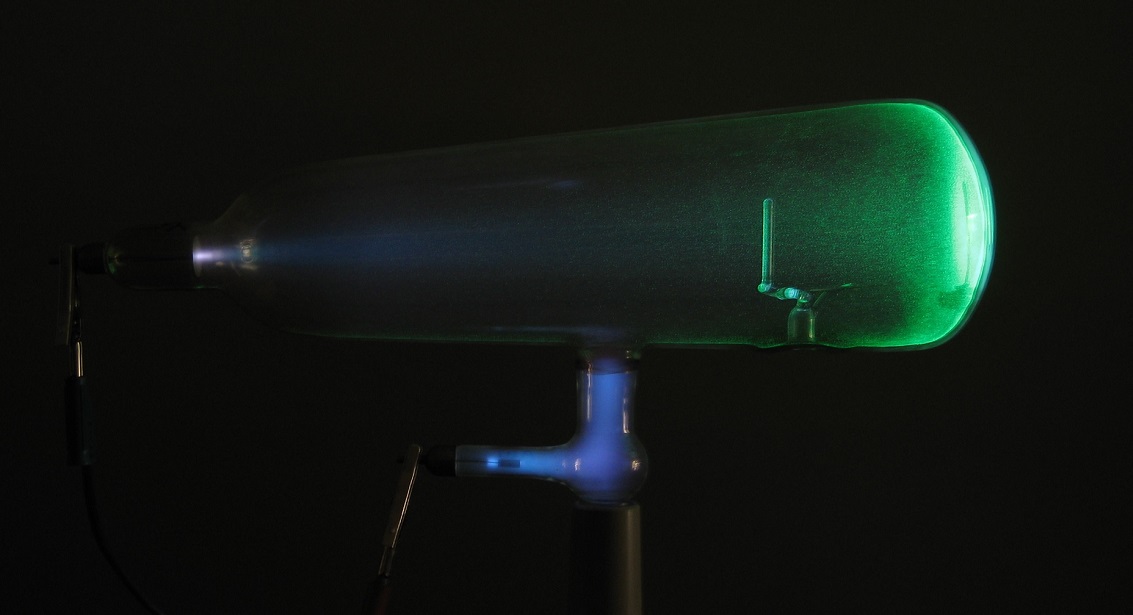
Crookes Tube
The Crookes tube consists of a partially evacuated glass bulb of various shapes, with two metal electrodes, the cathode and the anode,
one at either end. When a high voltage is applied between the electrodes,
cathode rays (electrons) are projected in straight lines from the cathode.
If there is an order to The Active Vacuum, then this should appear in our observations and measurements of the universe.
With astronomers Borge Nodland and John Ralston's 1997 discovery of galactic polarization in mind, I began searching galactic databases to look for this polarization to see if the universe really had a preferred direction.
What I found suggests that their data is not only correct, but that they may have also discovered The Arrow of Time.

STELLARIUM: LOOKING AT THE MILKY WAY CENTER
THE BORGE NODLAND AND JOHN RALSTON POLARIZATION
POLES IN THE CONSTELLATION OF AQUILA AND SEXTANS
THE GREAT GAMMA RAY BURST WALL IS PARALLEL TO THIS AXIS
Indication of Anisotropy in
Electromagnetic Propagation over Cosmological Distances
Borge Nodland and John P. Ralston
Phys. Rev. Lett. 78, 3043 - Published 21 April 1997.
Nodland, B., and J.P. Ralston, "Indication of anisotropy in electromagnetic propagation over cosmological distances"
Physical Review Letters,
78:3043-3046, April 21, 1997
"In 1997, Borge Nodland and John Ralston found in their analysis of astronomical polarization data that the
universe had an optical axis: it was circularly birefringent. The universe appeared to behave in a similar way as a
crystal with optical activity: it rotated the polarization direction of linearly polarized light.
This cosmic 'quartz crystal' had an optical axis parallel to the direction Aquila-Earth-Sextans."
"All Space is Not Equal: Physicists Find Axis that Gives the Universe Orientation," University of Rochester News, April 17, 1997
"The team made the finding by studying the polarization (orientation of electric fields) of radio waves from 160 distant galaxies as
measured in previous experiments by astronomers around the world. Nodland and Ralston found that the plane of polarization of the
light rotates like a corkscrew as the light travels through space, and that the orientation of the universal axis that
they've discovered is key to the amount of rotation. The rotation of polarization depends on the angle at which the light
moves relative to the axis and on the distance the light travels before being measured. The effect is crudely analogous
to that of a crystal that twists light depending on the direction light is traveling through the crystal. …
The data indicate that light actually travels through space at two slightly different speeds."
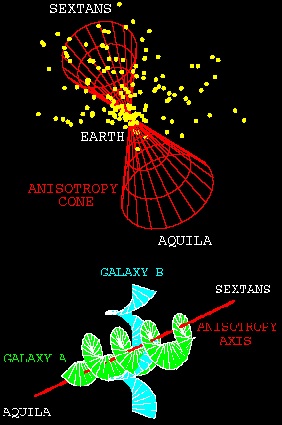
There is a counter-argument to what Borge Nodland and John Ralston actually discovered.
The Screwy Universe
Two scientists, Borge Nodland of the University of Rochester and John Ralston of the University of Kansas,
were claiming that they had detected a violation of a fundamental principle of modern cosmology - isotropy,
the idea that space looks the same in every direction.
My job as the beginning graduate student was to look in the literature for measurements of the polarization angles and
redshifts of as many galaxies as I could find. I managed to scrape up 160 such galaxies, which was enough to put a good
limit on the effect we were looking for.
In fact they had basically done exactly the same thing that we had done, except that they had considered a Lorentz-violating
vector field that was pointing in a spatial direction instead of in the time direction. As a result,
they were asking whether there was a direction-dependent rotation of polarizations - clockwise if you looked at one side of the sky,
counter-clockwise if you looked at the other - rather than a uniform one across the sky. And, remarkably, they seemed to be saying
that there was such a rotation!
As it turns out, Nodland and Ralston had simply made a mistake. What they, and before them we, were doing was comparing the polarization
from distant quasars to their orientation angles on the sky.
I do not believe that Borge Nodland and John Ralston made a mistake. I began looking to see what the actual individual
galactic and galactic cluster dispersal was throughout the universe using the software Stellarium and Open Space.
There is a distinctive axis of galactic clusters and superclusters extending from the Constellation Sextans to the
Constellation of Aquila just as Borge Nodland and John Ralston describe.
After the latest galactic surveys, astronomers have been able to determine the gravitational flow of many
galaxies and galaxy clusters within 250-million light-years of our Milky Way Galaxy.
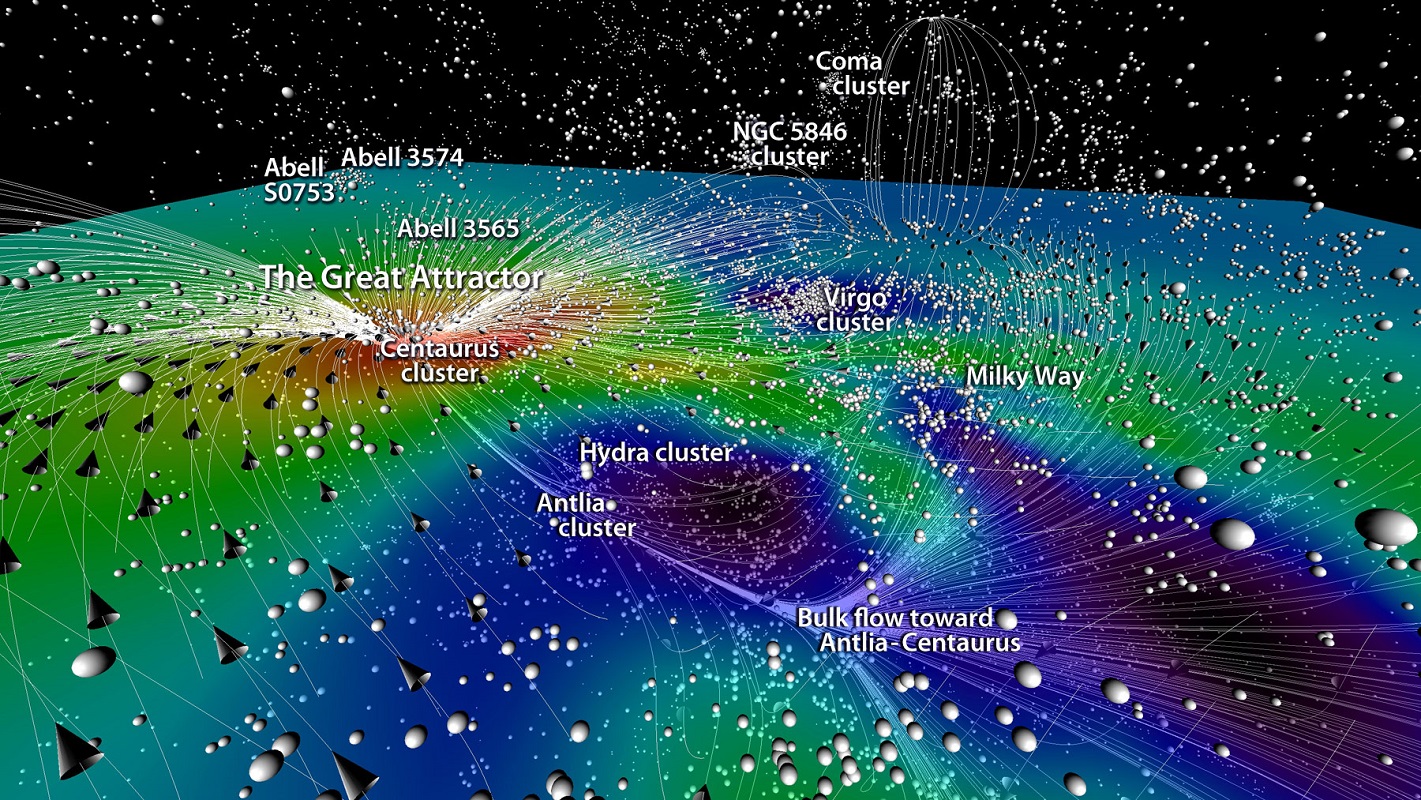
I began to consider Nodland, B., and J.P.
Ralston's 1997 research in conjunction with E. Battaner and E. Florido's 1998 research on the octahedral structure of galactic clusters.
According to Dr. Harold Aspden's theories, gravity is an electrostatic displacement in The Active Vacuum.
He predicted that the universe would be filled with huge Space Domains much like the Magnetic Domains in a magnet.
In fact, according to Dr. Aspden's theory, frozen Vacuum Energy is what a magnet is on a microscopic scale.
What you find when you examine a map of Cosmic Void structure is a system that reminds me of a spherical capacitor.
The following video link is very informative and details how Cosmic Voids form into four main structures.
The outer layers of the shell-like structures are the oldest.
Map of the Local Void
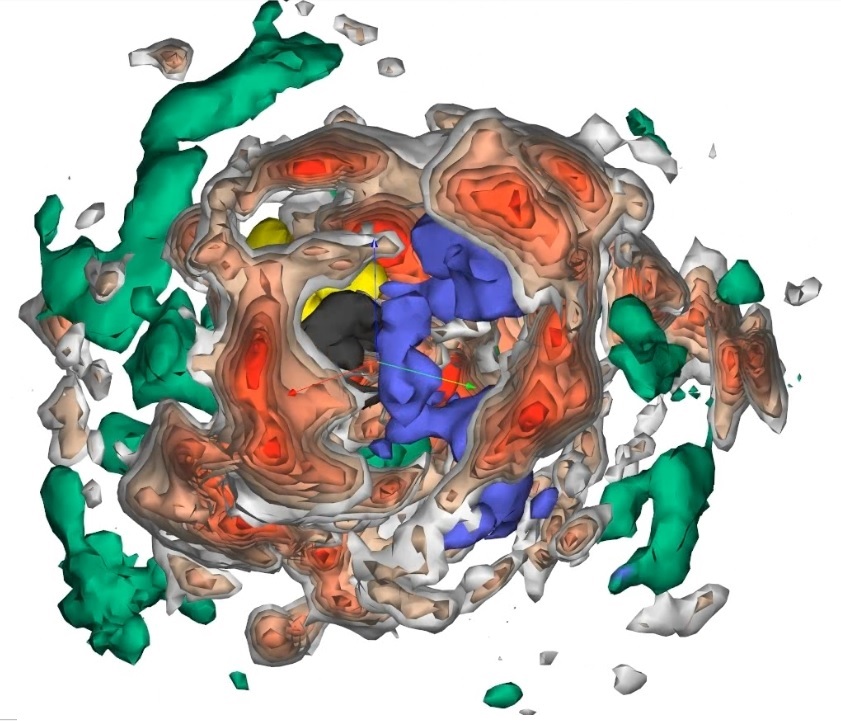
OVER-DENSITIES IN ORANGE SHADES (GALACTIC STRUCTURES)
VOIDS ALL OTHER COLORS

OVER-DENSITIES IN ORANGE SHADES - VOIDS ALL OTHER COLORS
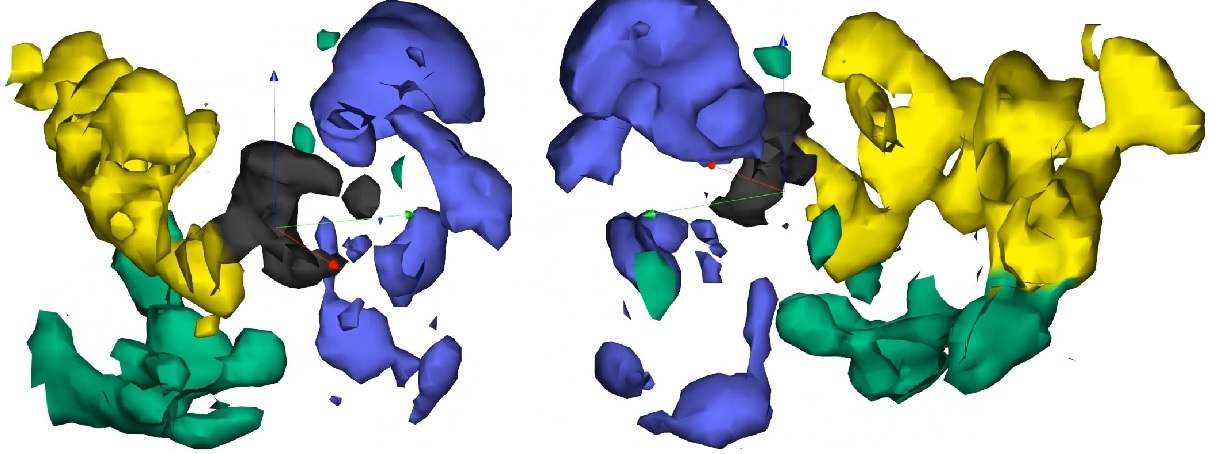
THE VOIDS
THE DIPOLE REPELLER
I believe that the term The Cosmic Dipole Repeller is too ambiguous, and the graphics too generalized as
astronomers now sell this dipole version of Gravity and the mysterious Gravity Repeller.
The Cosmic Dipole Repeller is a large Void in space where very little galactic structure is found.
Interestingly enough, as I scanned the galactic catalogues, I found that The Voids are filled mostly with
massive Galaxy Clusters and a sprinkling of isolated galaxies.
February 10, 2017
The Dipole Repeller: How This Void is Pushing the Milky Way Through the Universe
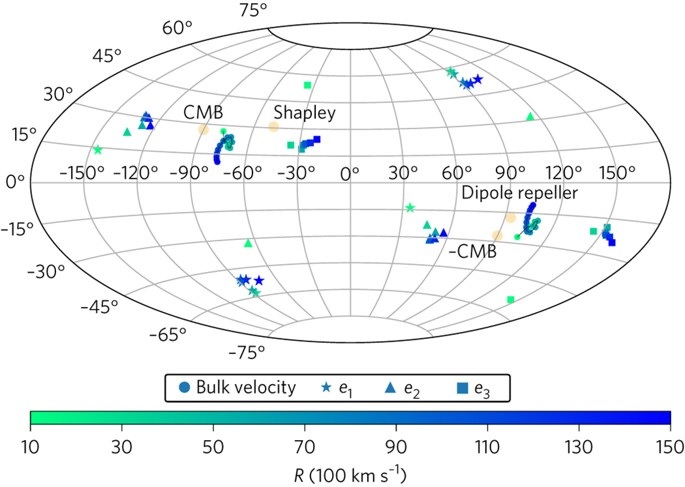
SHAPLEY ATTRACTOR - (+CMB)(-CMB) - DIPOLE REPELLER
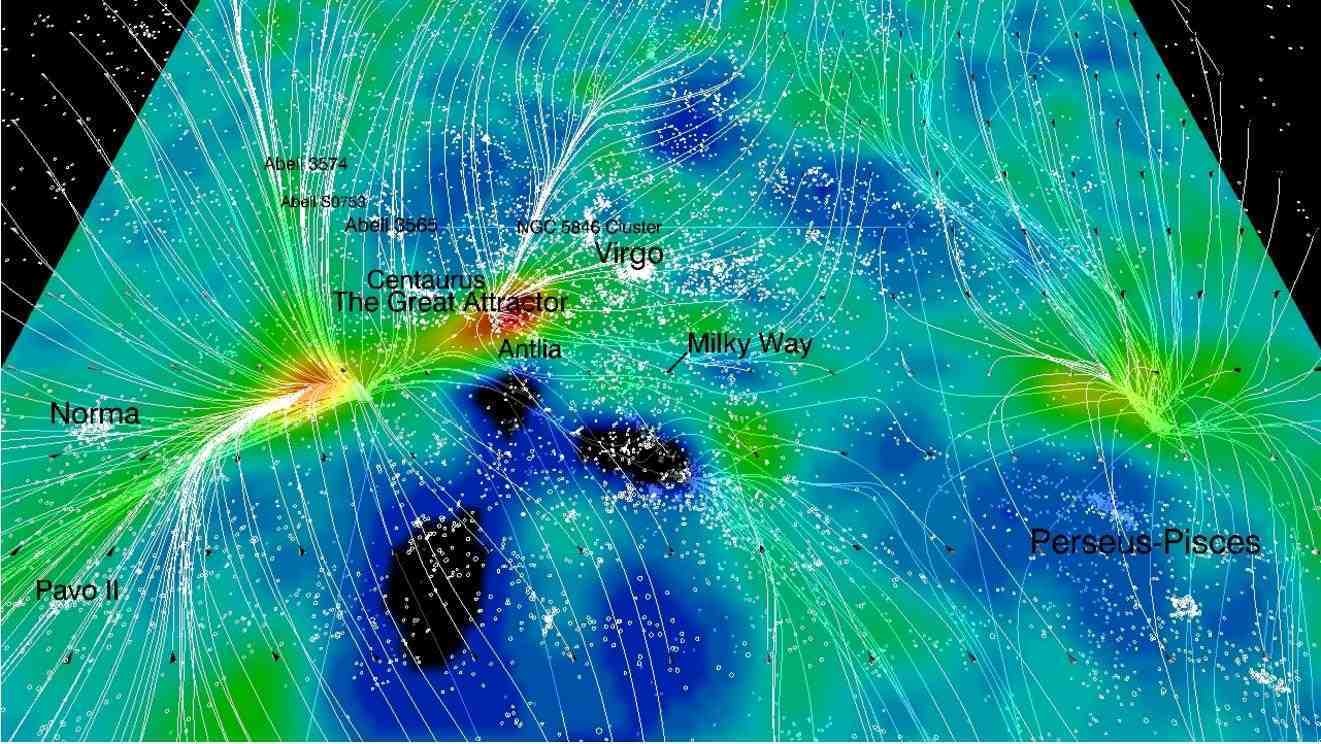
SHAPLEY ATTRACTOR - DIPOLE REPELLER
The following link contains a great video on the structure of Cosmic Over-Densities and
Under-Densities. I suspect that The Voids offer clues on Cold Plasmas and particle formation.
"Cosmicflows-3: Cosmography of the Local Void"
An astronomer from the University of Hawaii Institute for Astronomy (IfA)
and an international team published a new study that reveals more of the vast cosmic structure surrounding our Milky Way galaxy.
The universe is a tapestry of galaxy congregations and vast voids.
The Dipole Repeller is simply the closest Cosmic Void. As the video shows, there are alternating regions of
Super-Dense areas and Voids. Do note that The Voids on the outer edges of the universe have
lower densities.
My search to build the correct physical model led me to "Lichtenberg Figures".
Lightning and electrical shorts can be identified and mapped by Lichtenberg Figures.
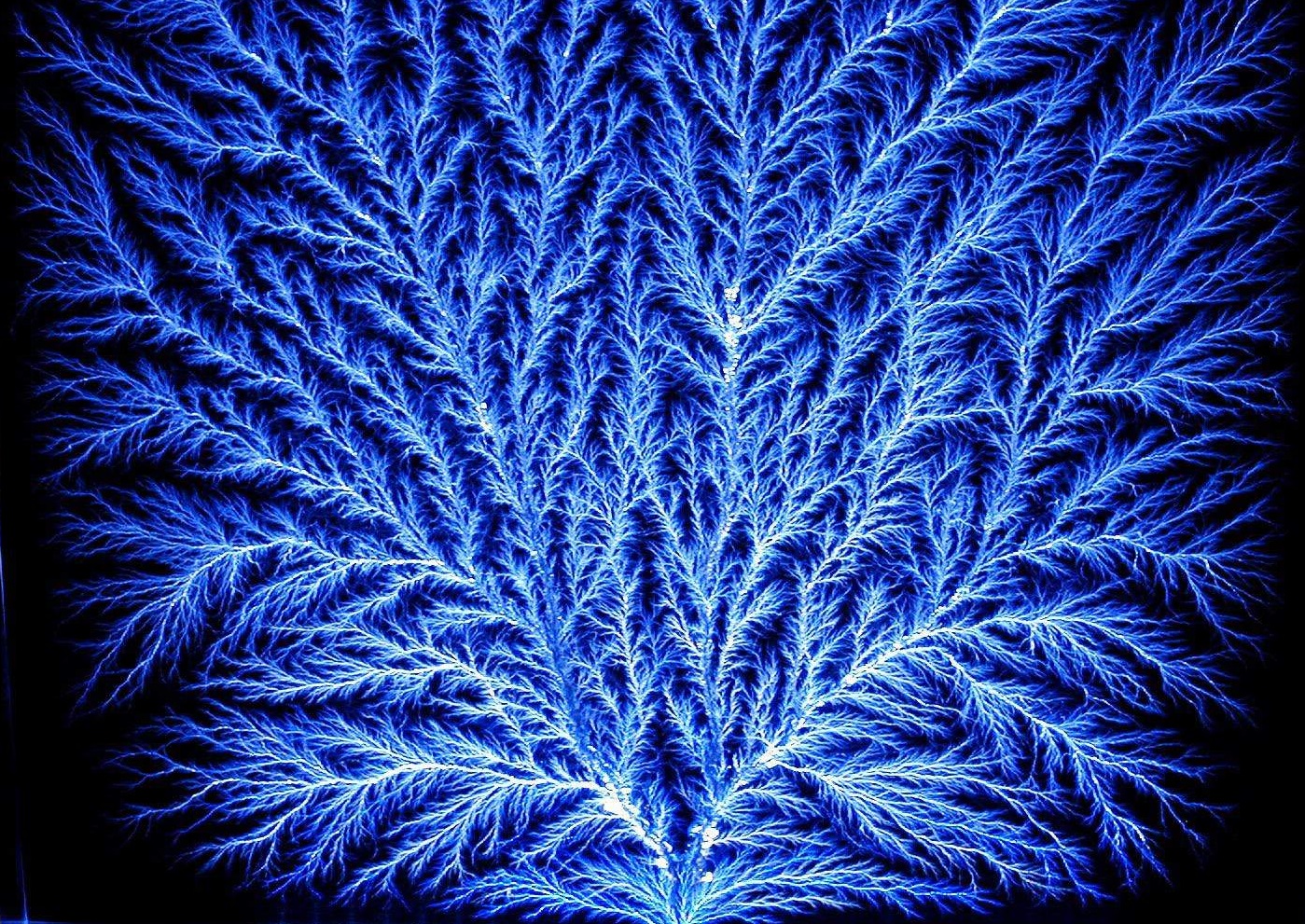
Lichtenberg Figures
Lichtenberg figures are branching electric discharges that sometimes appear on
the surface or in the interior of insulating materials. Lichtenberg figures are often associated with the
progressive deterioration of high voltage components and equipment.
The study of planar Lichtenberg figures along insulating
surfaces and 3D electrical trees within insulating materials often provides engineers with valuable insights for improving
the long-term reliability of high voltage equipment.
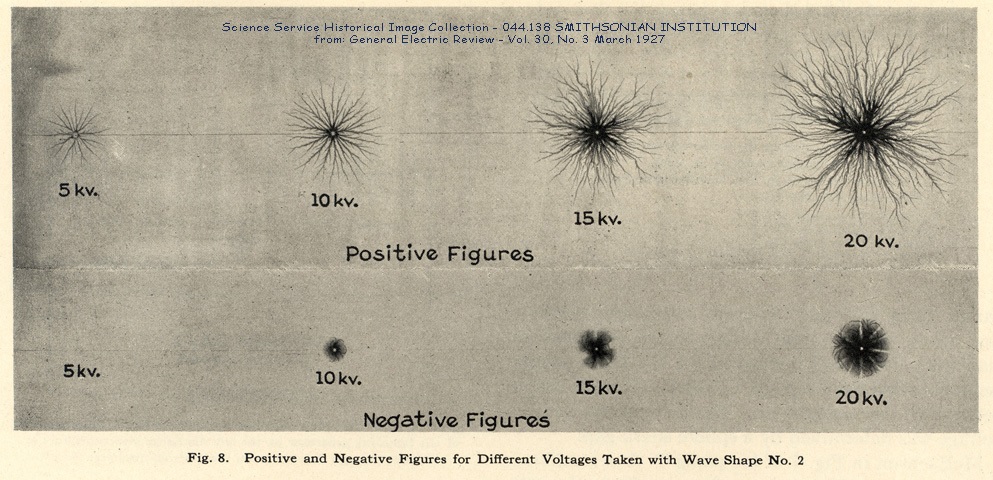
Lichtenberg Figures show a distinct geometry if the electrical discharge is positive or negative.
As I studied various methods of creating Lichtenberg Figures, I began to see the similarities that electrical
discharge trees have to galactic structures throughout the universe.
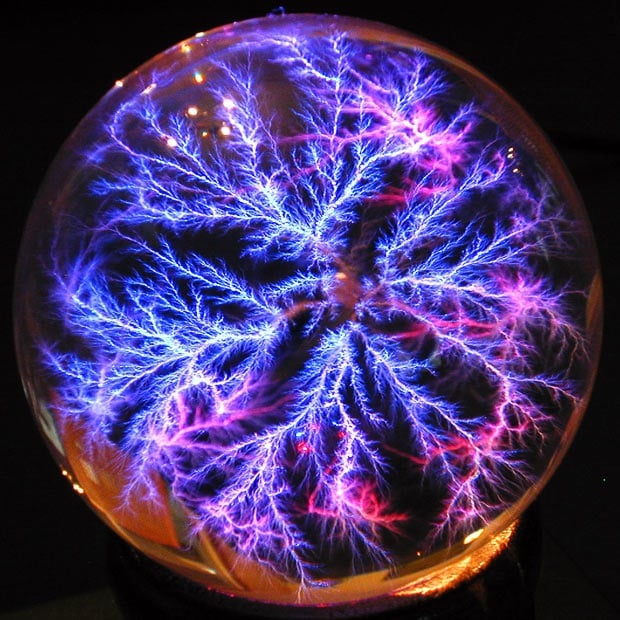

ASSEMBLED GALACTIC STRUCTURES FROM REDSHIFT SURVEYS
2MASS - The Two Micron All-Sky Survey
2dF Galaxy Redshift Survey
6dF Galaxy Survey
Redshift Survey
July 20, 2020
Sloan Digital Sky Survey Collaboration Releases New 3D Map of Universe
Astrophysicists and cosmologists from the Sloan Digital Sky Survey (SDSS) have released the largest 3D map of the Universe ever created,
filling in the most significant gaps in our exploration of its history. At the heart of the new results are detailed measurements
of more than two million galaxies and quasars covering 11 billion years of cosmic time.

2020 RELEASE OF EBOSS GALACTIC SURVEYS
I began to study the distribution of galaxies through the various galactic surveys that are included with the
software packages in Stellarium and Open Space. What I discovered is a very Newtonian distribution of super-galactic clusters at the
center of the halo of galaxies that surround the Milky Way Galaxy.
There is an expanding cylinder of super-massive galaxy clusters extending from one particular part of the sky to the opposite part of the sky. There is also
one particular part of the sky where Galactic Bursts seem to be centered. It is part of this expanding cylindrical cone
that I call The Core of Creation.
THE MOLECULAR MODEL
Readers may ask why would I need to look at the universe if I want to build a better battery.
The simple answer is that all solid matter comes in some form of crystalline structure.
Dr. Harold Aspden wrote a great deal about Perovskite Materials. The following video contains a lecture by an expert in the field.

POPULAR PEROVSKITE MOLECULES
I do not want to distort Dr. Aspden's original work, but the work of numerous researchers fits nicely inside of his model.
Richard Hoagland believes that an Interlaced Tetrahedron might be a good model of the photon.
An Interlaced Star Tetrahedron fits inside one of Aspden's cubic Quon Lattice Cells.
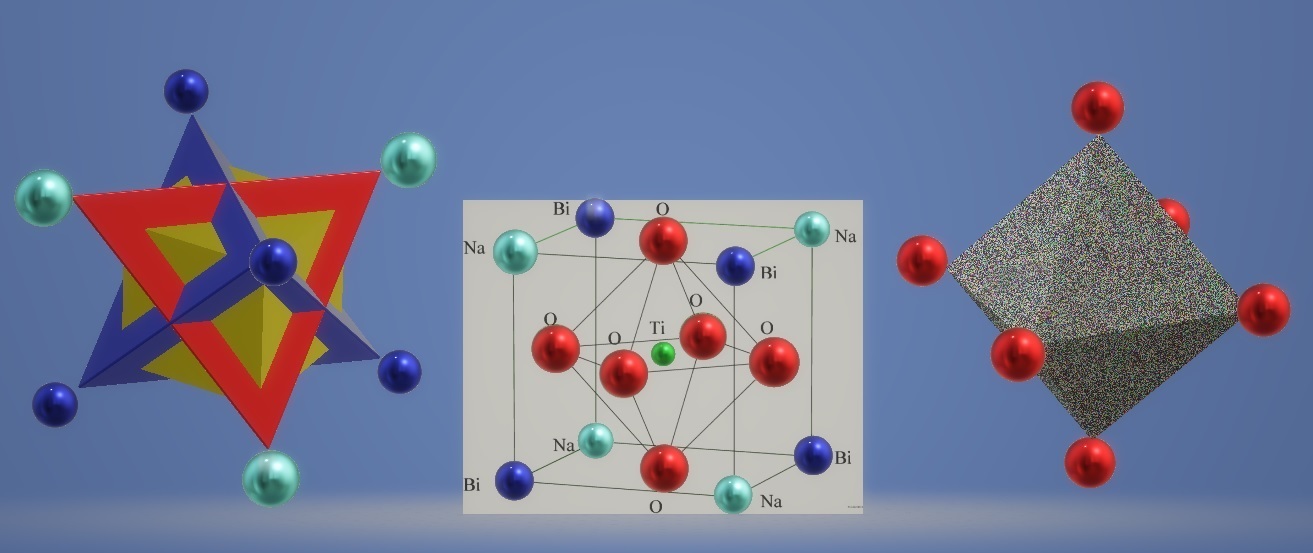
THE BISMUTH SODIUM TITANATE MODEL ALIGNS
WITH DR. HAROLD ASPDEN'S MODEL OF THE VACUUM
THE BISMUTH AND SODIUM POSITIVE CATIONS FORM
ON THE VERTICES OF THE INTERLACED TETRAHEDRON
THE NEGATIVE OXYGEN ANIONS FORM
ON THE VERTICES OF THE OCTAHEDRON
THE TITANIUM ATOM RESIDES WHERE THE GRAVITON RESTS
Aspden's Di-Muon is a two Muon Complex, each has a slightly different mass. The Aspden Di-Muon is a good candidate
for Hoagland's Interlaced Star Tetrahedron.
In such a scenario of Aspden's Di-Muon, note how in the perovskite material Bismuth Sodium Titanium Oxide,
the Cations of two different elements can form on the vertexes of each seperate tetrahedron.
Readers can readily see that in all perovskite materials we see a cubic structured molecule with an octahedron as its central component.
As I have shown above, some astronomers believe that galaxies have formed on the corners of huge octahedrons in space.
As Linda Moulton Howe presented in her Dark Pyramid In Alaska Series, pyramids apparently
amplify Vacuum Energy at the vertexes. I suspect that not only energy gathers at the vertexes but that the energy to
matter conversion happens there too, and we see that in galactic clusters.
I built this Webpage around the Largest Universal Structures and the Most Distant Universal Structures.
This is where time and space are defined. Since my research is an ongoing affair, I have designed this page to add new information
regarding these universal structures.
The new release of the Sloan Digital Sky Survey Collaboration on July 20th, 2020 was a lucky coincidence.
I have been building these web pages for the last two-months.
NOTES ON PERSPECTIVE
Most of the graphics that I use from Stellarium and Open Space are set in Milky Way Galactic Coordinates. If you are a fan of Star Trek, this is the Main System of Units.
Cosmologists use Super-Galactic Coordinates. Stellarium easily converts to Super-Galactic Coordinates and when I am aligning the sky to the papers of astronomers who use Super-Galactic Coordinates, it is straightforward and I will note that the screenshot is in Super-Galactic Coordinates, and if it is not noted, I am using Milky Way Galactic Coordinates.
The purpose of my analysis of the sky based on current cosmology is the introduction of the importance of Cosmic Voids. Open Space easily allows Users to toggle on the Labels for Cosmic Voids; however, in Stellarium, the galaxy catalogues are precise and defined, but there is no feature to identify the Cosmic Voids. Therefore, Users, must use their imagination with the selective use of the size of The Field of View.
The Field of View is critical in Fractal Math.
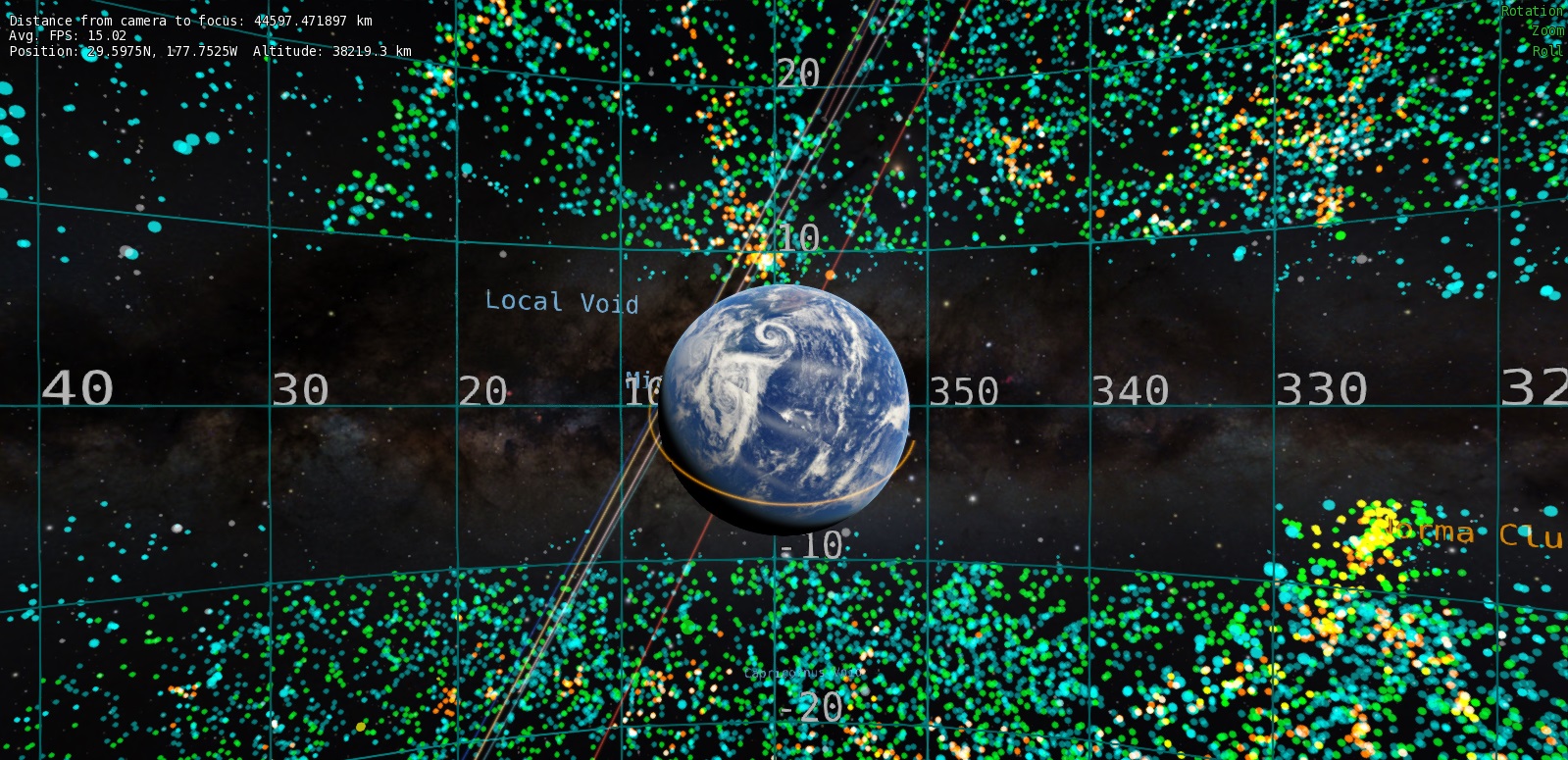
THE VIEW IN OPEN SPACE
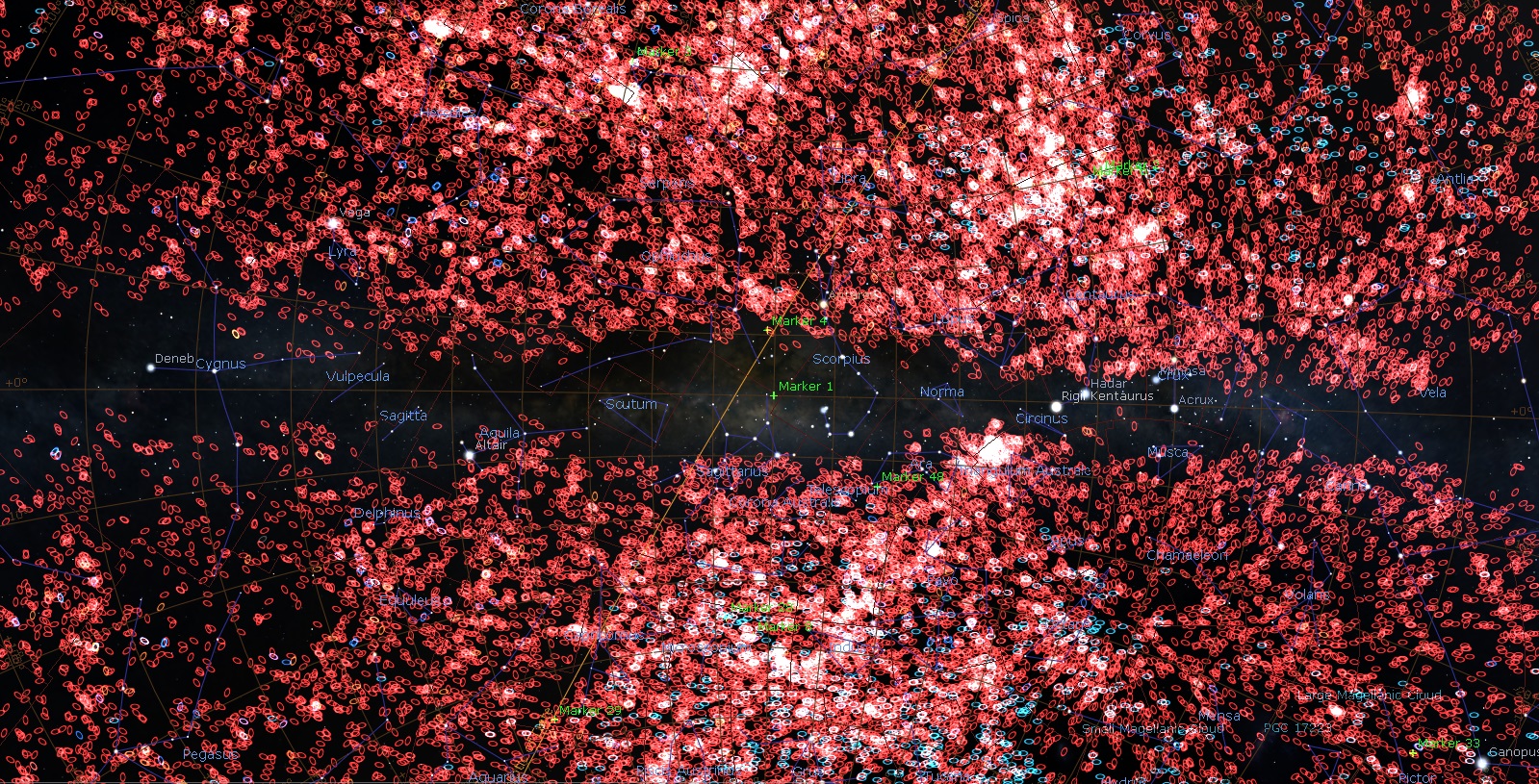
THE SAME VIEW IN STELLARIUM
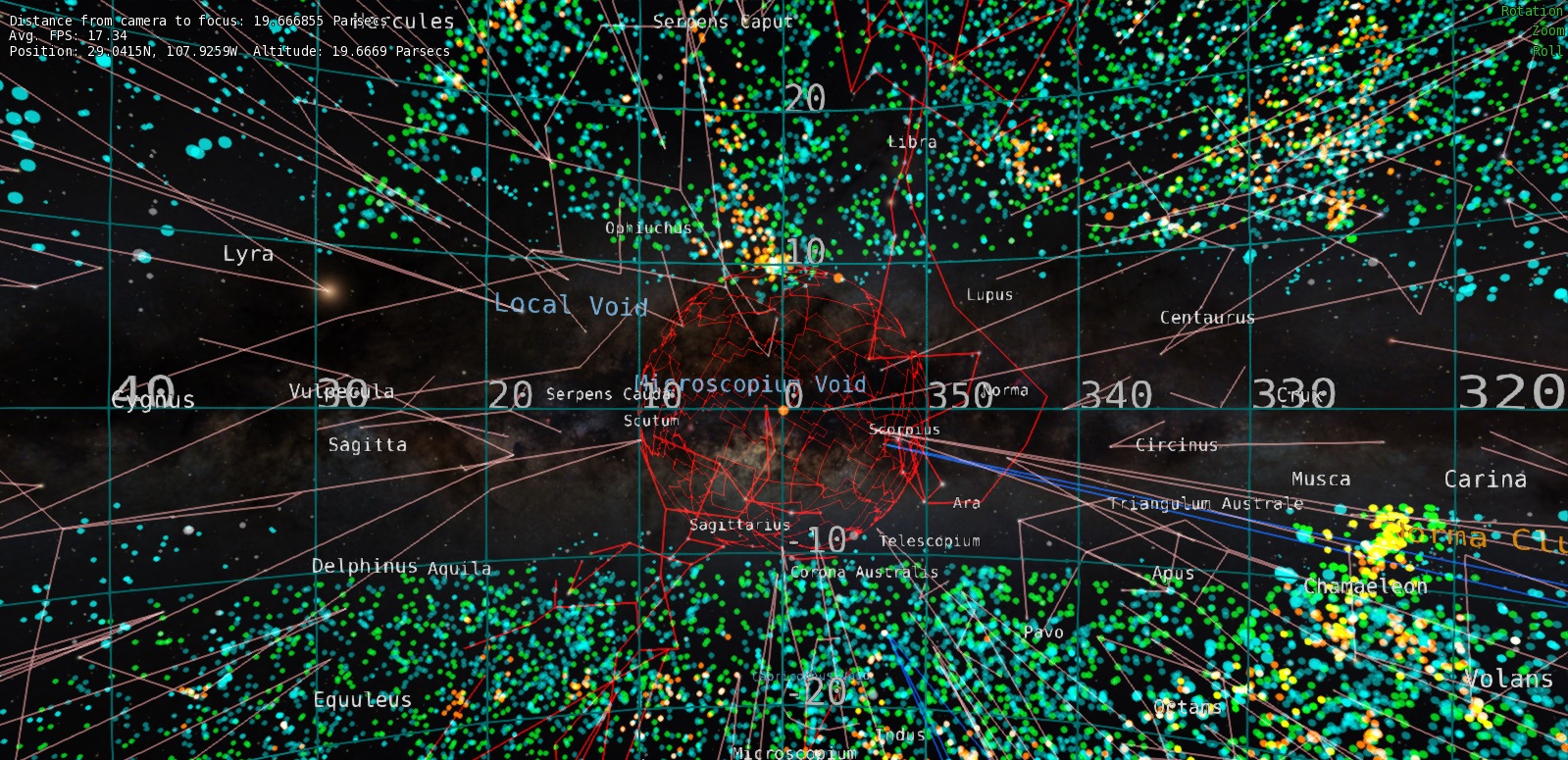
THE CONSTELLATION REFERENCE FRAME IN OPEN SPACE
Once outside of the Milky Way Galaxy, you can no longer use the Constellations as a reference. Open Space will allow Users to toggle Constellations on
outside of the Milky Way up to a point.
Open Space will also allow Users to exit the universe through the Cosmic Microwave Background.
Stellarium on the other hand is the view from my back porch with a really good zoom.
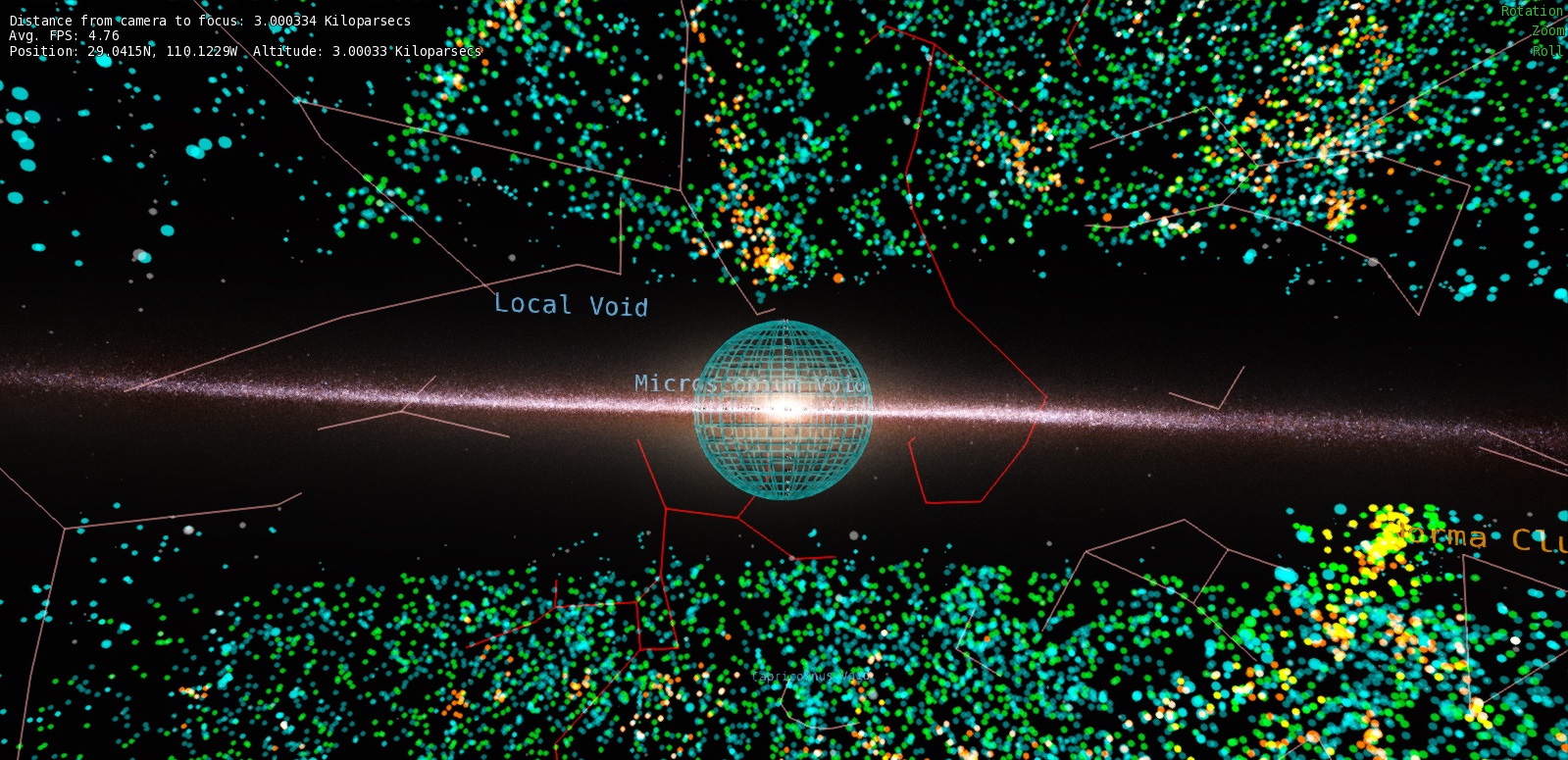
THE VIEW IN OPEN SPACE
After exiting the Milky Way, Open Space keeps a sphere of the Galactic Coordinates as a reference point.
This view is the extended plane of the Milky Way, North Pole Up, South Pole Down.
Astronomical Surveys will present maps similar to this view along the plane of the Milky Way. The Zone of Avoidance is where the Milky Way's
dust plane will not allow modern sensors to penetrate.
In Open Space I have used that as a reference frame.
THE UNIVERSE WE CAN OBSERVE AND MEASURE
The image below presents the universe from the perspective of the Milky Way Galaxy looking edge on.
The shadow in the middle is the Zone of Avoidance. Visible light sensors cannot penetrate the vast cosmic clouds of
particles along the plane of the galaxy.
The various colored pixels are actual galaxies and galaxy clusters.
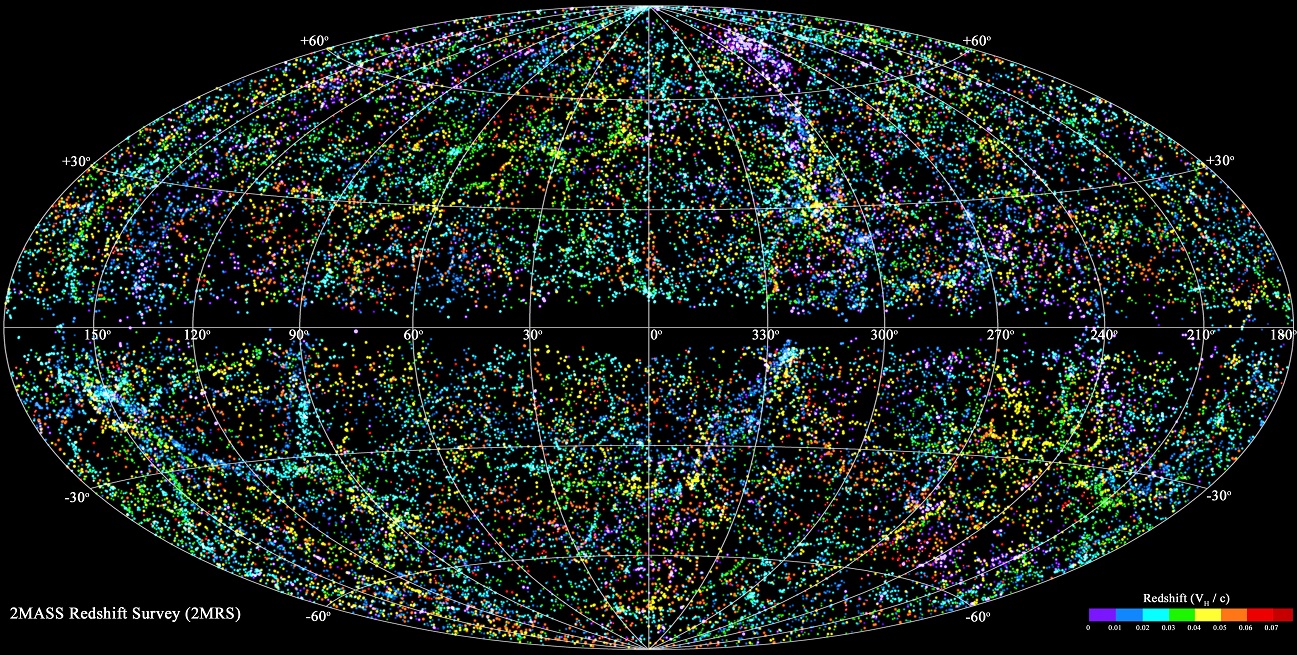
2MASS
The Two Micron All-Sky Survey, or 2MASS, was an astronomical survey of the whole sky in the infrared and one of the most ambitious such projects.
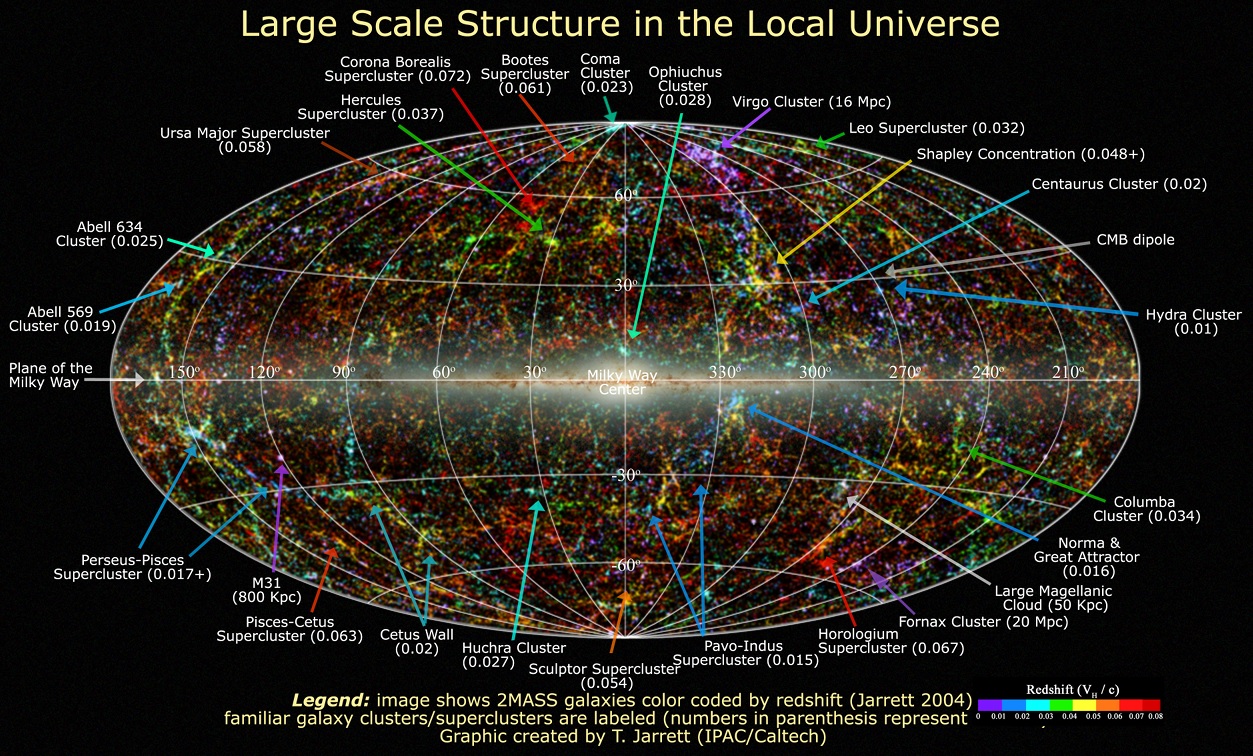
All Sky Images of the XSC
The 2MASS Extended Source Catalog (XSC) is primarily composed of galaxies, and secondarily of Milky Way objects.
Galaxies are detected all across the sky except for regions of the Galactic Plane that are opaque with stars
(e.g., Galactic Center in Sagitarrius). Galaxies concentrate on several spatial scales, including groups,
clusters, and large filamentary superclusters. Milky Way objects are almost exclusively confined to the Galactic Plane...
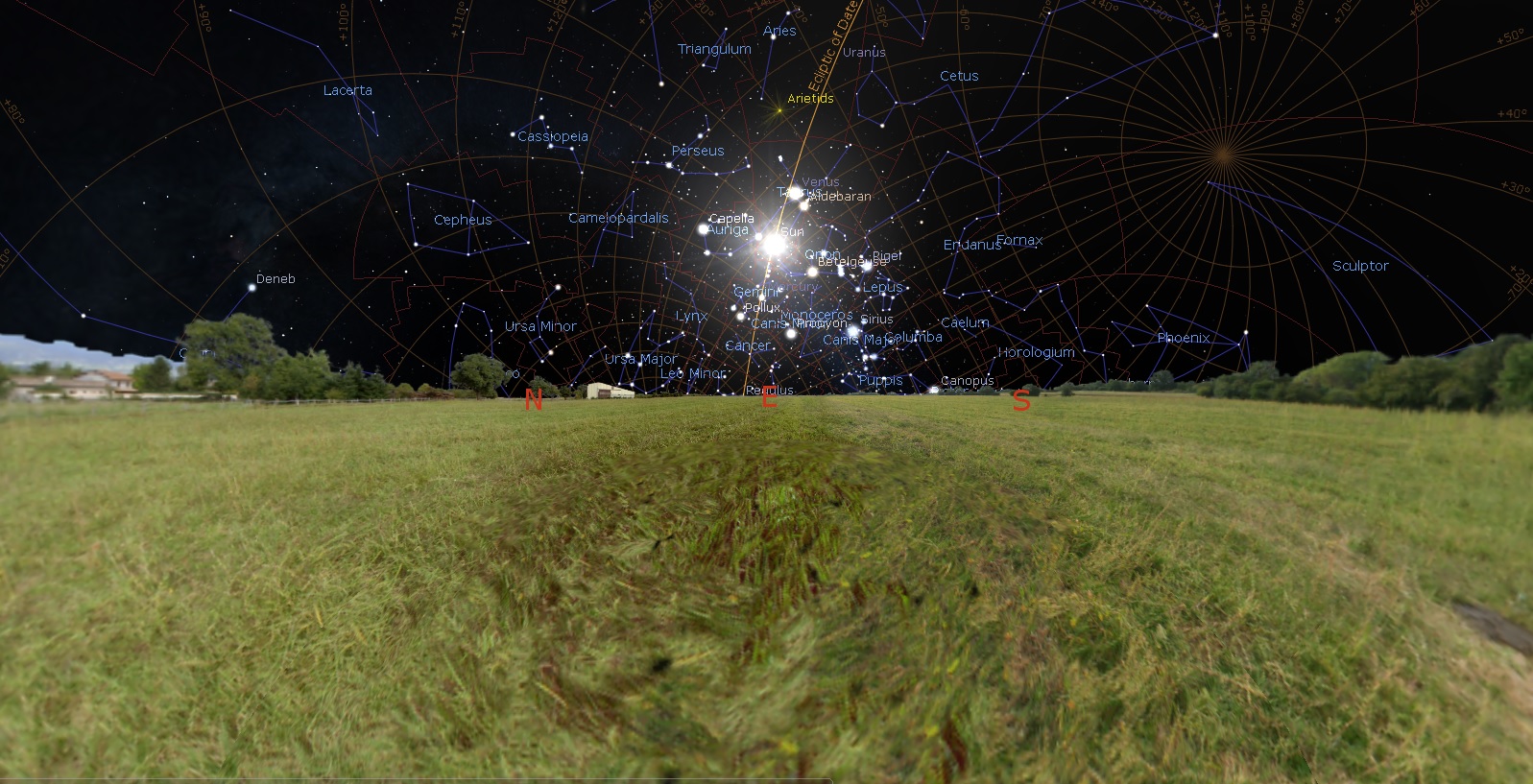
THE VIEW FROM STELLARIUM
THE SKY – LOCAL TIME – THE ECLIPTIC – THE CONSTELLATIONS – PLANETS – STARS
GALACTIC COORDINATES ONLY – GALACTIC POLES - 235 DEGREE FIELD OF VIEW
The following screenshots from Stellarium and Open Space
I hope will prove my point regarding the distribution of the universe's more massive structures, the galactic clusters.
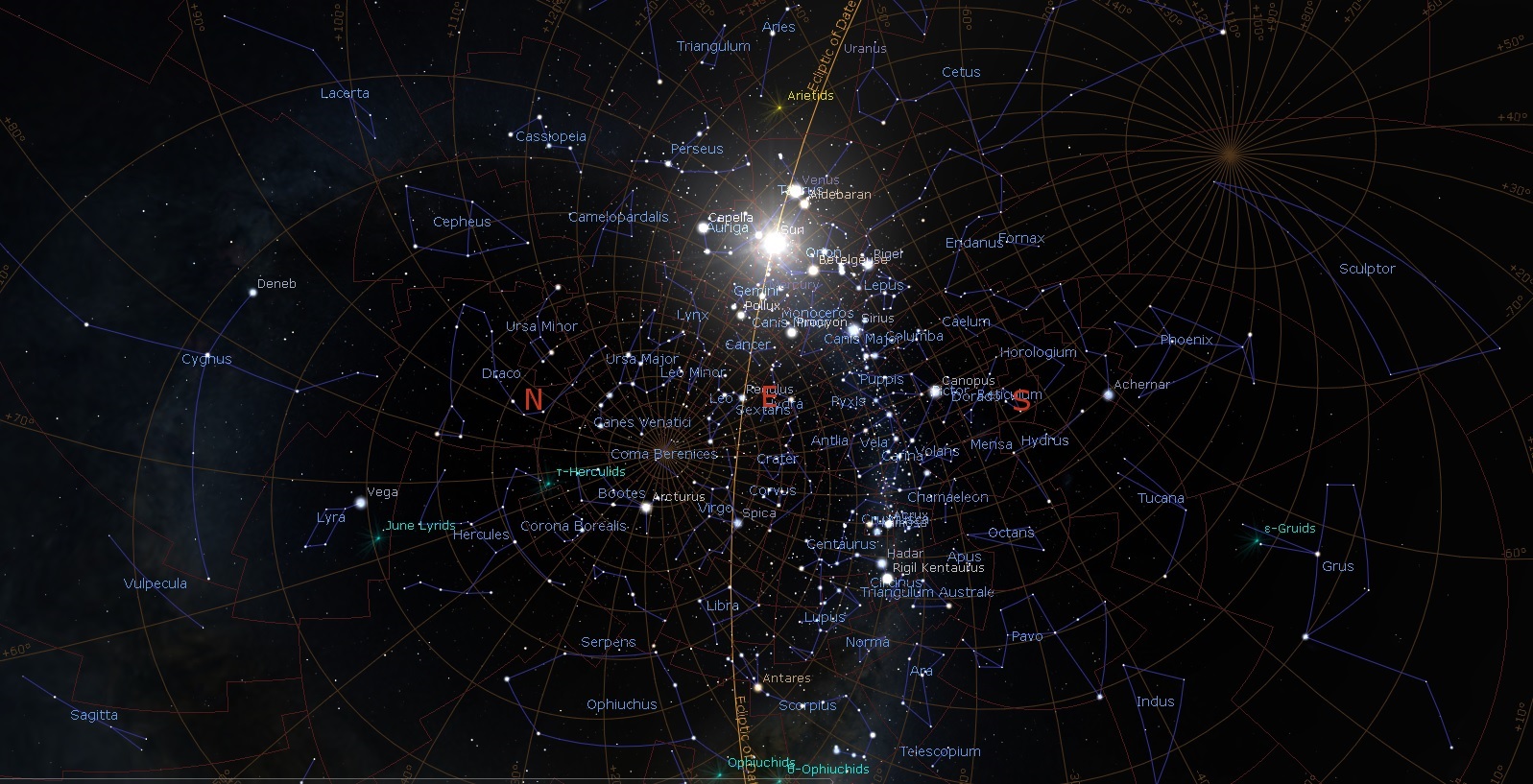
REMOVE THE EARTH
THE SKY – LOCAL SPACE AND TIME – THE ECLIPTIC
THE CONSTELLATIONS – PLANETS – STARS
GALACTIC COORDINATES ONLY – 235 DEGREE FIELD OF VIEW
I have removed the Earth and the Field of View is a bubble in space that includes the Northern and Southern Hemispheres. The Ecliptic is the plane in which the planets of the Solar System revolve around the Sun. I have kept that toggled on for a Solar System reference.
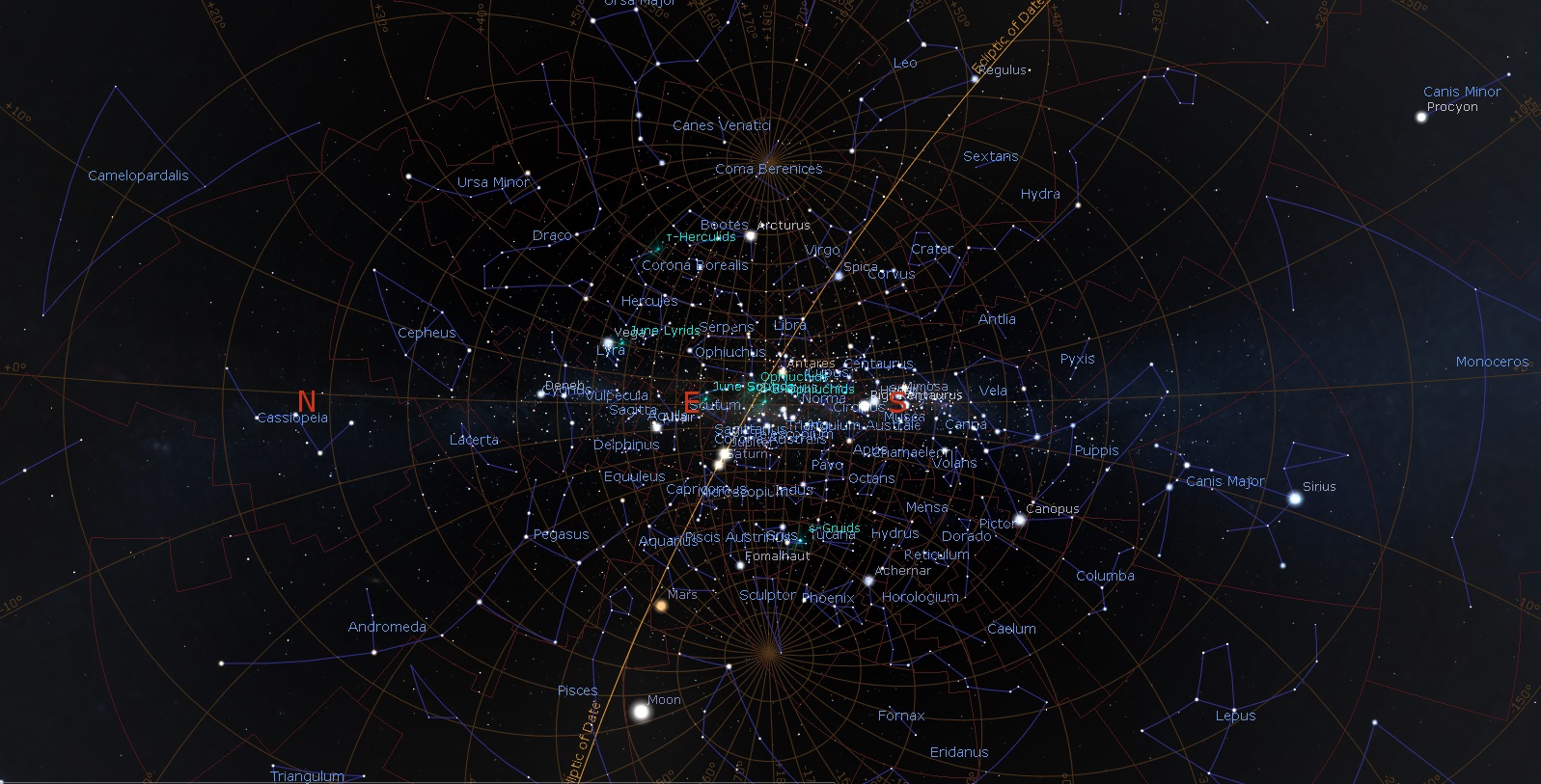
ROTATE UNTIL GALACTIC POLES ARE NORTH AND SOUTH
THE ECLIPTIC - THE CONSTELLATIONS – PLANETS – STARS
GALACTIC COORDINATES ONLY
235 DEGREE FIELD OF VIEW
I have rotated my view to look directly at the center of the Milky Way. The Galactic North Pole is at the top, and the Galactic South Pole is at the bottom.
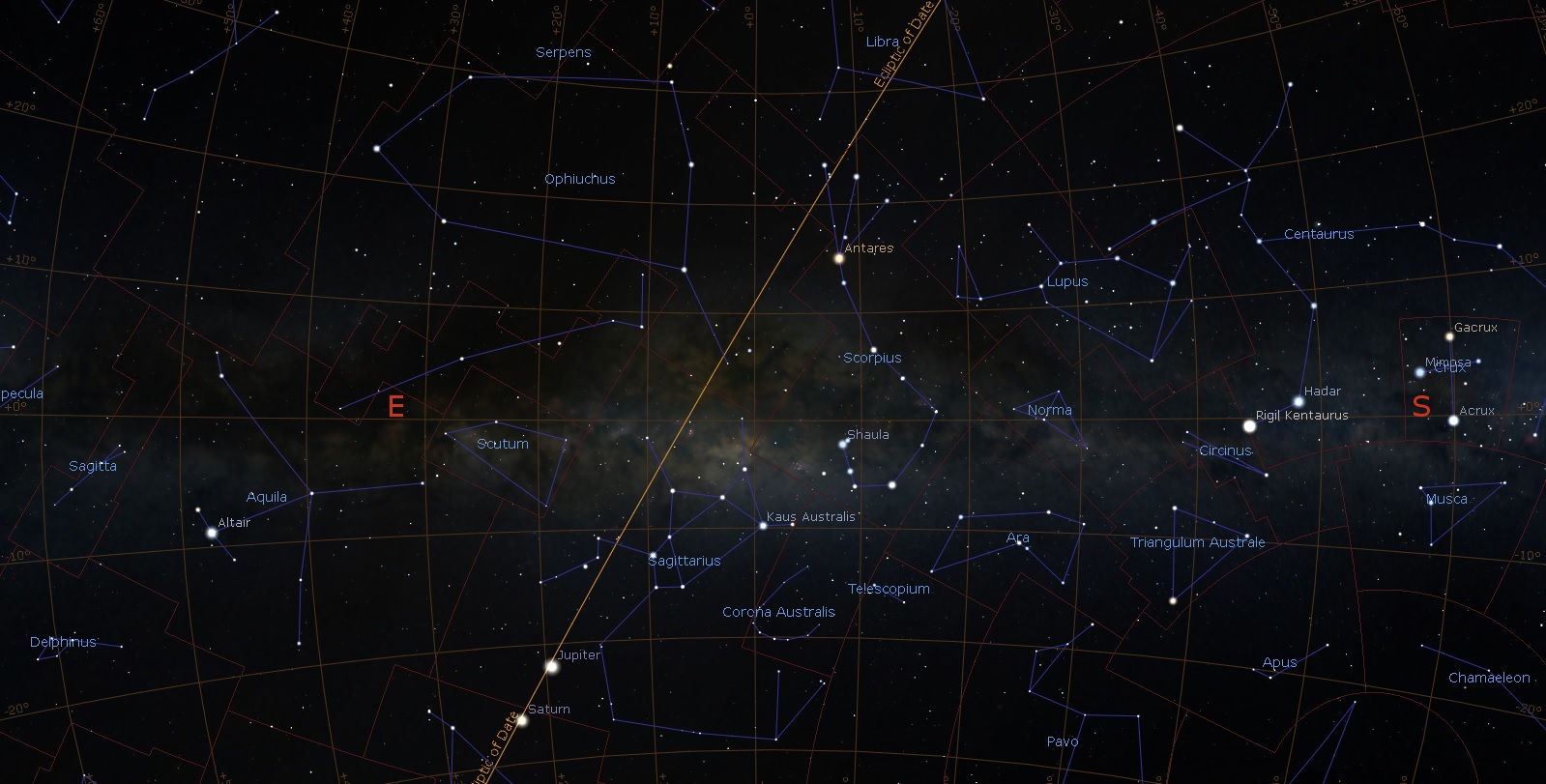
THE CENTER OF THE MILKY WAY GALAXY
REDUCE FIELD OF VIEW TO 73.2 DEGREES
Reducing the Field of View, I can zoom into the center of the Milky Way Galaxy.
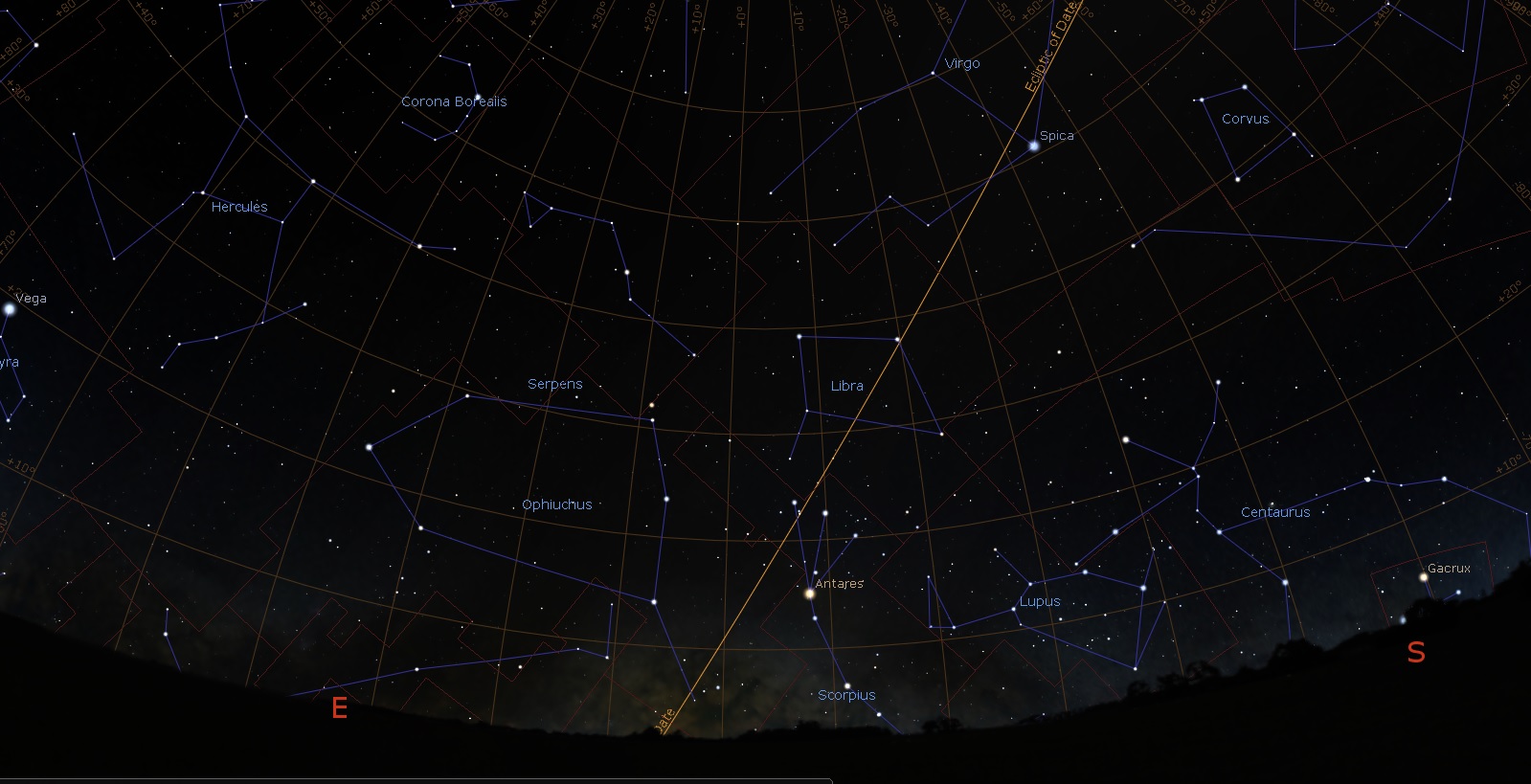
LOOKING DIRECTLY AT THE CENTER OF THE GALAXY GROUND VIEW
This is my ground view as I center on the heart of the Milky Way Galaxy.
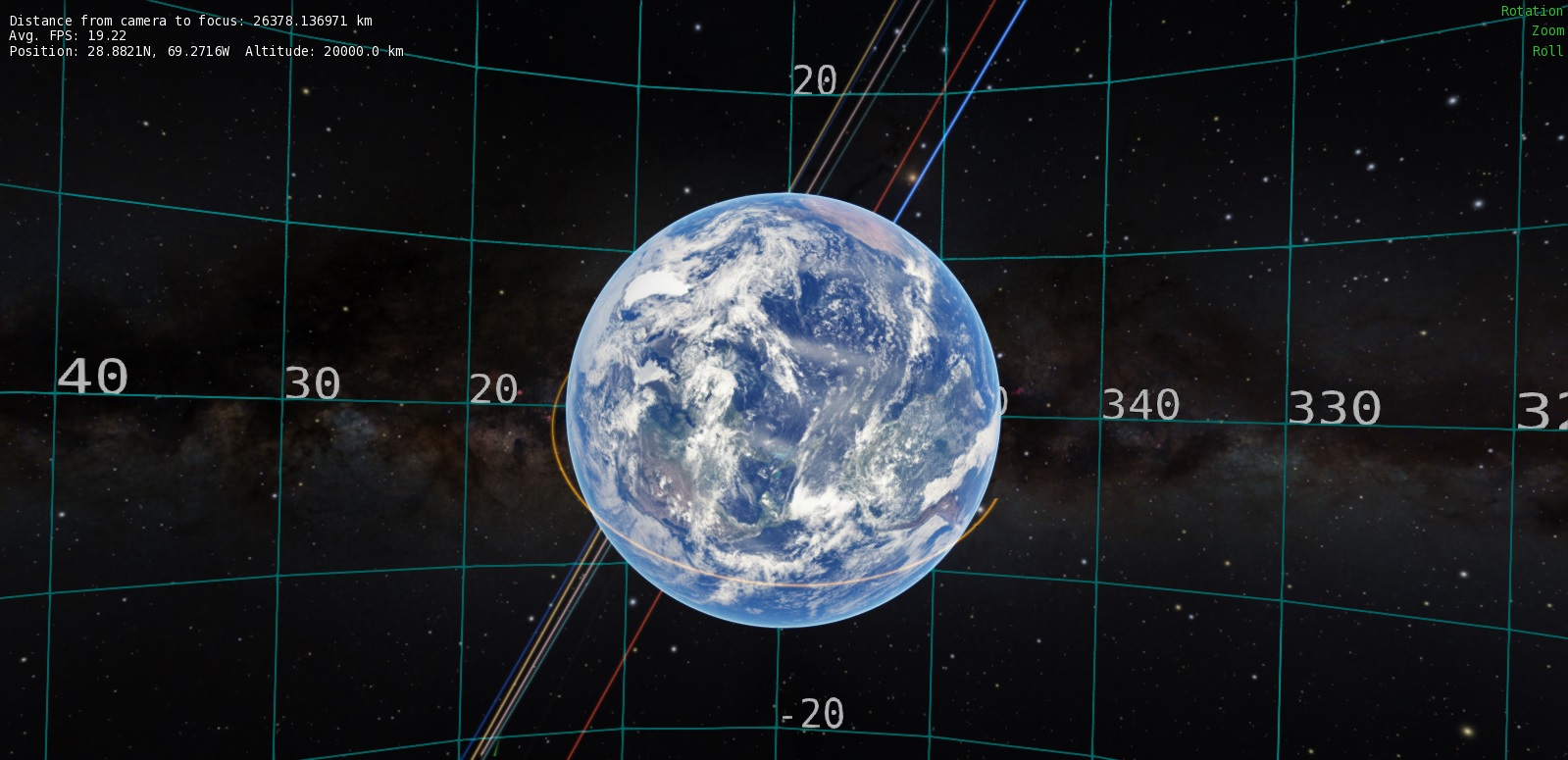
THE VIEW FROM OPEN SPACE
SAME POSITION FROM THE BACK OF THE EARTH
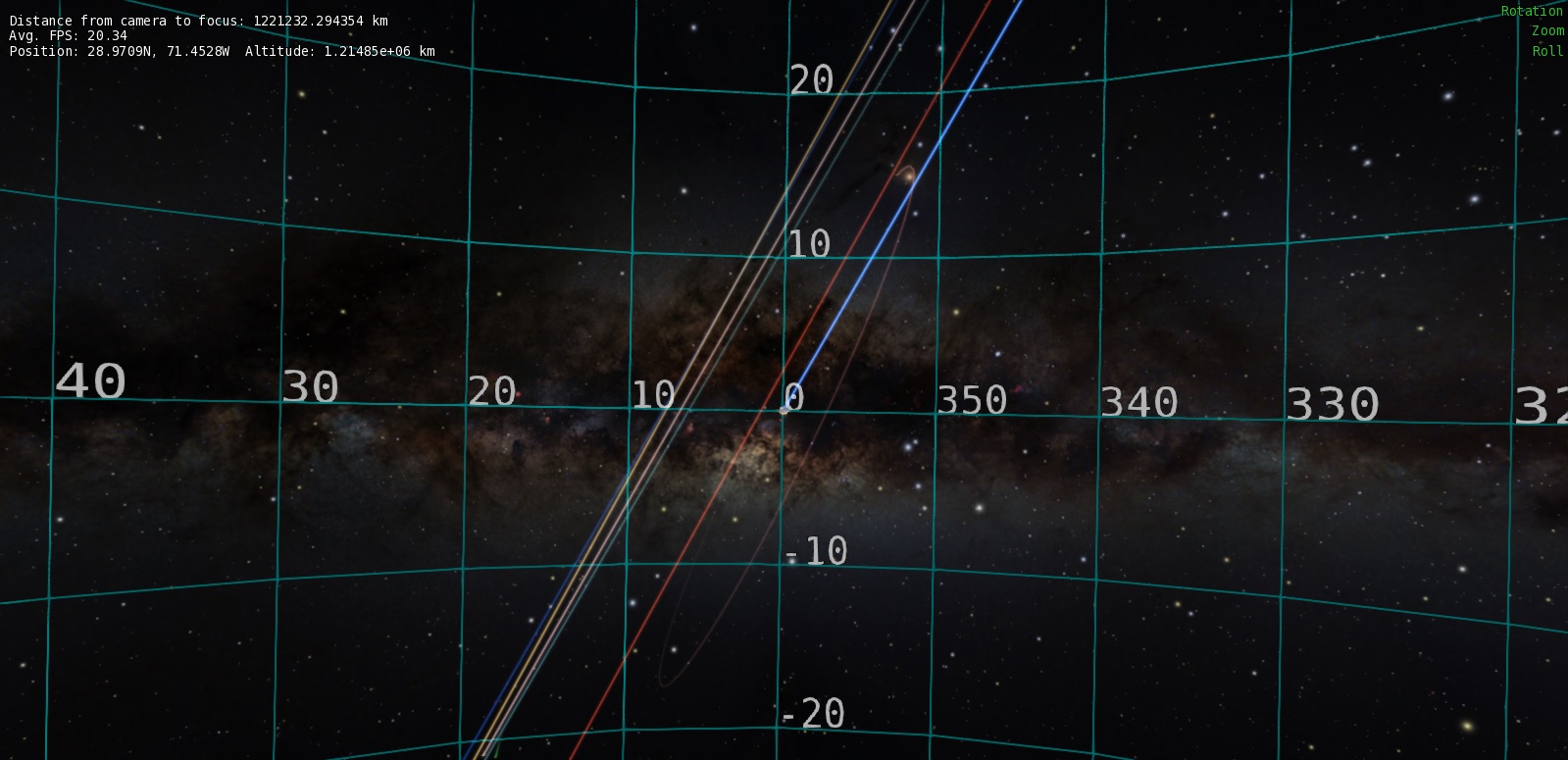
THE CENTER OF THE MILKY WAY
IN BACK OF THE EARTH EXTENDED BEYOND THE MOON'S ORBIT
THE ECLIPTIC AND PLANET ORBITS CROSS THE GALAXY CENTER
AN ATLAS OF THE UNIVERSE
This web page is designed to give everyone an idea of what our universe actually looks like. There are nine main maps on this web page,
each one approximately ten times the scale of the previous one. The first map shows the nearest stars and then the other maps
slowly expand out until we have reached the scale of the entire visible universe.

MARKER 1: CENTER OF MILKY WAY GALAXY
I have marked various areas of the universe. In particular I have marked Galaxy Superclusters and the most distant objects in the universe.
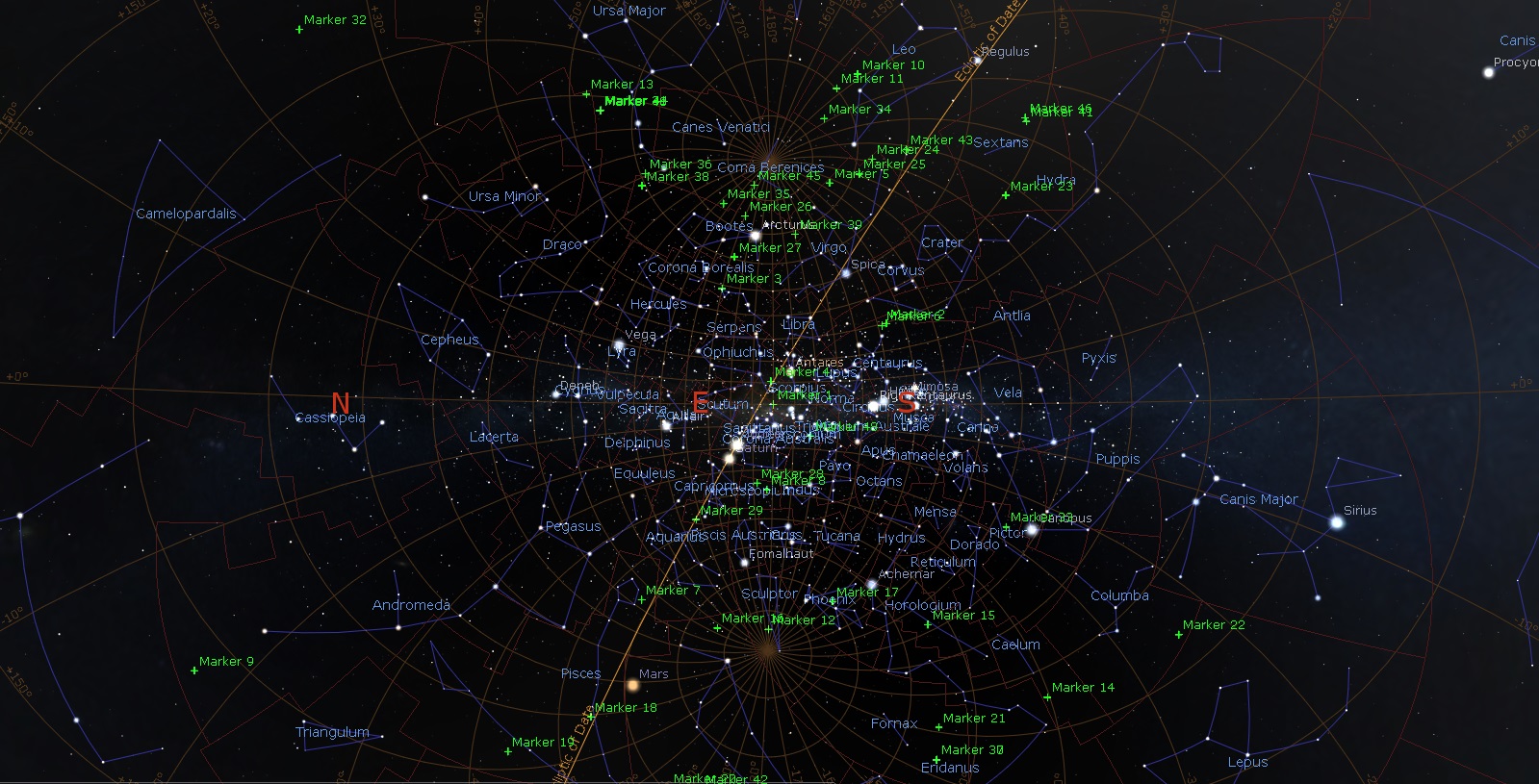
REMOVING THE EARTH
PLACING MARKERS ON ALL SUBJECT STRUCTURES
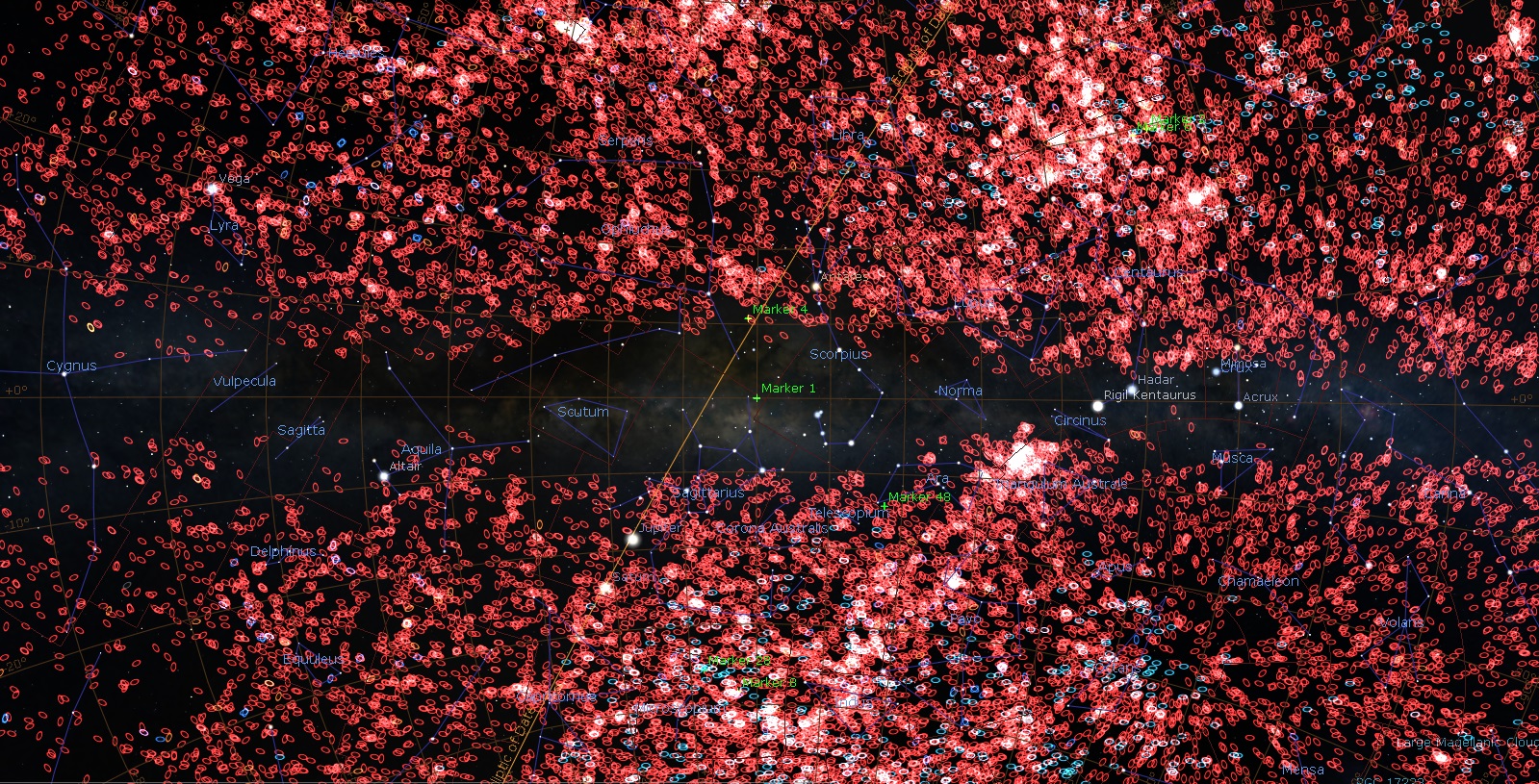
ALL GALACTIC SURVEY CATALOGUES ARE TURNED ON
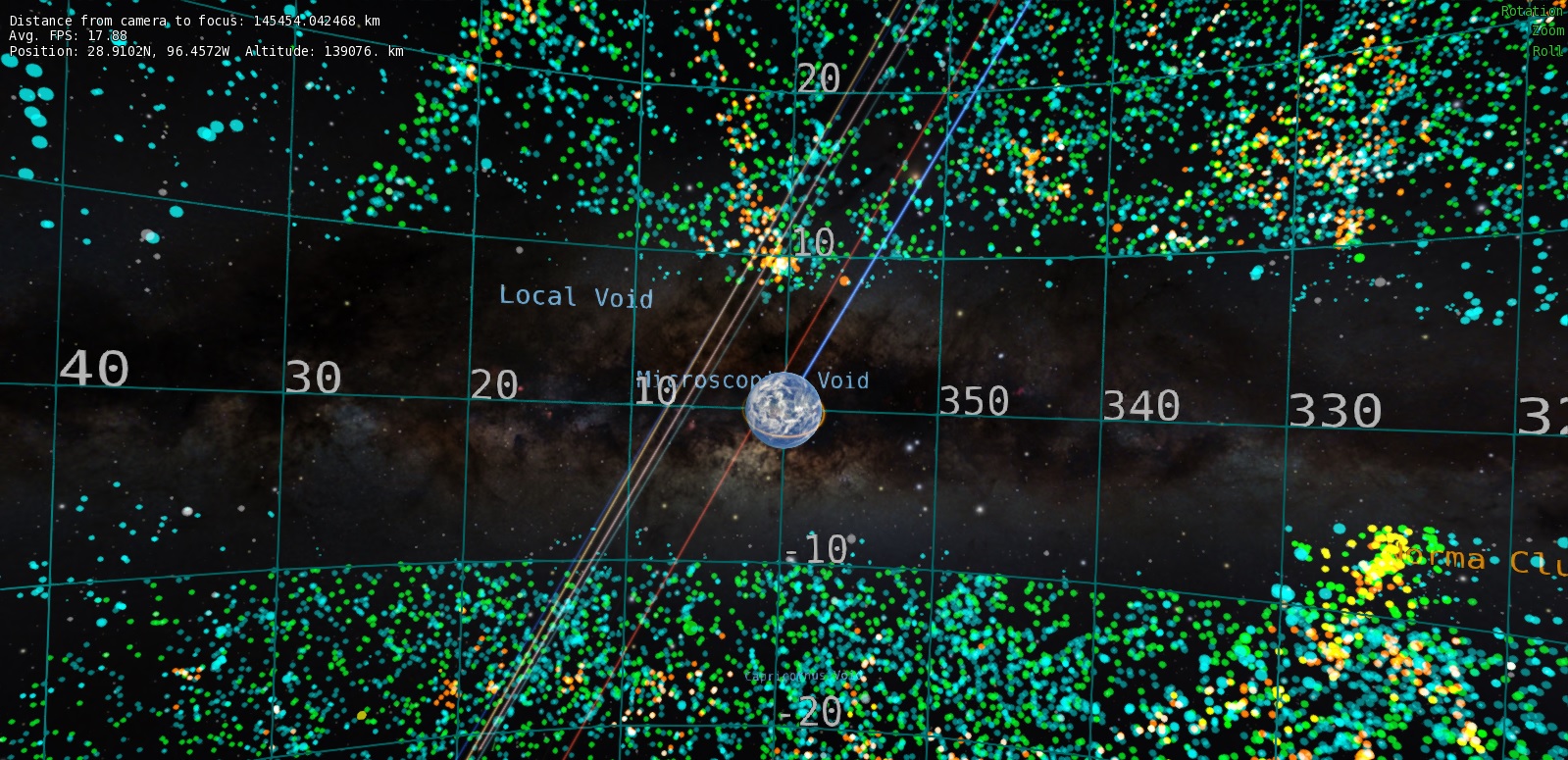
ALL GALACTIC SURVEY CATALOGUES ARE TURNED ON
All Galactic Survey Catalogues have been turned on. Individual Galaxies are in red. Galaxy Clusters are in blue.
THE CLOSEST LARGE GALACTIC STRUCTURES
SUPERCLUSTERS
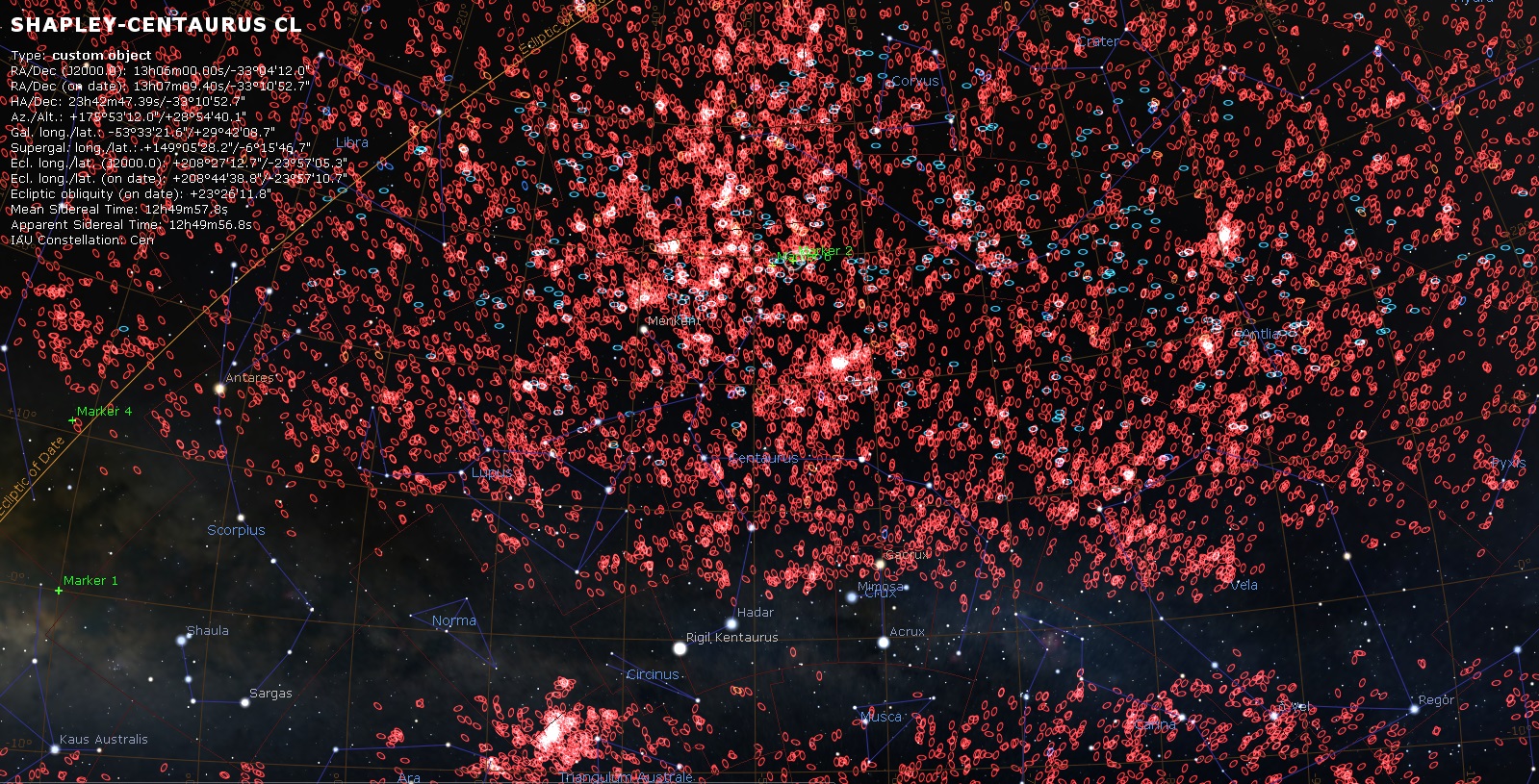
MARKER 2: SHAPLEY-CENTAURUS SUPERCLUSTER
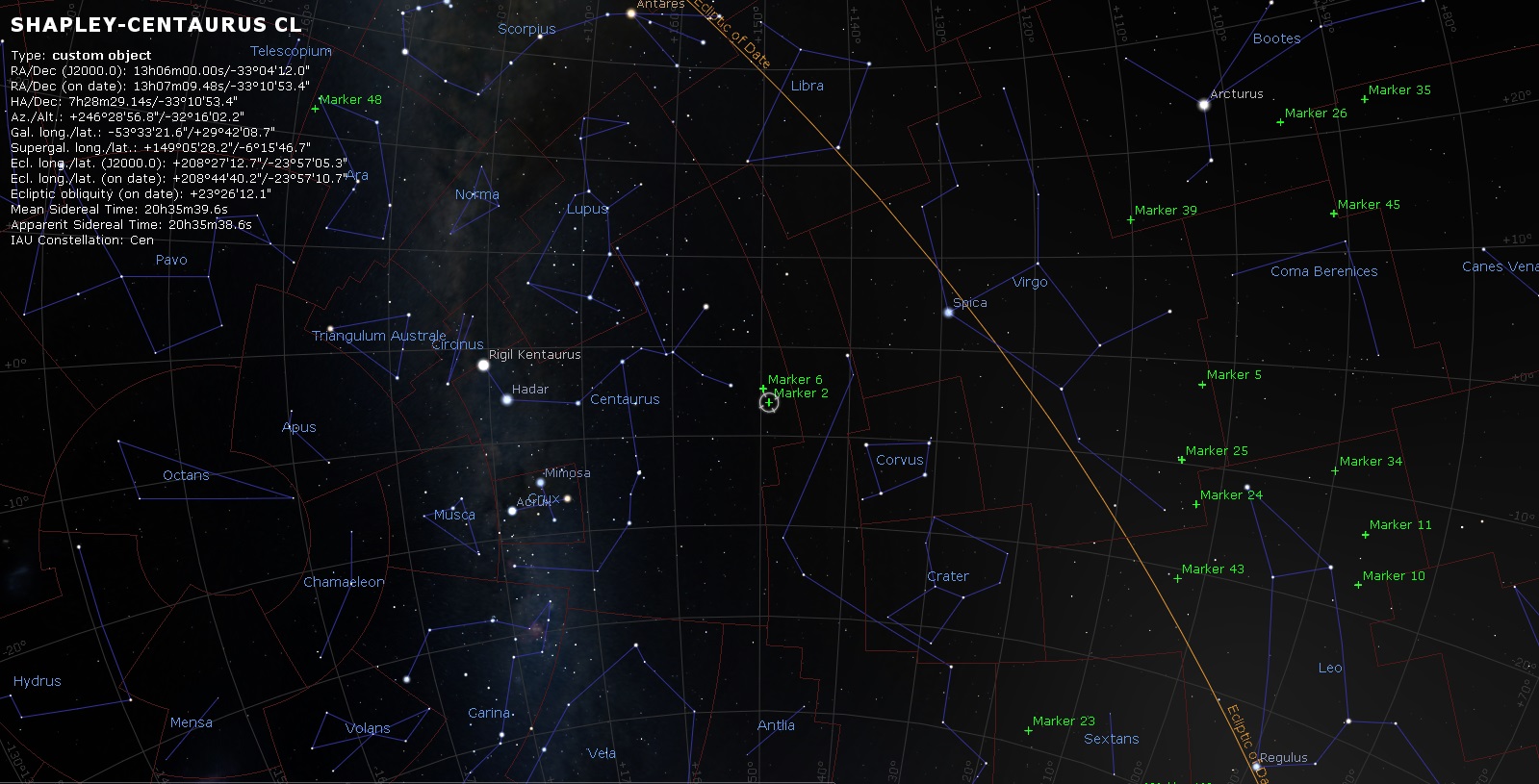
SUPERGALACTIC COORDINATES
MARKER 2: SHAPLEY-CENTAURUS SUPERCLUSTER

SUPERGALACTIC COORDINATES
OVERDENSITIES - LOCAL VOID: SHAPLEY-CENTAURUS SUPERCLUSTER
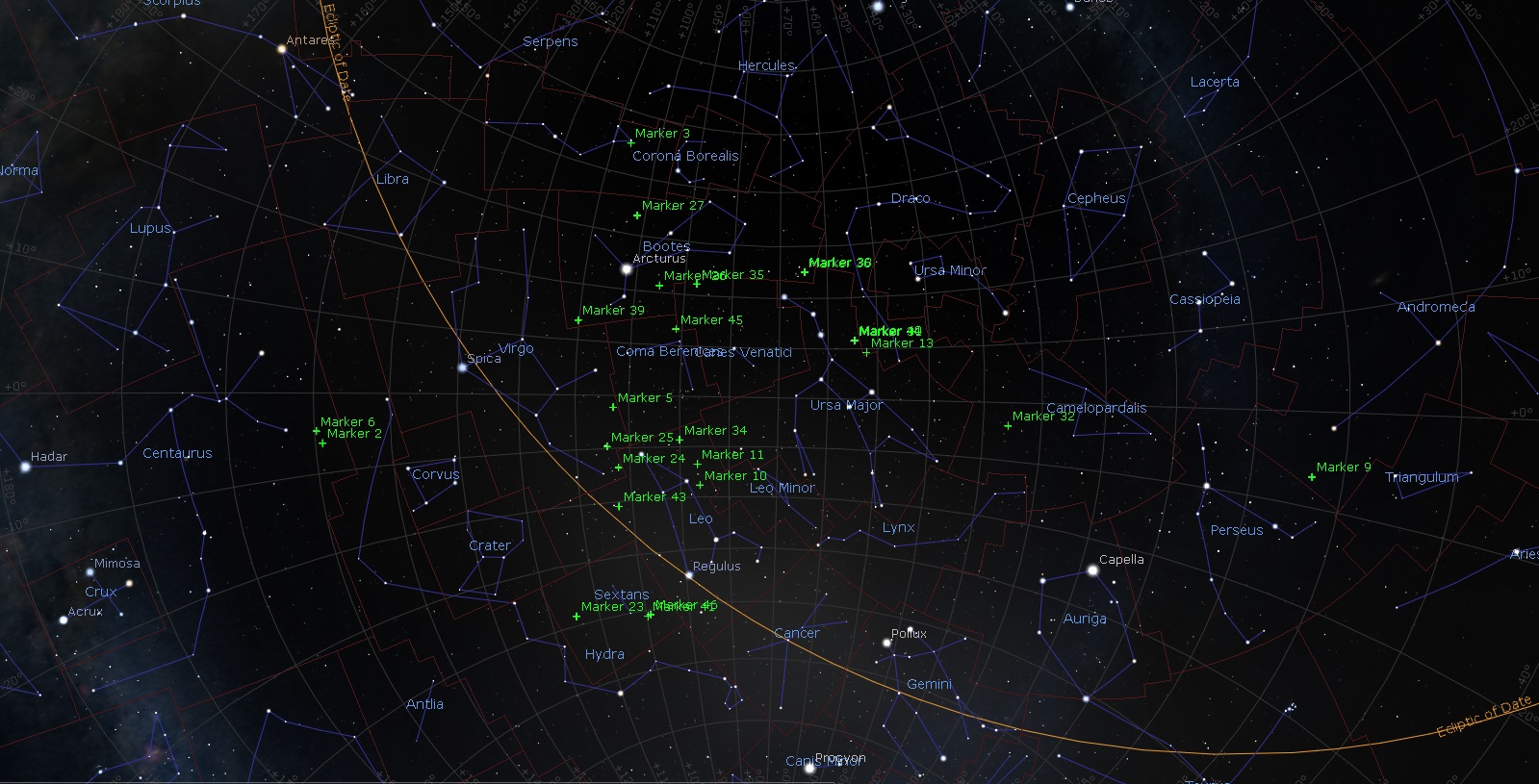
SUPERGALACTIC COORDINATES
MARKER 2: SHAPLEY-CENTAURUS SUPERCLUSTER
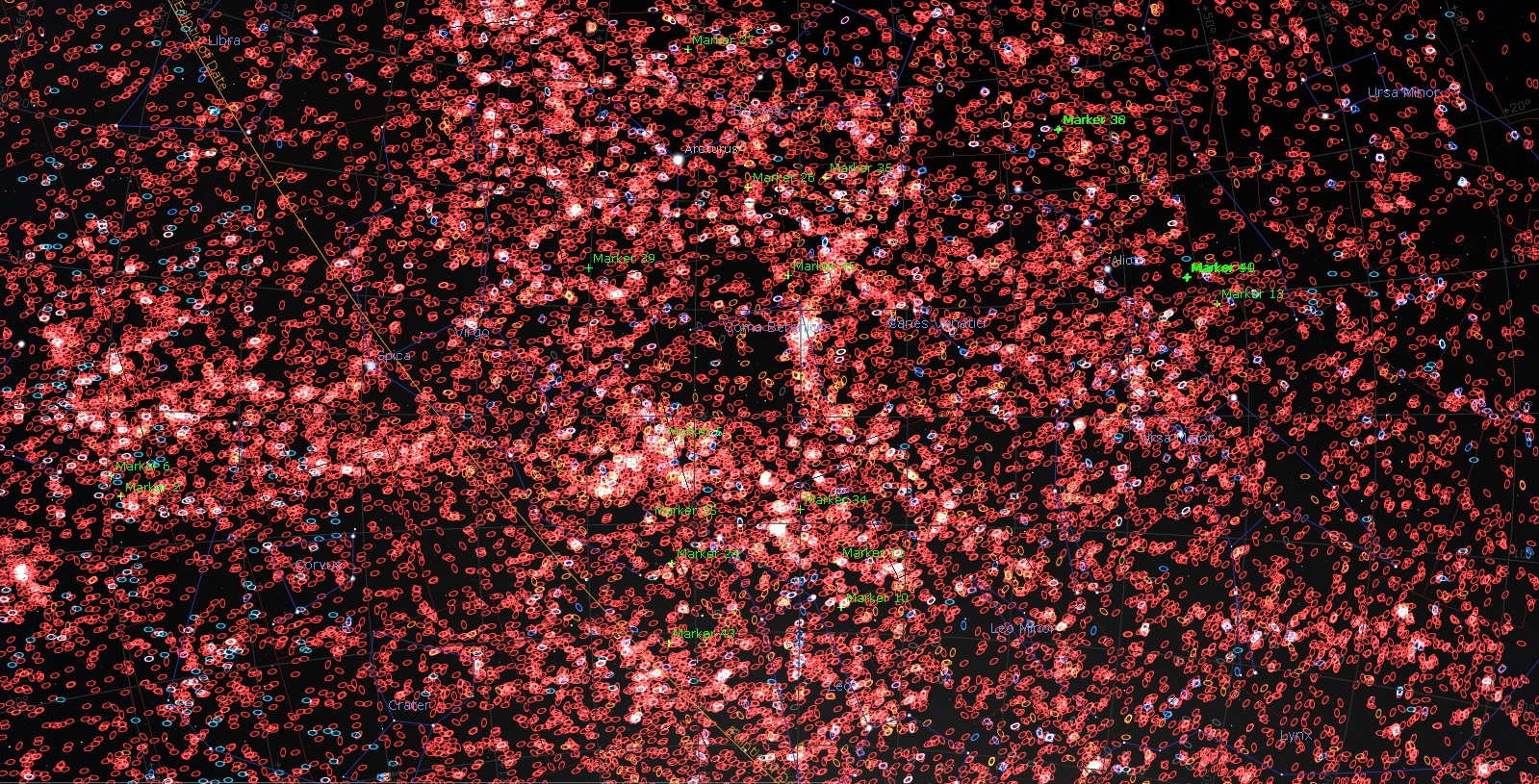
SUPERGALACTIC COORDINATES
MARKER 2: SHAPLEY-CENTAURUS SUPERCLUSTER
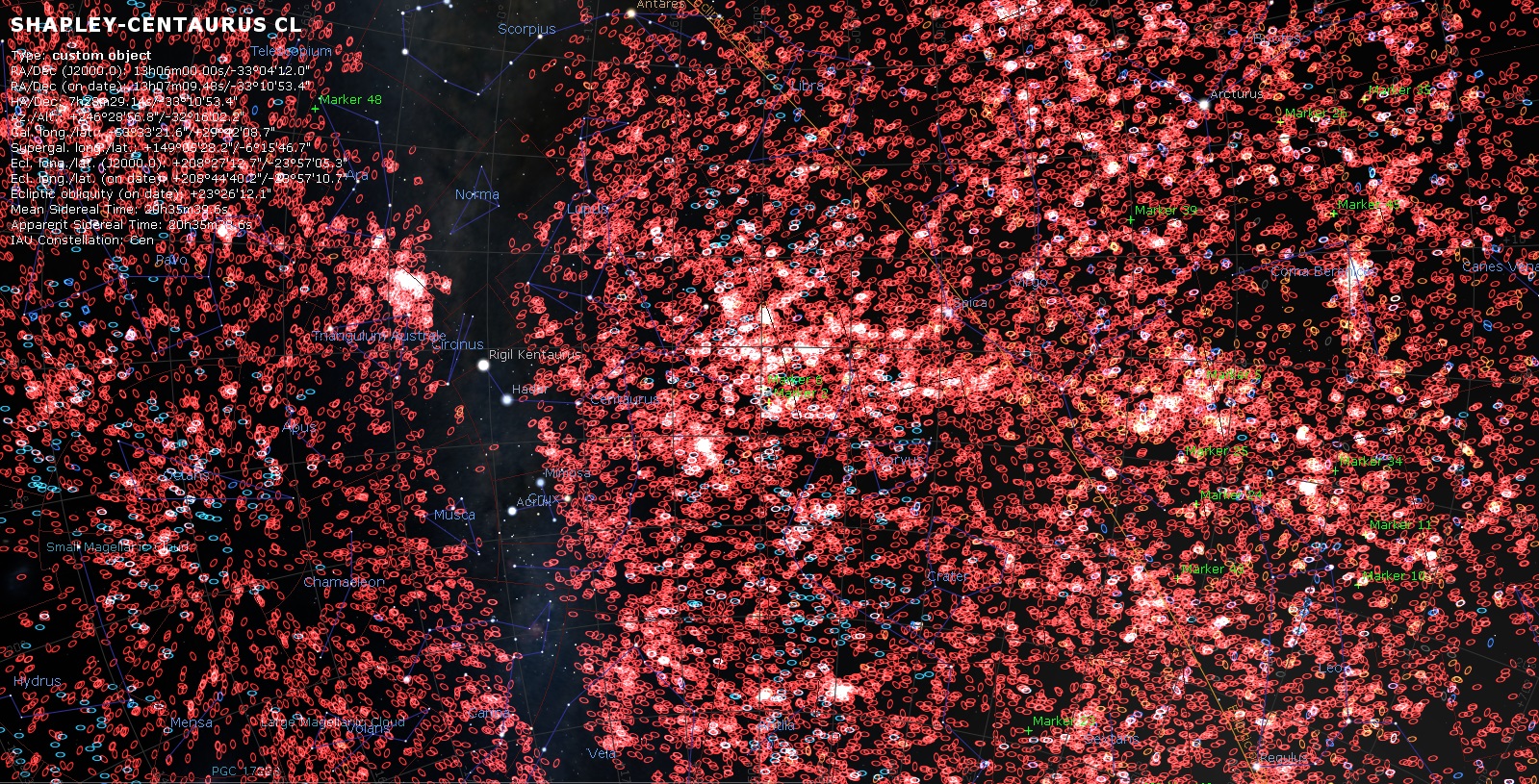
SUPERGALACTIC COORDINATES
MARKER 2: SHAPLEY-CENTAURUS SUPERCLUSTER
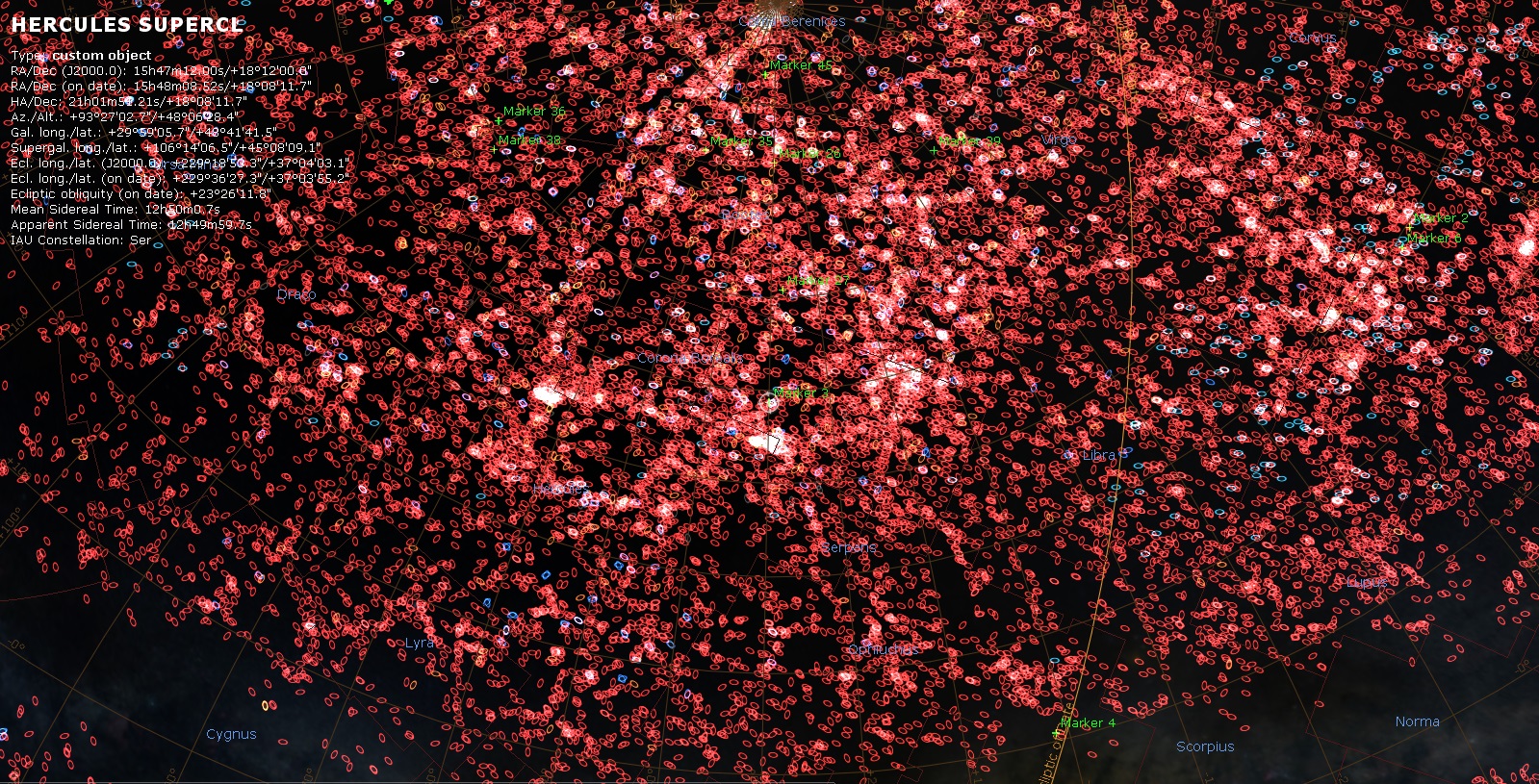
MARKER 3: SCL-160 HERCULES SUPERCLUSTER
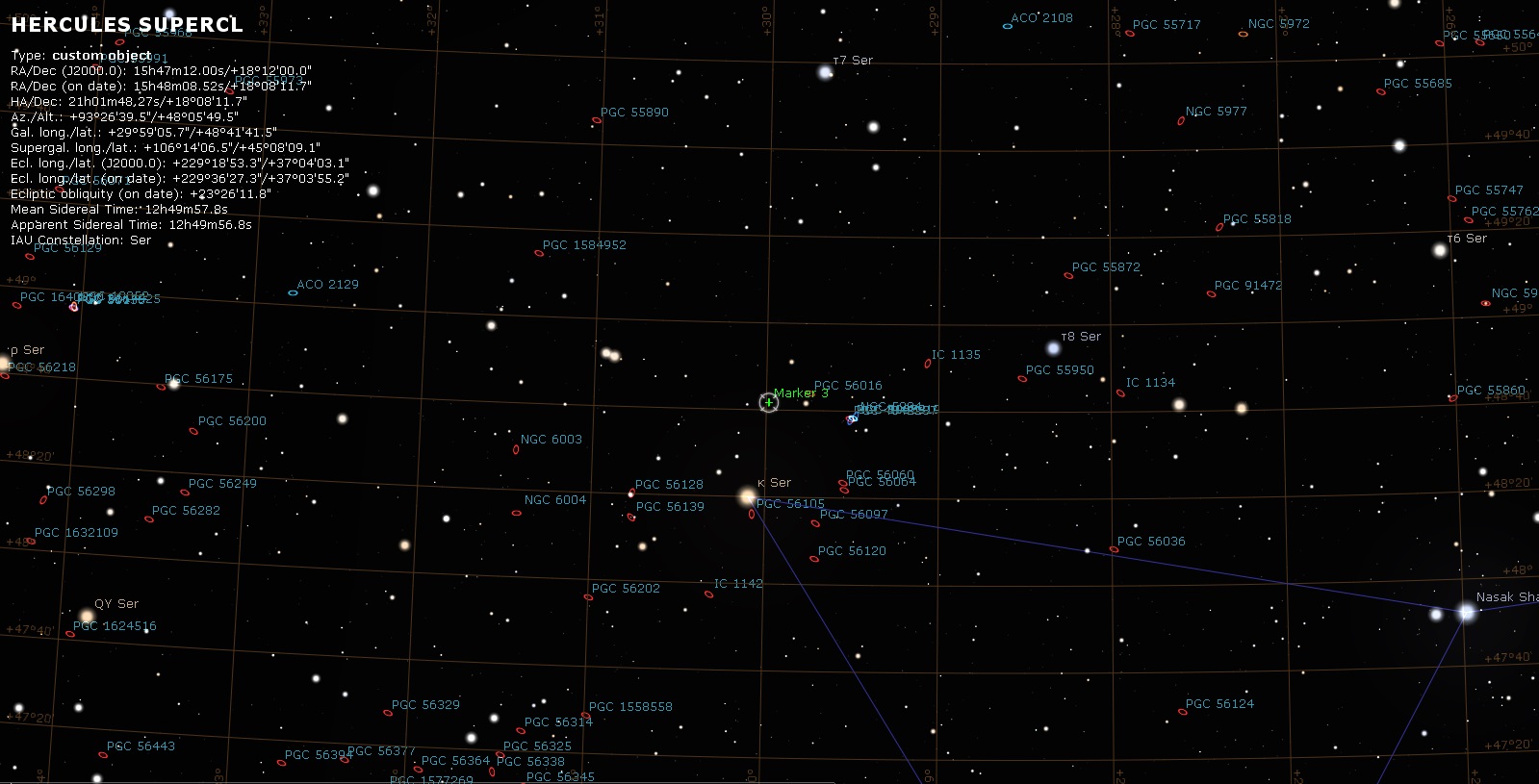
MARKER 3: SCL-160 HERCULES SUPERCLUSTER
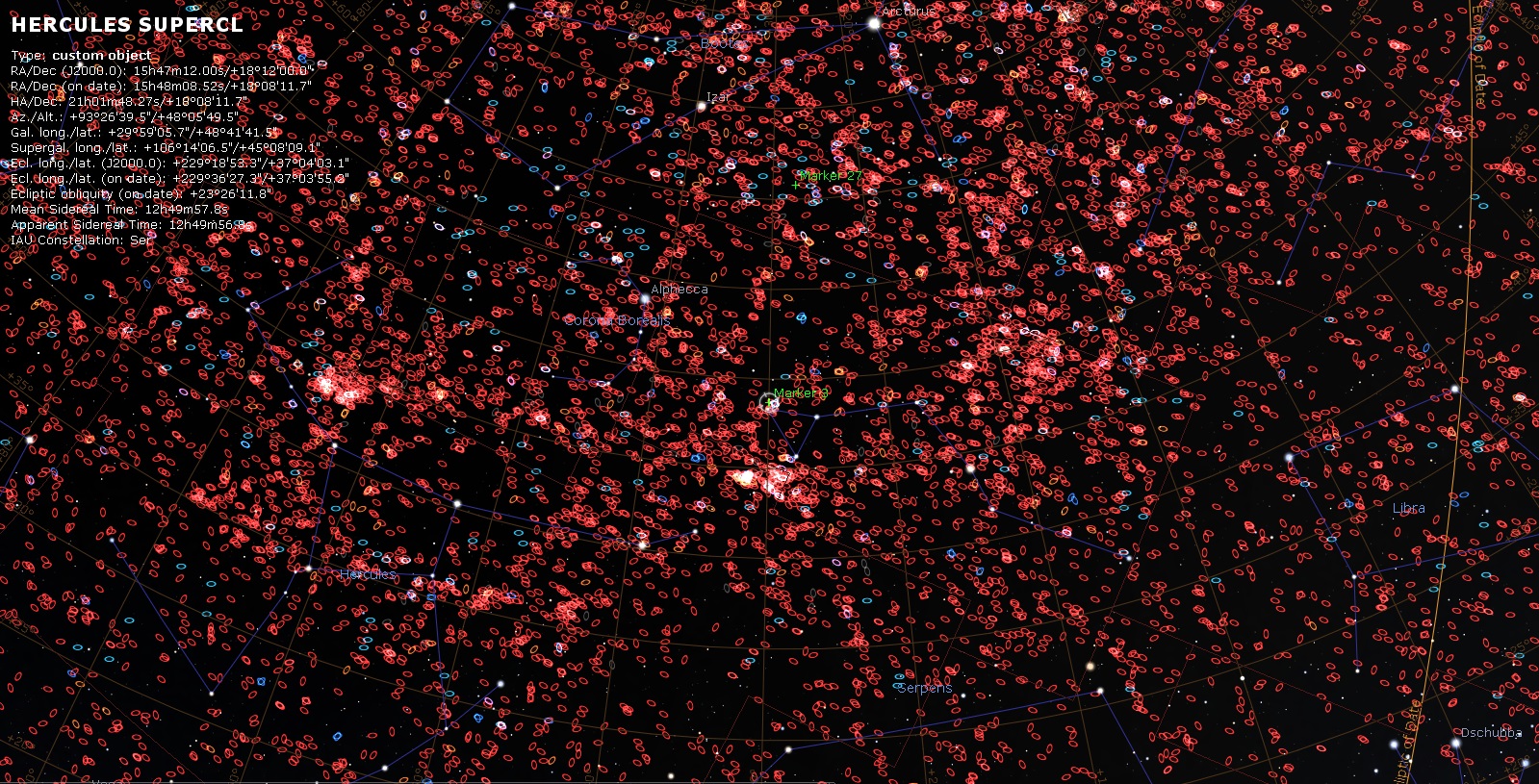
MARKER 3: SCL-160 HERCULES SUPERCLUSTER
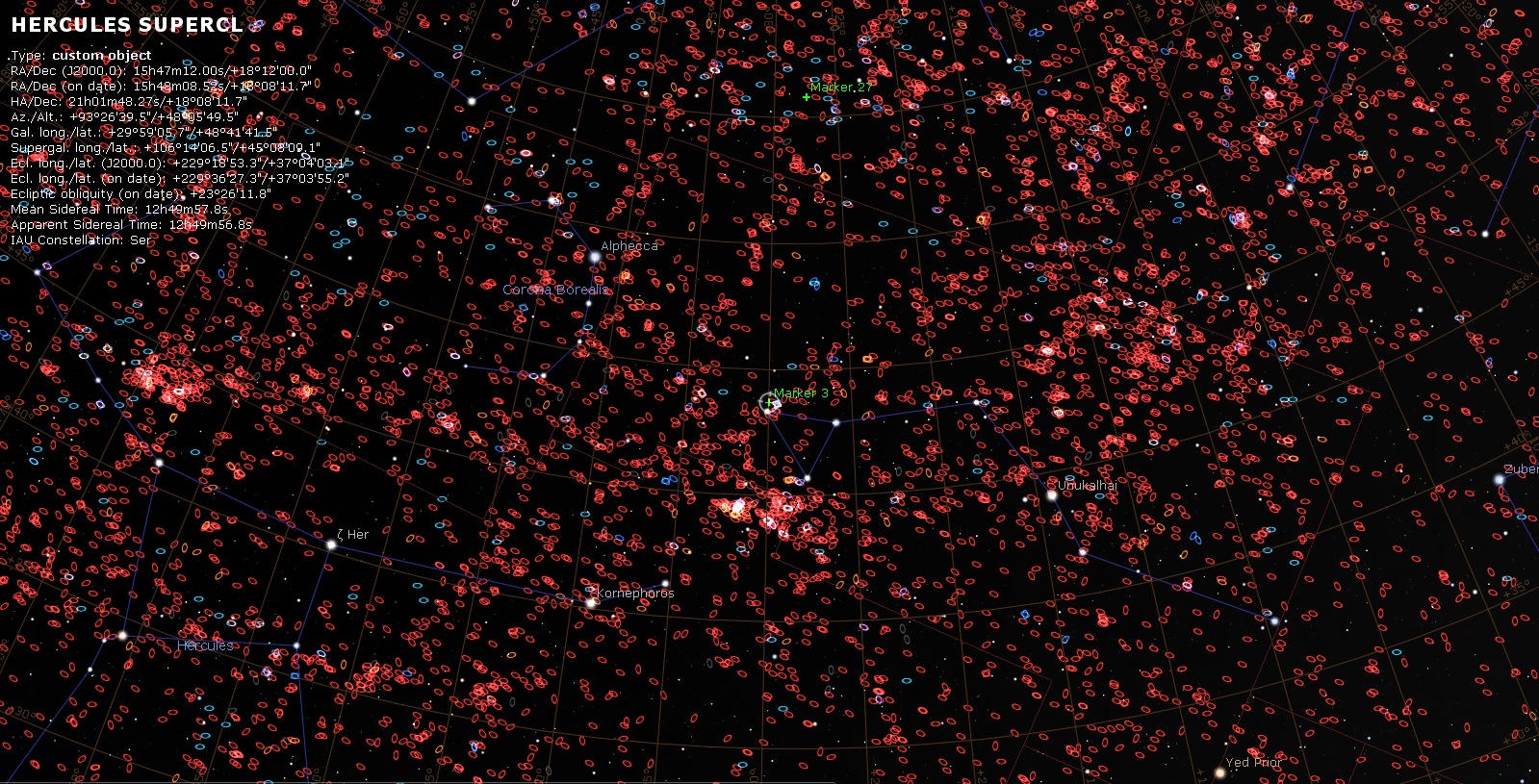
MARKER 3: SCL-160 HERCULES SUPERCLUSTER
Hercules-Corona
Borealis Great Wall
Hercules-Corona Borealis Great Wall or the Great GRB Wall is the largest known structure in the observable universe,
measuring approximately 10 billion light years in length (for perspective, the observable universe is about 93 billion
light years in diameter). This massive superstructure is a region of the sky seen in the data set mapping of gamma-ray bursts
(GRBs) that has been found to have an unusually higher concentration of similarly distanced GRBs than the expected average distribution.
Constellation(s): Hercules, Corona Borealis, Lyra, Boötes and Draco
Right Ascension: 17h 0m
Declination: +27° 45?
Redshift: 1.6 to 2.1
Distance: 9.612 to 10.538 billion light-years (light travel)
Distance: 15.049 to 17.675 billion light-years (comoving distance)
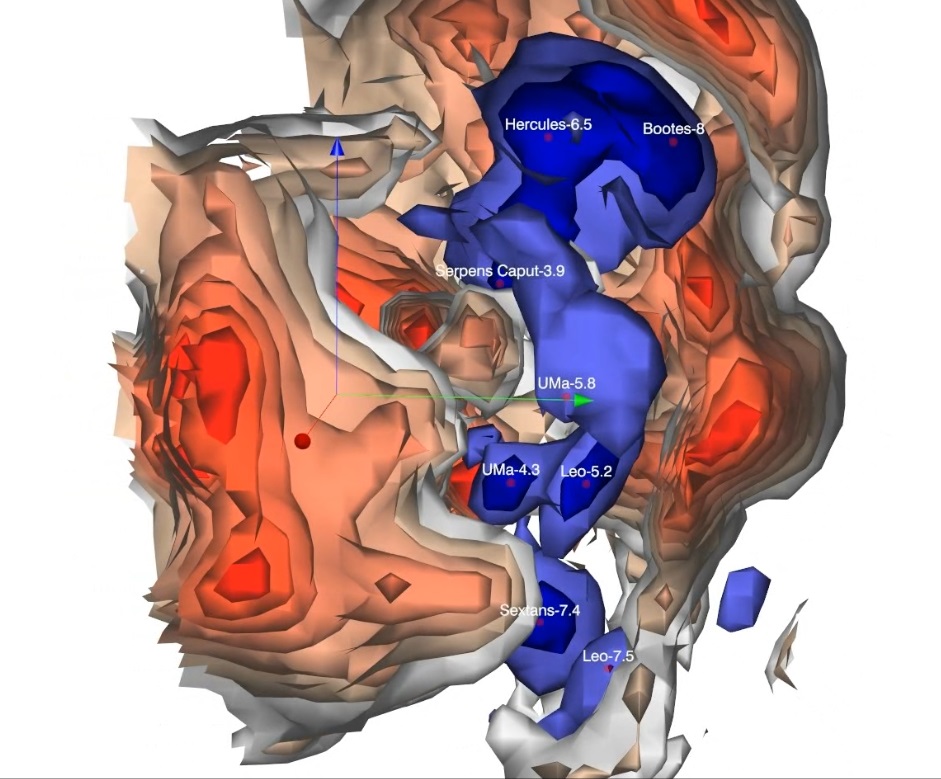
HERCULES VOID
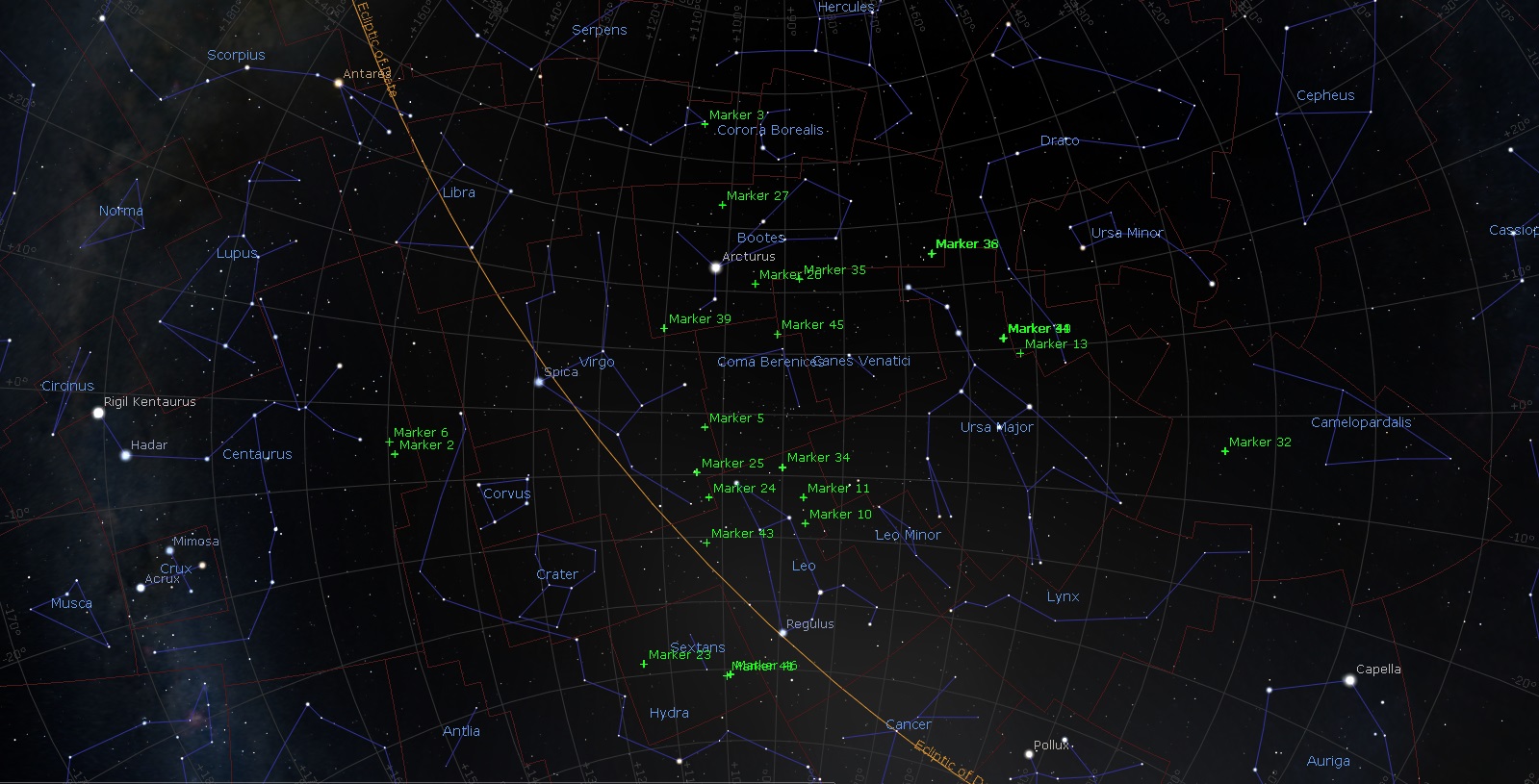
SUPERGALACTIC COORDINATES
HERCULES VOID ALIGNMENT
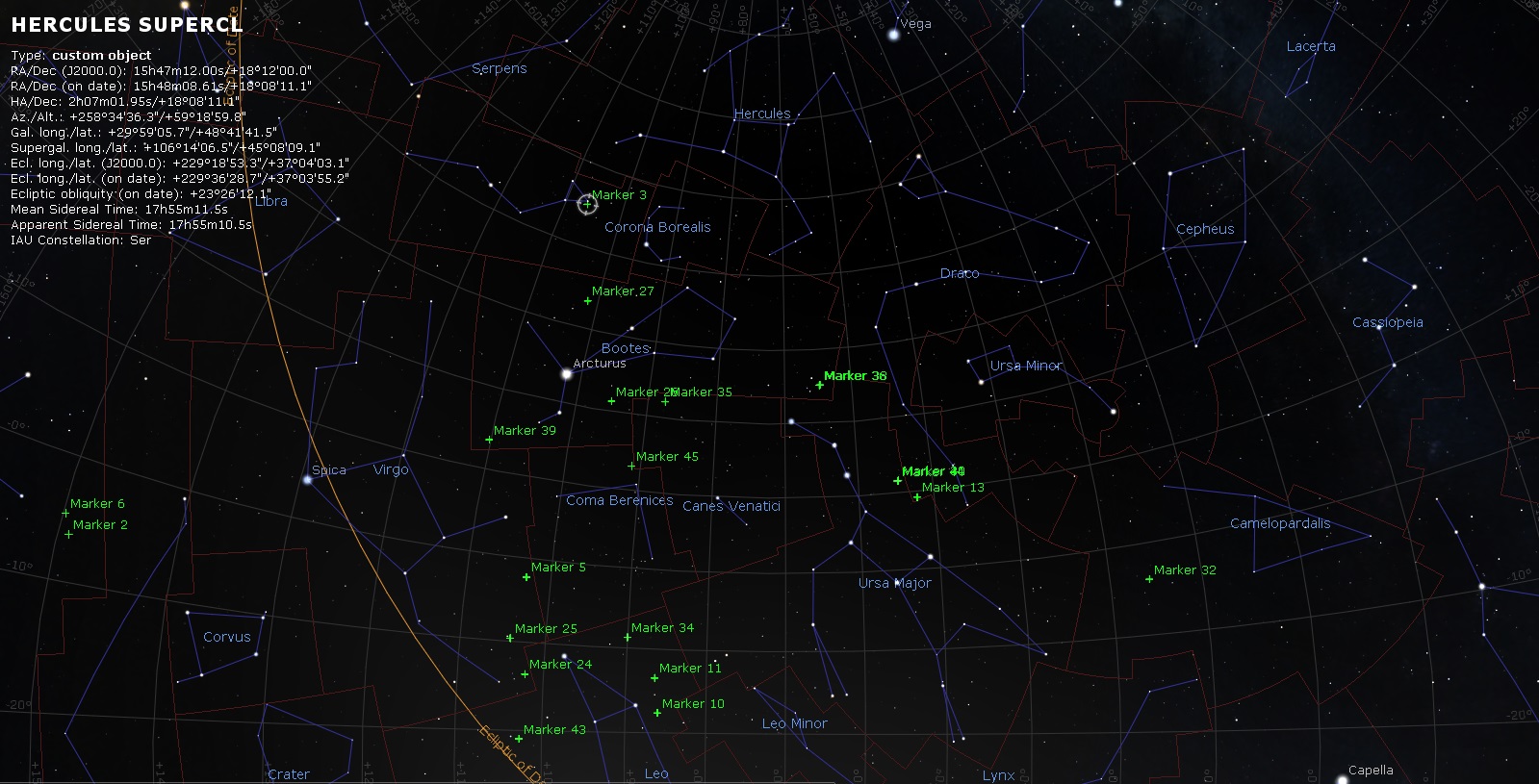
SUPERGALACTIC COORDINATES
HERCULES VOID ALIGNMENT
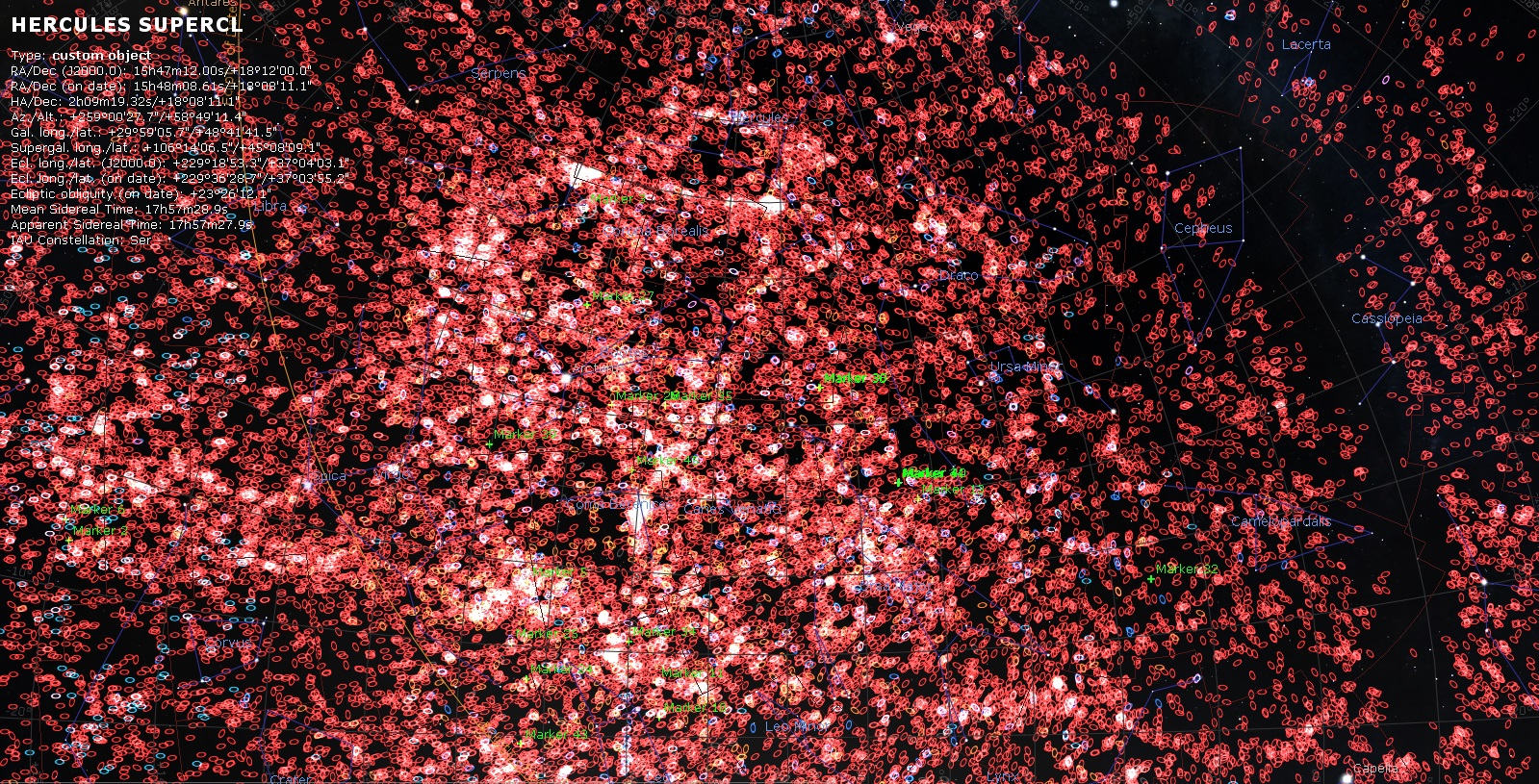
SUPERGALACTIC COORDINATES
MARKER 3: SCL-160 HERCULES SUPERCLUSTER
HERCULES VOID ALIGNMENT
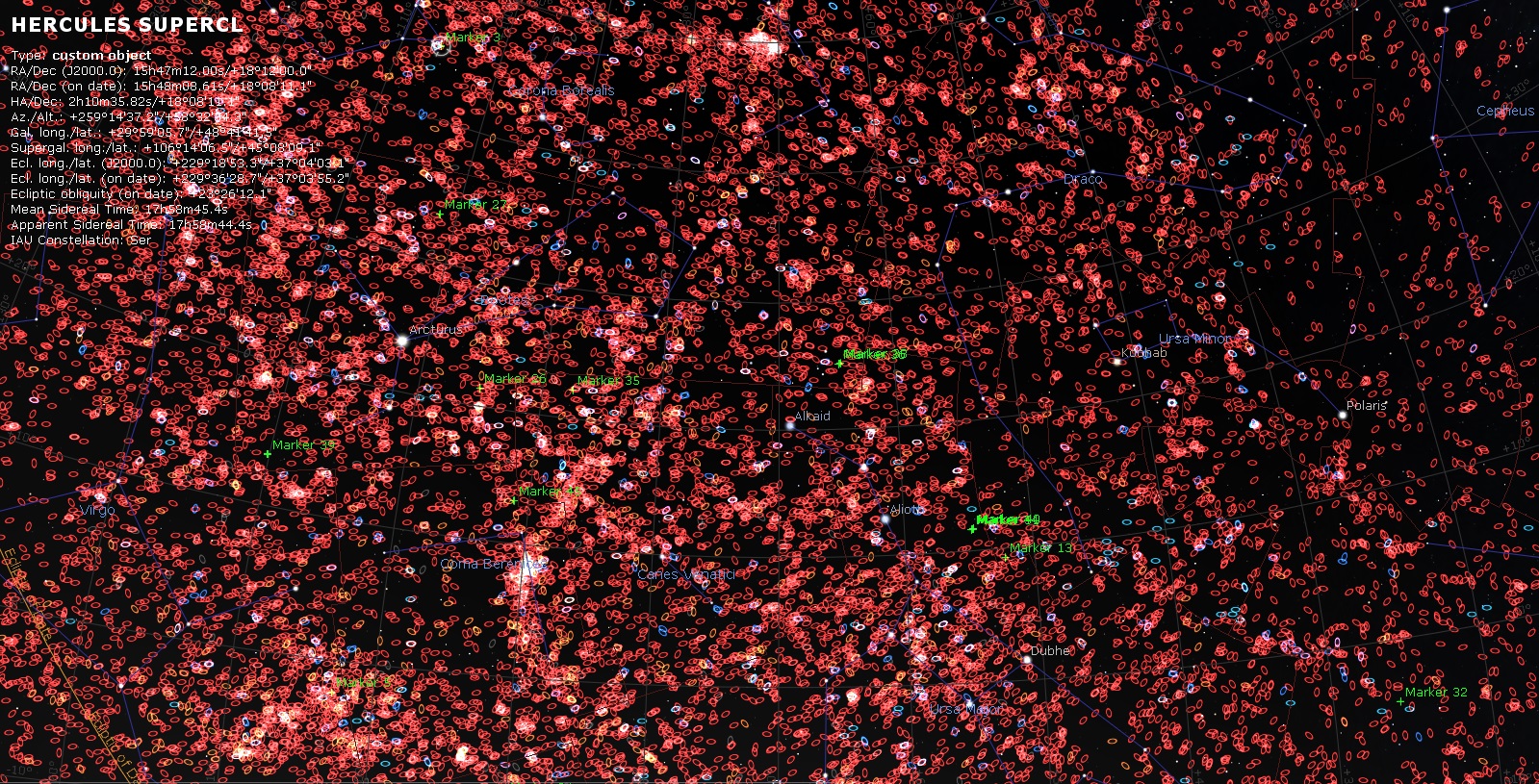
SUPERGALACTIC COORDINATES
MARKER 3: SCL-160 HERCULES SUPERCLUSTER
HERCULES VOID ALIGNMENT
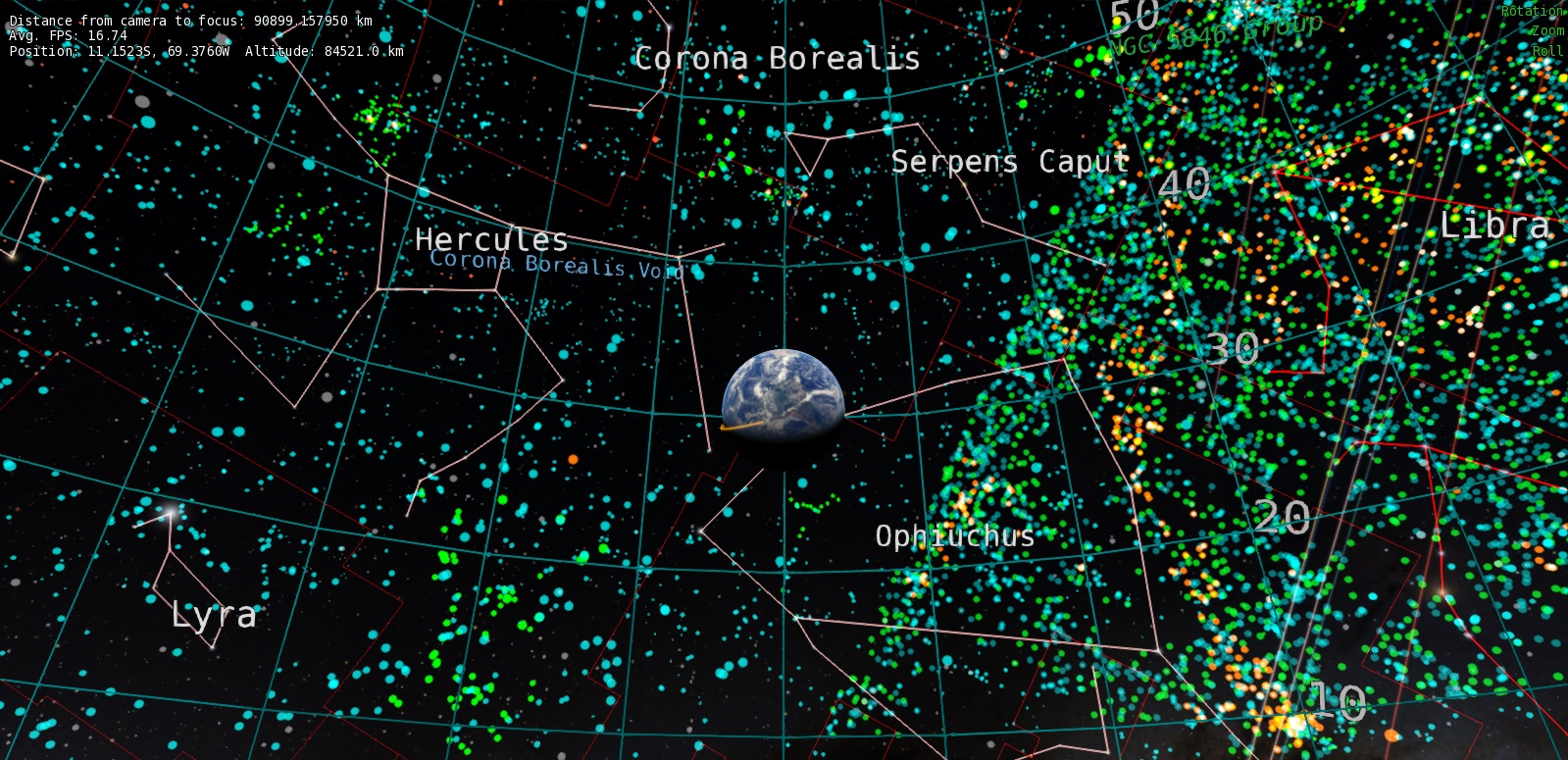
THE VIEW FROM OPEN SPACE
SCL-160 HERCULES SUPERCLUSTER
HERCULES VOID ALIGNMENT
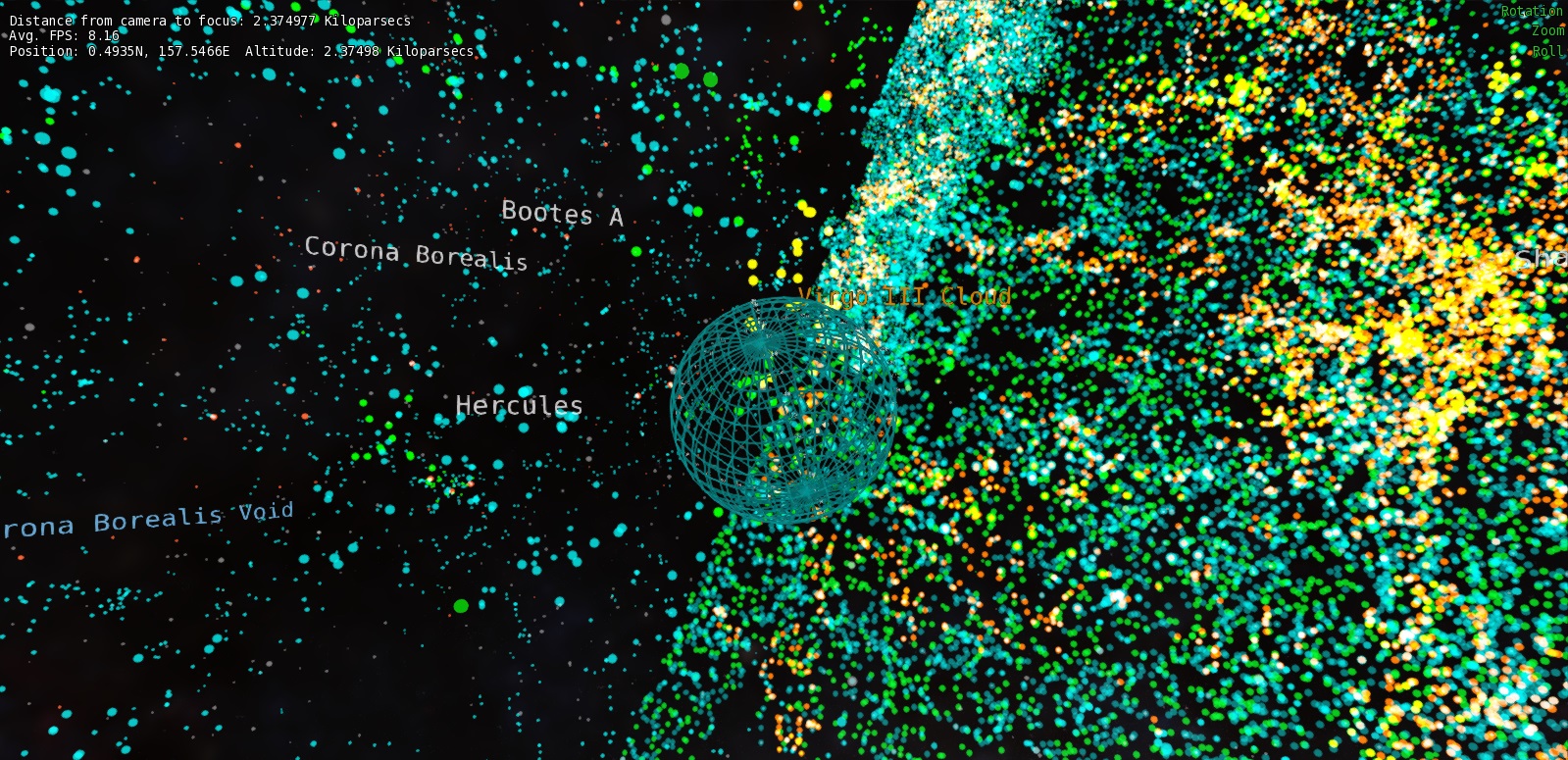
THE VIEW FROM OPEN SPACE
SCL-160 HERCULES SUPERCLUSTER
HERCULES VOID ALIGNMENT

MARKER 4: OPHIUCHUS SUPERCLUSTER
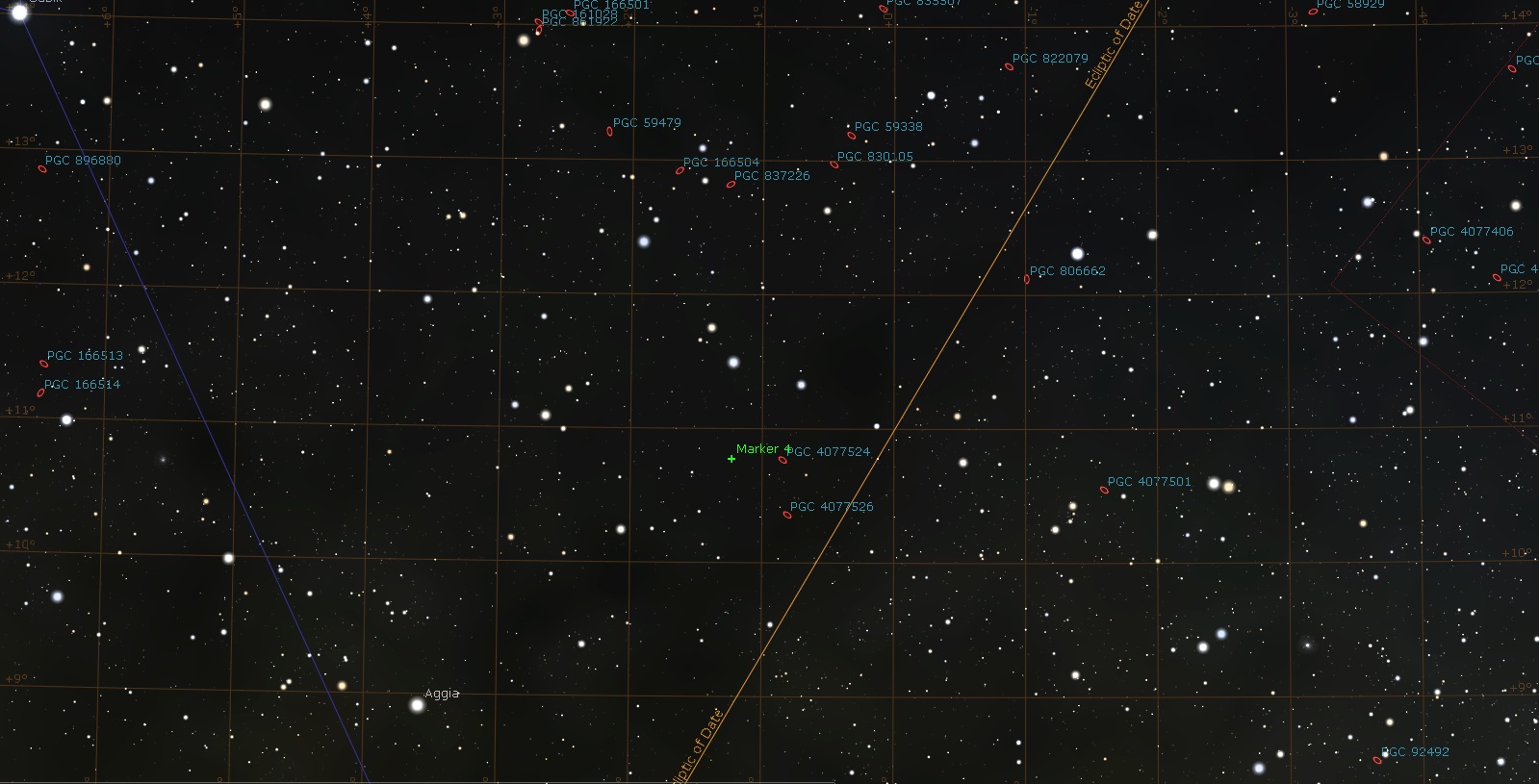
MARKER 4: OPHIUCHUS SUPERCLUSTER
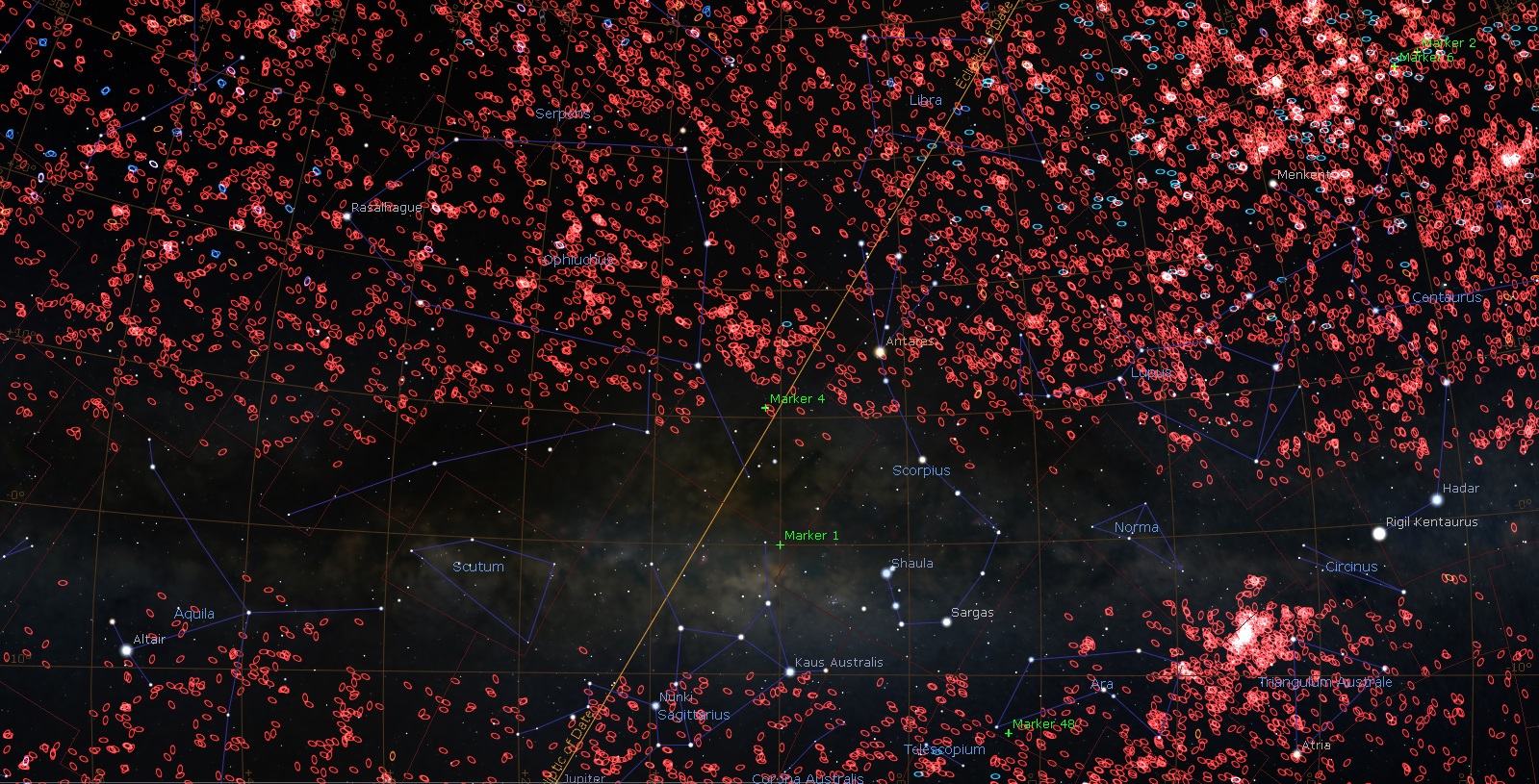
MARKER 4: OPHIUCHUS SUPERCLUSTER
Ophiuchus Supercluster
Ophiuchus Supercluster is a nearby galaxy supercluster in the constellation Ophiuchus.
The supercluster forms the far wall of the Ophiuchus Void; it may also be connected in a filament,
with the Pavo-Indus-Telescopium Supercluster and the Hercules Supercluster.
Constellation: Ophiuchus
Right Ascension: 17h 10m 00s
Declination: -22° 00' 00?
Redshift: z = 0,028
Distance: 370 Mly (co-moving)
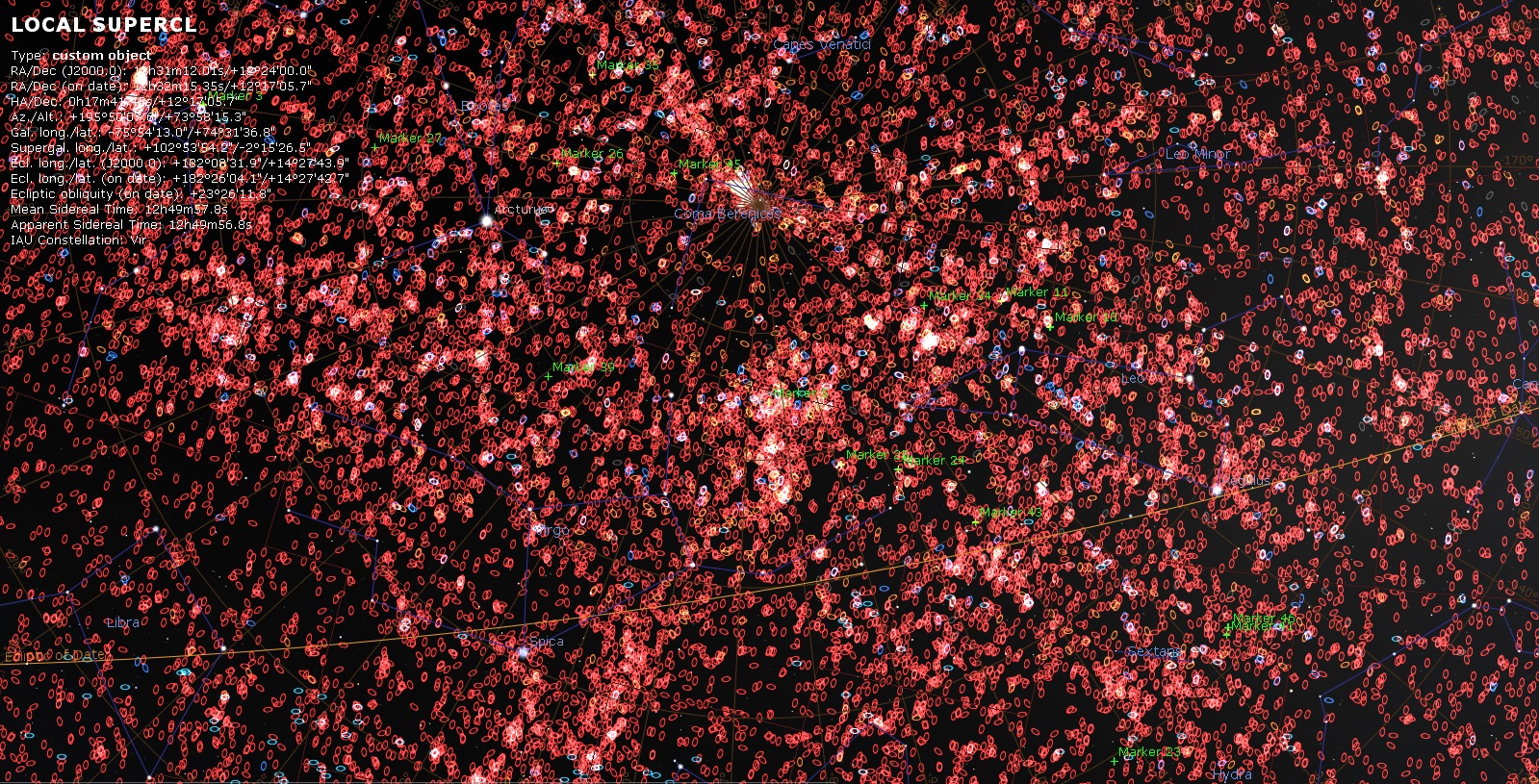
MARKER 5: LOCAL SUPERCLUSTER
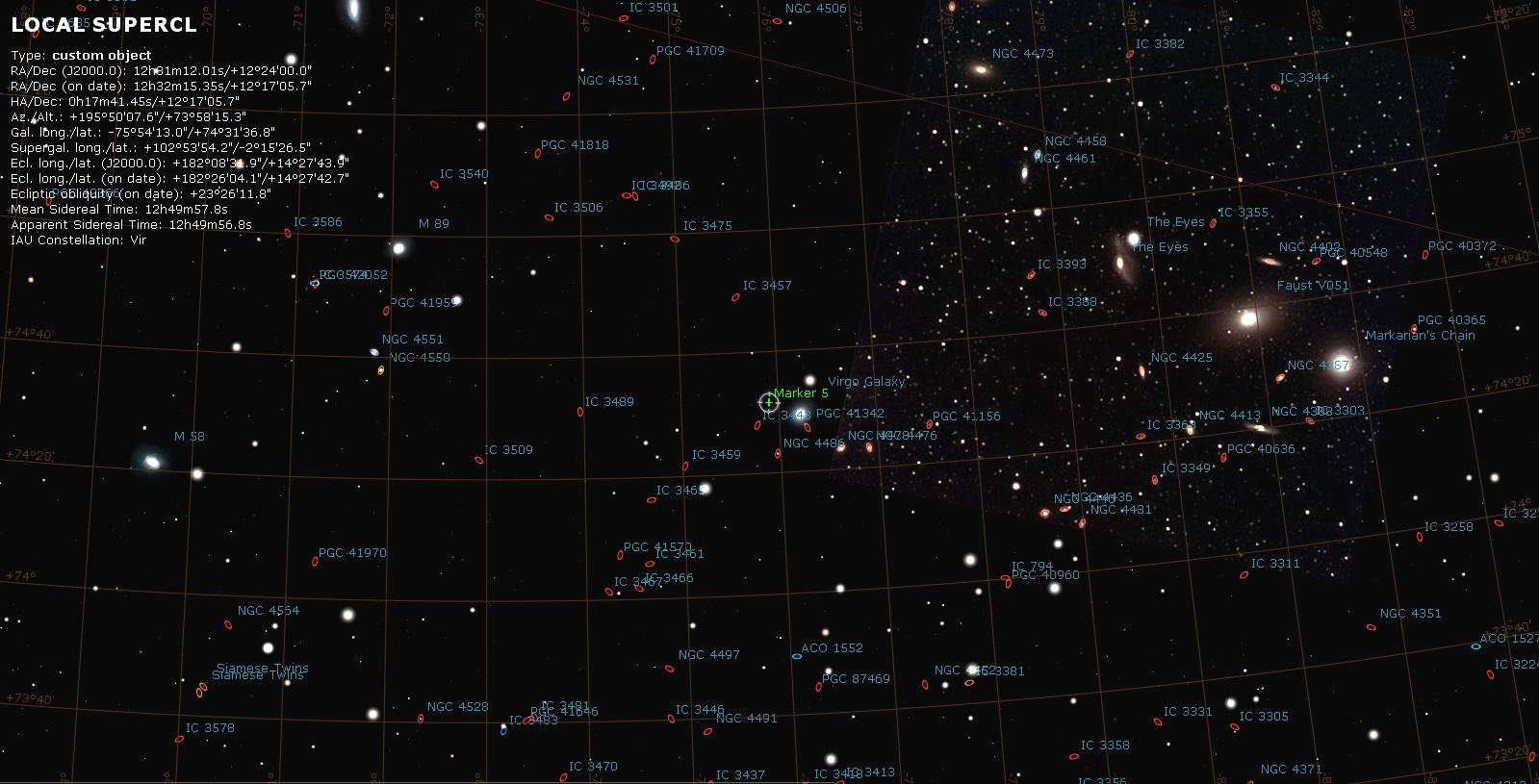
MARKER 5: LOCAL SUPERCLUSTER
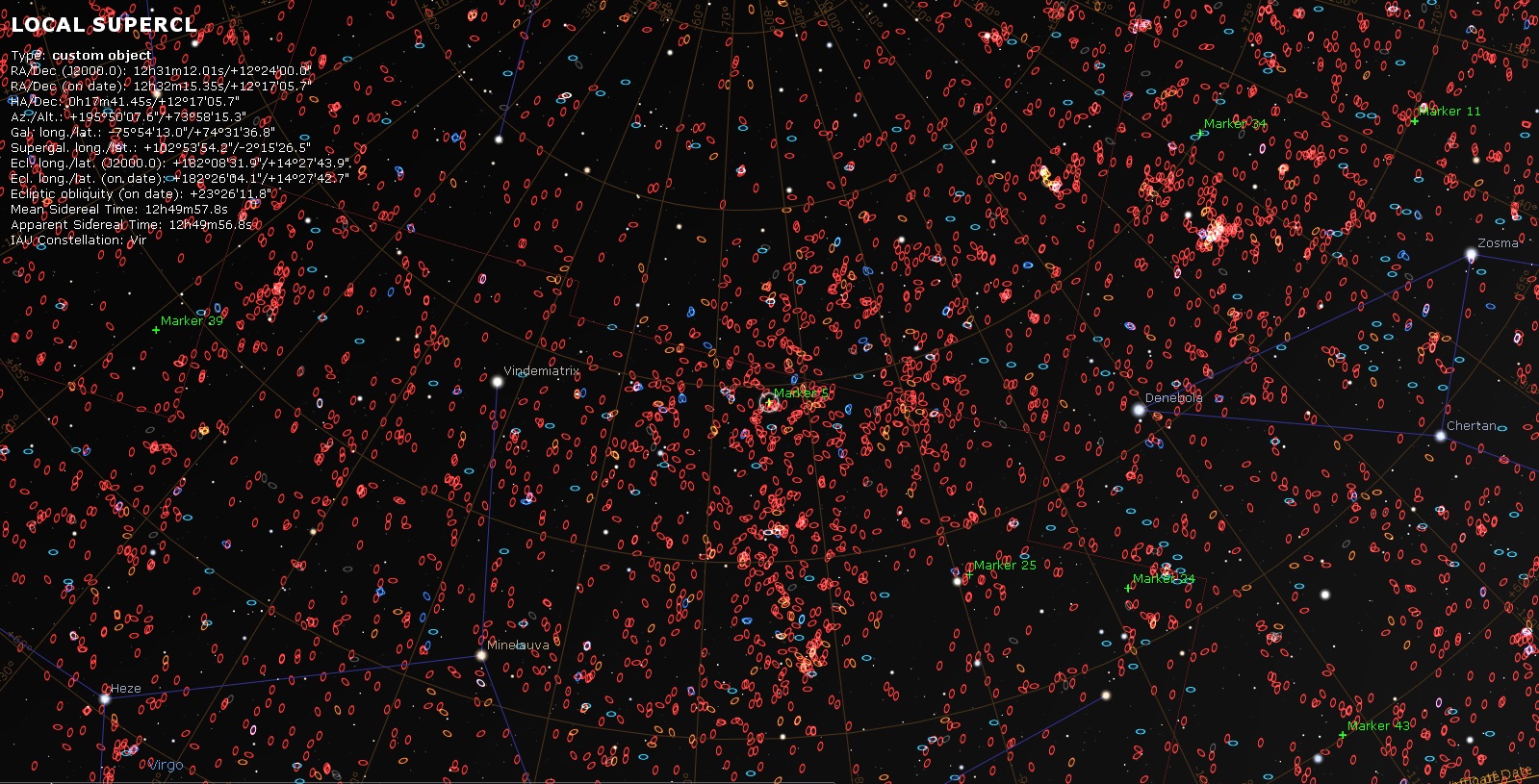
MARKER 5: LOCAL SUPERCLUSTER
The Local Group
The galaxy group that includes the Milky Way. It has a total diameter of roughly 3 megaparsecs (9.8 Mly),
and a total mass of the order of 2×1012 solar masses (4.0×1042 kg).
It consists of two clusters of galaxies in a "dumbbell" shape: the Milky Way and
its satellites form one lobe, and the Andromeda Galaxy and its satellites
constitute the other. The two clusters are separated by about 0.8 Mpc (2.5×1022 m) and move
towards one another with a velocity of 123 km/s.
The group itself is a part of the larger Virgo Supercluster,
which may be a part of the Laniakea Supercluster.
The total number of galaxies in the Local Group is unknown as some are occluded by the Milky Way; however,
at least 80 such objects are known (most of which are dwarf galaxies).
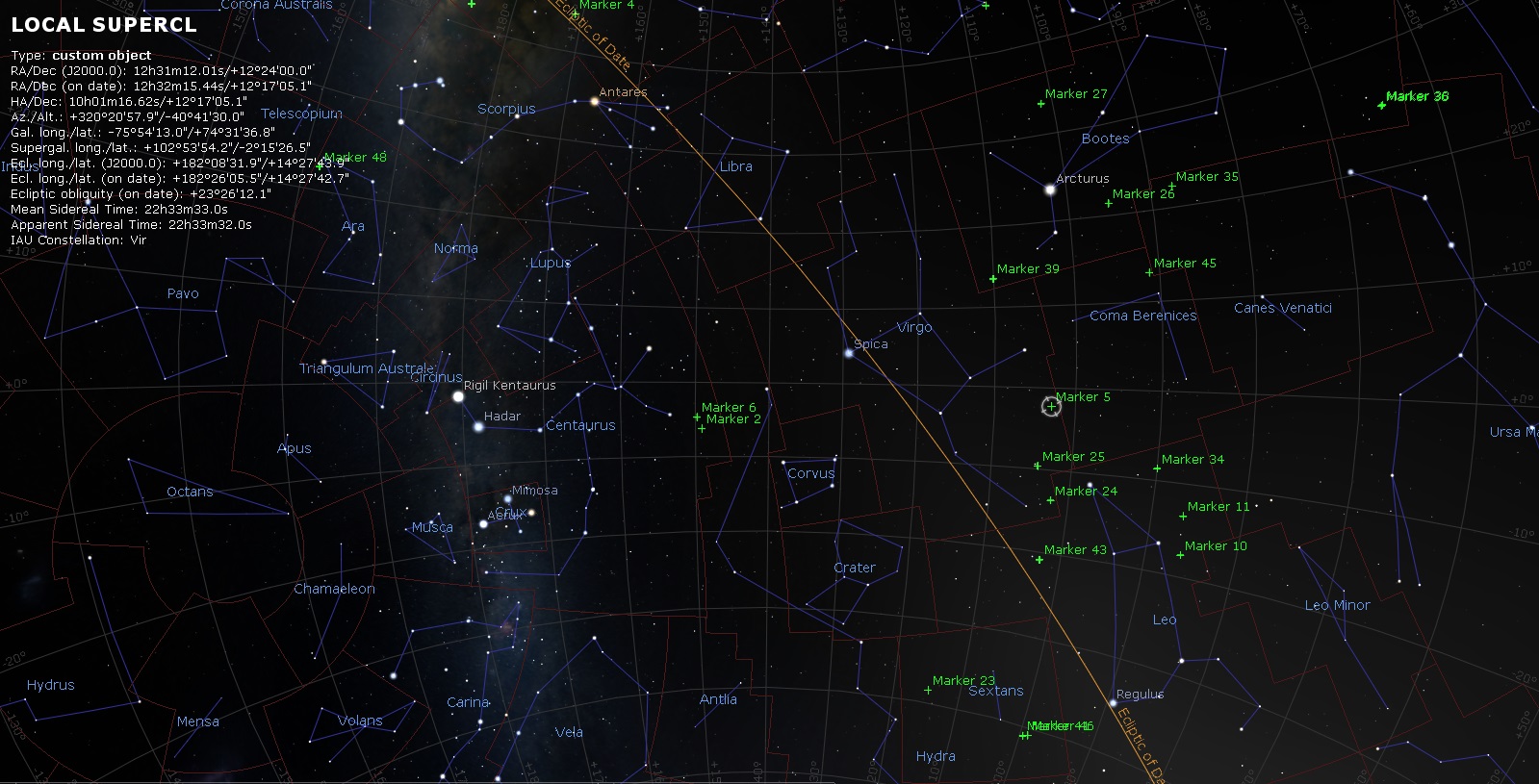
SUPERGALACTIC COORDINATES
LOCAL GROUP
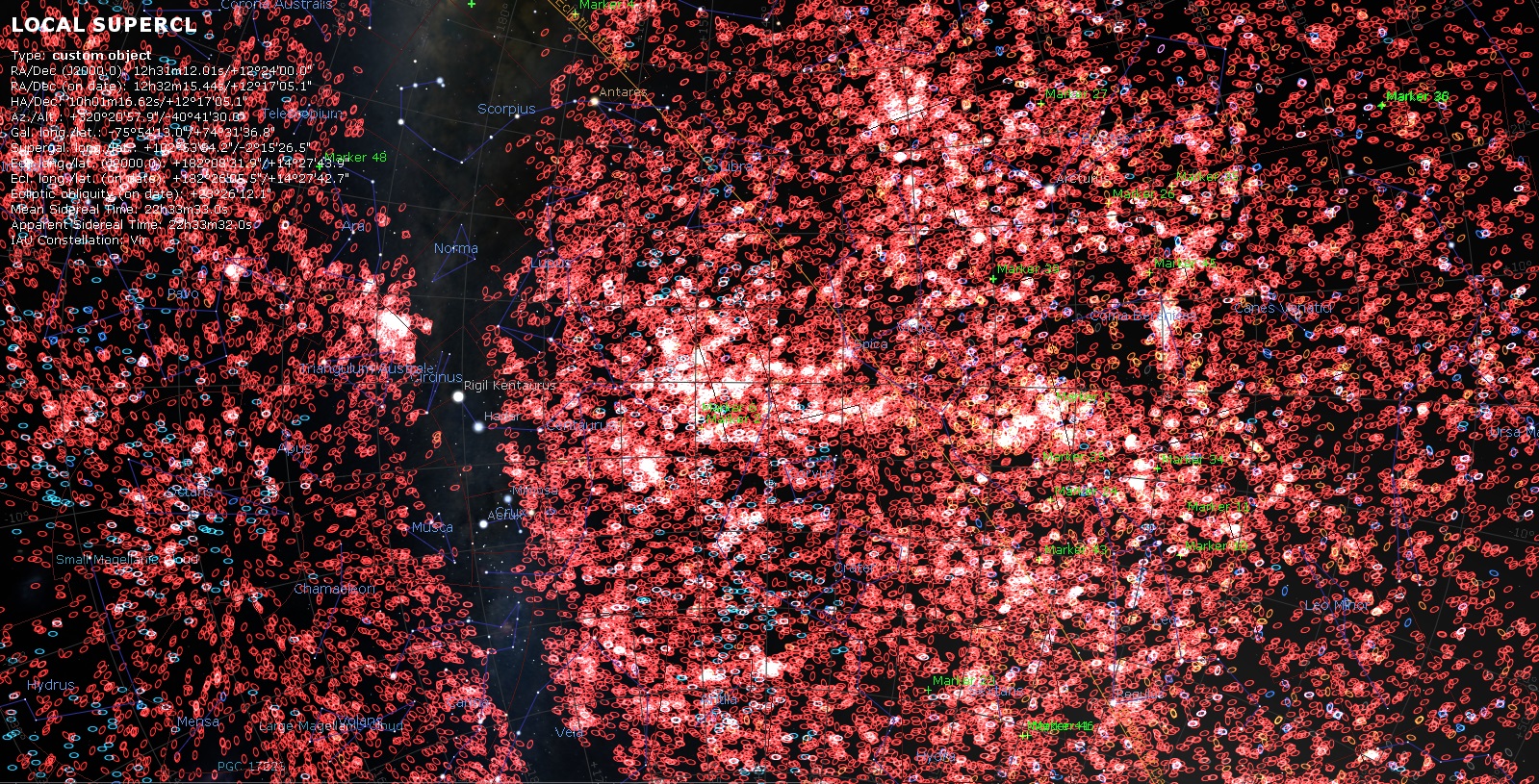
SUPERGALACTIC COORDINATES
LOCAL GROUP
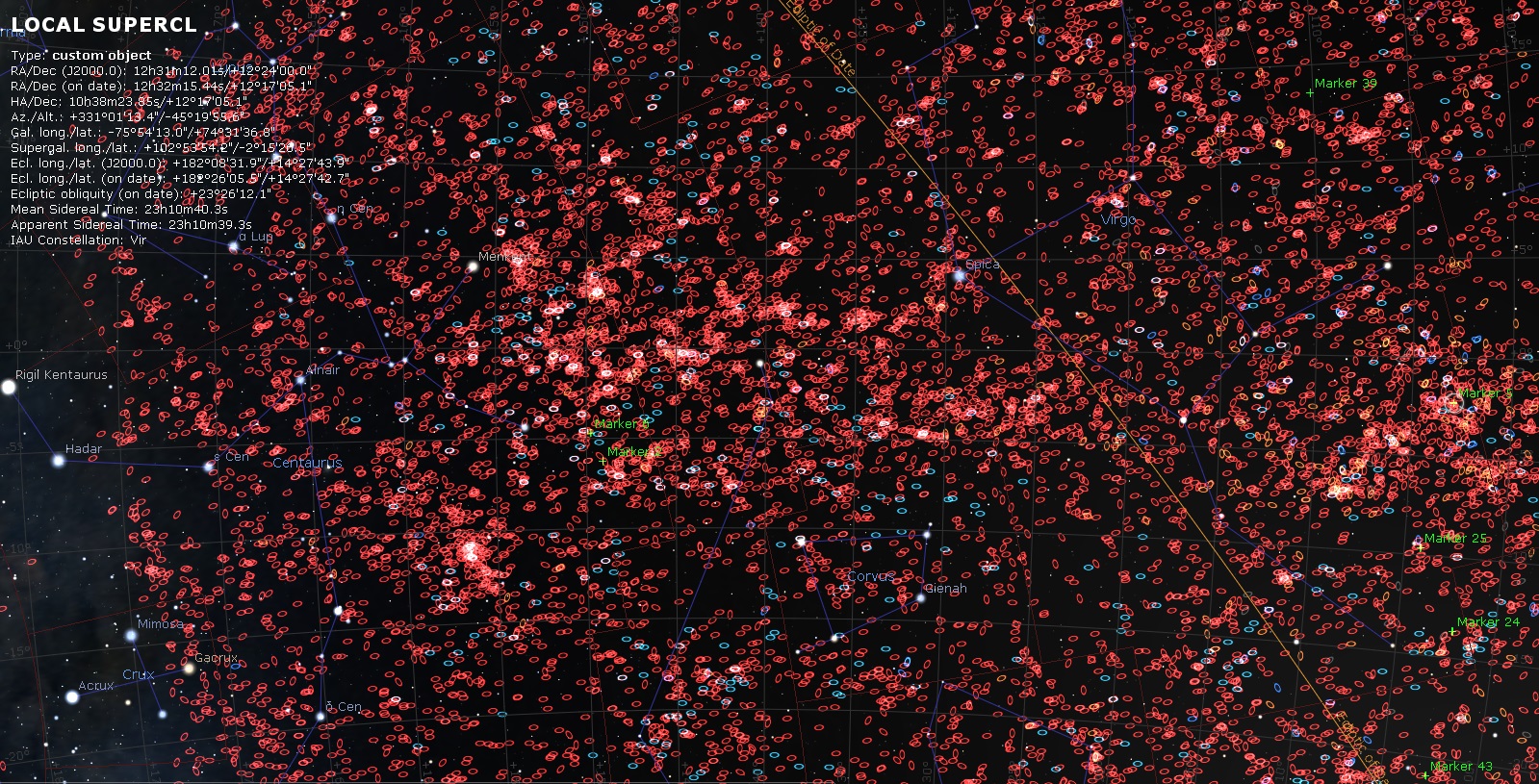
SUPERGALACTIC COORDINATES
LOCAL GROUP
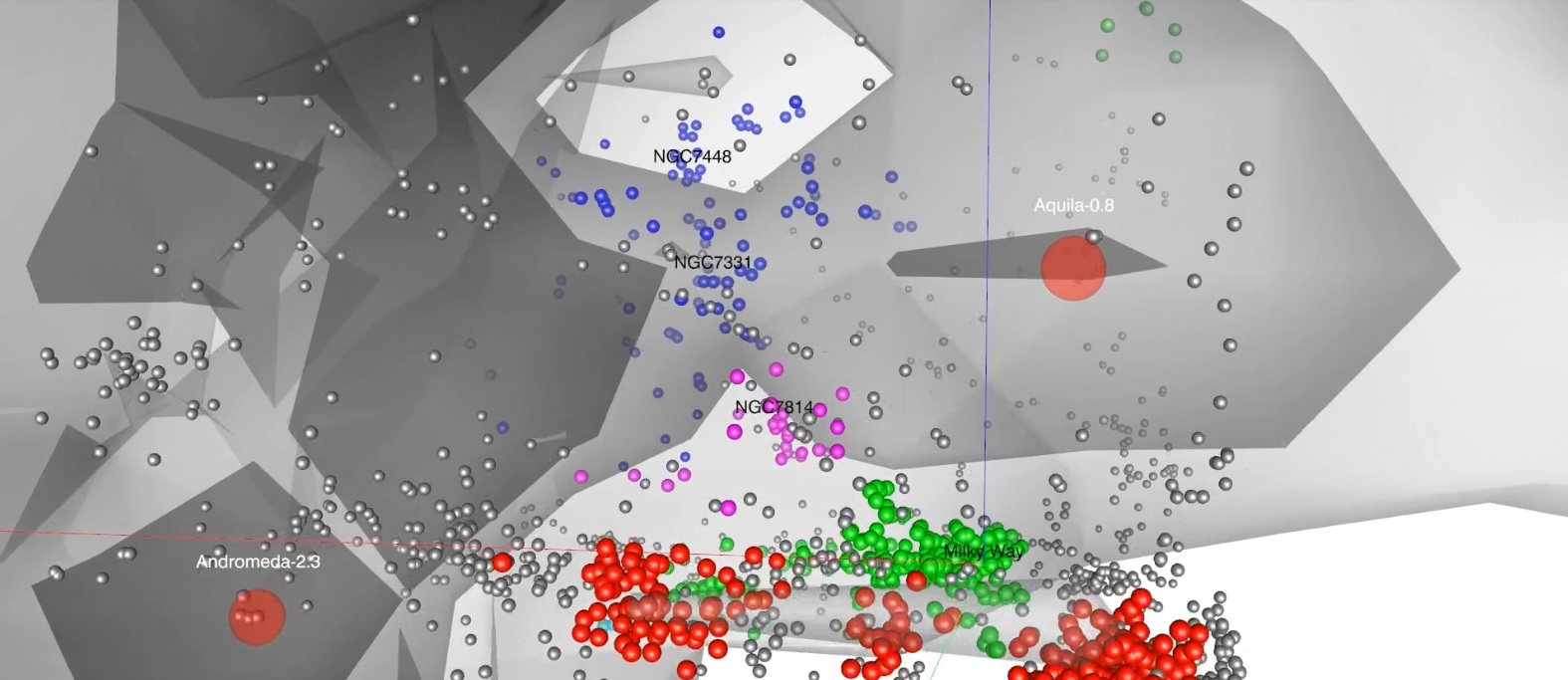
MILKY WAY - LOCAL VOID
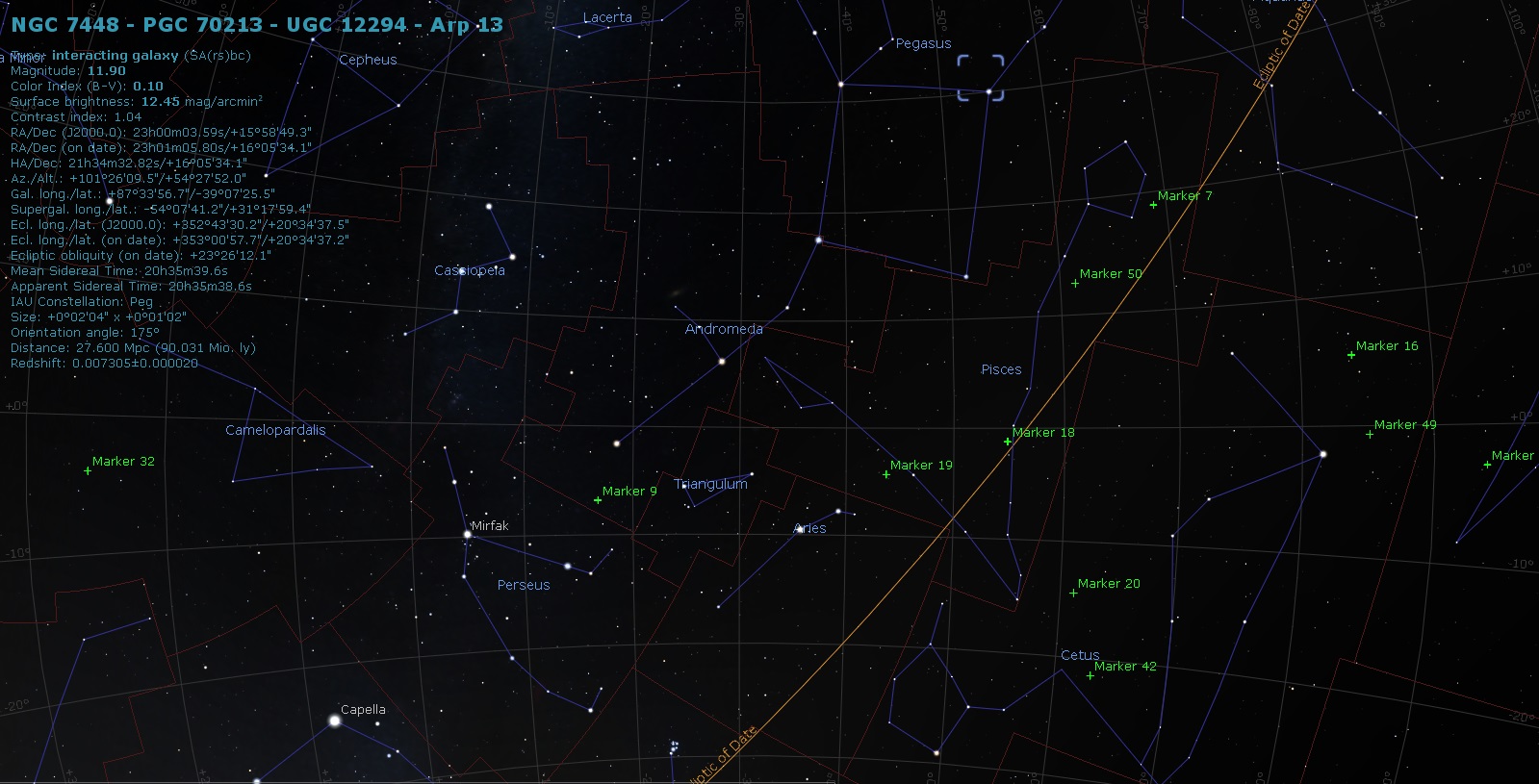
SUPERGALACTIC COORDINATES
NGC 7448
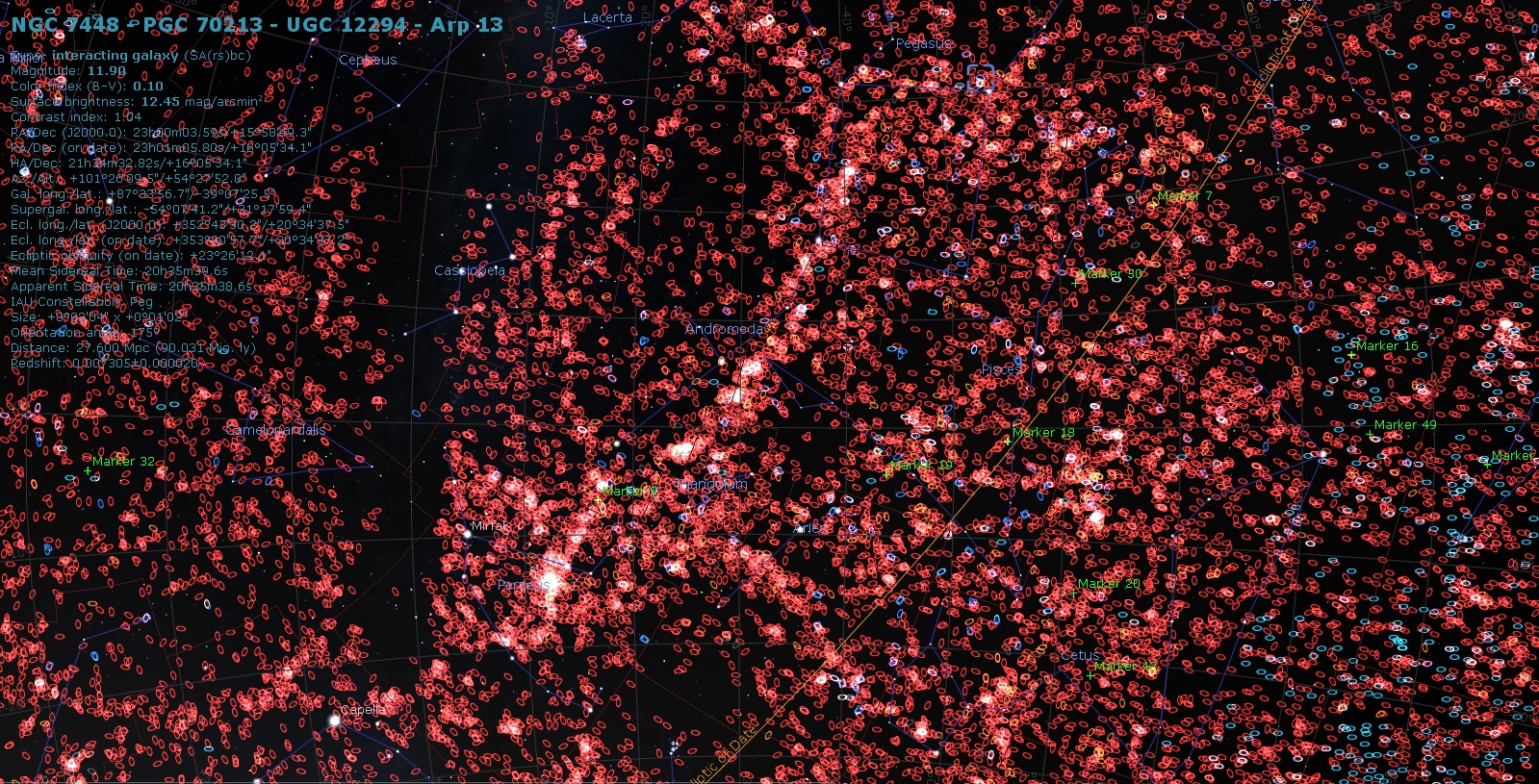
SUPERGALACTIC COORDINATES
NGC 7448
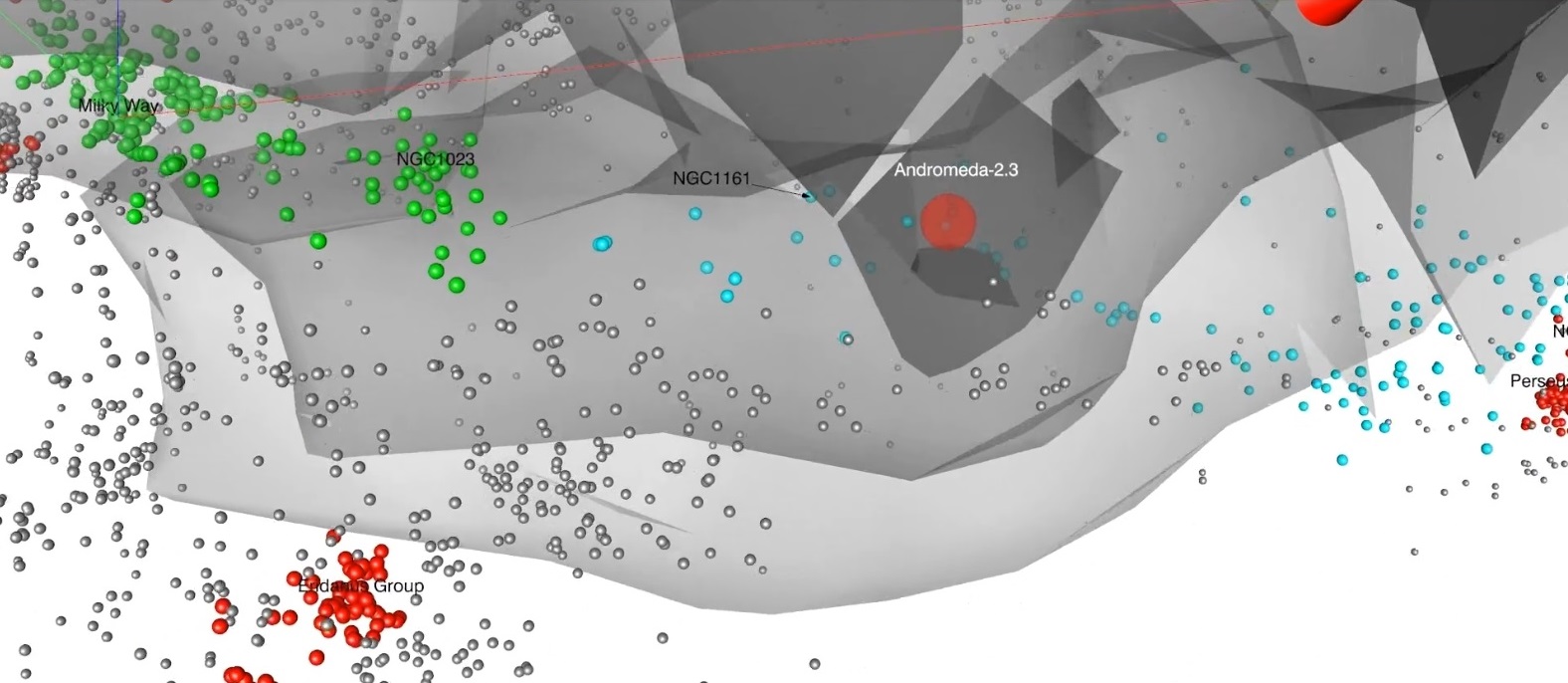
MILKY WAY - LOCAL VOID
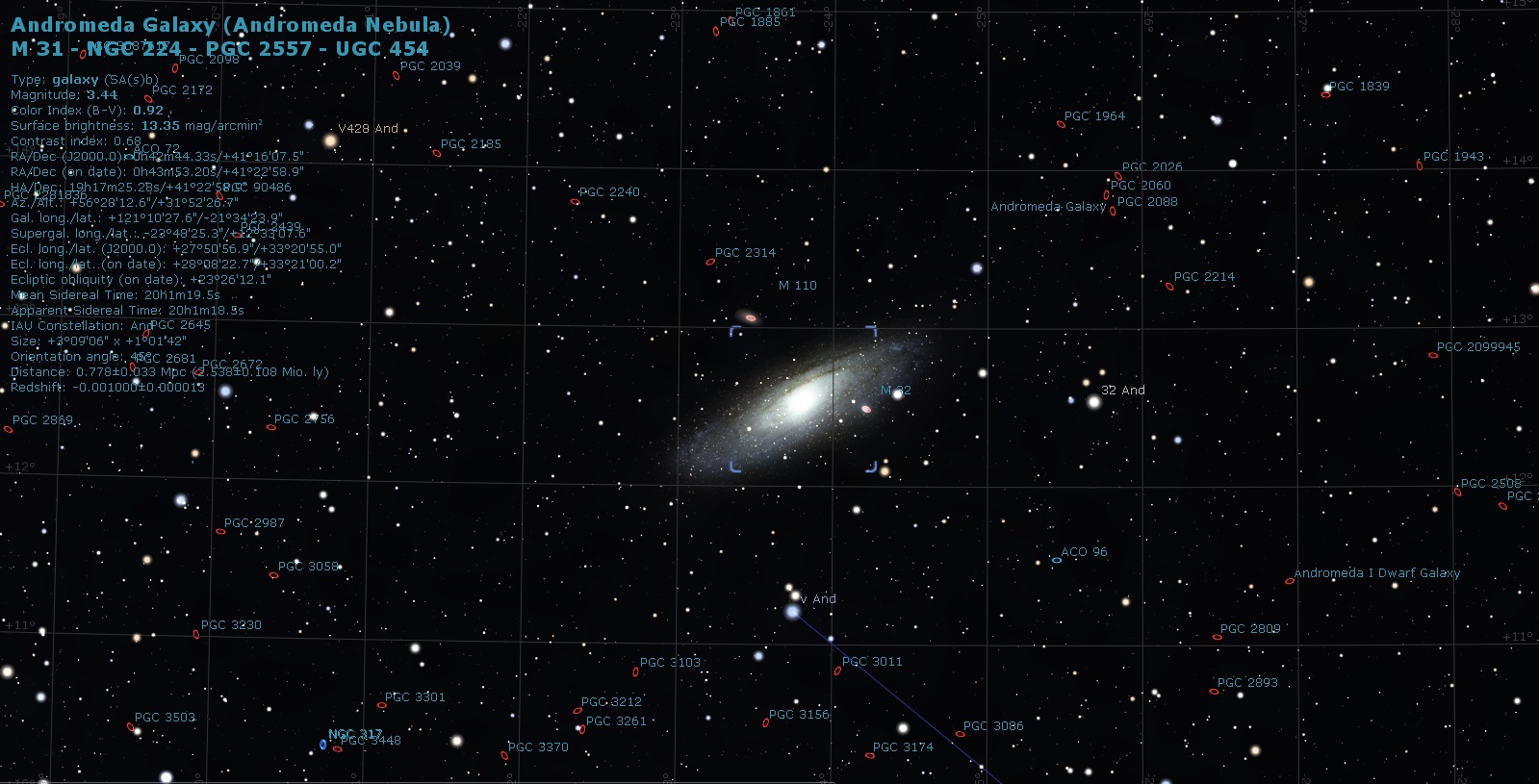
SUPERGALACTIC COORDINATES
NGC 224
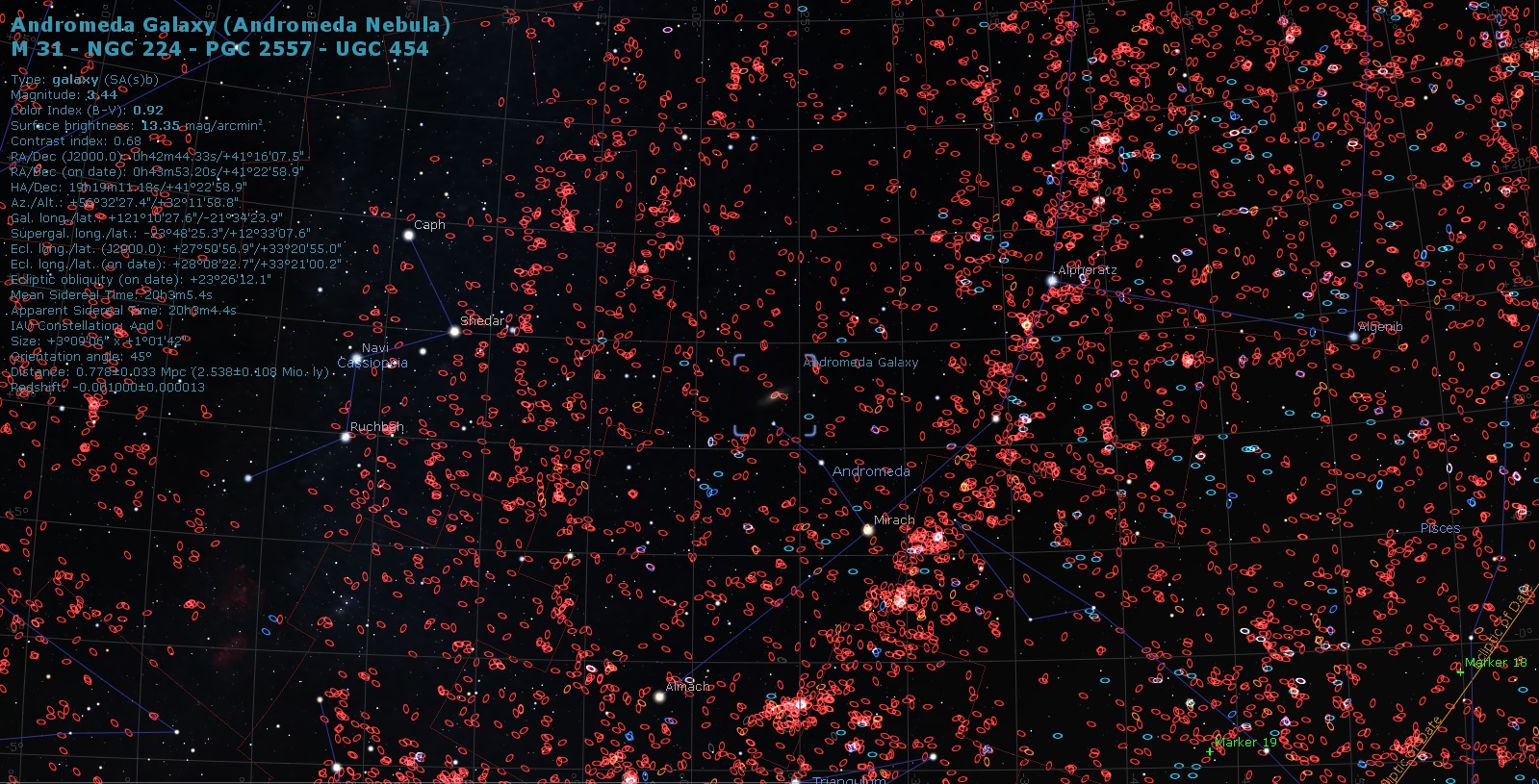
SUPERGALACTIC COORDINATES
NGC 224
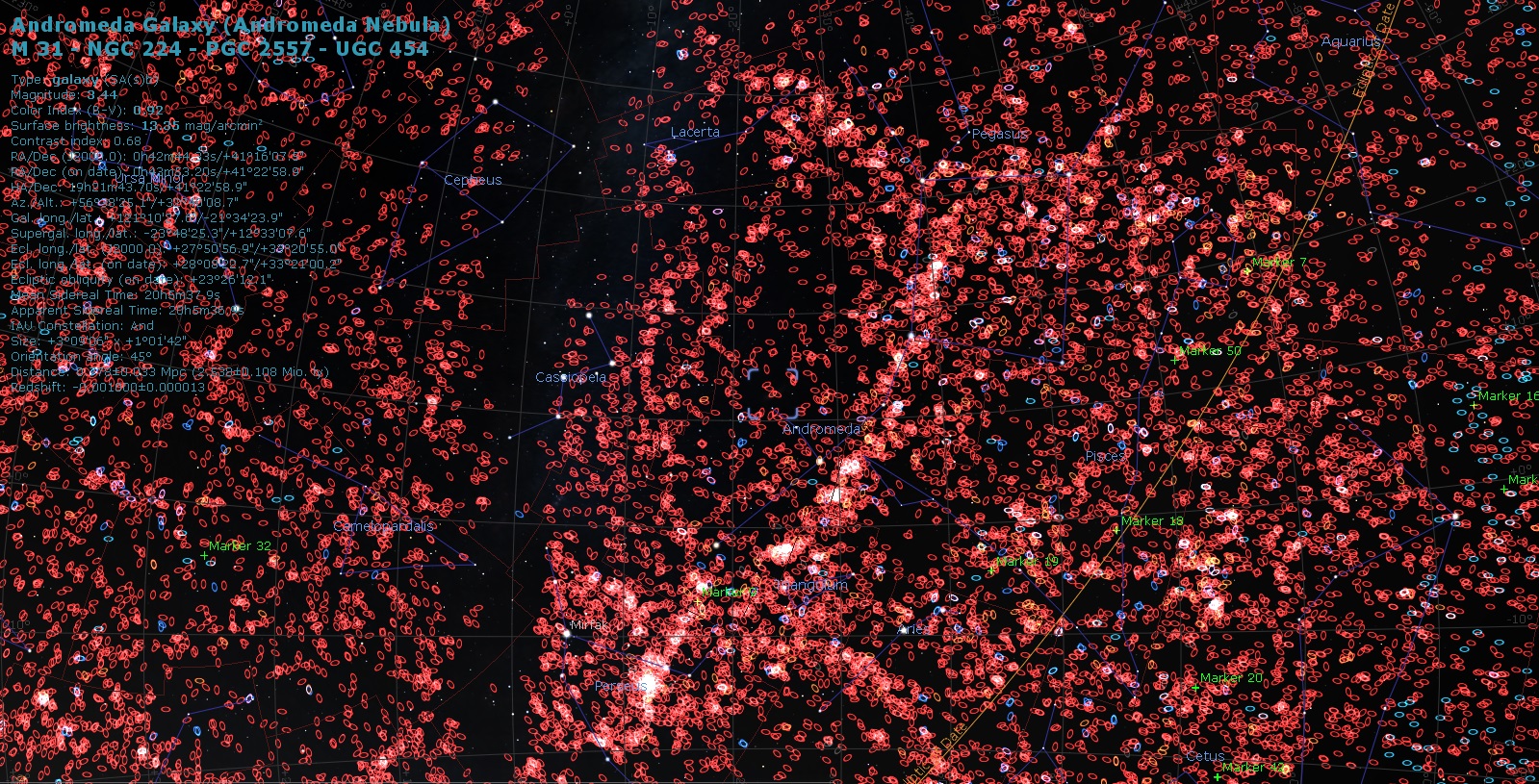
SUPERGALACTIC COORDINATES
NGC 224
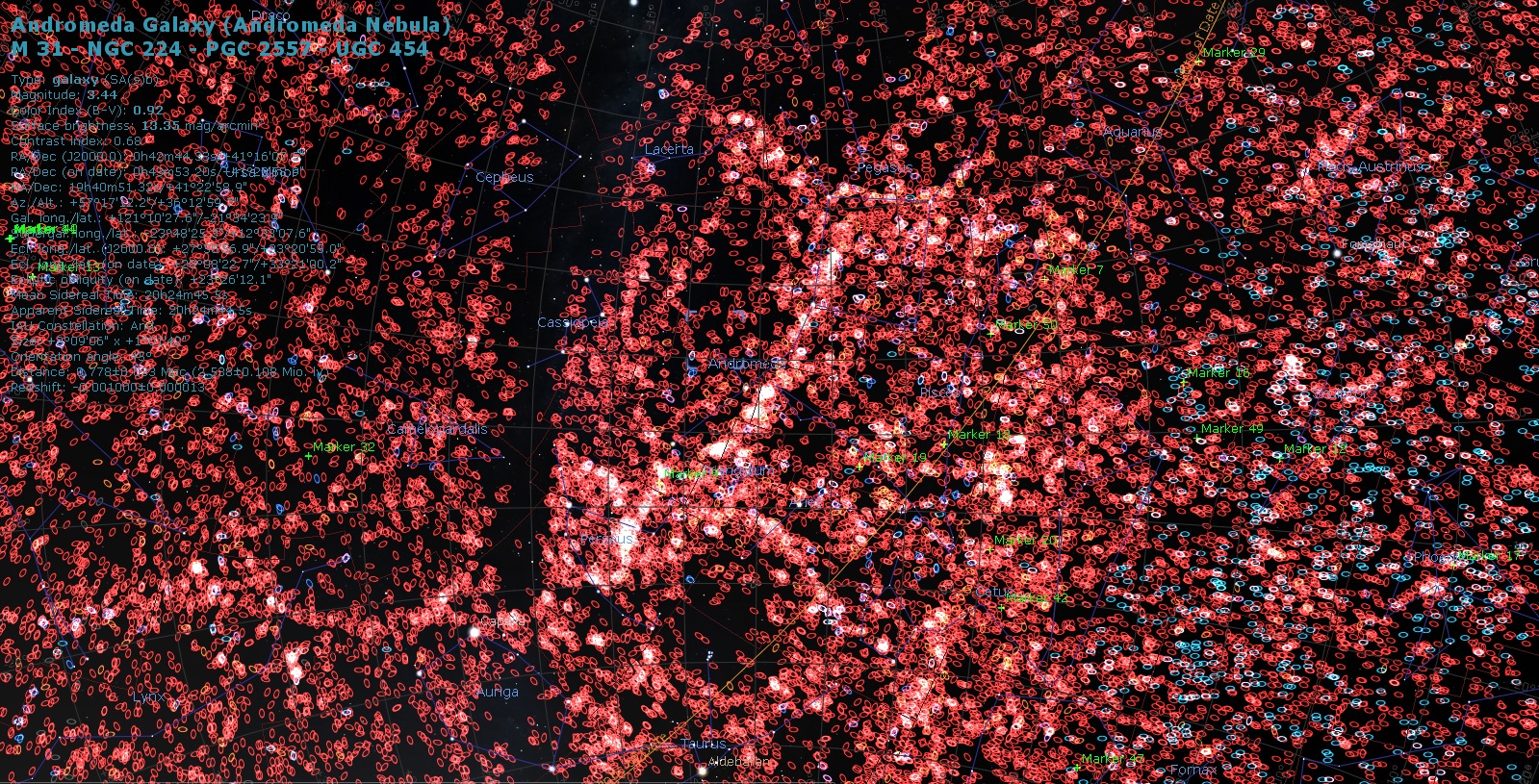
SUPERGALACTIC COORDINATES
NGC 224
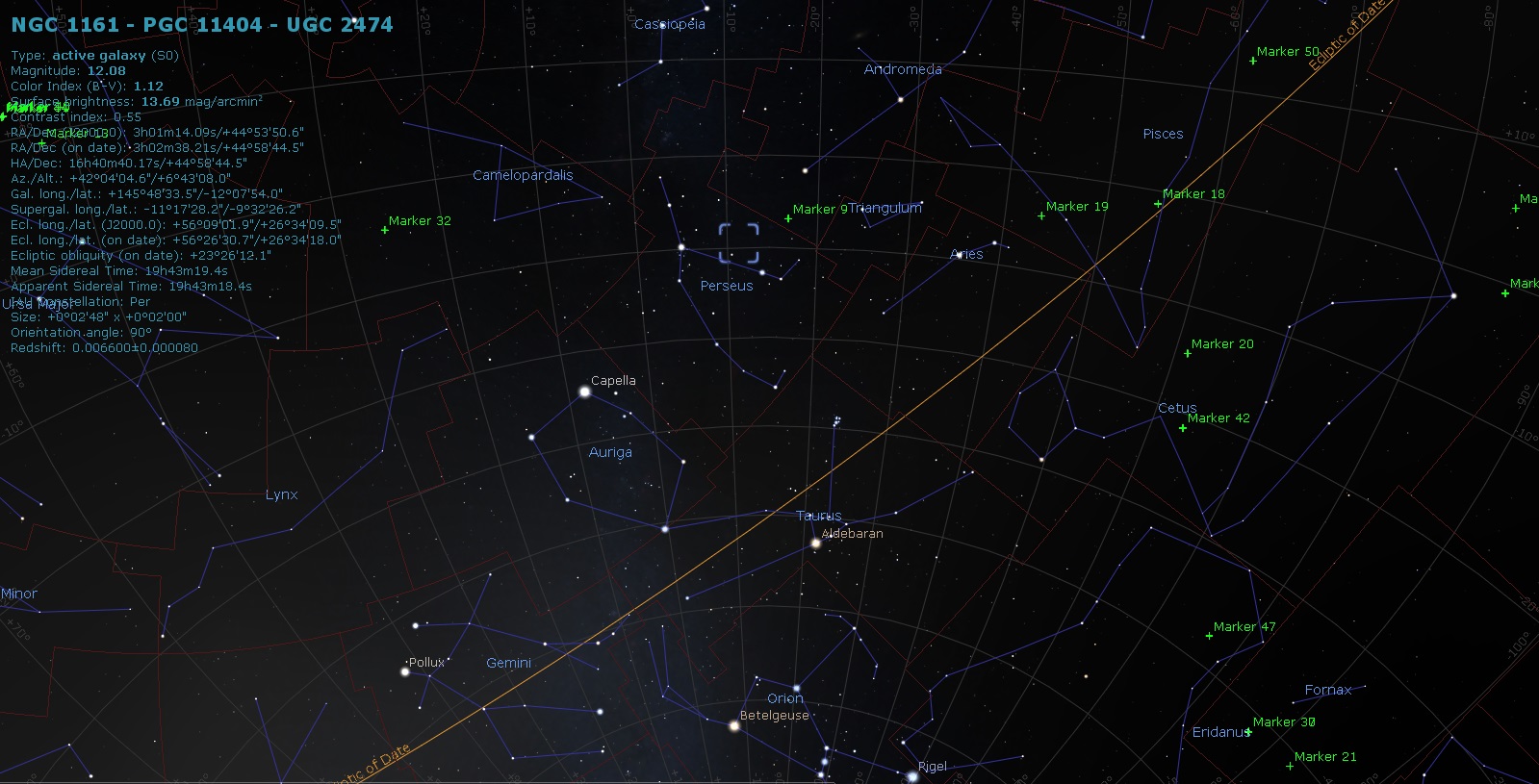
SUPERGALACTIC COORDINATES
NGC 1161
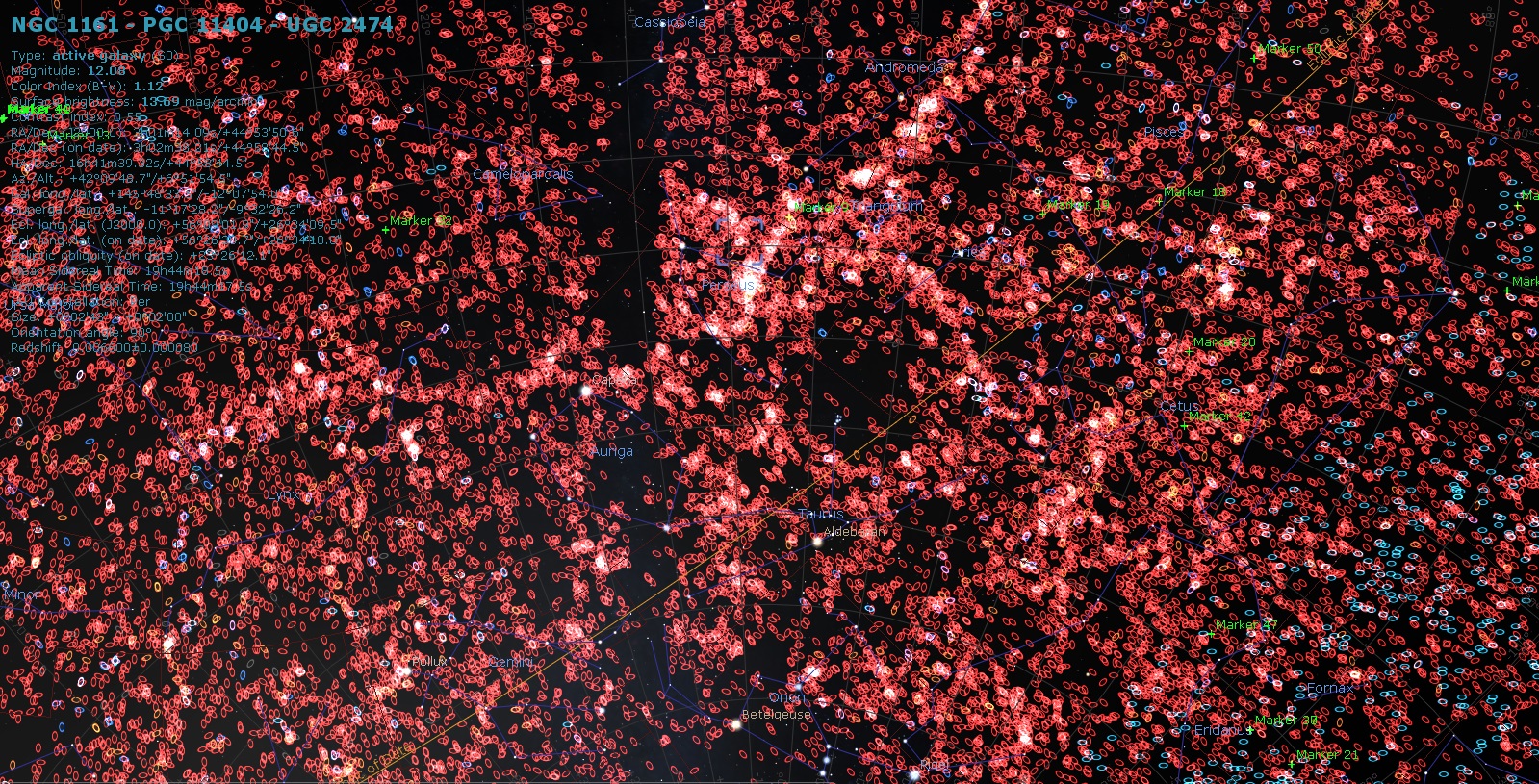
SUPERGALACTIC COORDINATES
NGC 1161
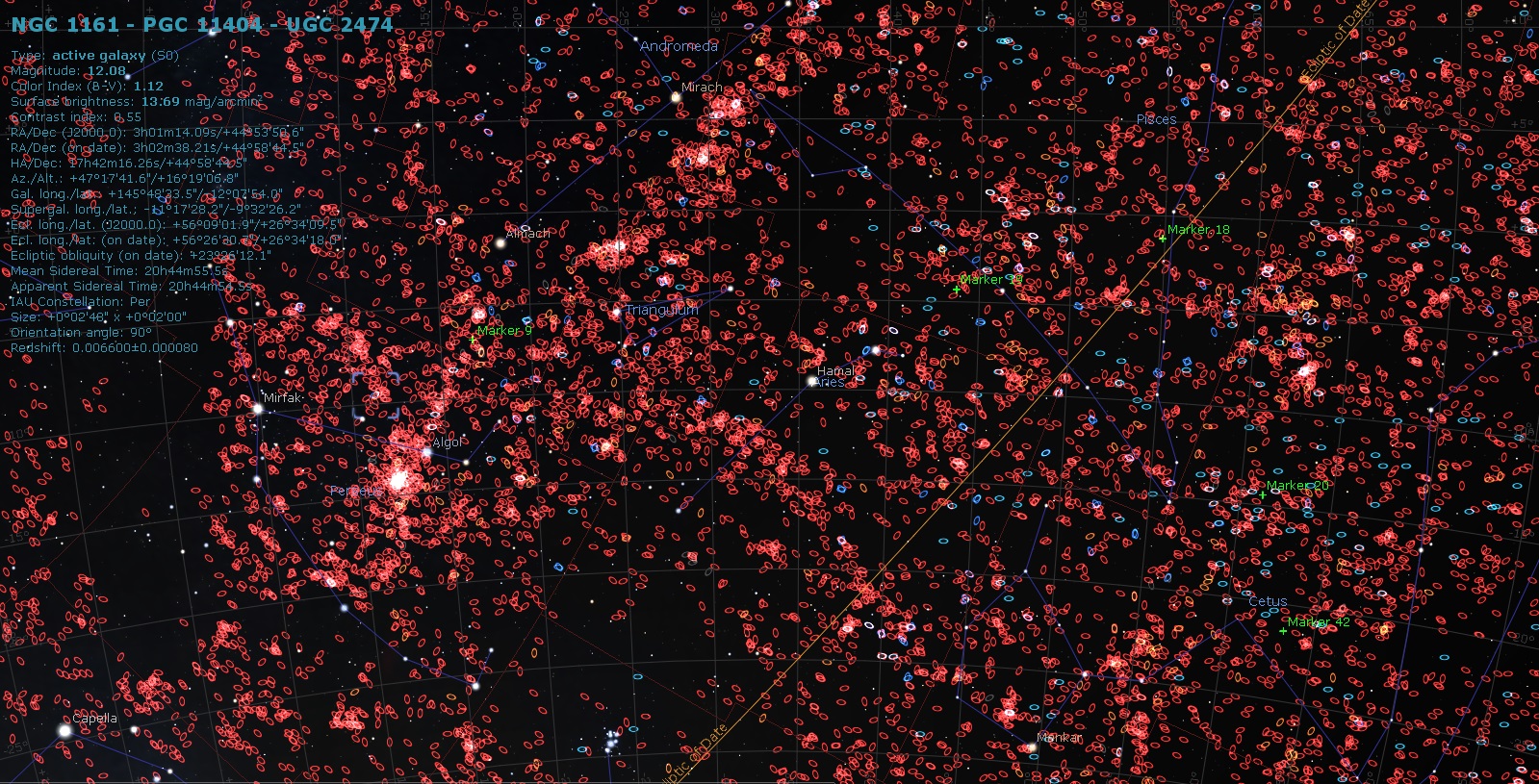
SUPERGALACTIC COORDINATES
NGC 1161
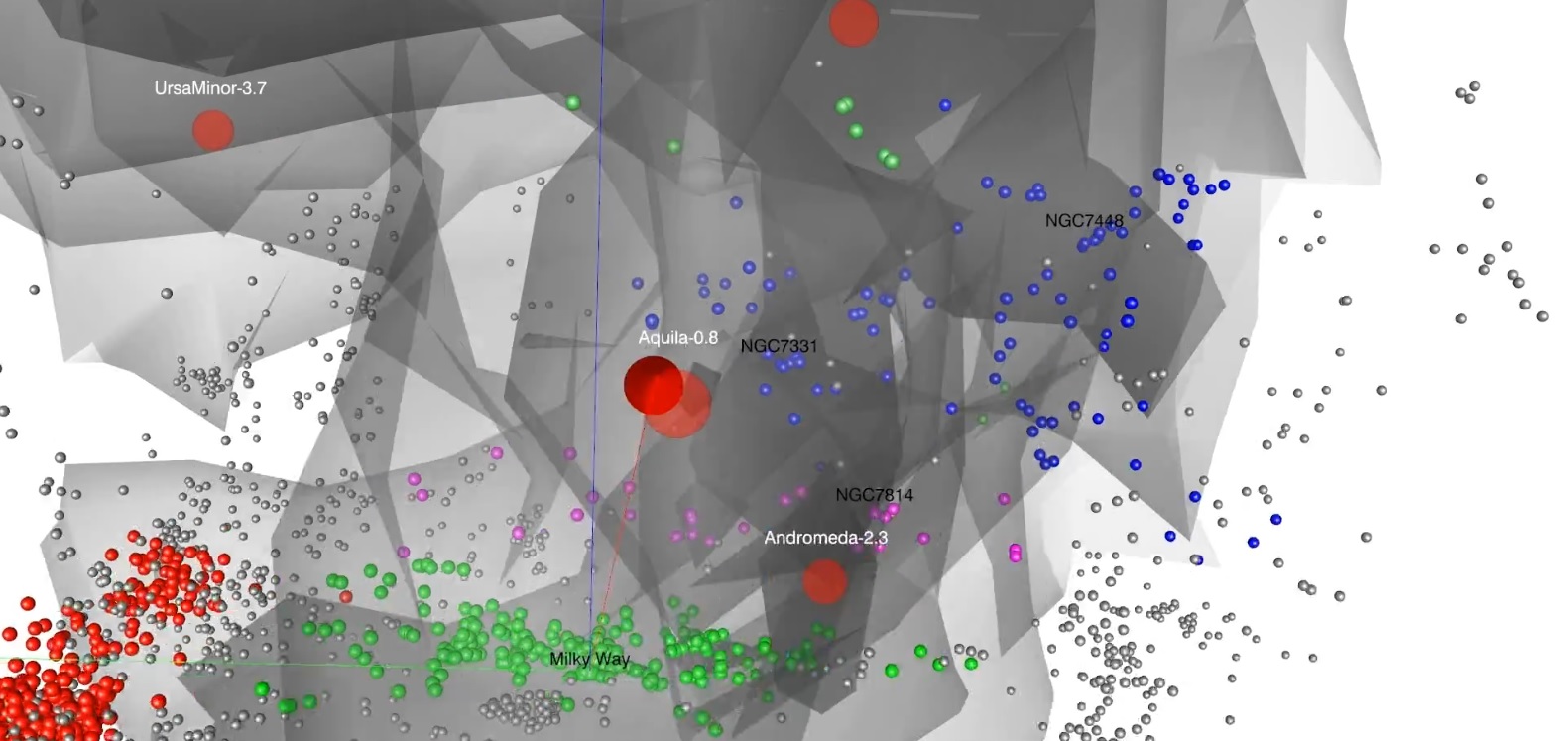
MILKY WAY - LOCAL VOID
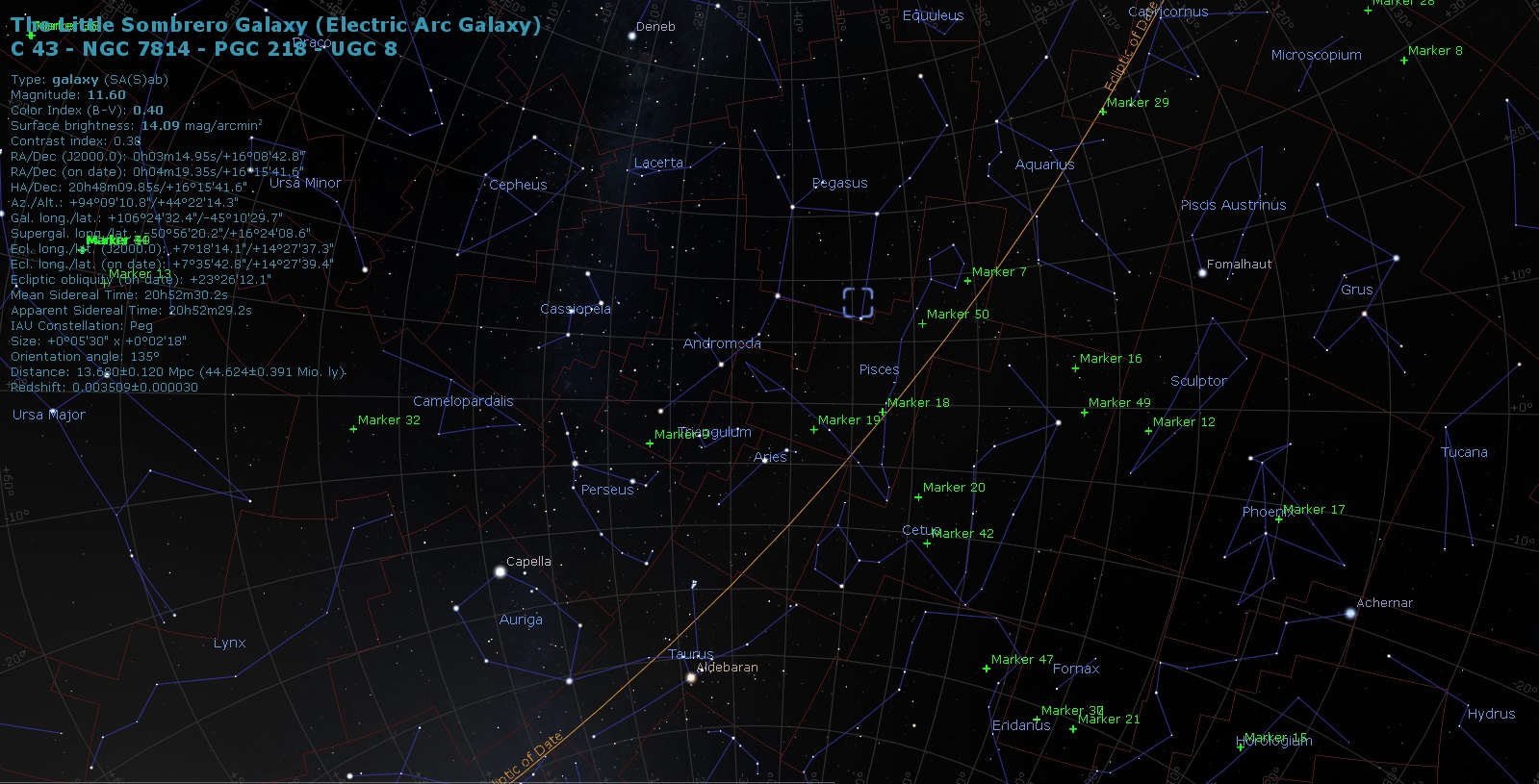
SUPERGALACTIC COORDINATES
NGC 7814
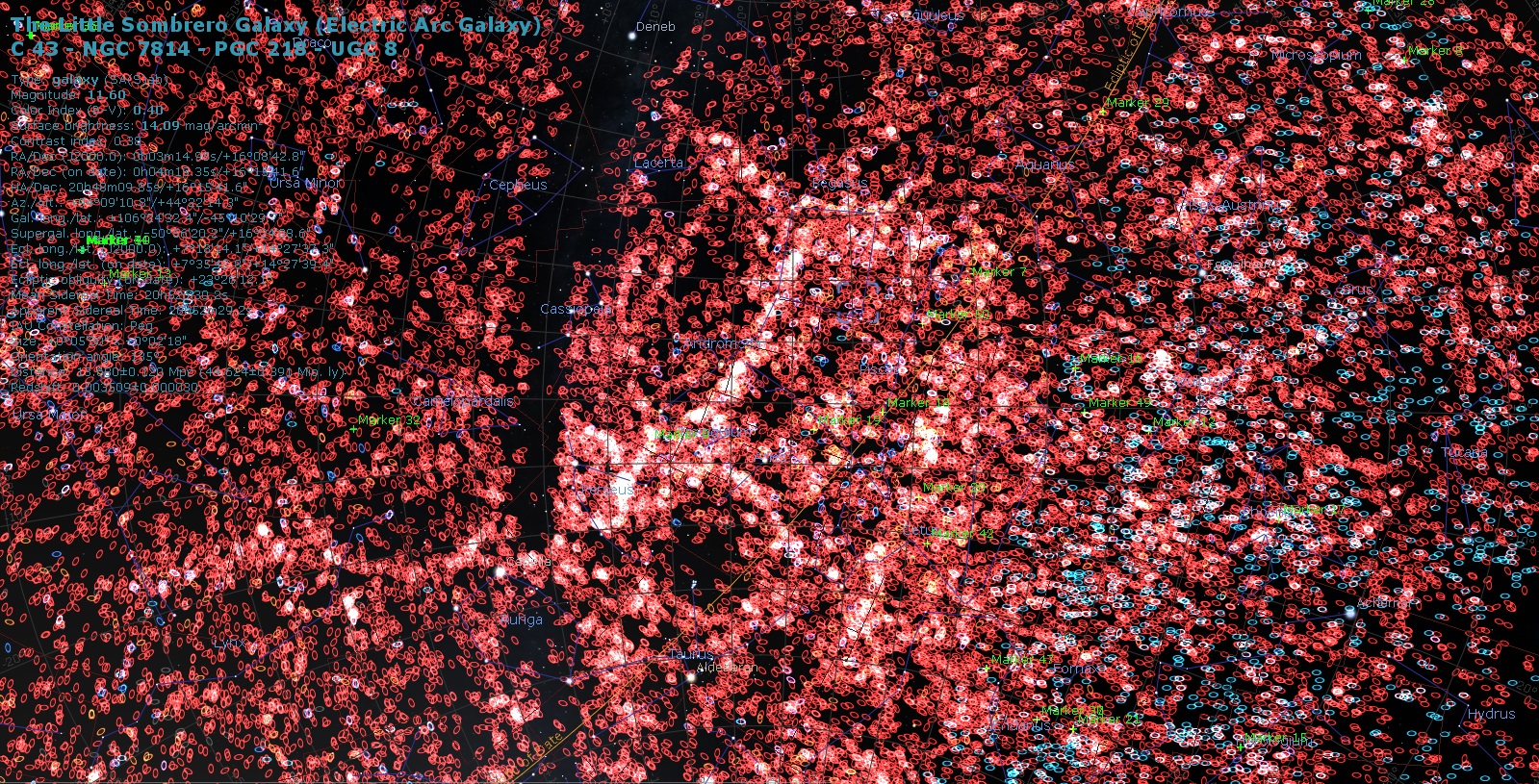
SUPERGALACTIC COORDINATES
NGC 7814
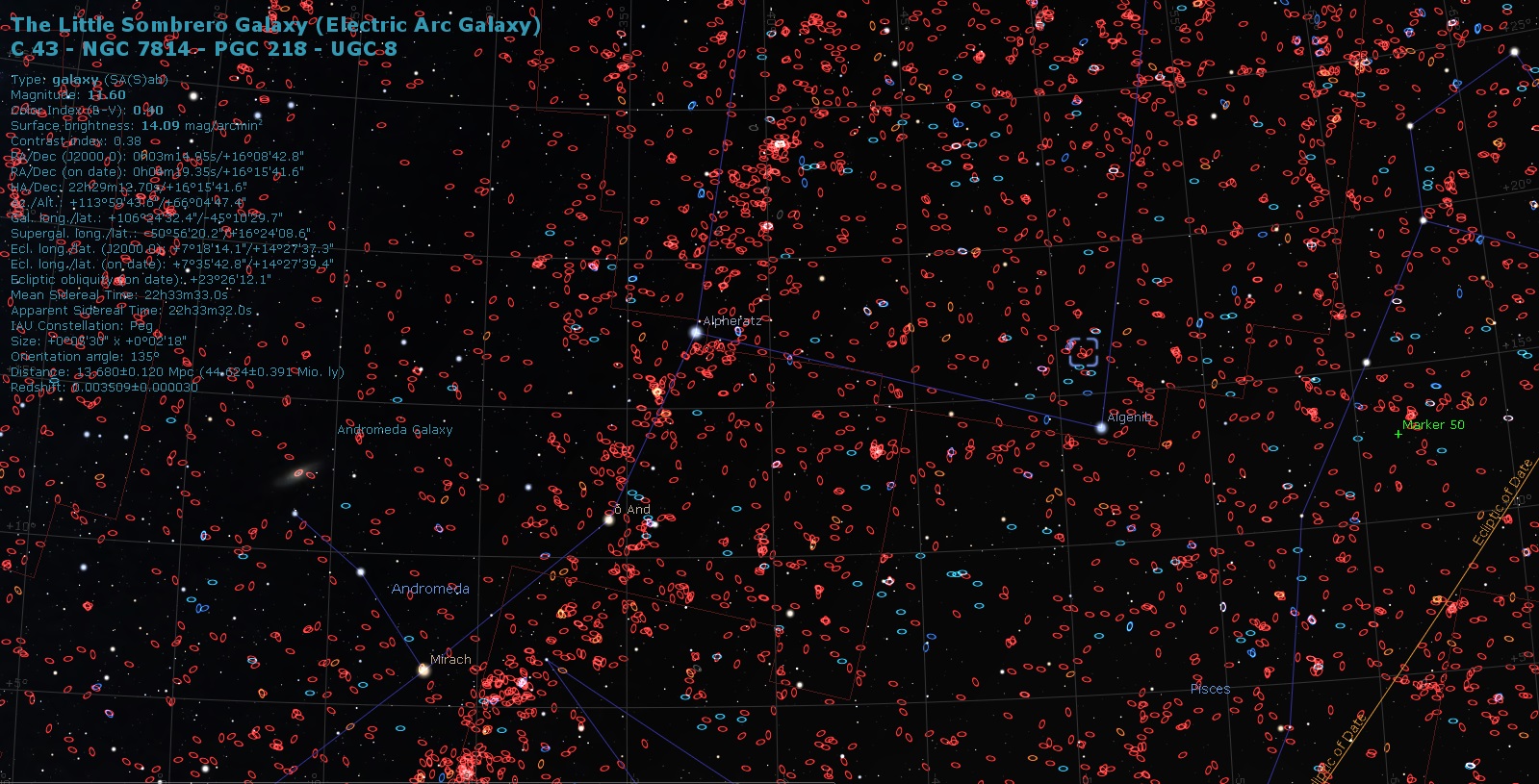
SUPERGALACTIC COORDINATES
NGC 7814
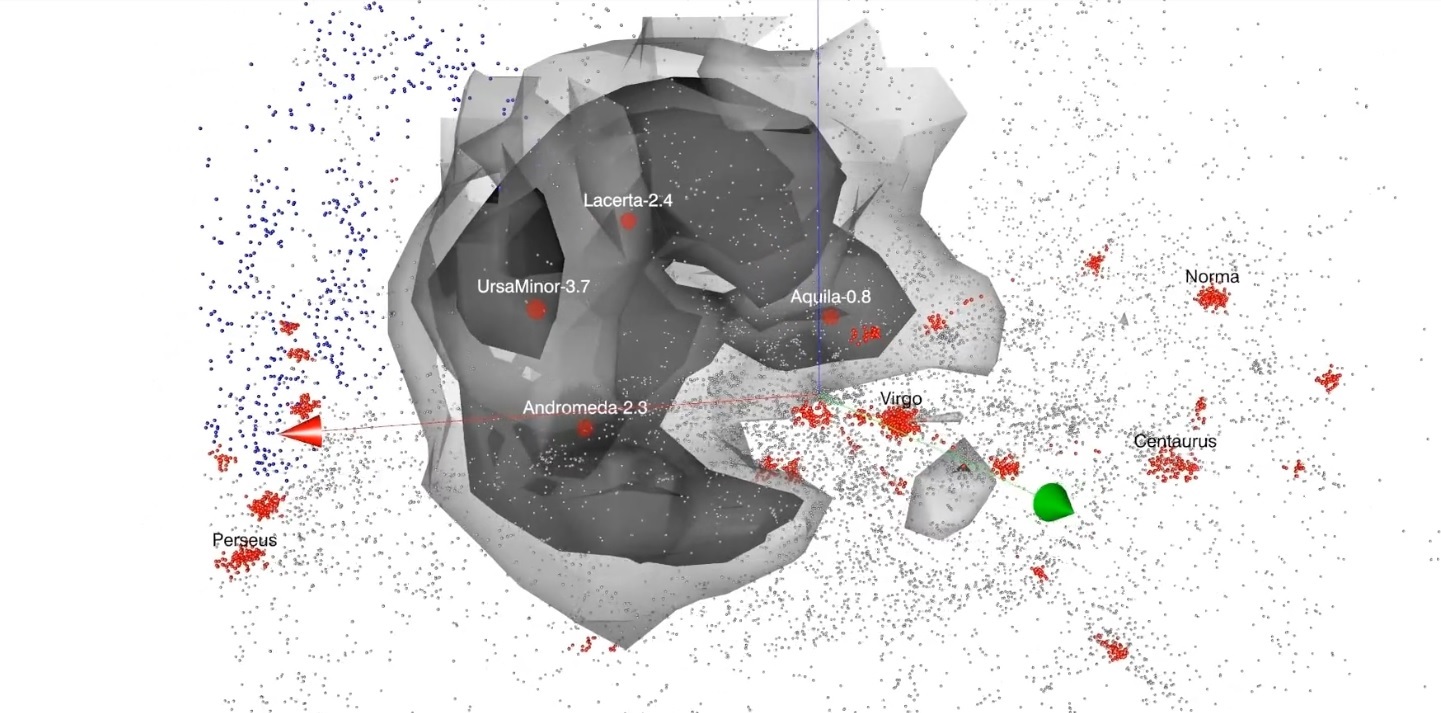
MILKY WAY - LOCAL VOID
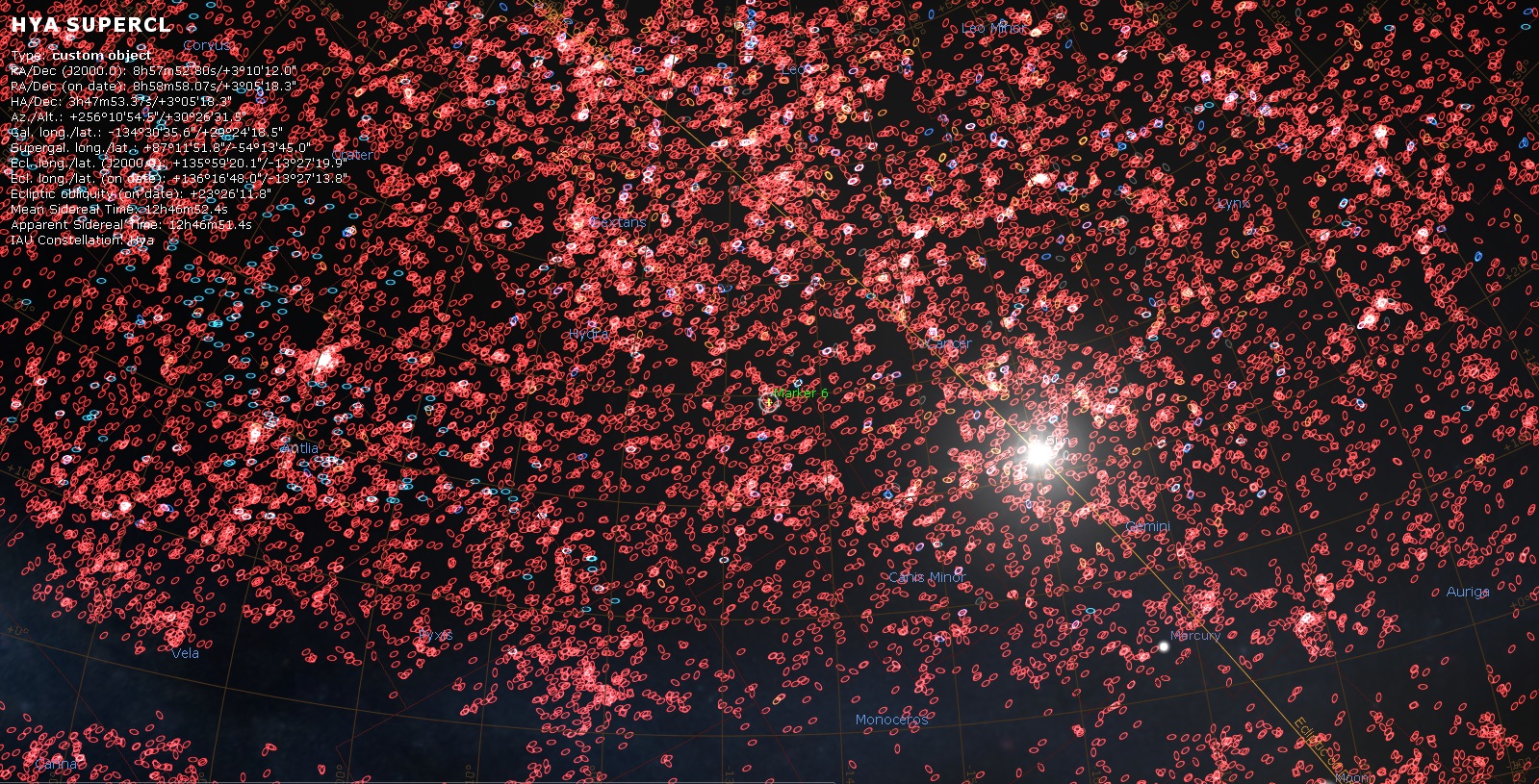
MARKER 6: SCL 128 - HYDRA-CENTAURUS SUPERCLUSTER
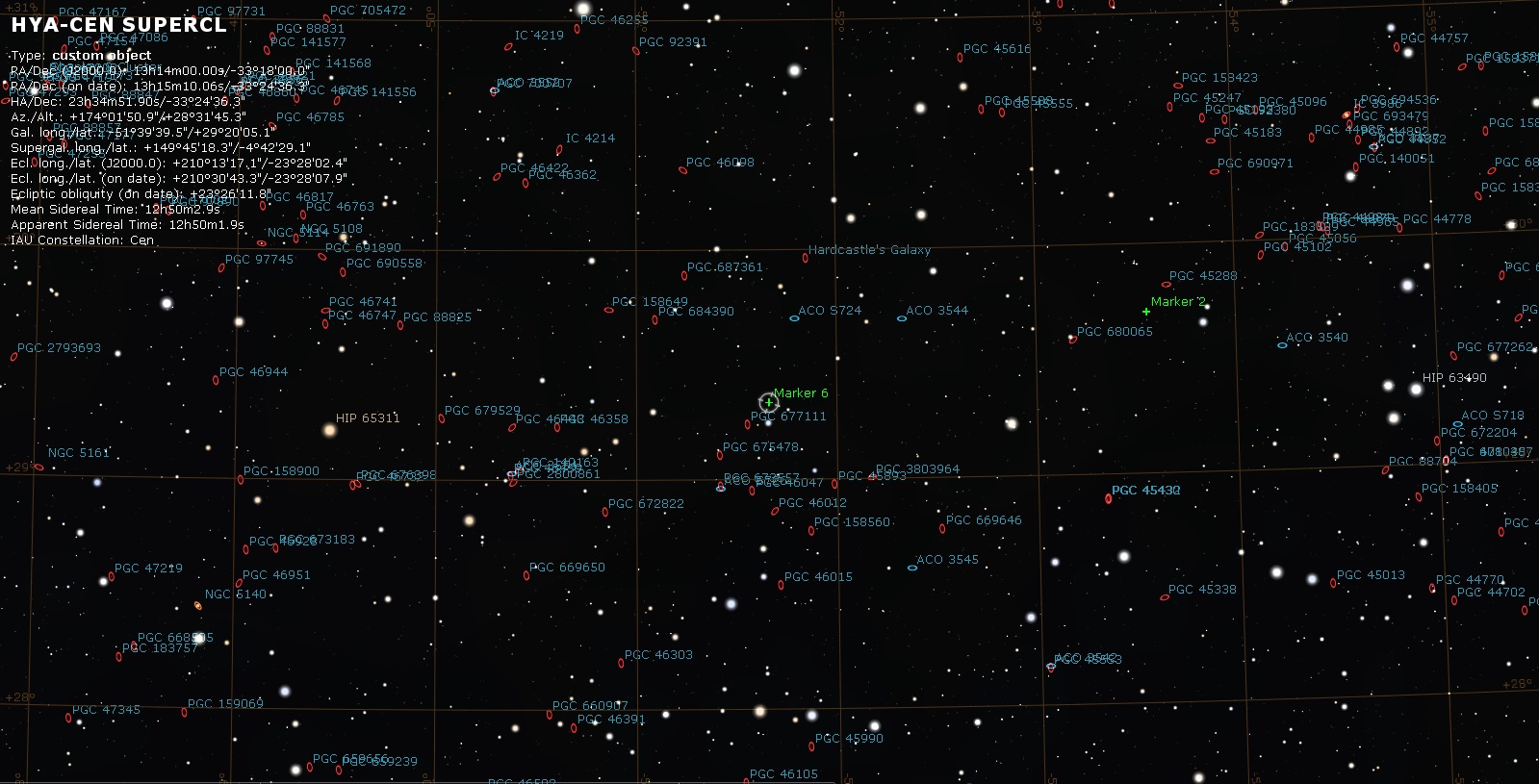
MARKER 6: SCL 128 - HYDRA-CENTAURUS SUPERCLUSTER
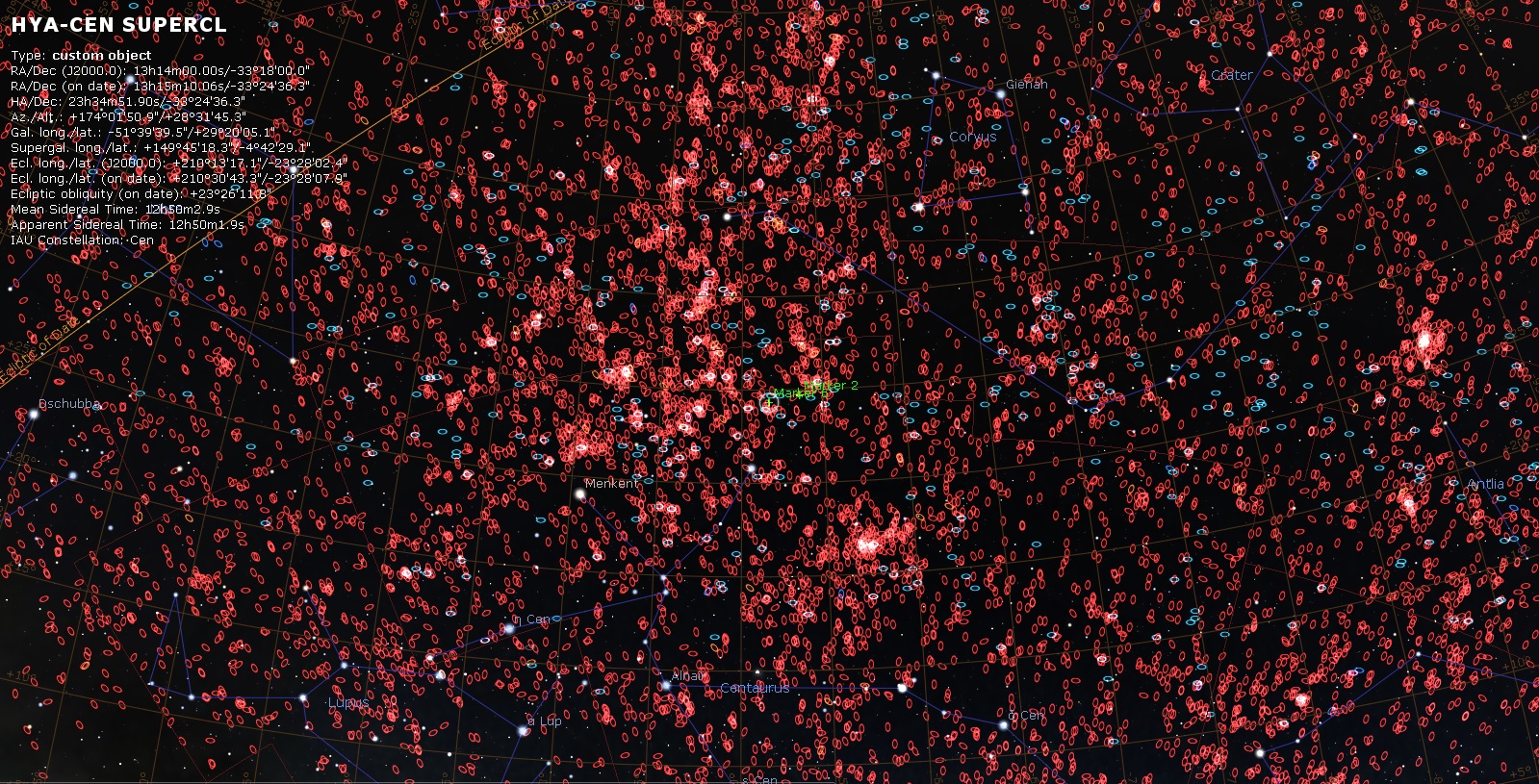
MARKER 6: SCL 128 - HYDRA-CENTAURUS SUPERCLUSTER
Hydra-Centaurus Supercluster
The Hydra-Centaurus Supercluster (SCl 128), or the Hydra and Centaurus Superclusters, is a supercluster in two parts,
the closest neighbour of Virgo Supercluster.
Right Ascension: 12h 48m 49.3s
Declination: -41° 18' 40?
Distance: ~54 Mpc (176 Mly)(co-moving)
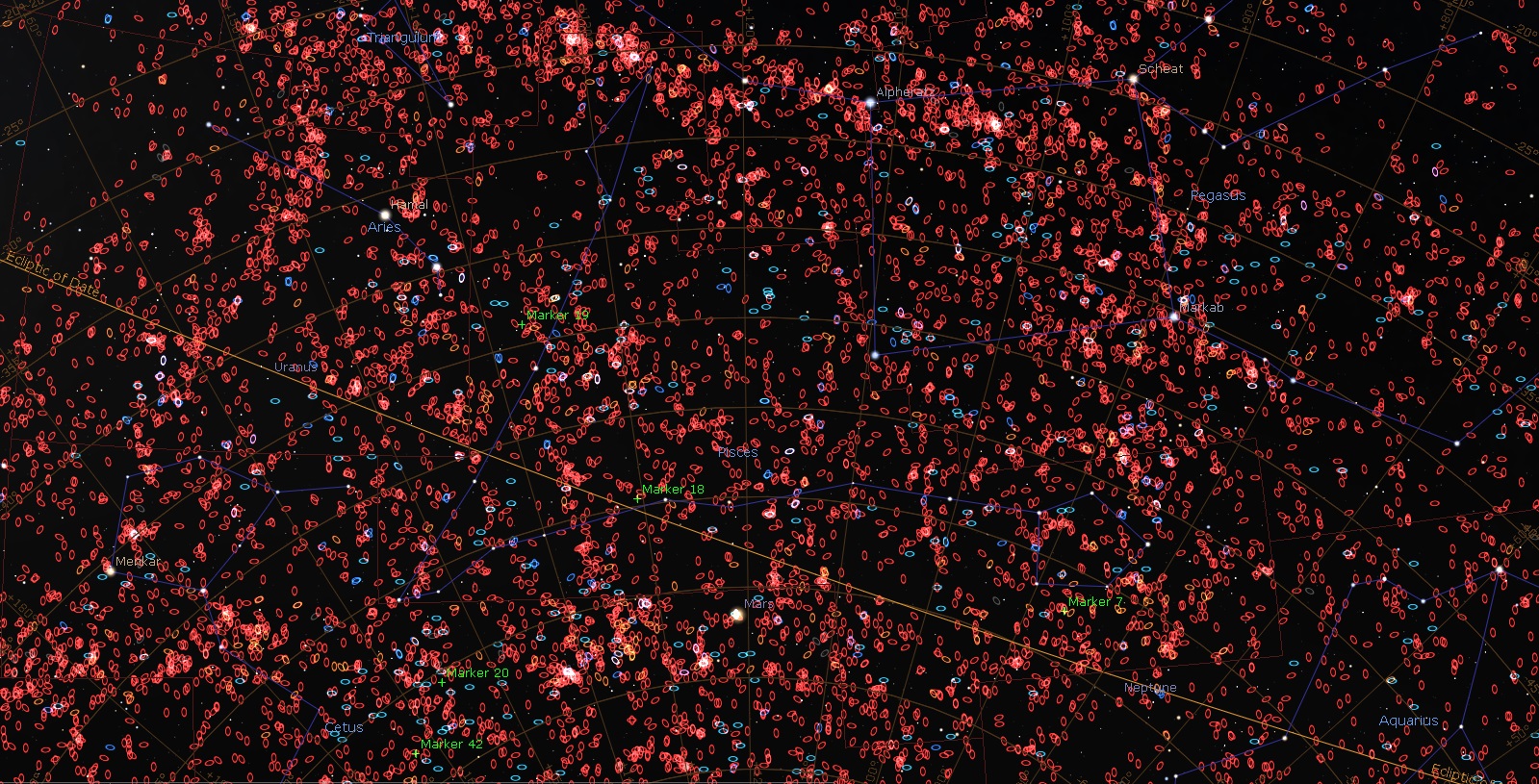
MARKER 7: SARASWATI SUPERCLUSTER
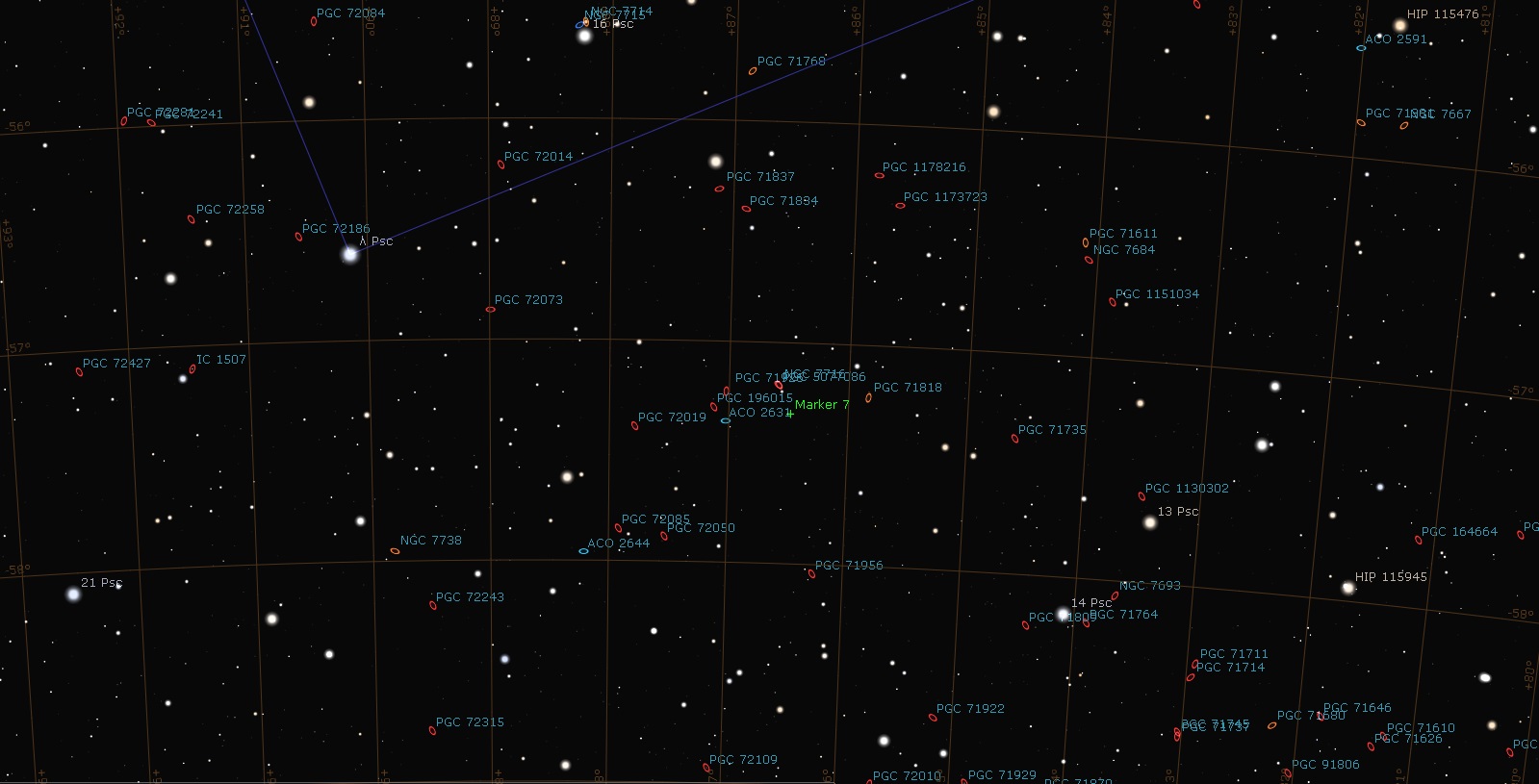
MARKER 7: SARASWATI SUPERCLUSTER
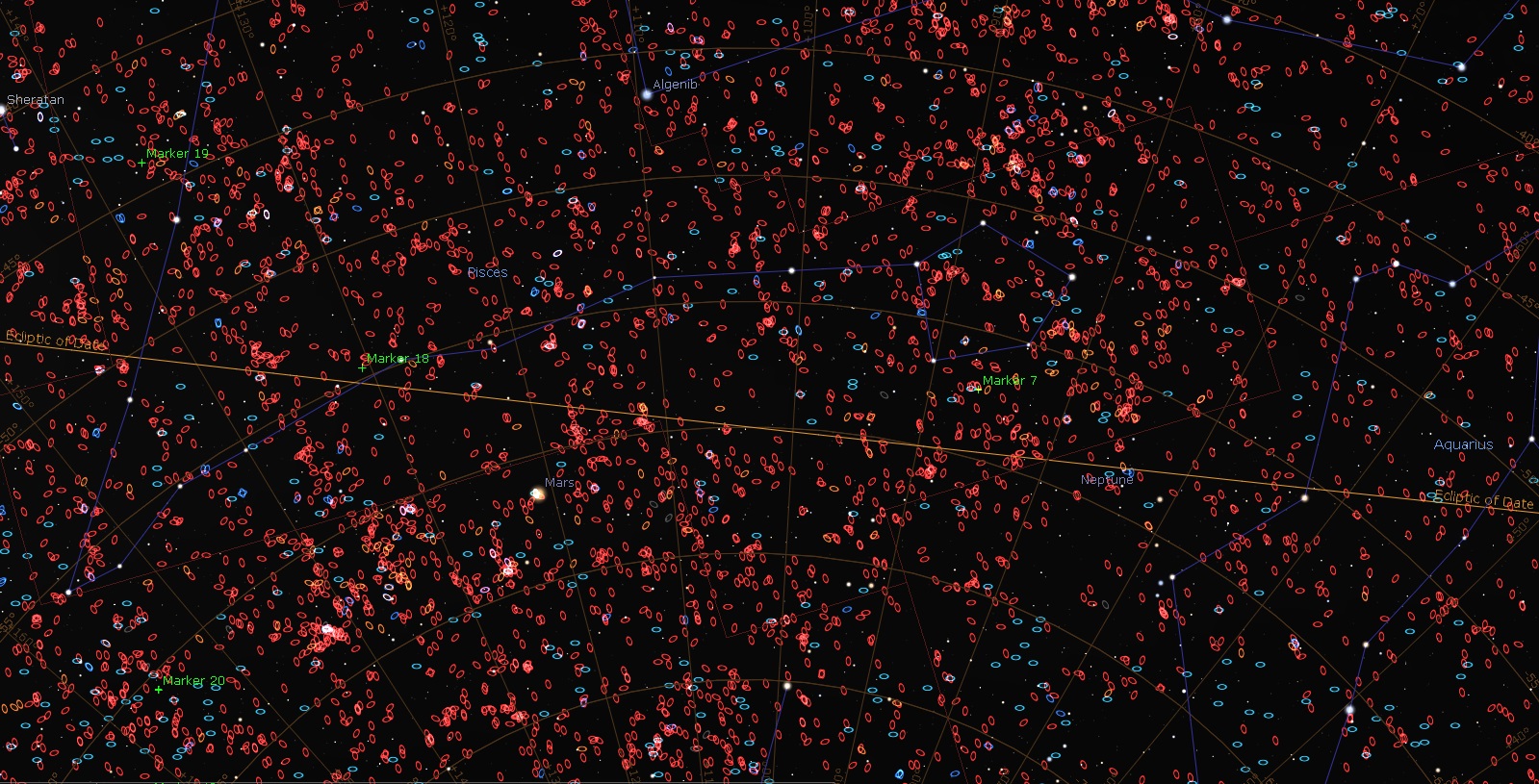
MARKER 7: SARASWATI SUPERCLUSTER
The Saraswati Supercluster
A massive galaxy supercluster about 1.2 gigaparsecs (4,000 million light years) away within the Stripe 82 region of SDSS, in the direction of the constellation Pisces. It is one of the largest structures found in the universe, with a major axis in diameter of about 200 Mpc (652 million light years). It consists of at least 43 galaxy clusters.
Constellation: Pisces
Right Ascension: 23h 37m 40s
Declination: 00° 16' 17
Number of galaxies: 43
Major axis: 200 Mpc (652 Mly)
Redshift: 0.28
Distance: 1.2 Gpc (4 Gly)
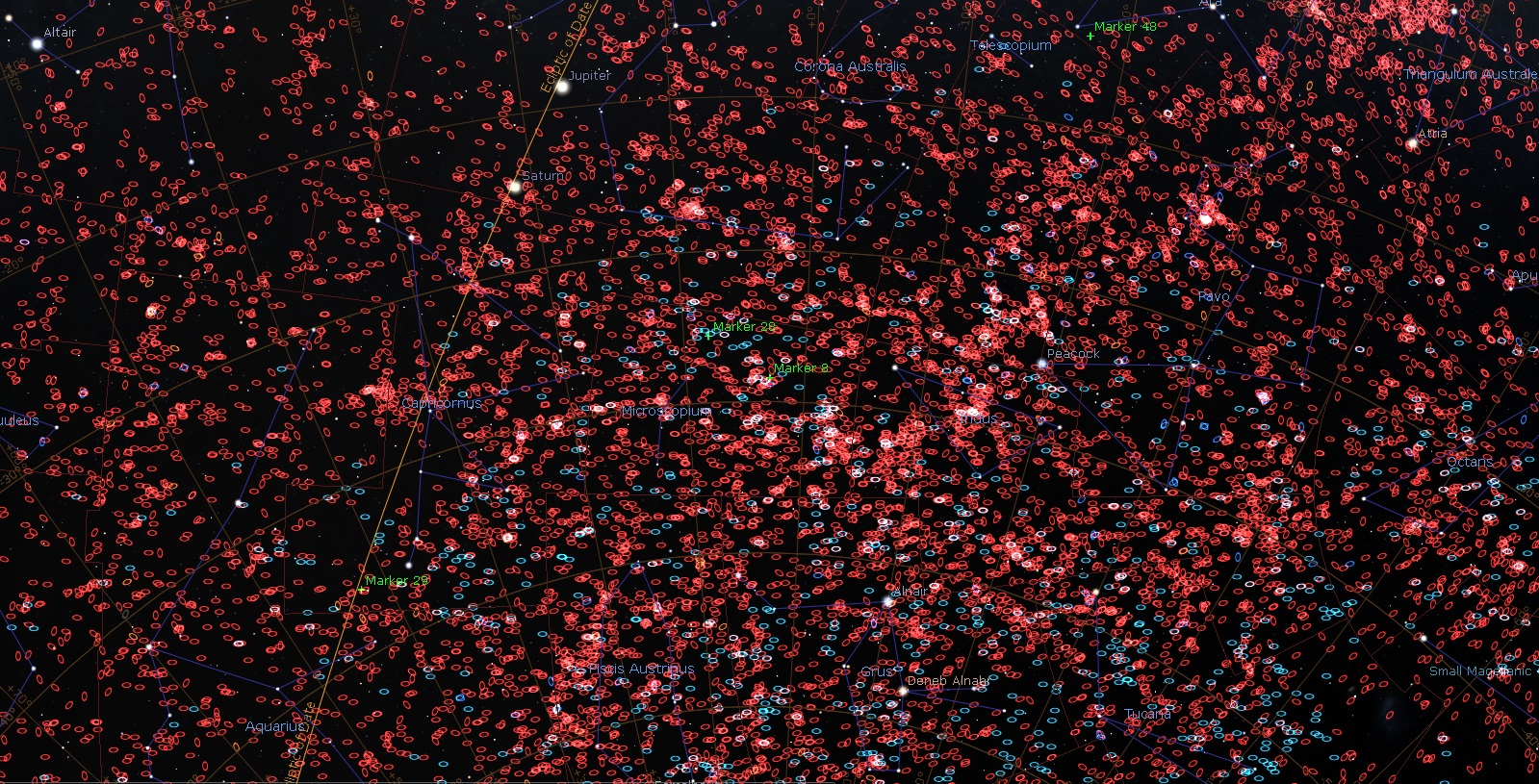
MARKER 8: PAVO-INDUS SUPERCLUSTER
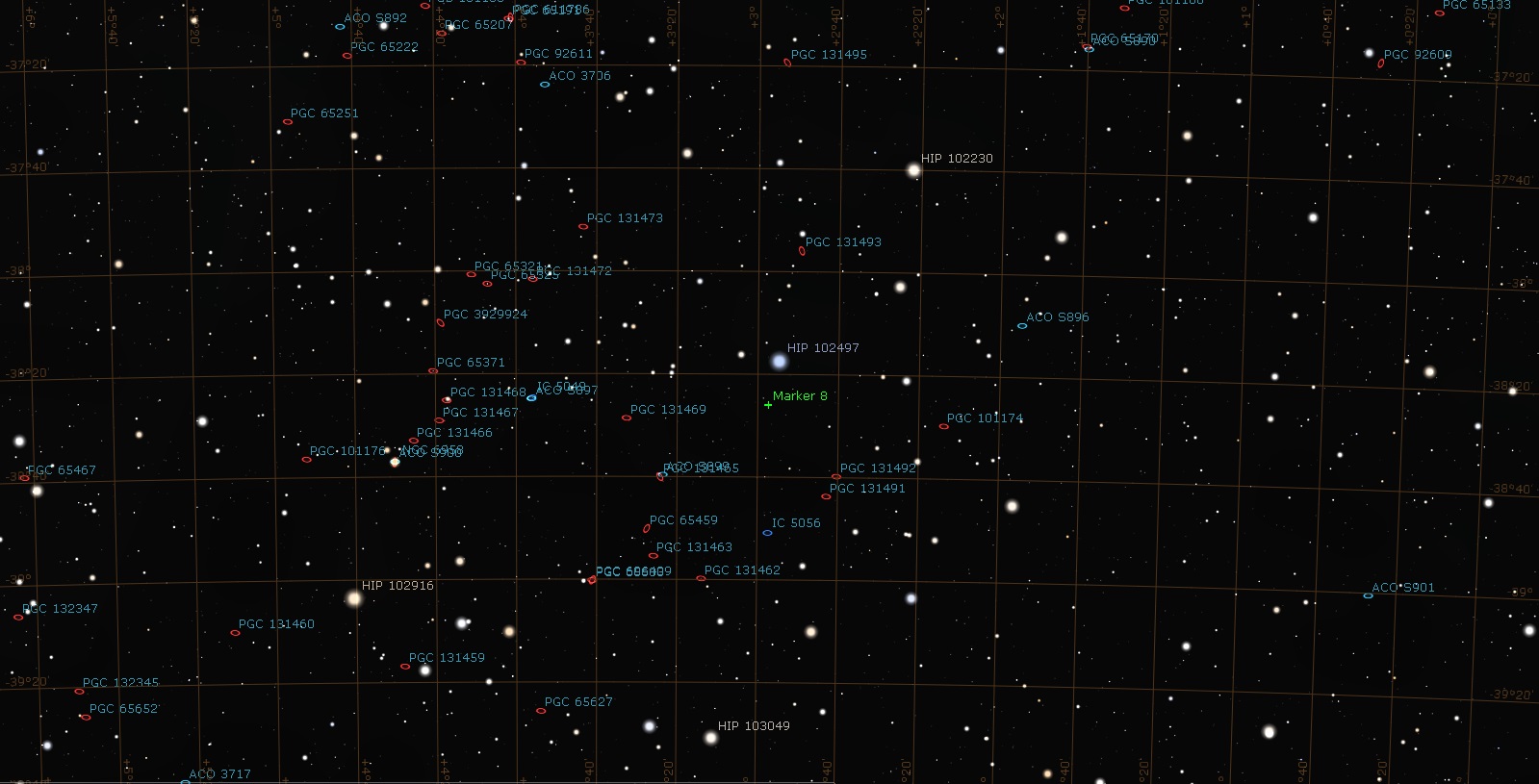
MARKER 8: PAVO-INDUS SUPERCLUSTER
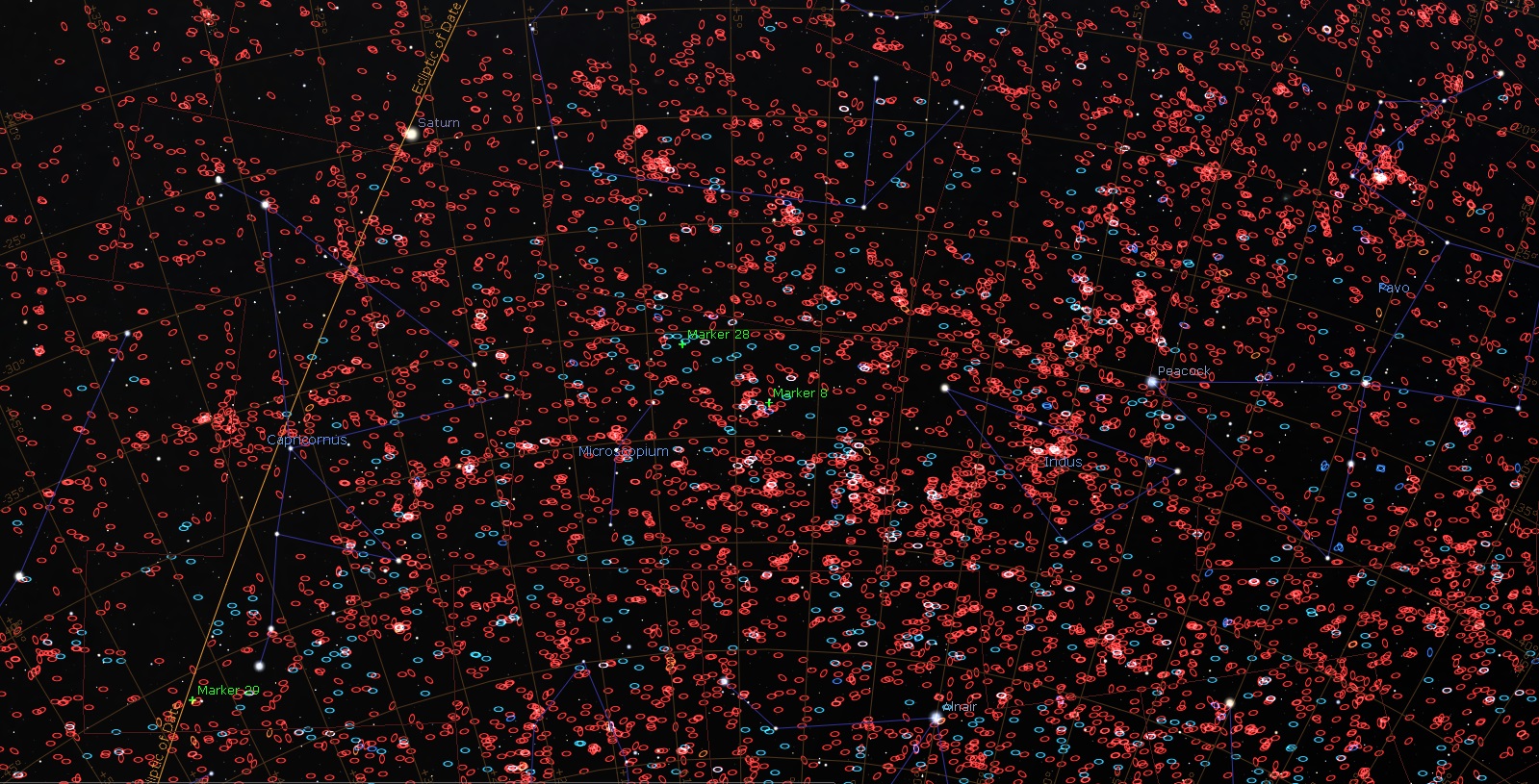
MARKER 8: PAVO-INDUS SUPERCLUSTER
Pavo-Indus Supercluster
The Pavo-Indus Supercluster is a neighboring supercluster located about 60–70 Mpc (196–228 Mly)away
in the constellations of Pavo, Indus, and Telescopium.
Constellation(s): Pavo, Indus, Telescopium
Right Ascension: 20h 48m 26s
Declination: -39° 06' 09?
Major axis: 66 Mpc (215 Mly)
Redshift: 0.015 (4,500 km/s)
Distance: 60–70 Mpc (196–228 Mly)(co-moving)
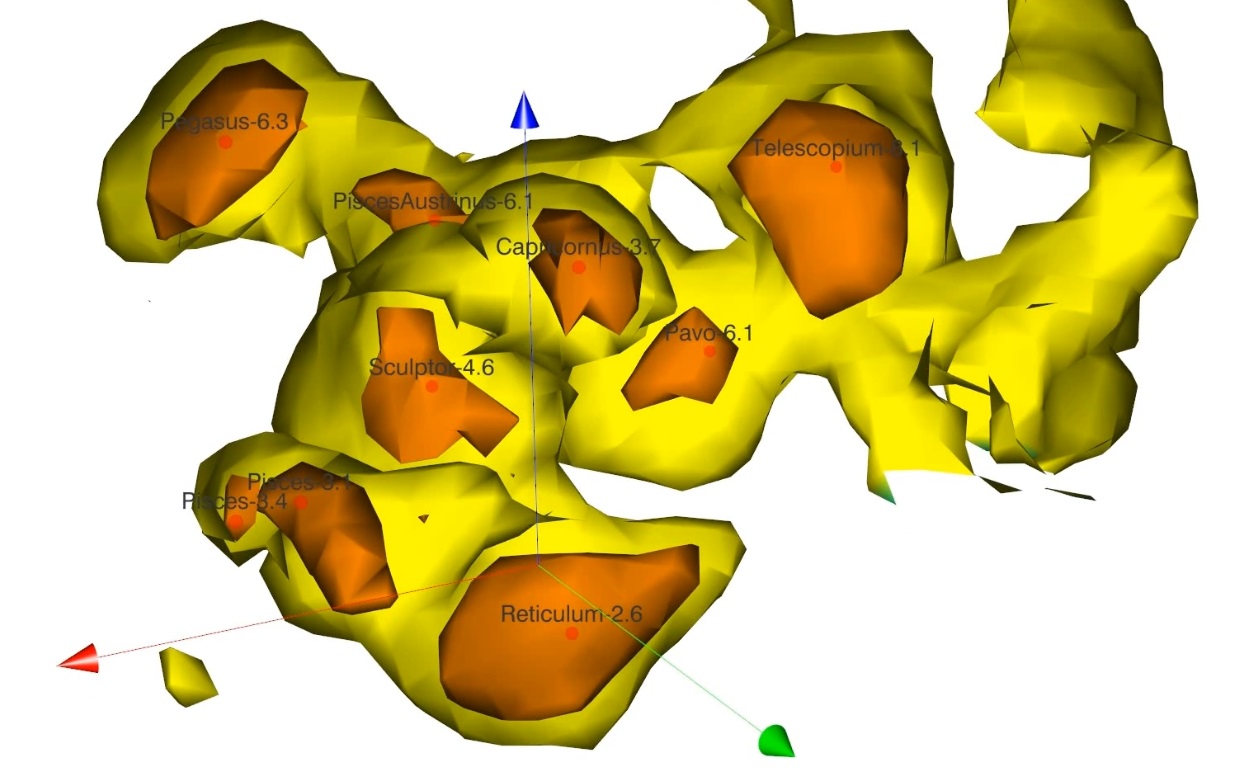
THE SCULPTOR VOID
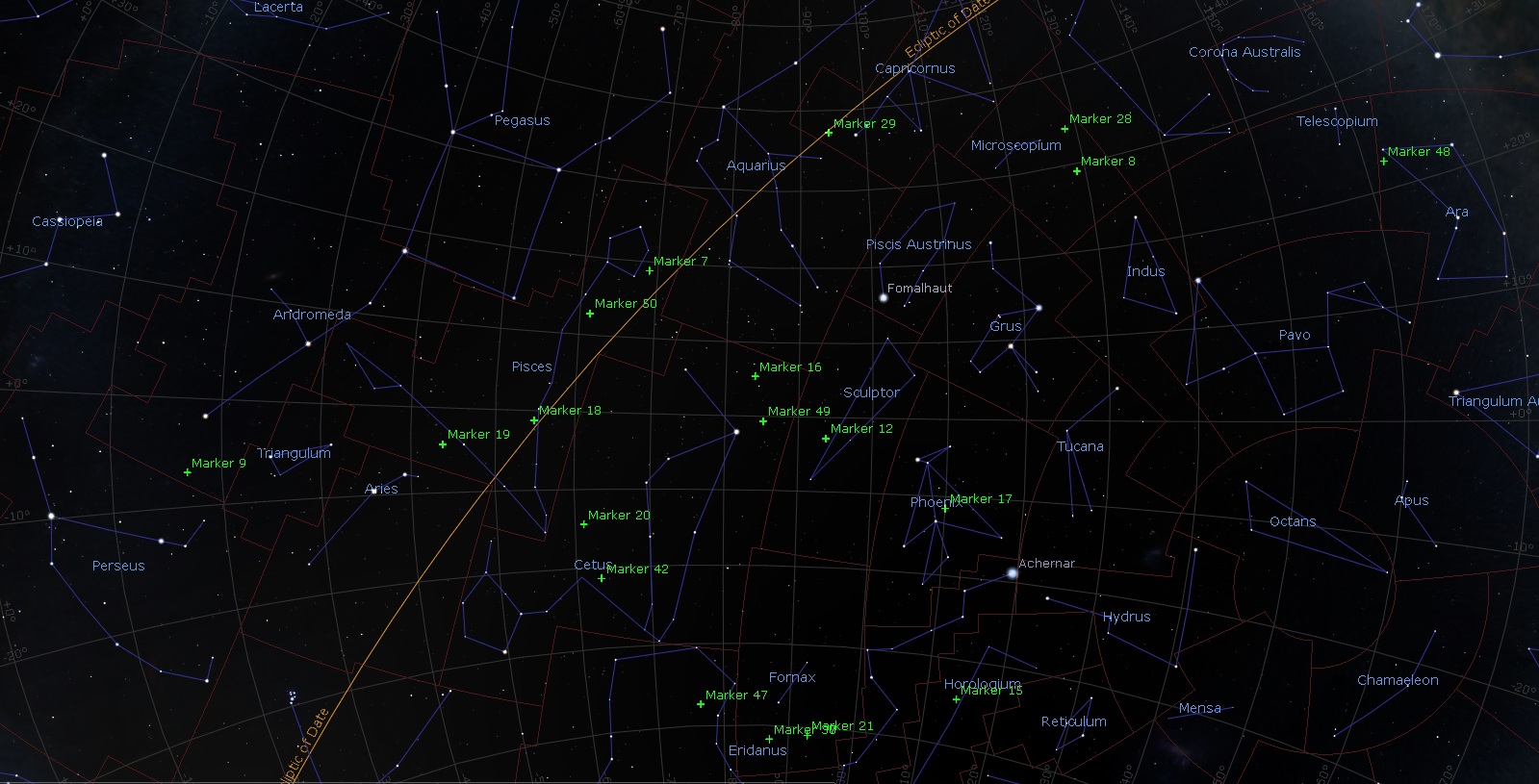
SUPERGALACTIC COORDINATES
THE SCULPTOR VOID
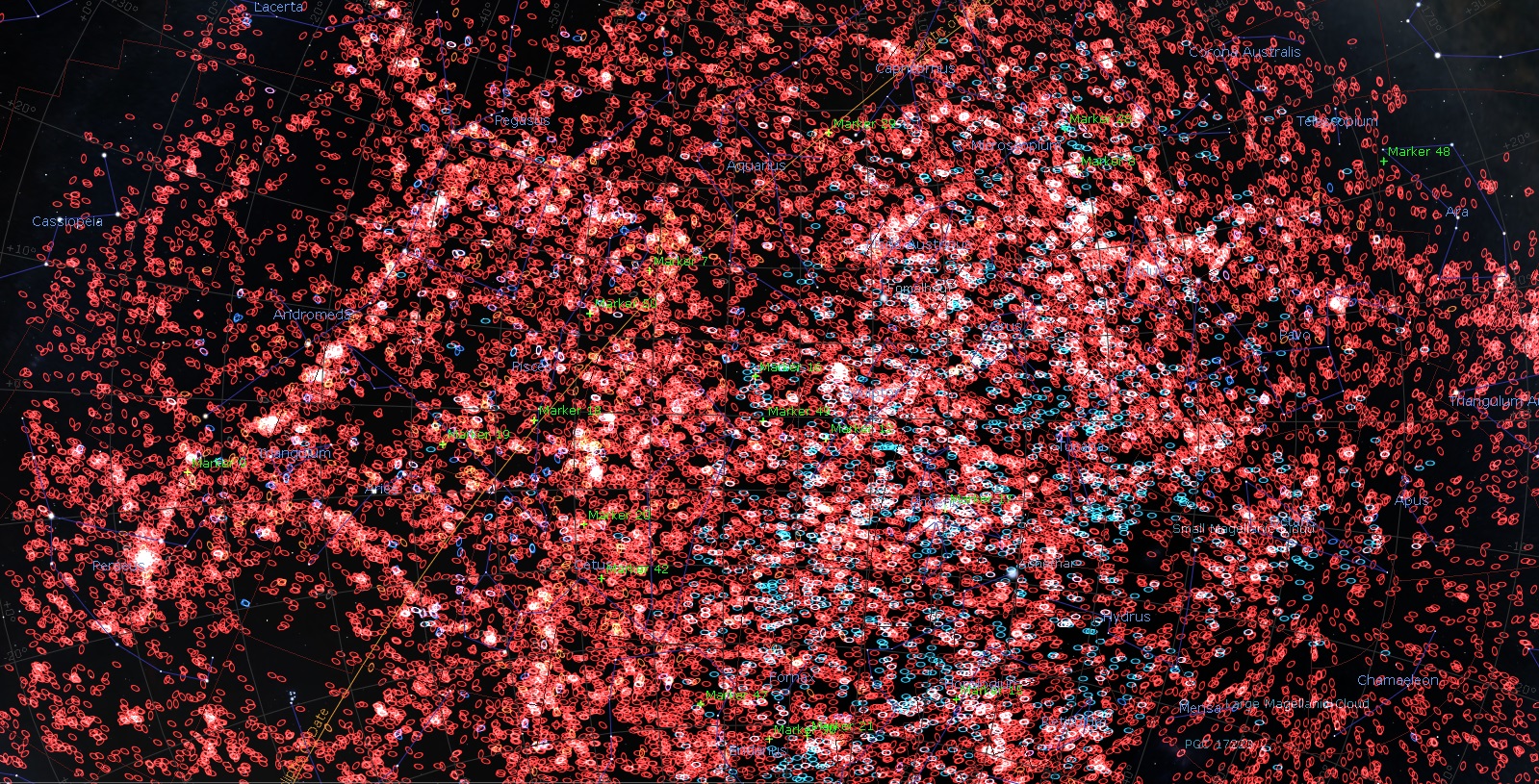
SUPERGALACTIC COORDINATES
THE SCULPTOR VOID
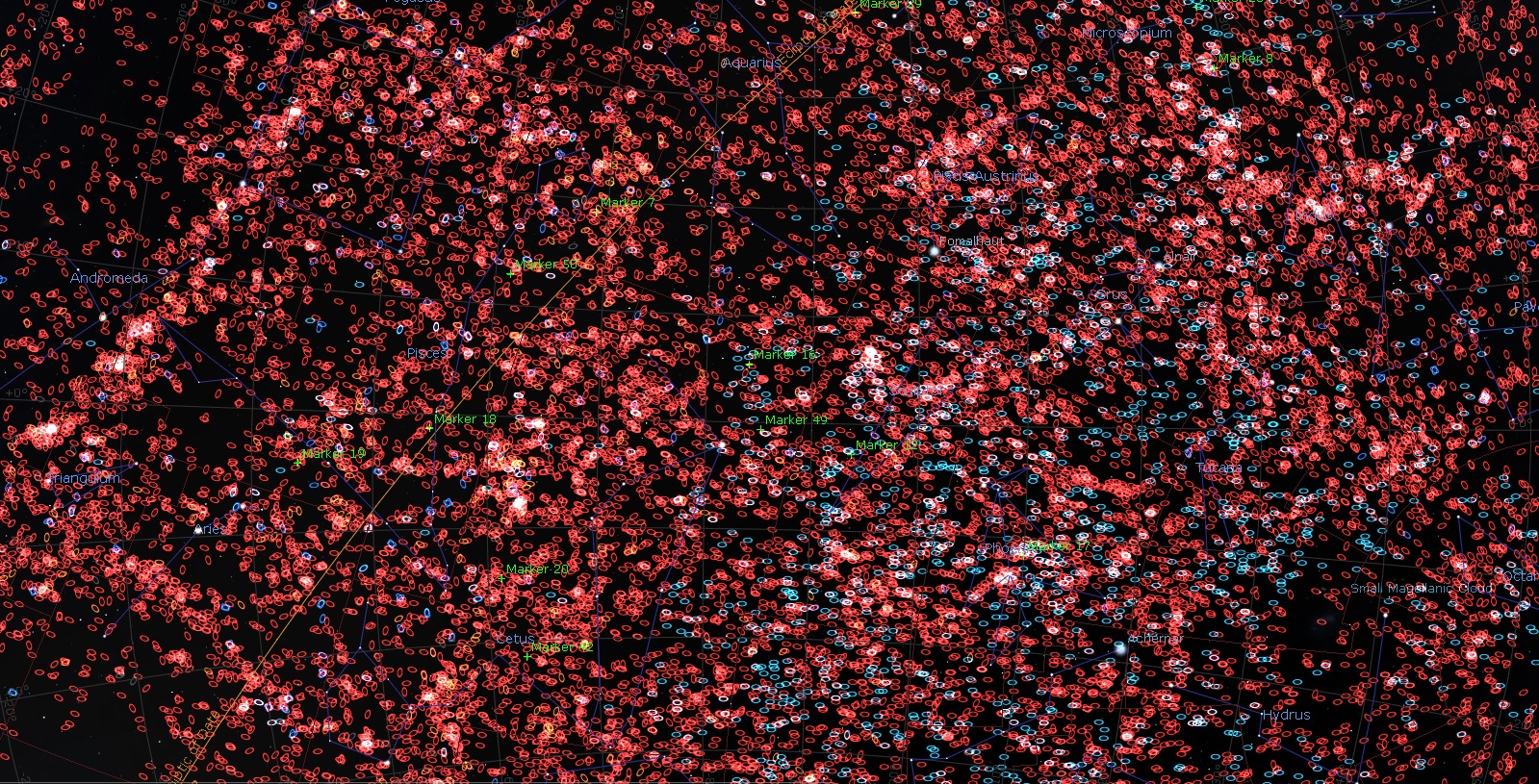
SUPERGALACTIC COORDINATES
THE SCULPTOR VOID
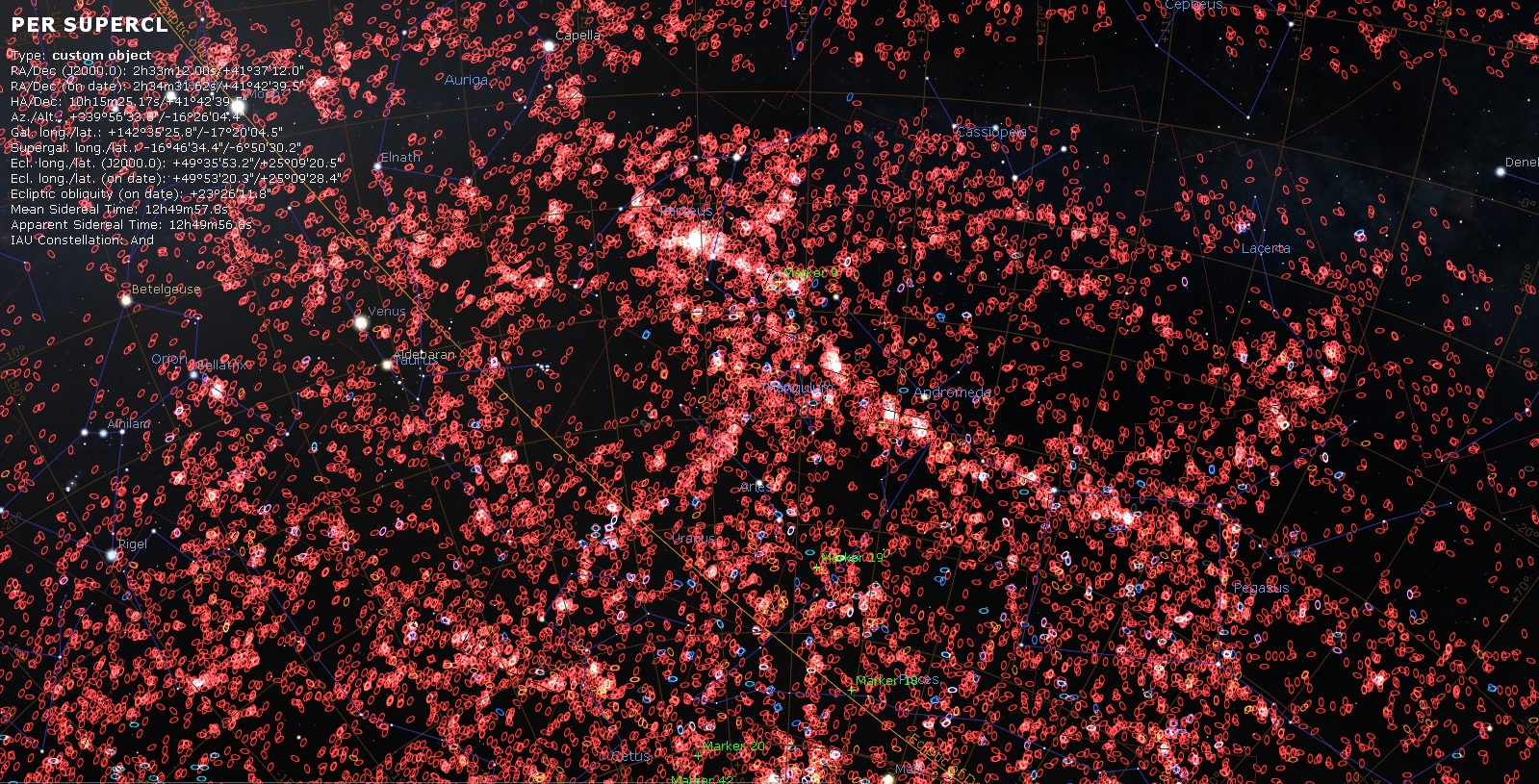
MARKER 9: SCL-40 - PERSEUS SUPERCLUSTER
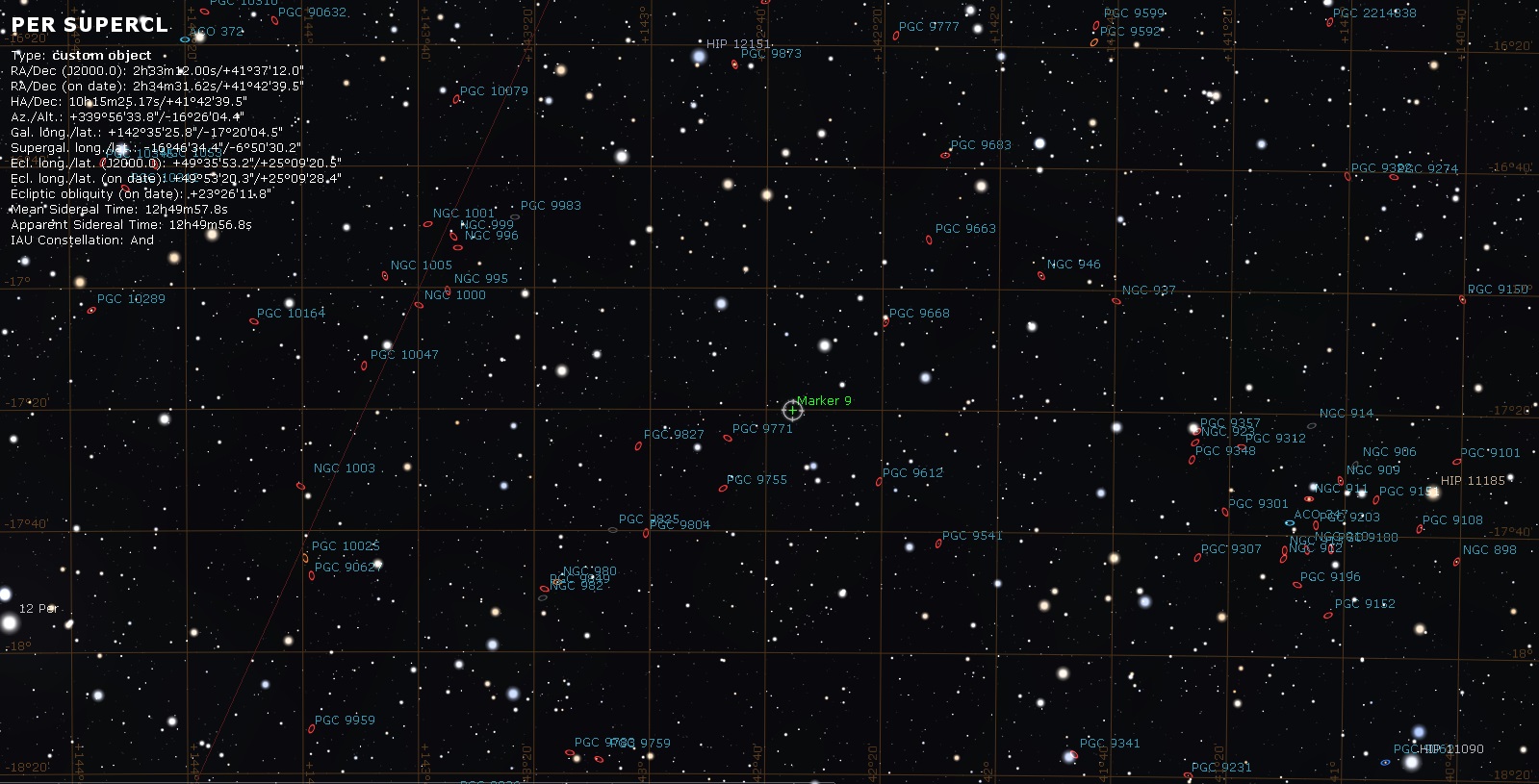
MARKER 9: SCL-40 - PERSEUS SUPERCLUSTER
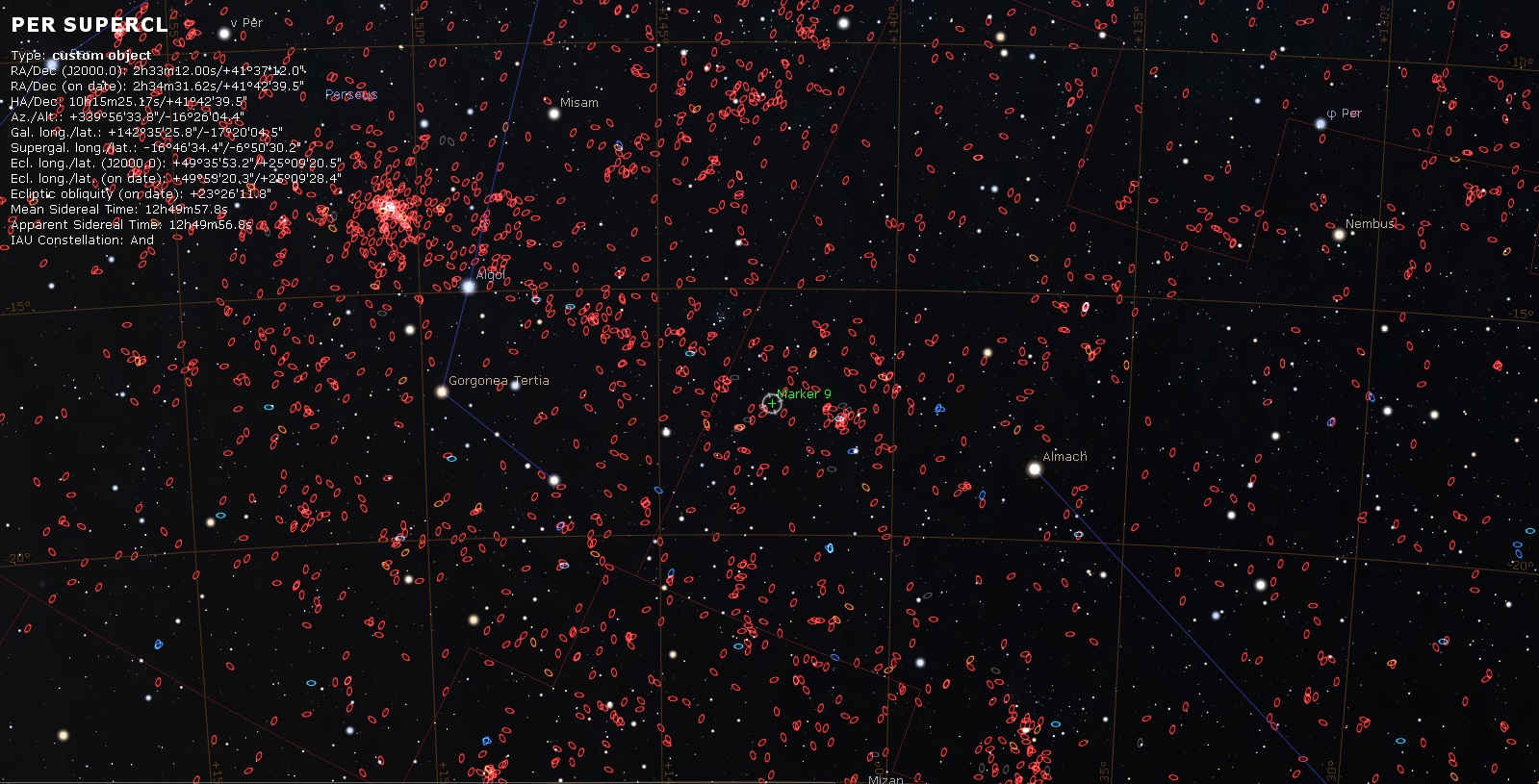
MARKER 9: SCL-40 - PERSEUS SUPERCLUSTER
Perseus-Pisces Supercluster
The Perseus-Pisces Supercluster (SCl 40) is one of the largest known structures in the universe.
Even at a distance of 250 million light-years, this chain of galaxy clusters extends more than 40° across the northern winter sky.
The Perseus-Pisces Supercluster is one of two dominant concentrations of galaxies (the other being the Local supercluster)
in the nearby universe (within 300 million light years).
This supercluster also borders a prominent void, the Taurus Void, and is part of the Perseus–Pegasus Filament which stretches
for roughly a billion light years.
Constellation(s): Perseus, Pisces
Right Ascension: 01h 50m
Declination: +36° 00'
Distance: 76.7 Mpc (250 Mly)(co-moving)

ANDROMEDA - LOCAL VOID
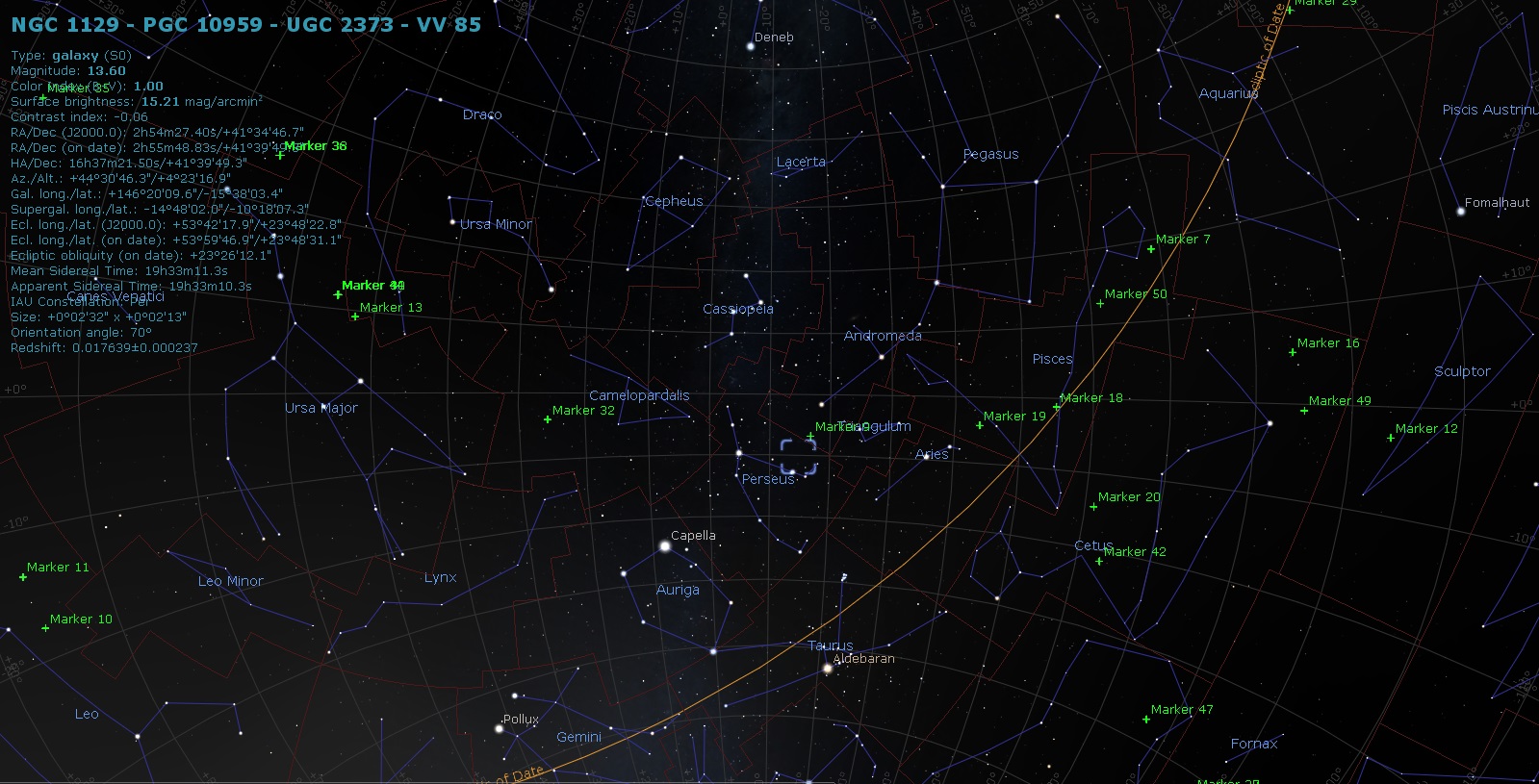
SUPERGALACTIC COORDINATES
NGC 1129 - PERSEUS SUPERCLUSTER
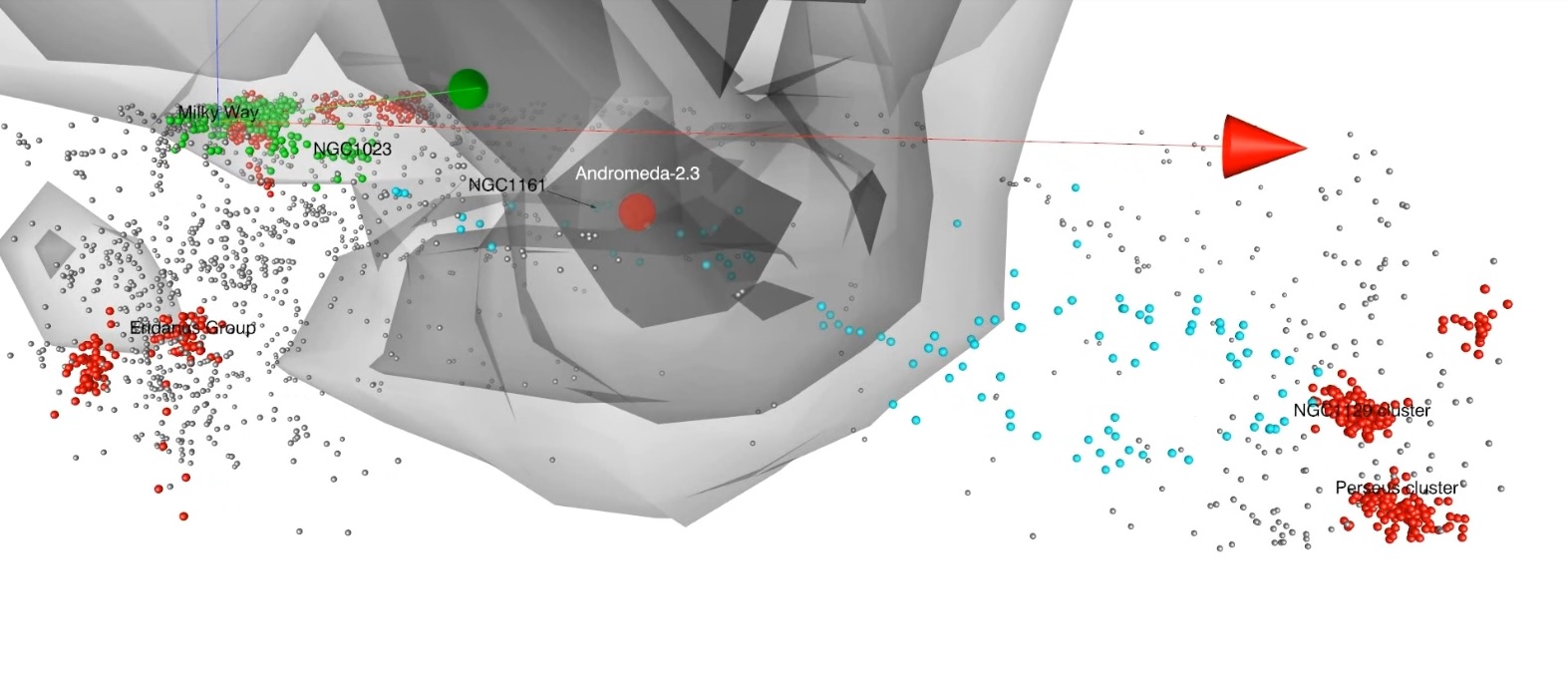
MILKY WAY - LOCAL VOID
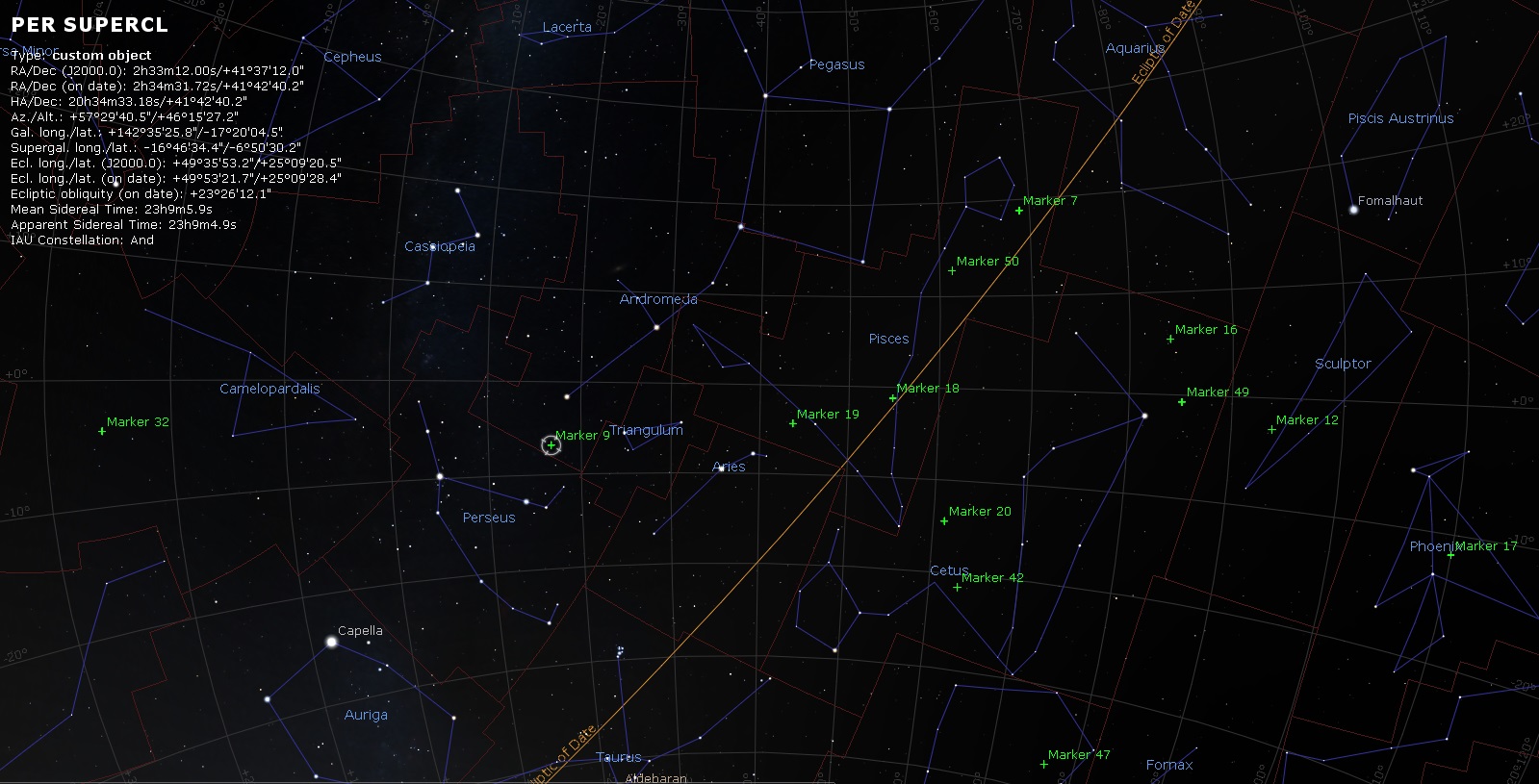
SUPERGALACTIC COORDINATES
MARKER 9: SCL-40 - PERSEUS SUPERCLUSTER
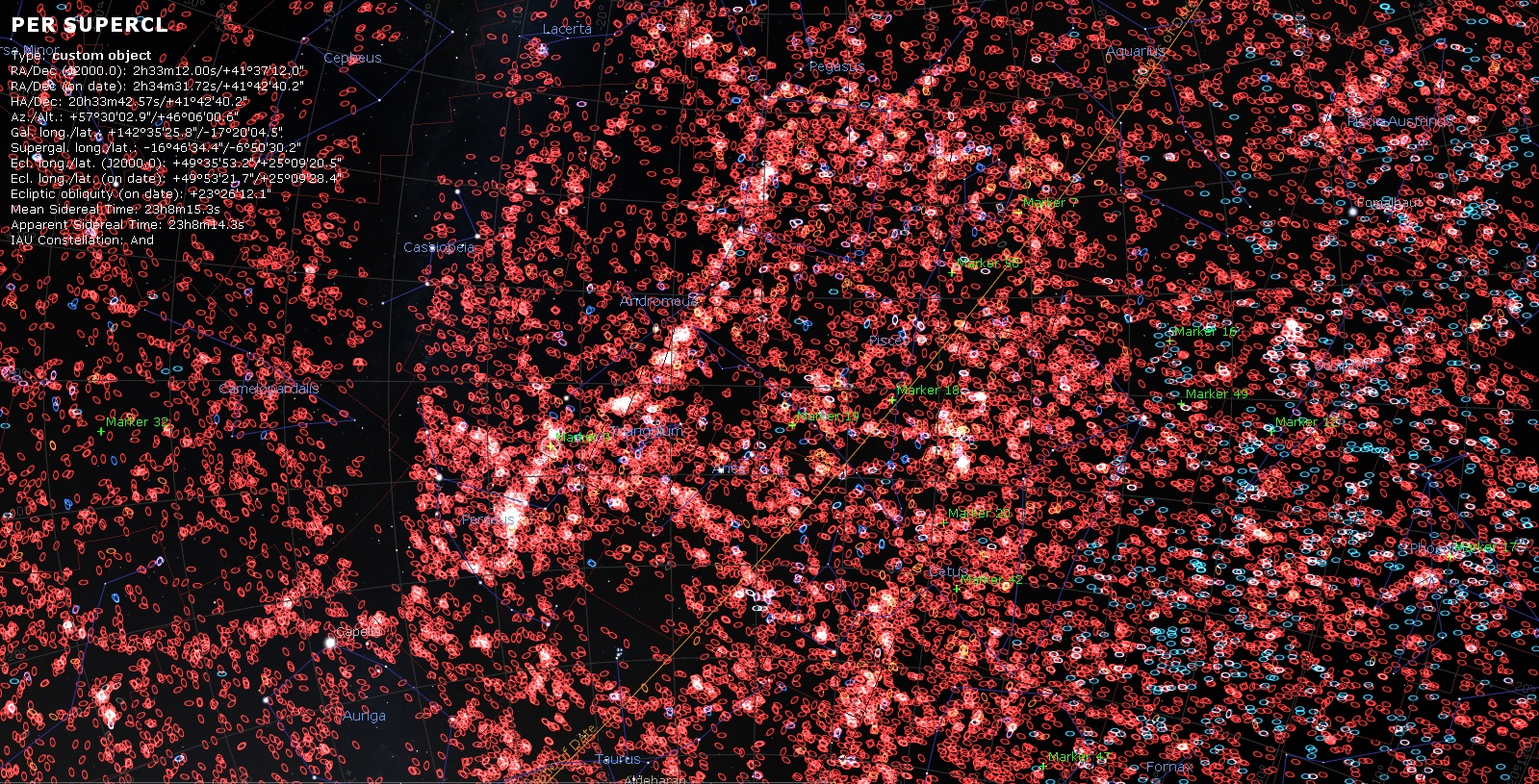
SUPERGALACTIC COORDINATES
MARKER 9: SCL-40 - PERSEUS SUPERCLUSTER
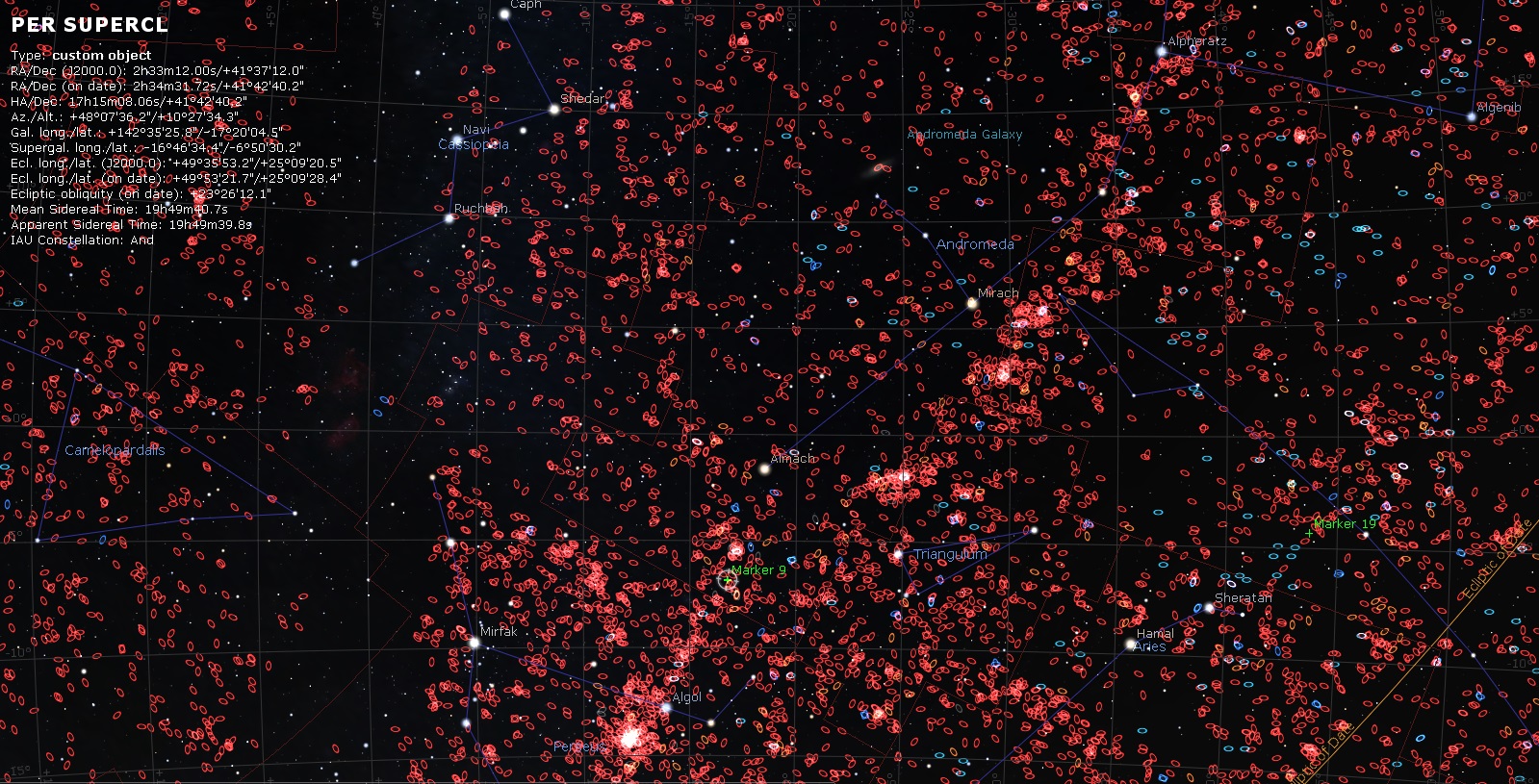
SUPERGALACTIC COORDINATES
MARKER 9: SCL-40 - PERSEUS SUPERCLUSTER
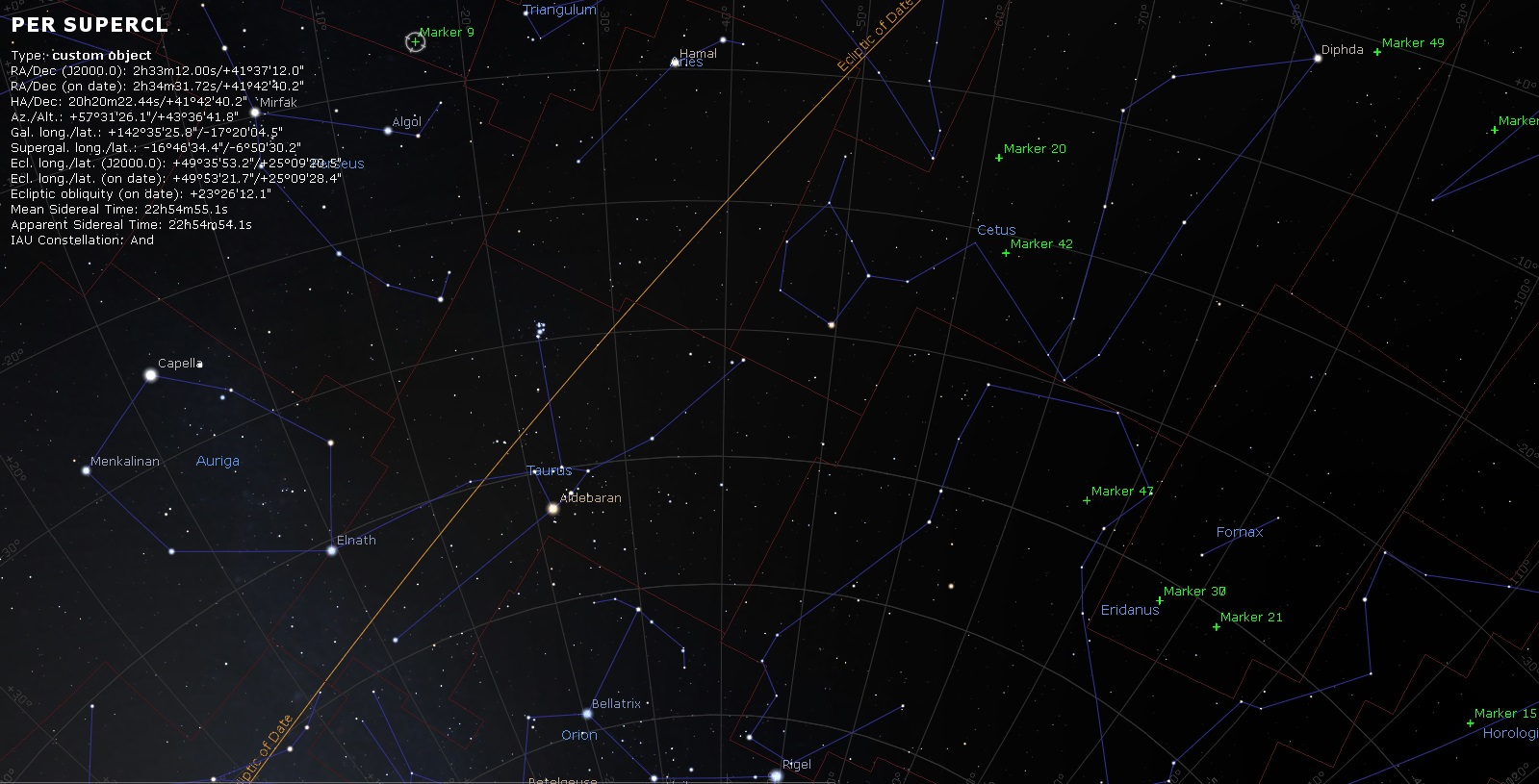
SUPERGALACTIC COORDINATES
MARKER 9: SCL-40 - PERSEUS SUPERCLUSTER

SUPERGALACTIC COORDINATES
MARKER 9: SCL-40 - PERSEUS SUPERCLUSTER
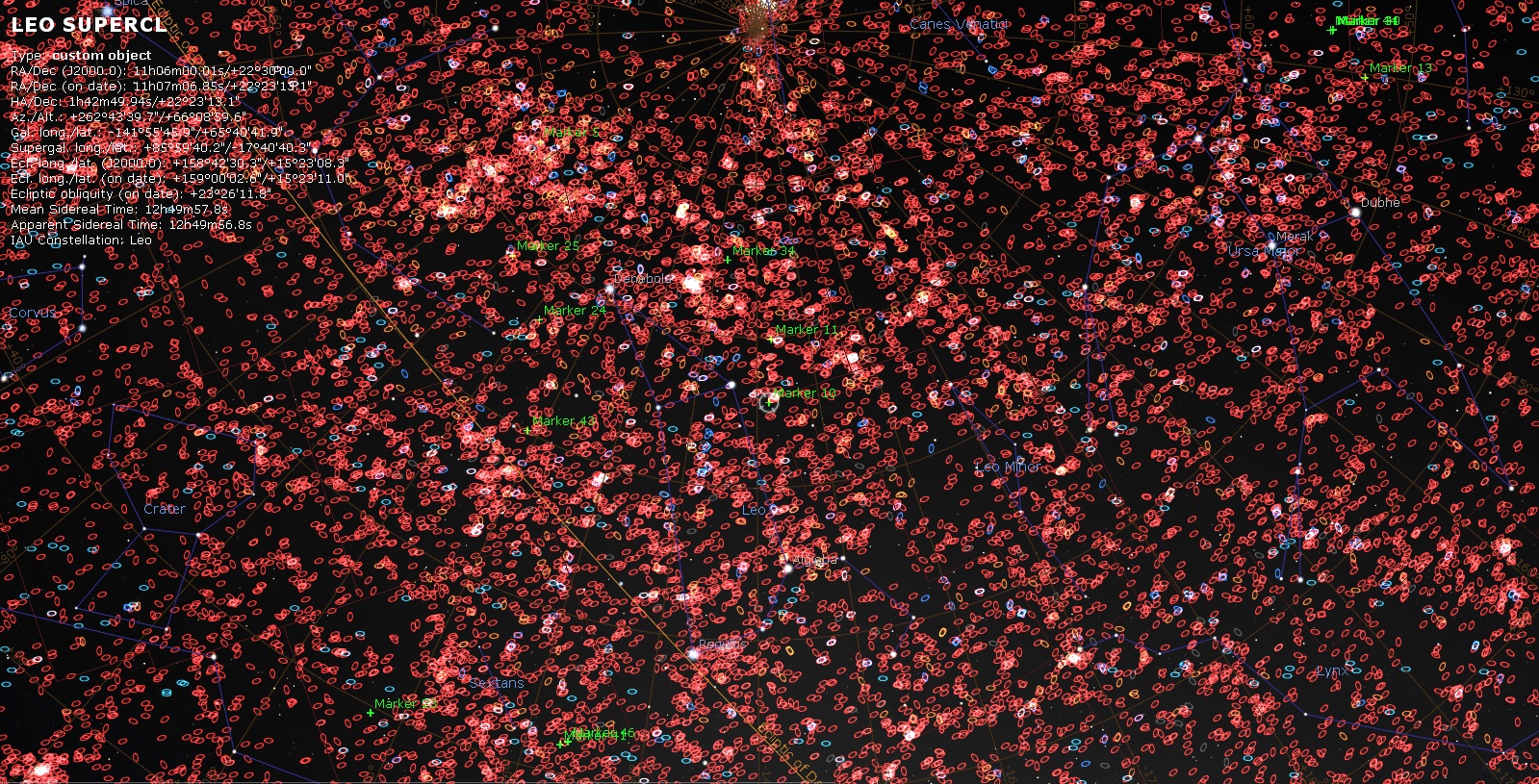
MARKER 10: SCL-93 - LEO SUPERCLUSTER
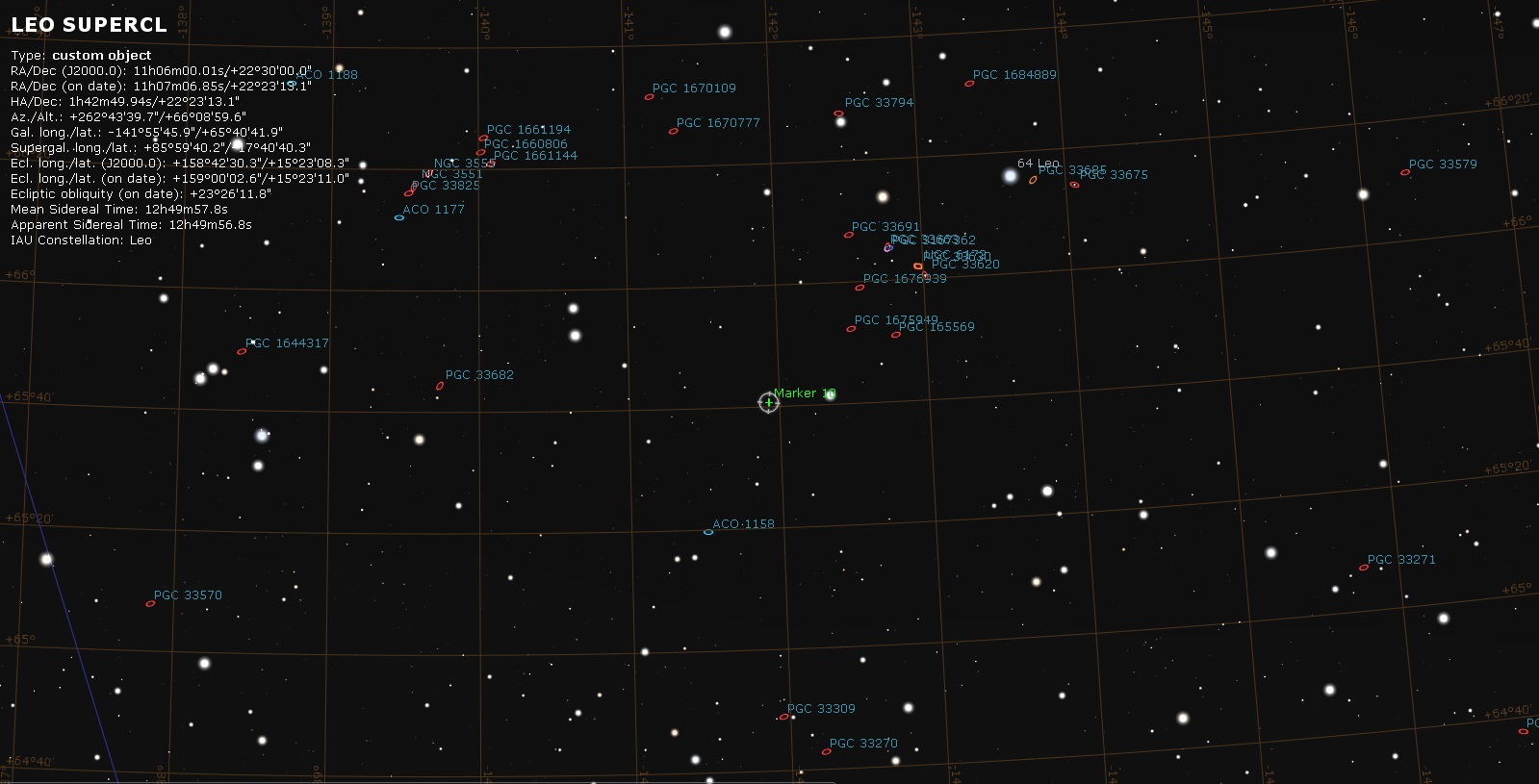
MARKER 10: SCL-93 - LEO SUPERCLUSTER
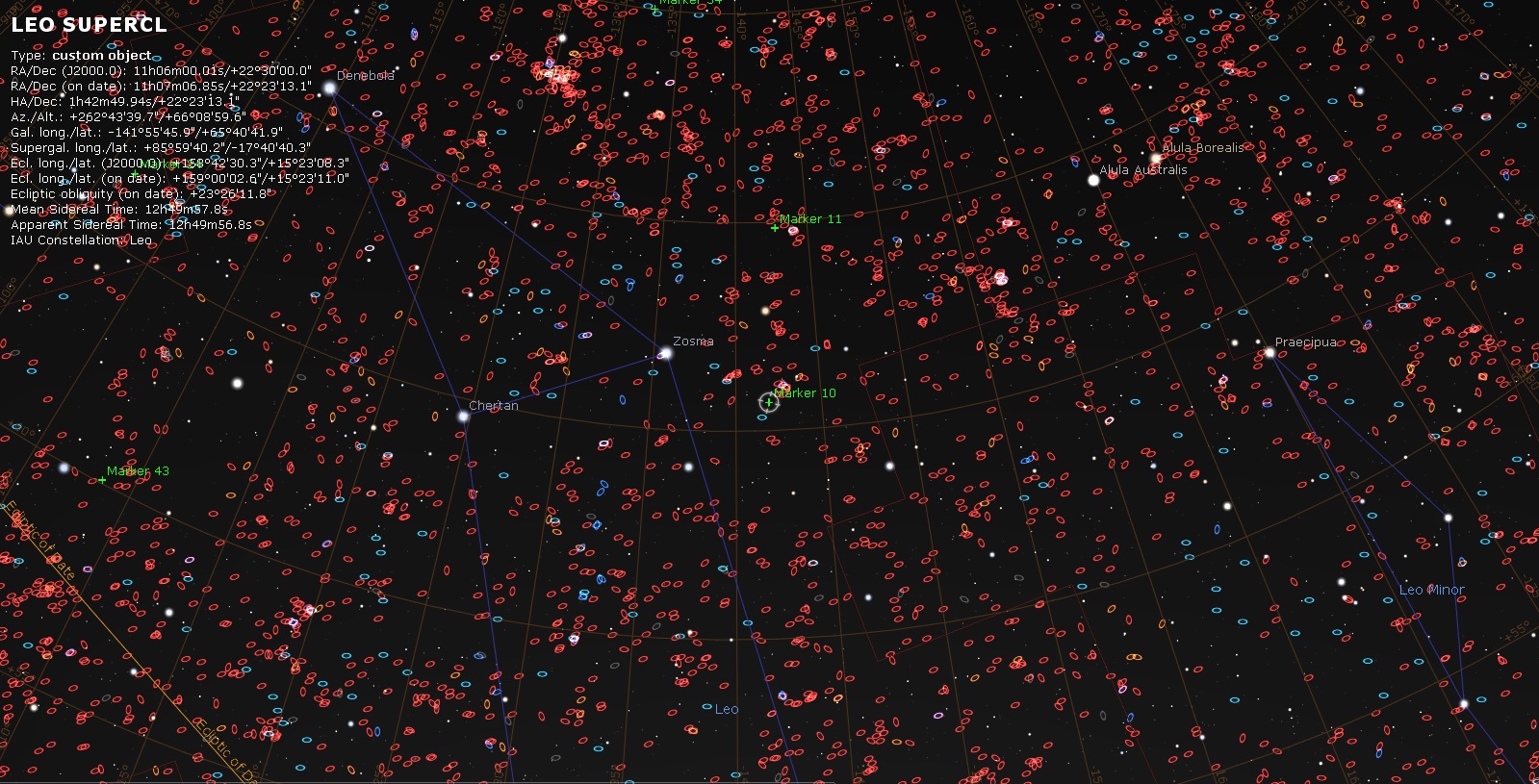
MARKER 10: SCL-93 - LEO SUPERCLUSTER
Leo Supercluster
The Leo Supercluster is a supercluster in the Northern Celestial Hemisphere that stretches across the constellations Ursa Major and Leo.
It covers an area approximately 130 megaparsecs long by 60 megaparsecs wide.
Constellation(s): Ursa Major, Leo
Brightest Member: Abell 1185
Major Axis: 130 megaparsecs
Minor Axis: 60 megaparsecs
Redshift: 0.037
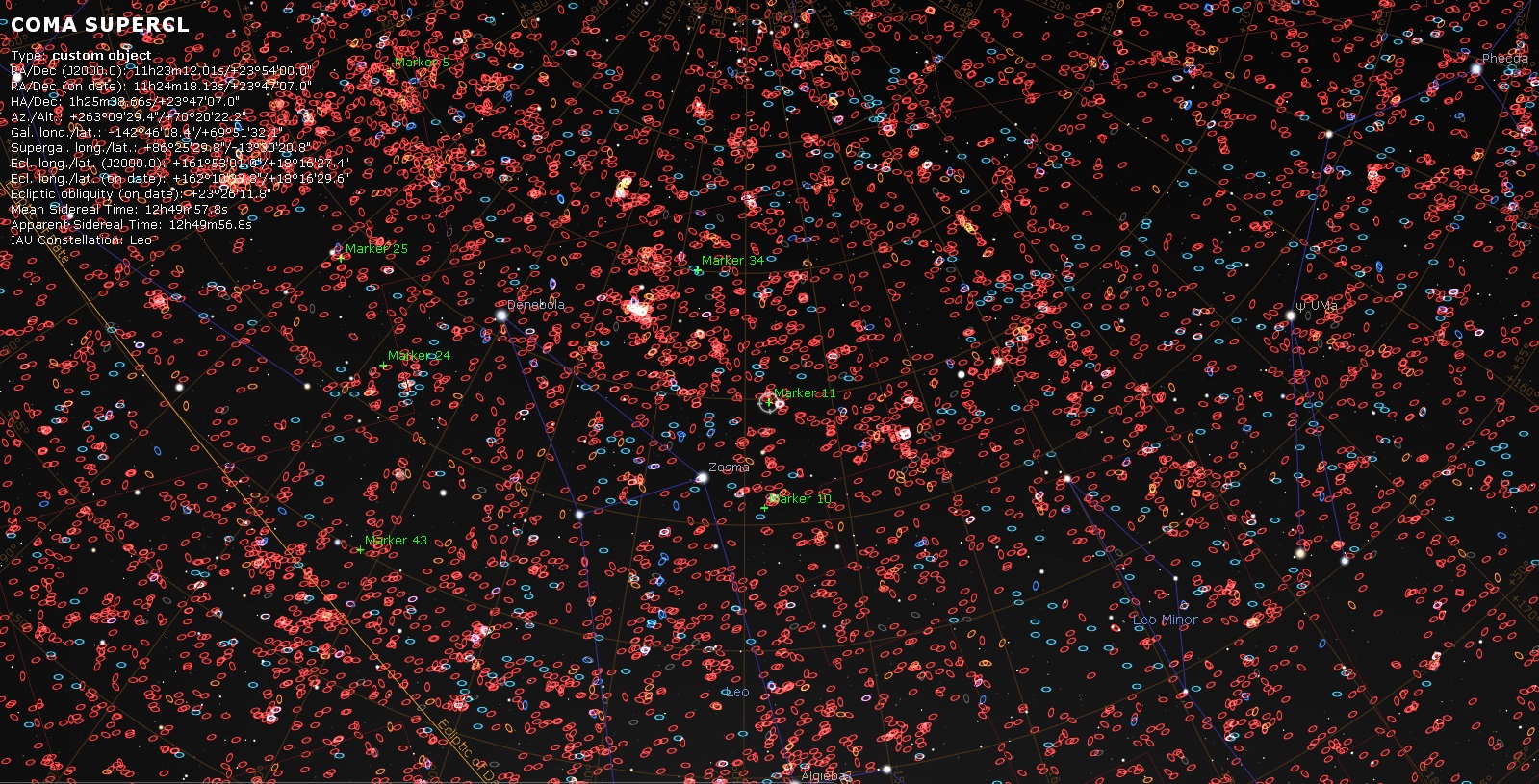
MARKER 11: SCL-117 - COMA SUPERCLUSTER
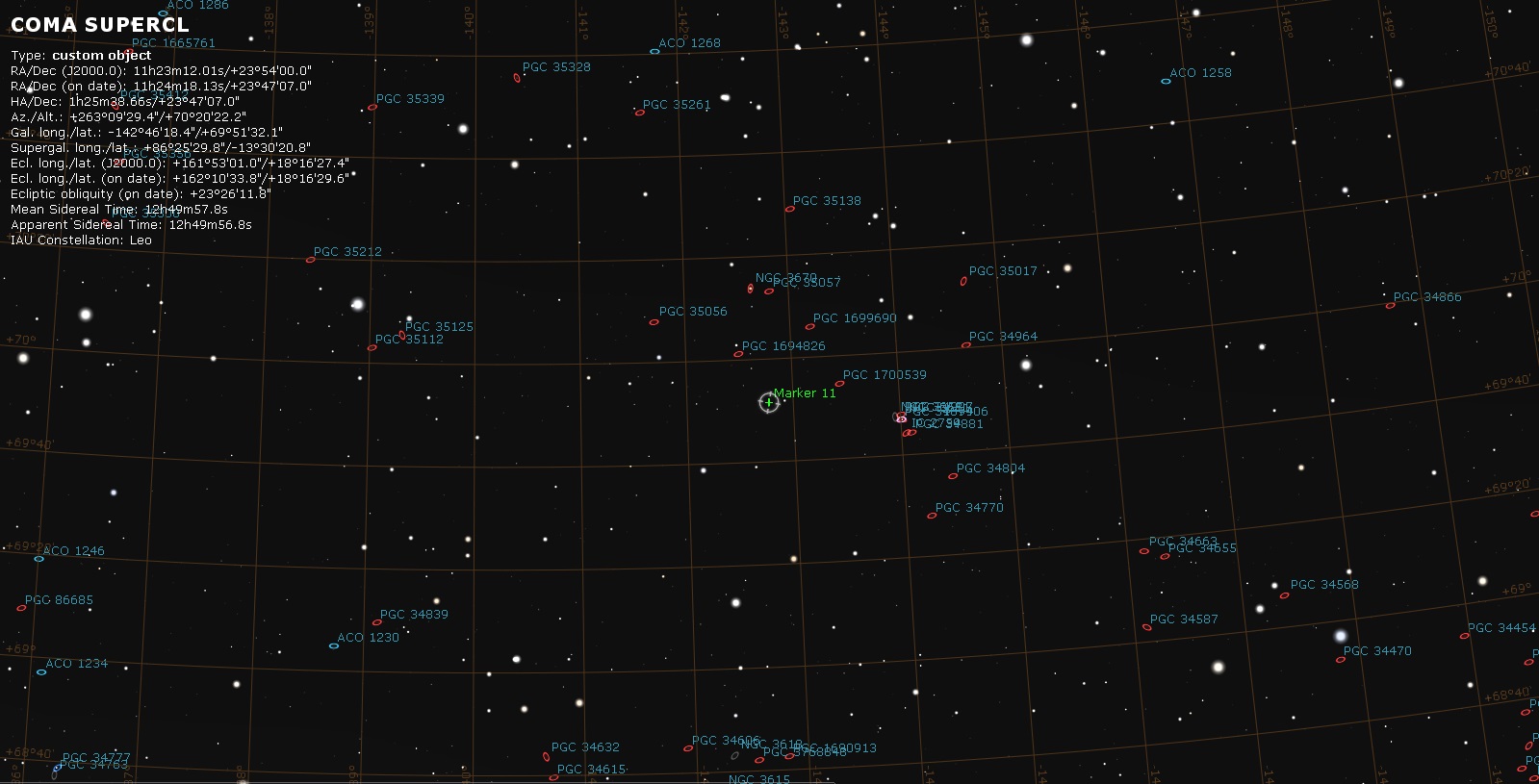
MARKER 11: SCL-117 - COMA SUPERCLUSTER
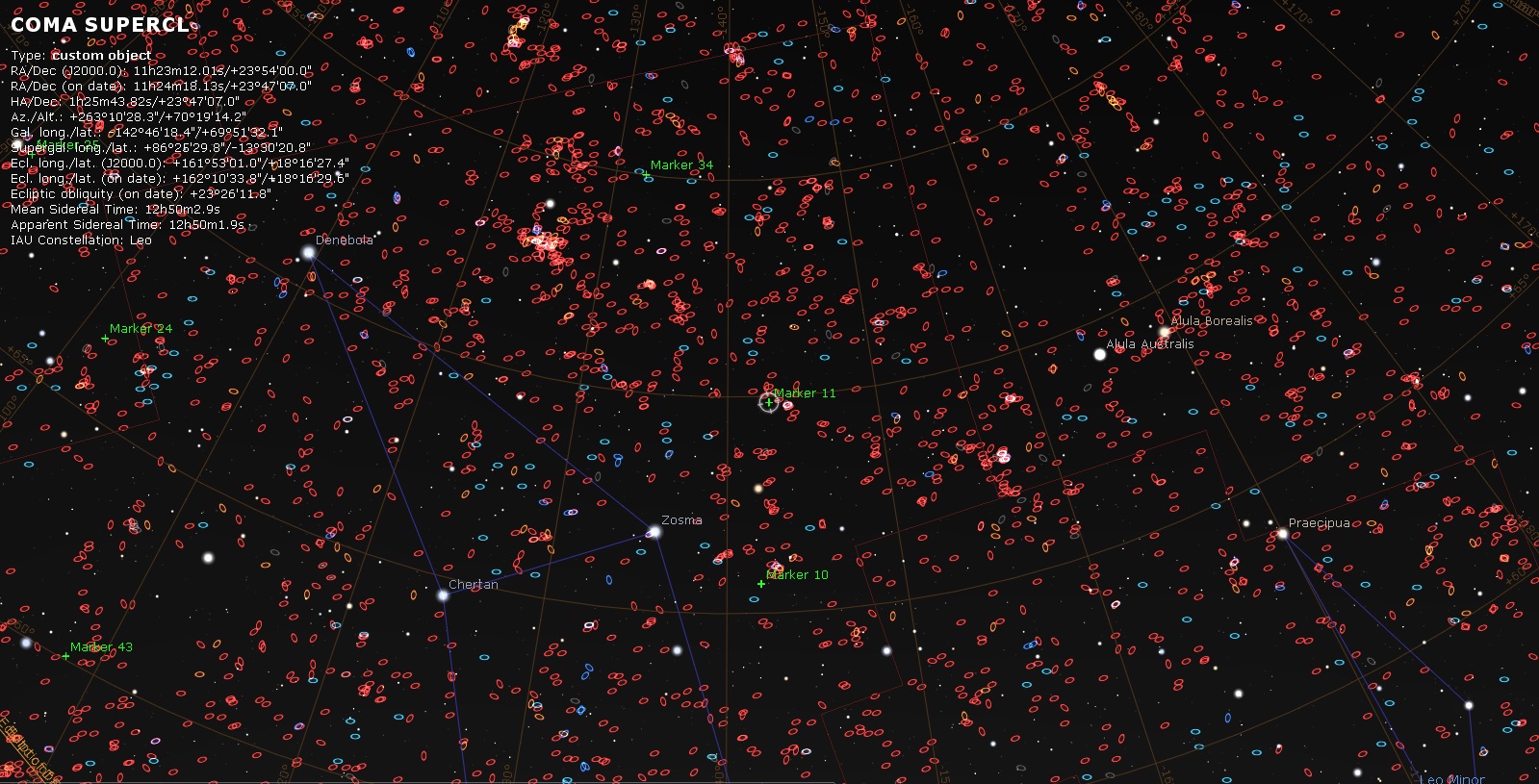
MARKER 11: SCL-117 - COMA SUPERCLUSTER
Coma Supercluster
The Coma Supercluster (SCl 117) is a nearby supercluster of galaxies comprising the Coma Cluster (Abell 1656) and the Leo Cluster (Abell 1367).
Constellation(s): Coma Berenices
Major Axis: 6 Mpc (20 Mly)
Minor Axis: 6 Mpc (20 Mly)
Distance: 92 Mpc (300 Mly)
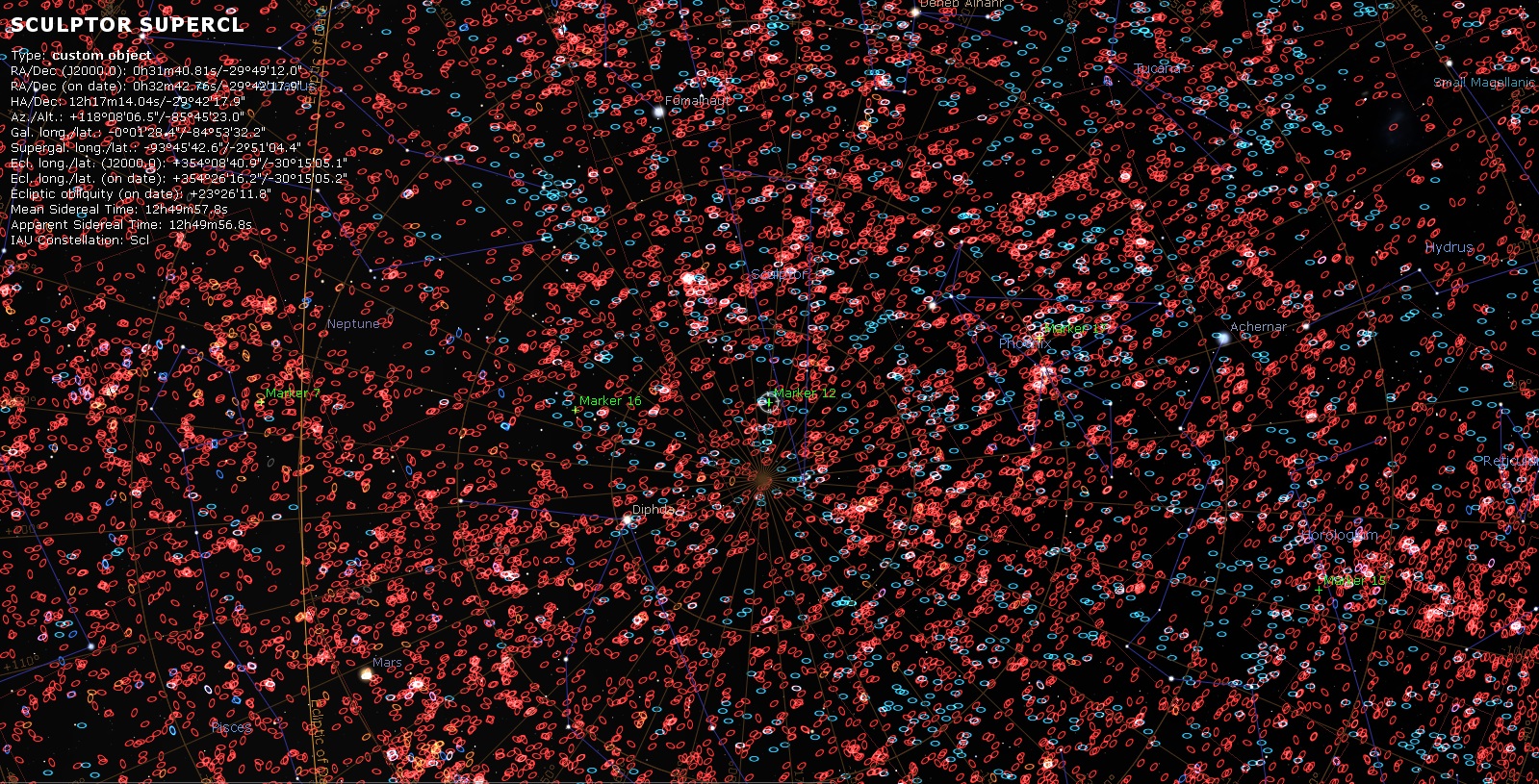
MARKER 12: SCL-09 - SCULPTOR SUPERCLUSTER
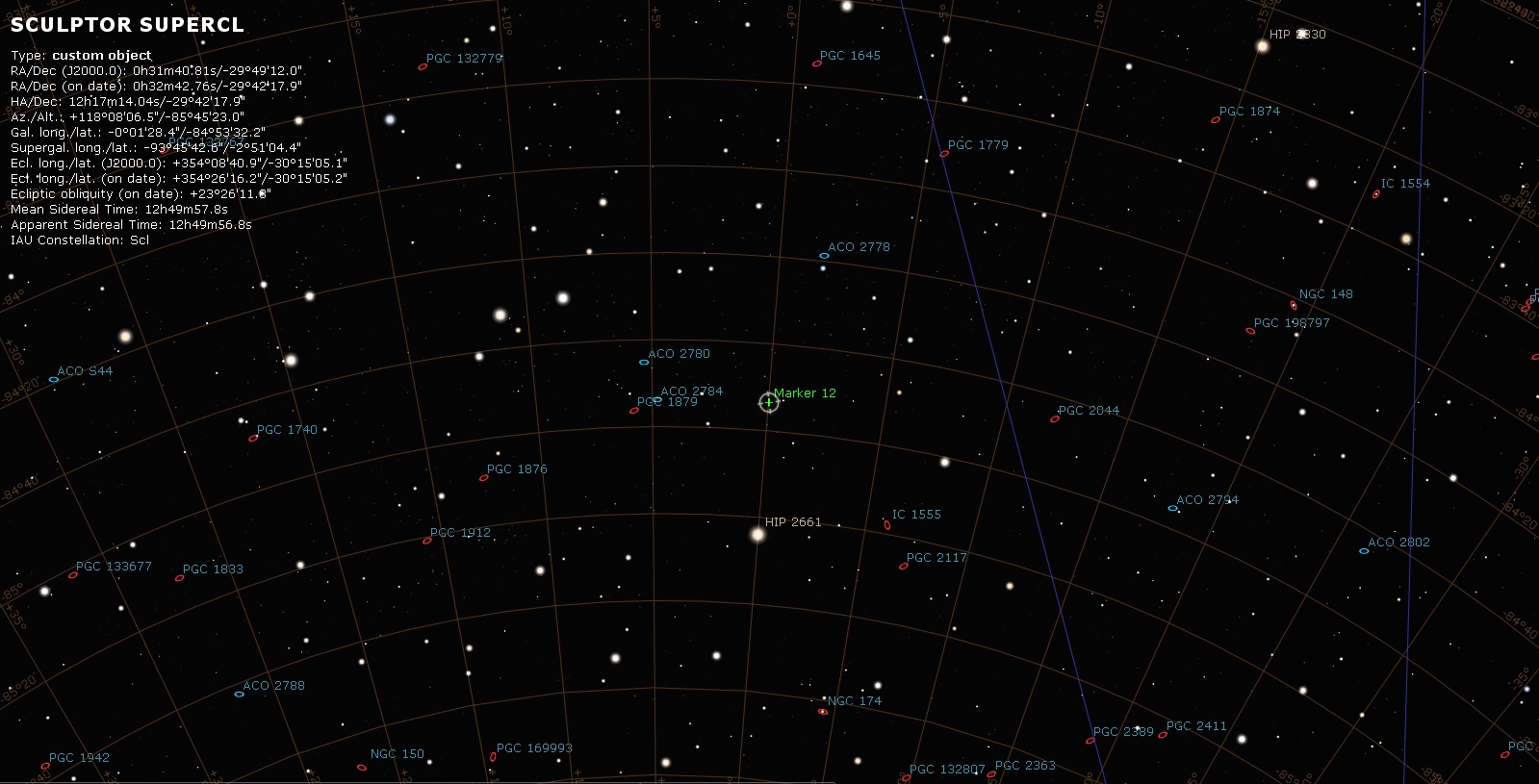
MARKER 12: SCL-09 - SCULPTOR SUPERCLUSTER
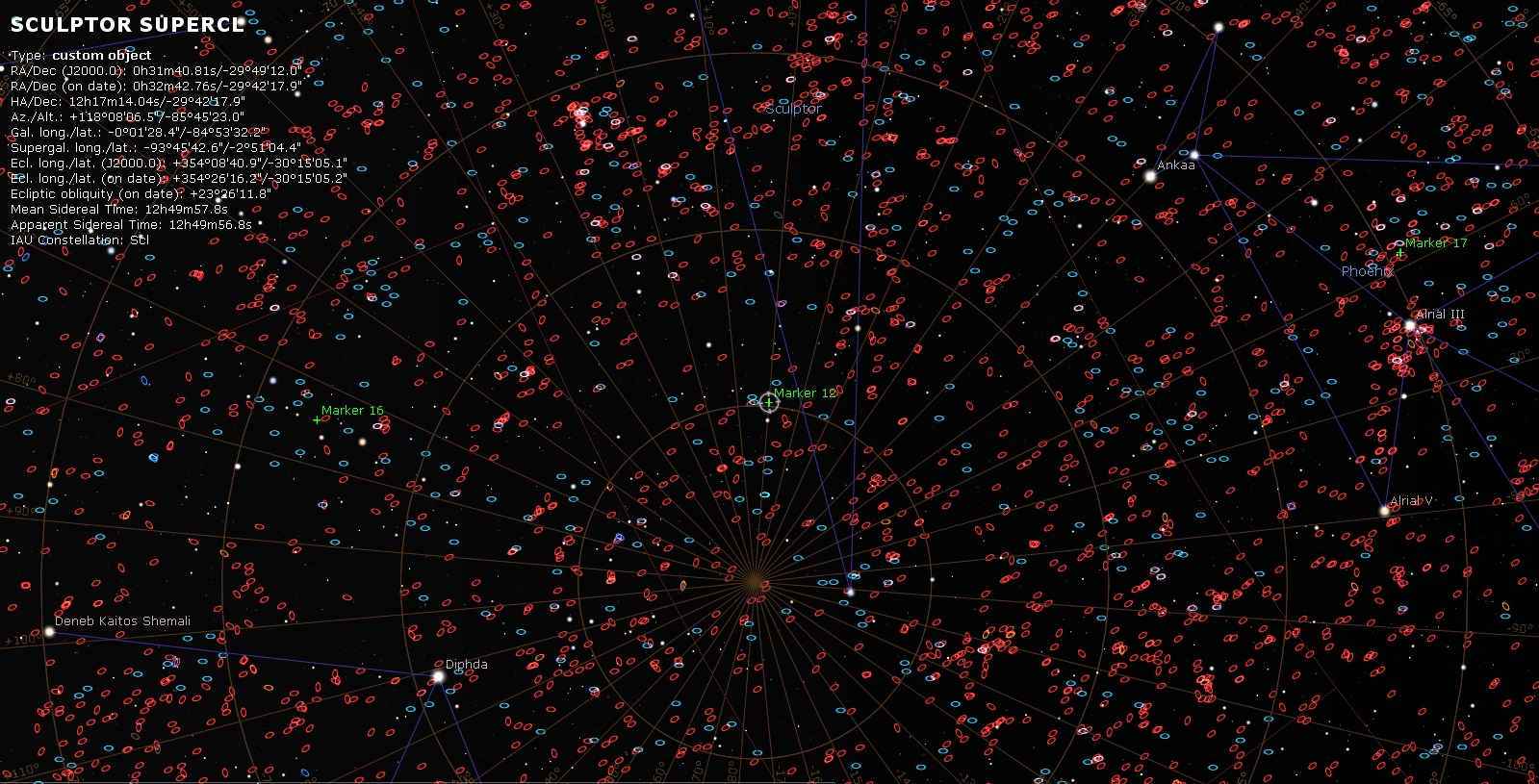
MARKER 12: SCL-09 - SCULPTOR SUPERCLUSTER
Sculptor Wall
The Sculptor Wall is a superstructure of galaxies ("wall of galaxies") relatively near to the Milky Way Galaxy
(redshift of approximately z=0.03), also known as the Sculptor superclusters.
The superstructure is also called "Southern Great Wall", "Great Southern Wall", "Southern Wall.
DISTANT LARGE GALACTIC STRUCTURES
SUPERCLUSTERS
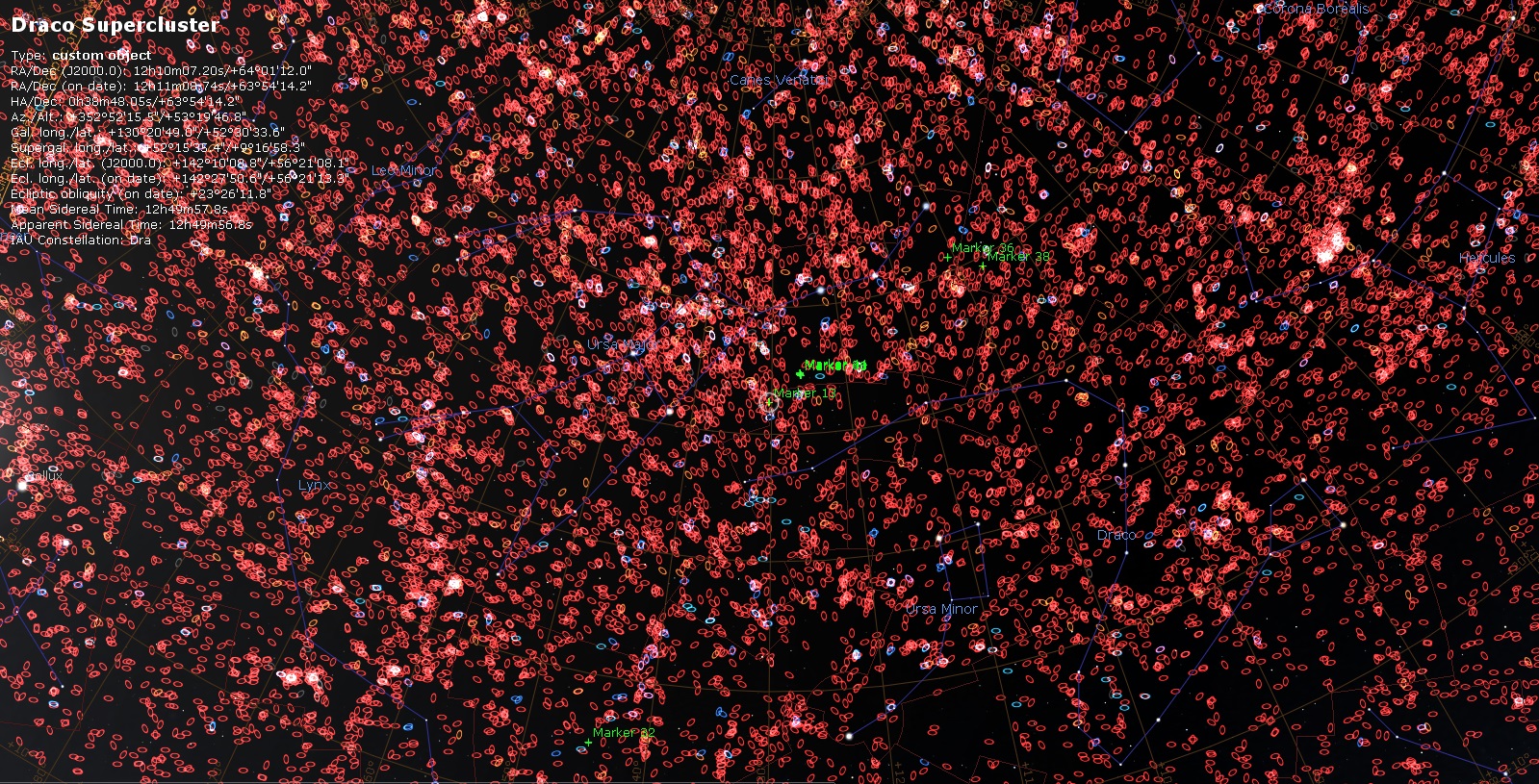
MARKER 13: SCL-114 - DRACO SUPERCLUSTER
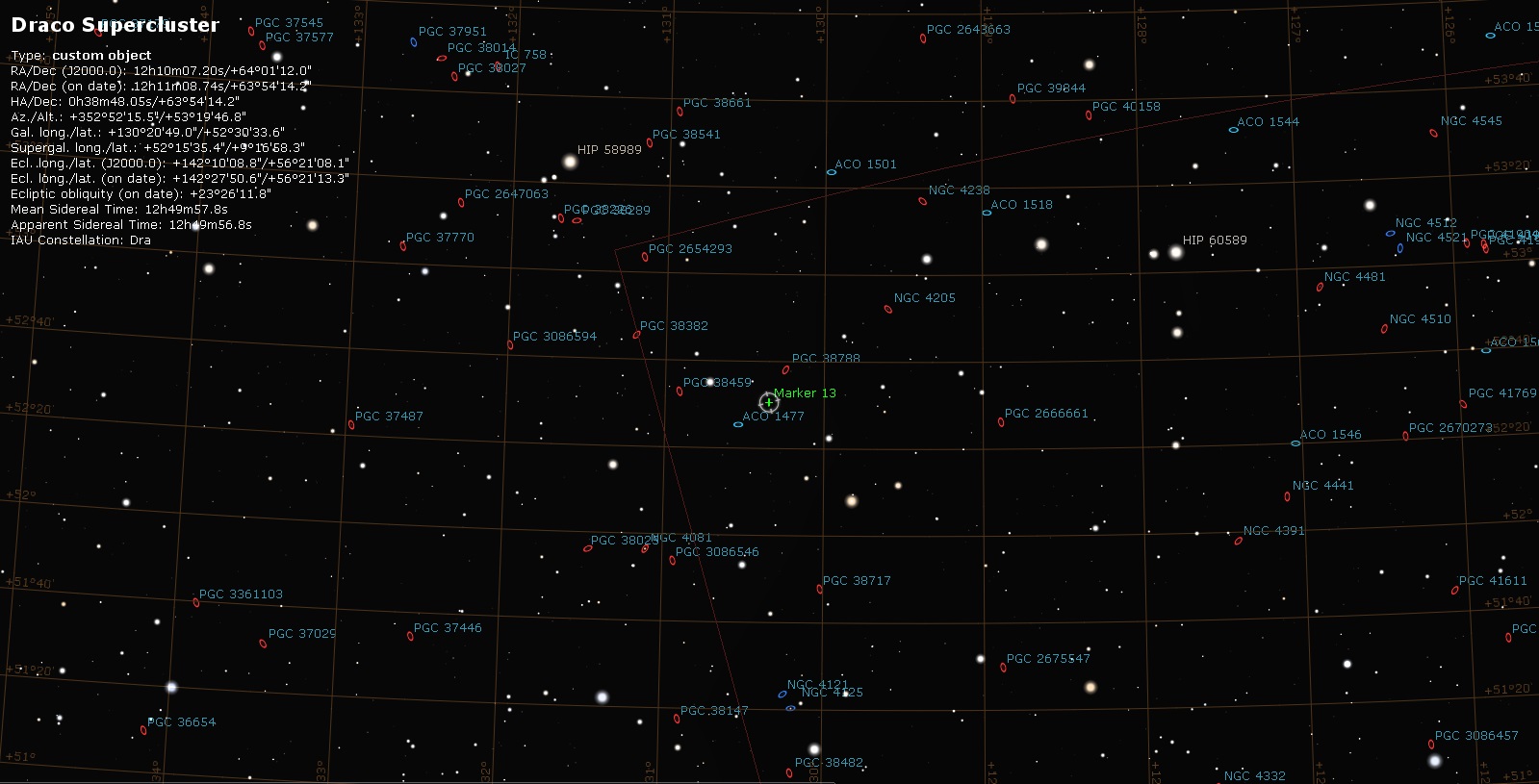
MARKER 13: SCL-114 - DRACO SUPERCLUSTER
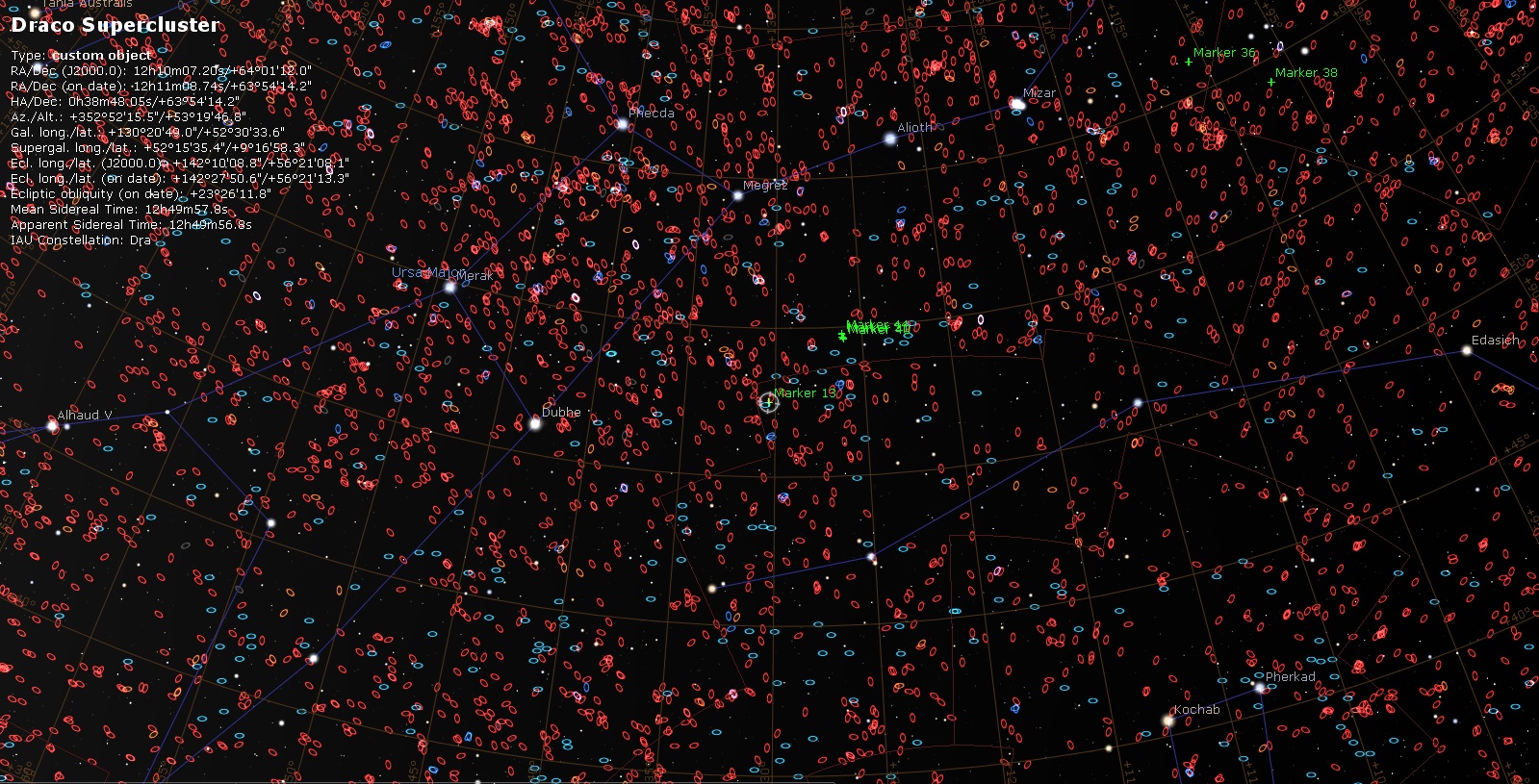
MARKER 13: SCL-114 - DRACO SUPERCLUSTER
Draco Supercluster
Draco Supercluster (SCL 114) is a galaxy supercluster in the constellation Draco. The estimated size of the supercluster reaches 410 million light years and a mass of 1017 M,
making it one of the largest and most massive superclusters known in the observable universe.
Constellation(s): Draco
Right Ascension: 12h 10m 04.4s
Declination: +64° 01' 19?
Distance: 2 Gly (co-moving)
Binding Mass: ~1017 M?
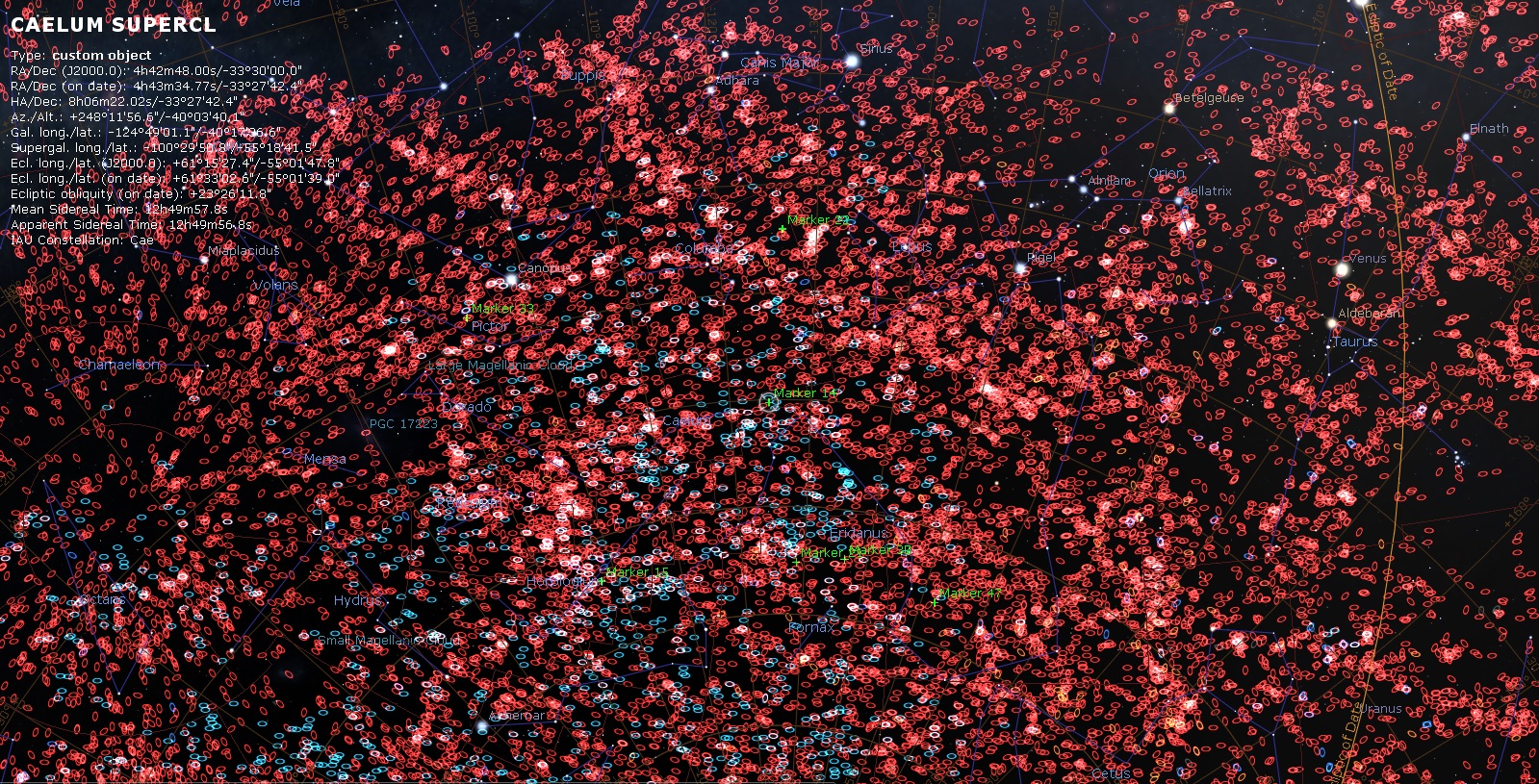
MARKER 14: SCL-59 - THE CAELUM SUPERCLUSTER
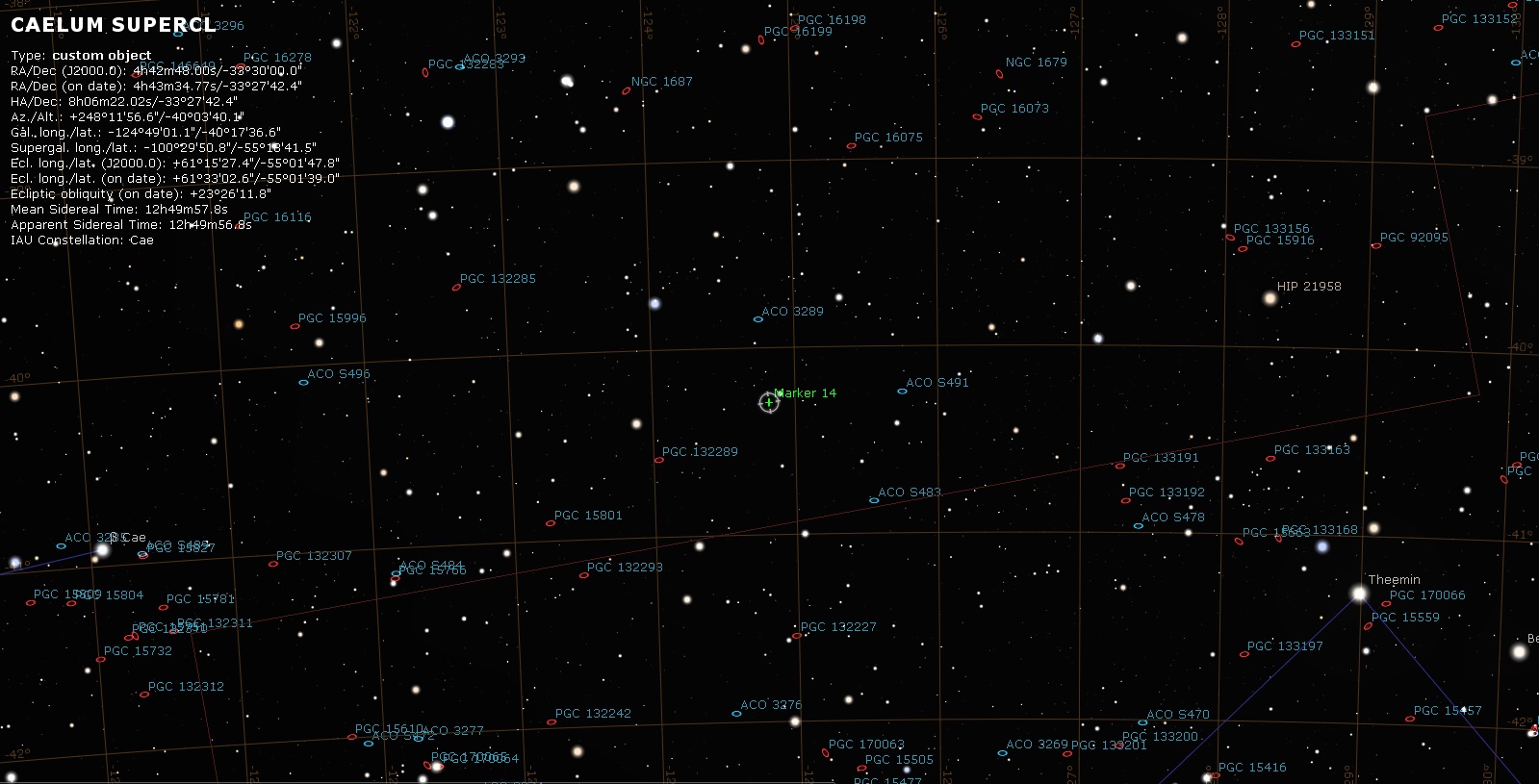
MARKER 14: SCL-59 - THE CAELUM SUPERCLUSTER
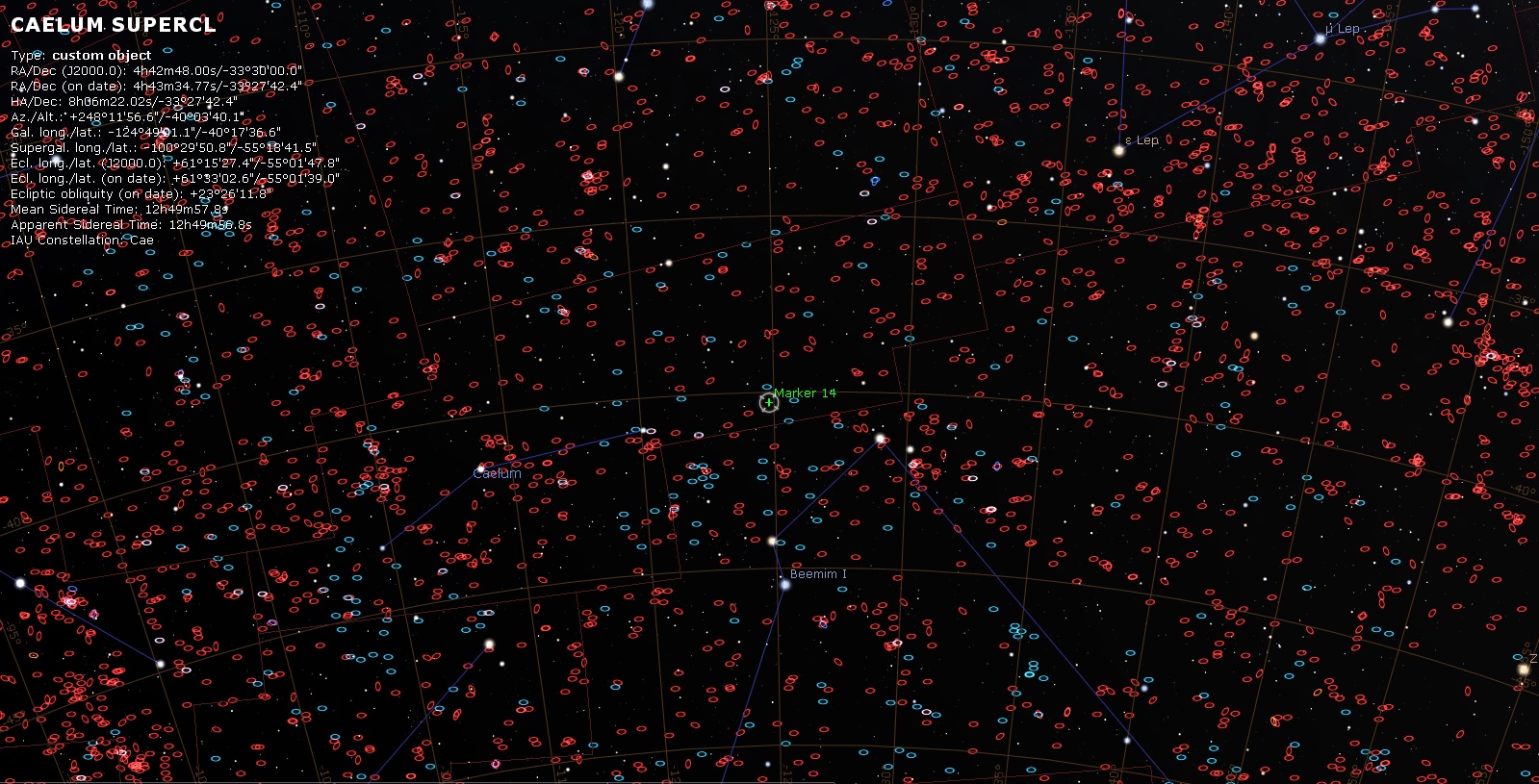
MARKER 14: SCL-59 - THE CAELUM SUPERCLUSTER
Caelum Supercluster
The Caelum Supercluster, also known as SCl 59, may be a massive supercluster; spanning 910 million light-years,
it is perhaps the largest galaxy supercluster in the universe. It has a mass of 2×1017 solar masses,
1.7 times the mass of Laniakea Supercluster and of Horologium Supercluster.
Constellation(s): Caelum
Right Ascension: 04h 43m
Declination: -33° 30'
Major Axis: 280 Mpc (913 Mly)
Distance: 569 Mpc (2 Gly)(co-moving)

MARKER 15: HOROLOGIUM-RETICULUM SUPERCLUSTER
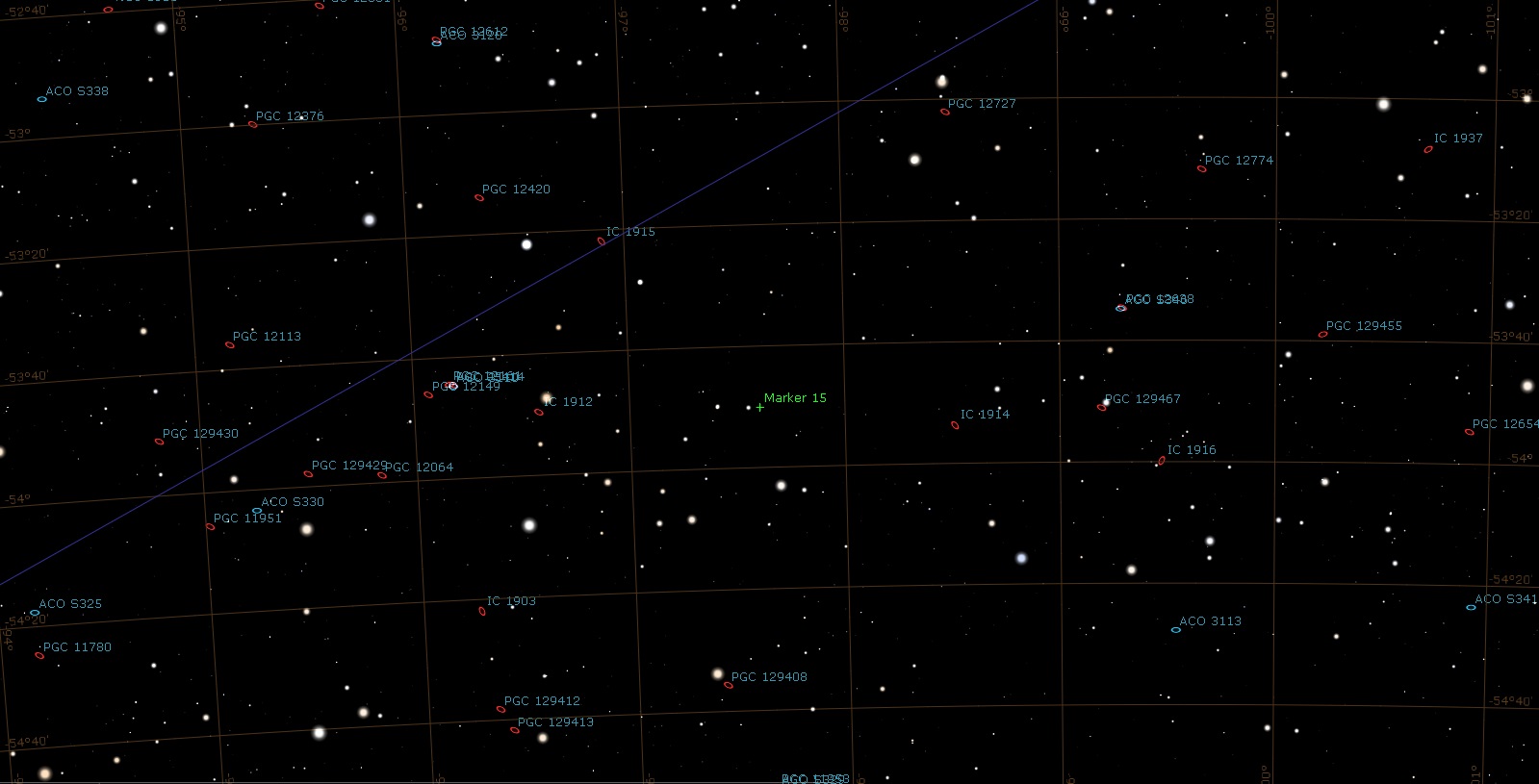
MARKER 15: HOROLOGIUM-RETICULUM SUPERCLUSTER
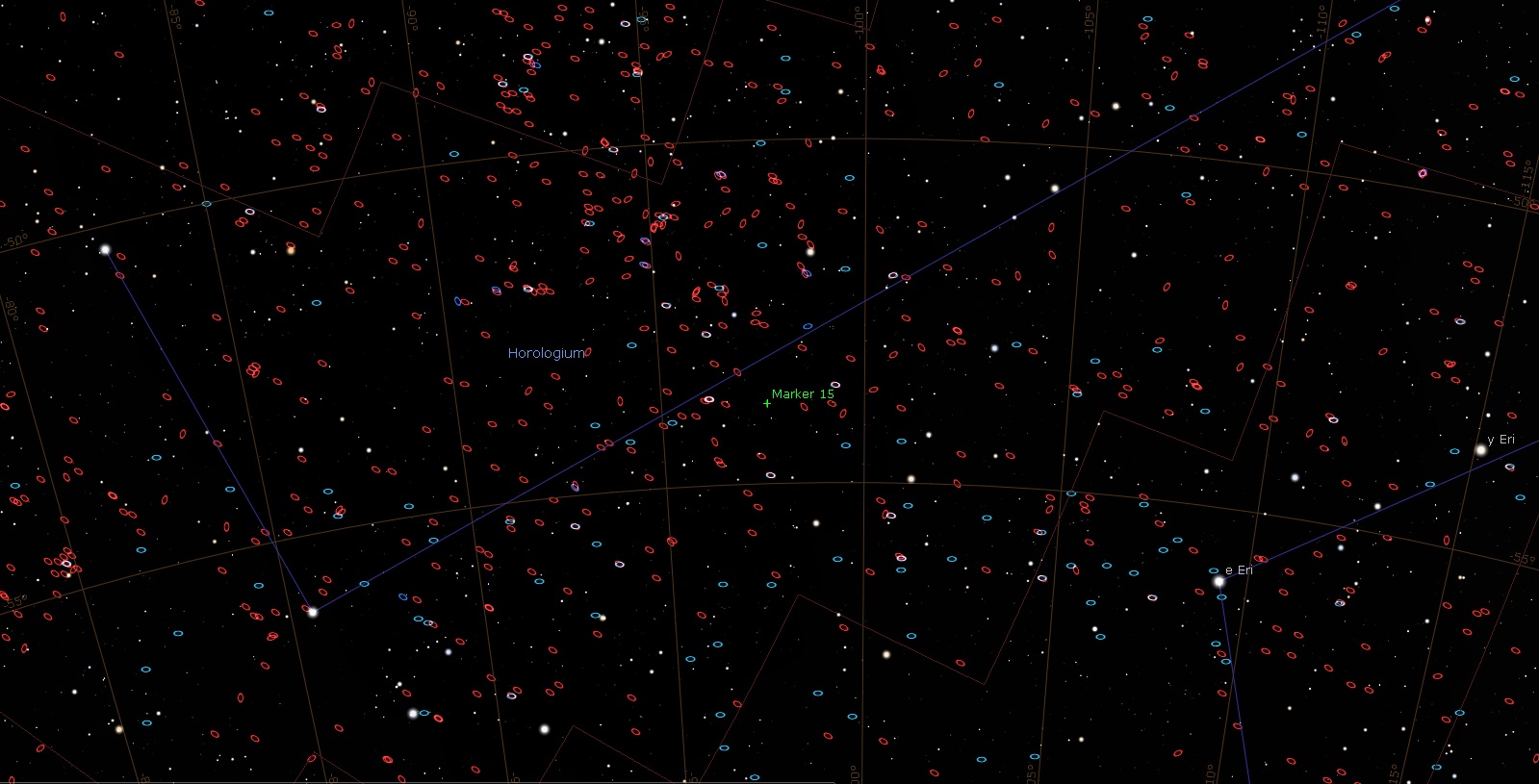
MARKER 15: HOROLOGIUM-RETICULUM SUPERCLUSTER
Horologium-Reticulum Supercluster
The Horologium-Reticulum Supercluster, is a massive supercluster spanning around 550 million light-years.
Constellation(s): Horologium and Eridanus
Right Ascension: 03h 19m
Declination: -50° 02'
Major Axis: 169 Mpc (551 Mly)
Distance: 291.4 Mpc (950 Mly)(co-moving)
Binding mass ~1017 M
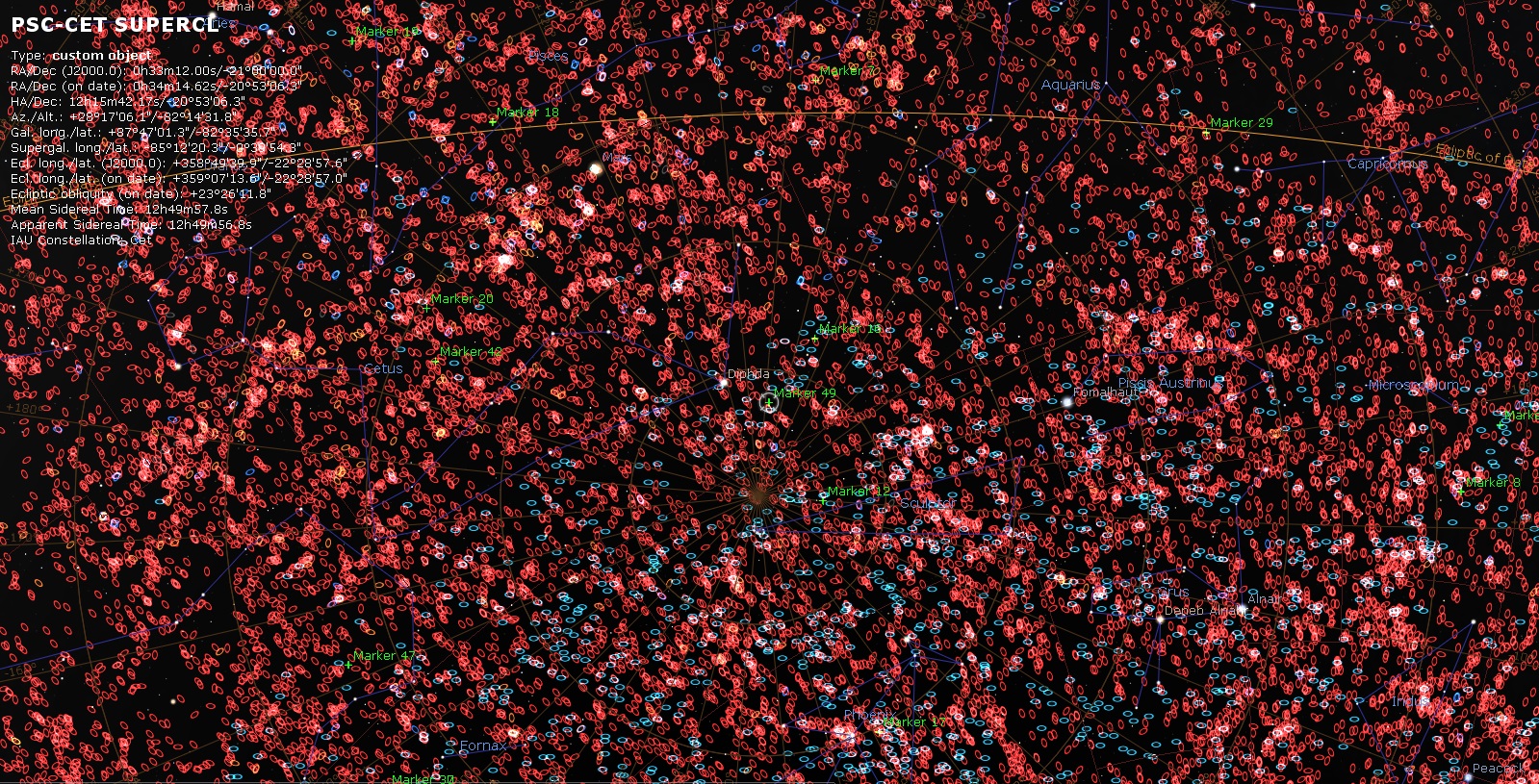
MARKER 49: SCL-10 - PISCES-CETUS SUPERCLUSTER
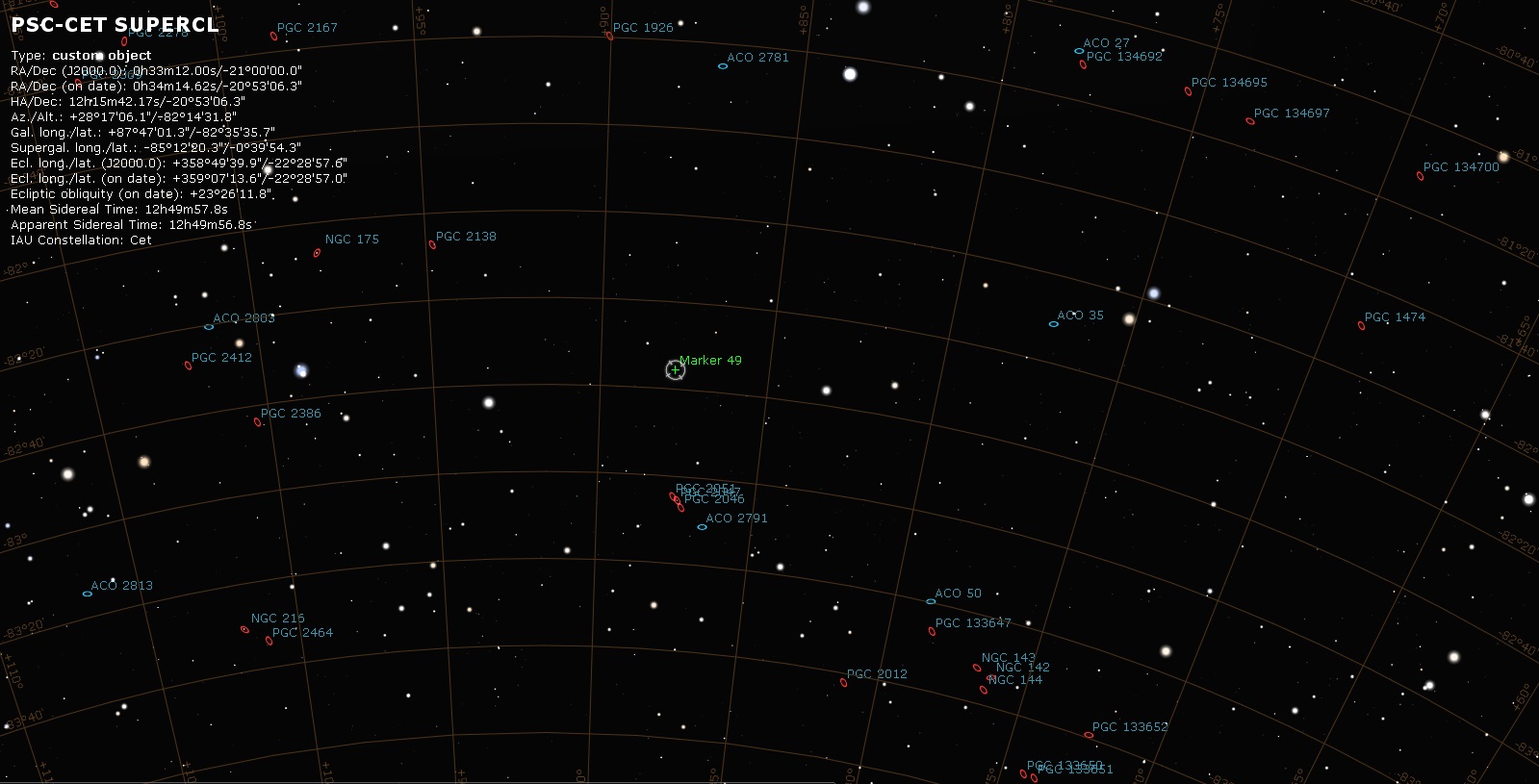
MARKER 49: SCL-10 - PISCES-CETUS SUPERCLUSTER
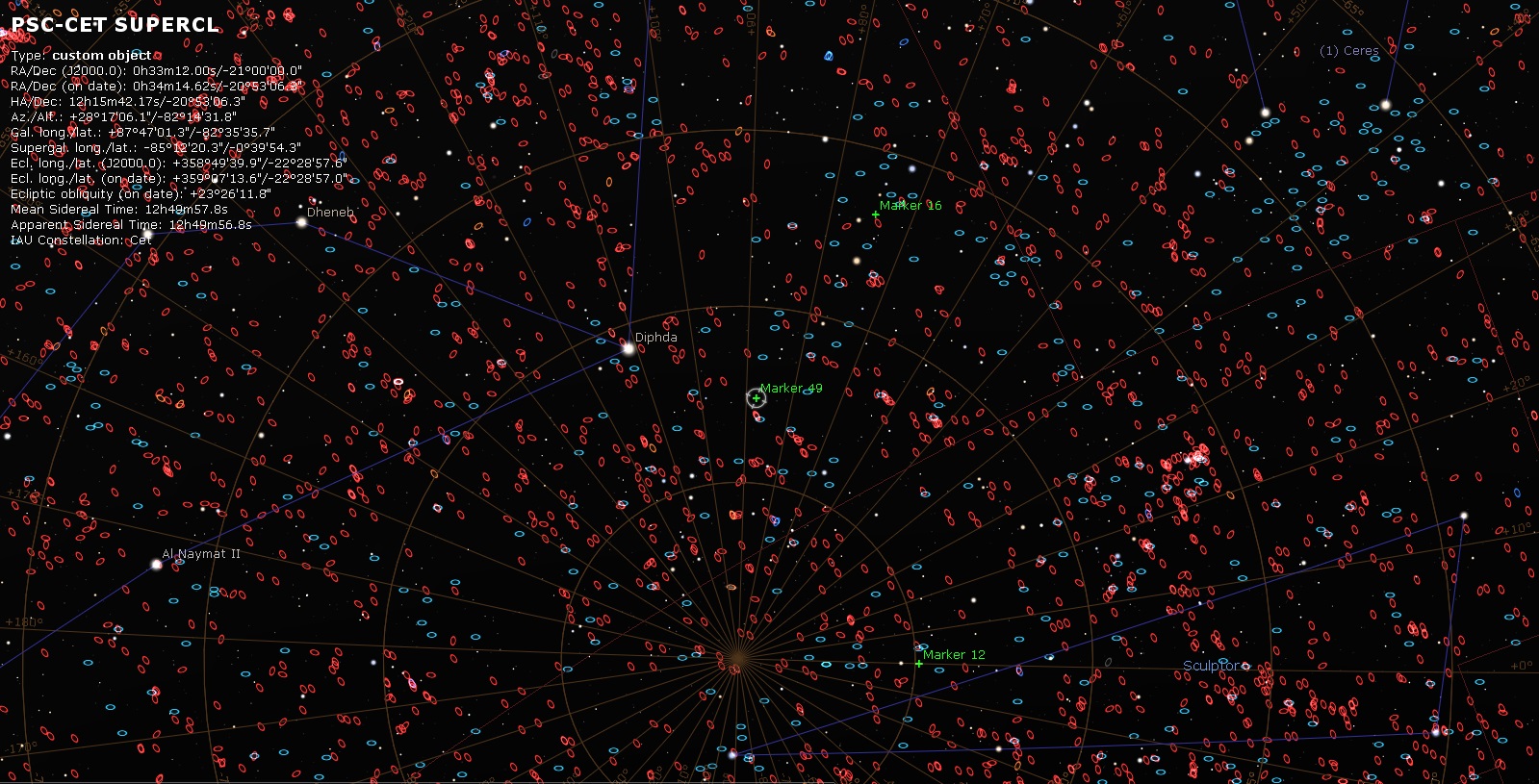
MARKER 49: SCL-10 - PISCES-CETUS SUPERCLUSTER
Pisces–Cetus Supercluster Complex
The Pisces–Cetus Supercluster Complex is a galaxy filament.
It includes the Virgo Supercluster which in turn contains the Local Group, the galaxy cluster that includes the Milky Way.
This filament is adjacent to the Perseus–Pegasus Filament.
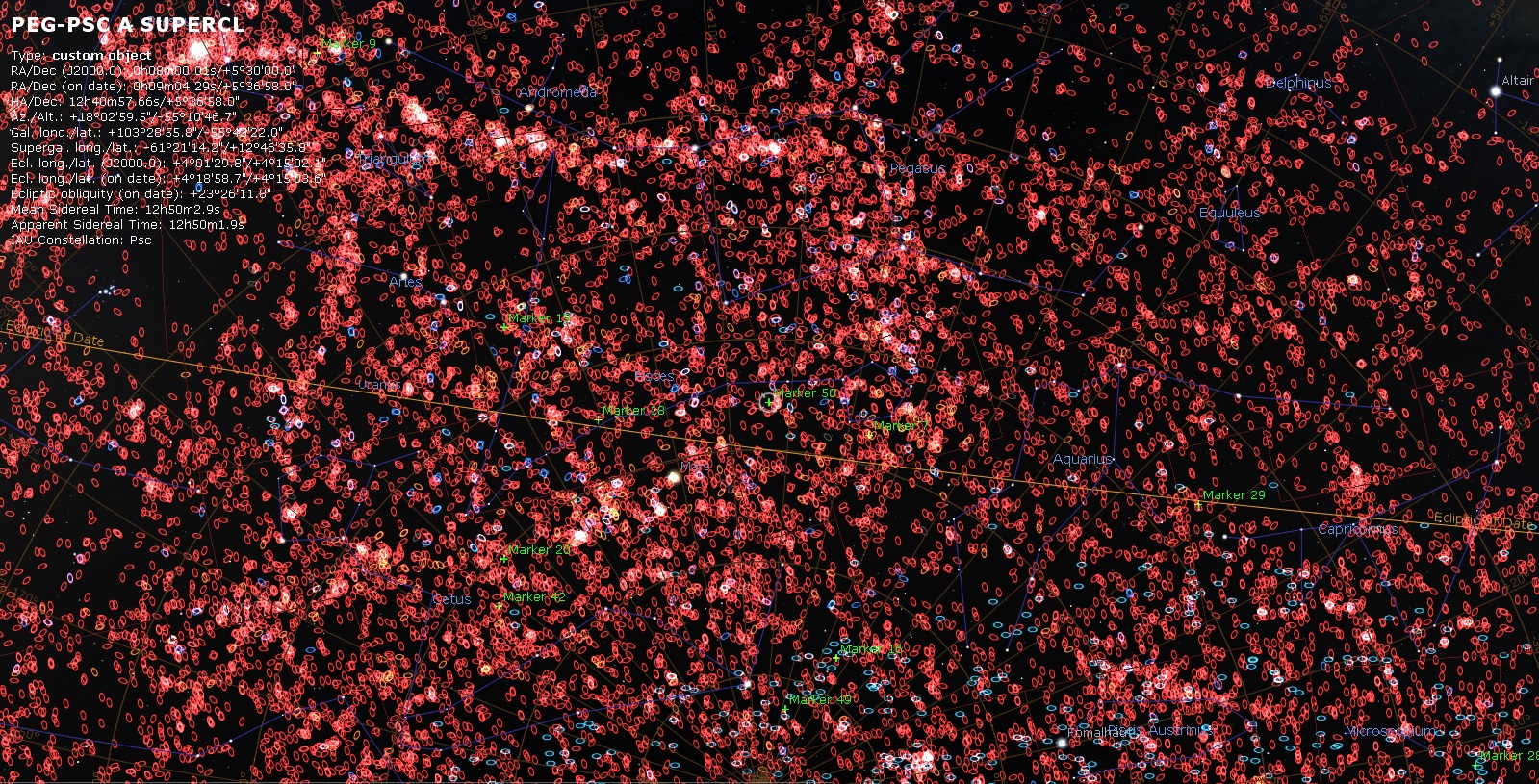
MARKER 50: SCL-03 - PERSEUS-PEGASUS SUPERCLUSTER
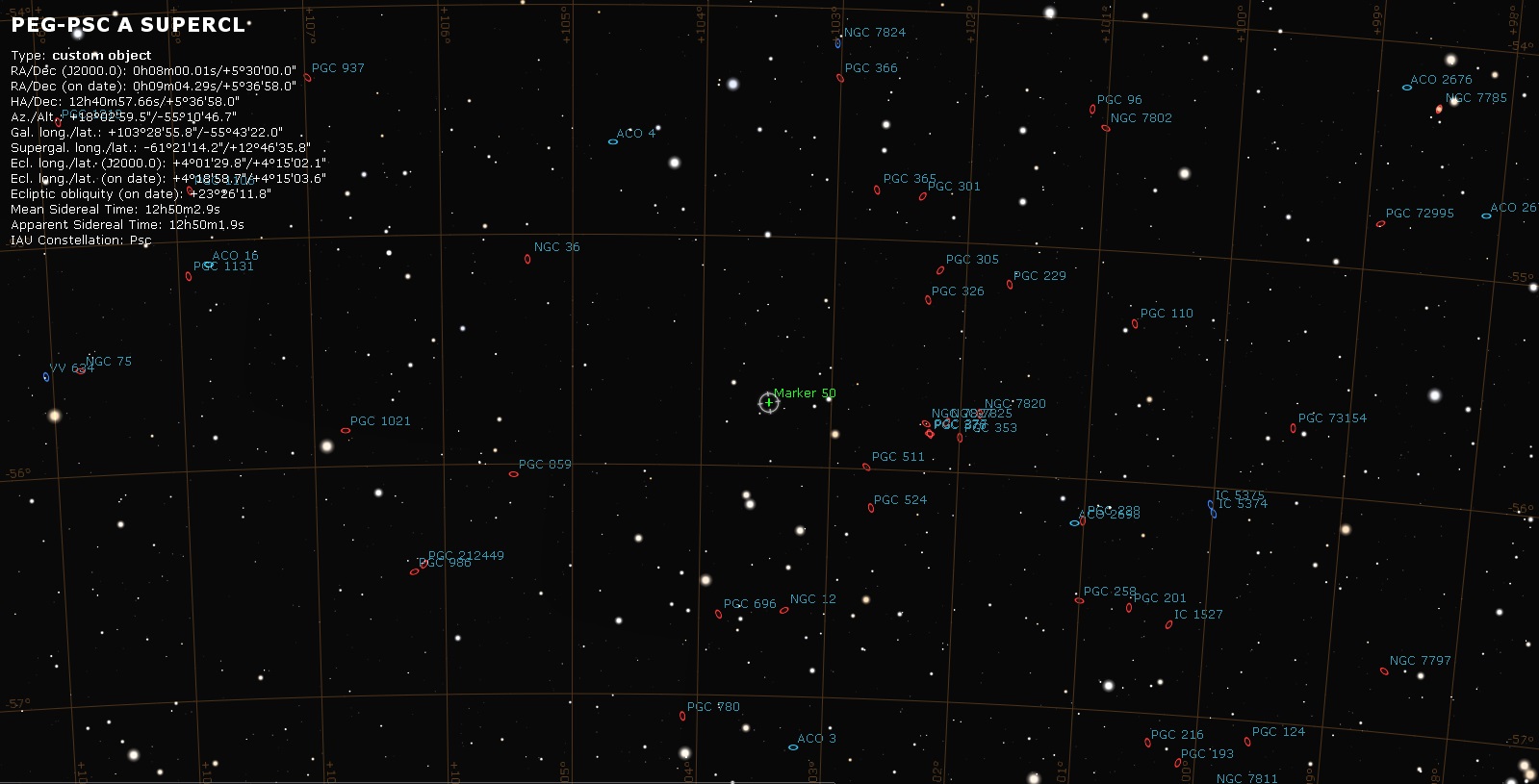
MARKER 50: SCL-03 - PERSEUS-PEGASUS SUPERCLUSTER
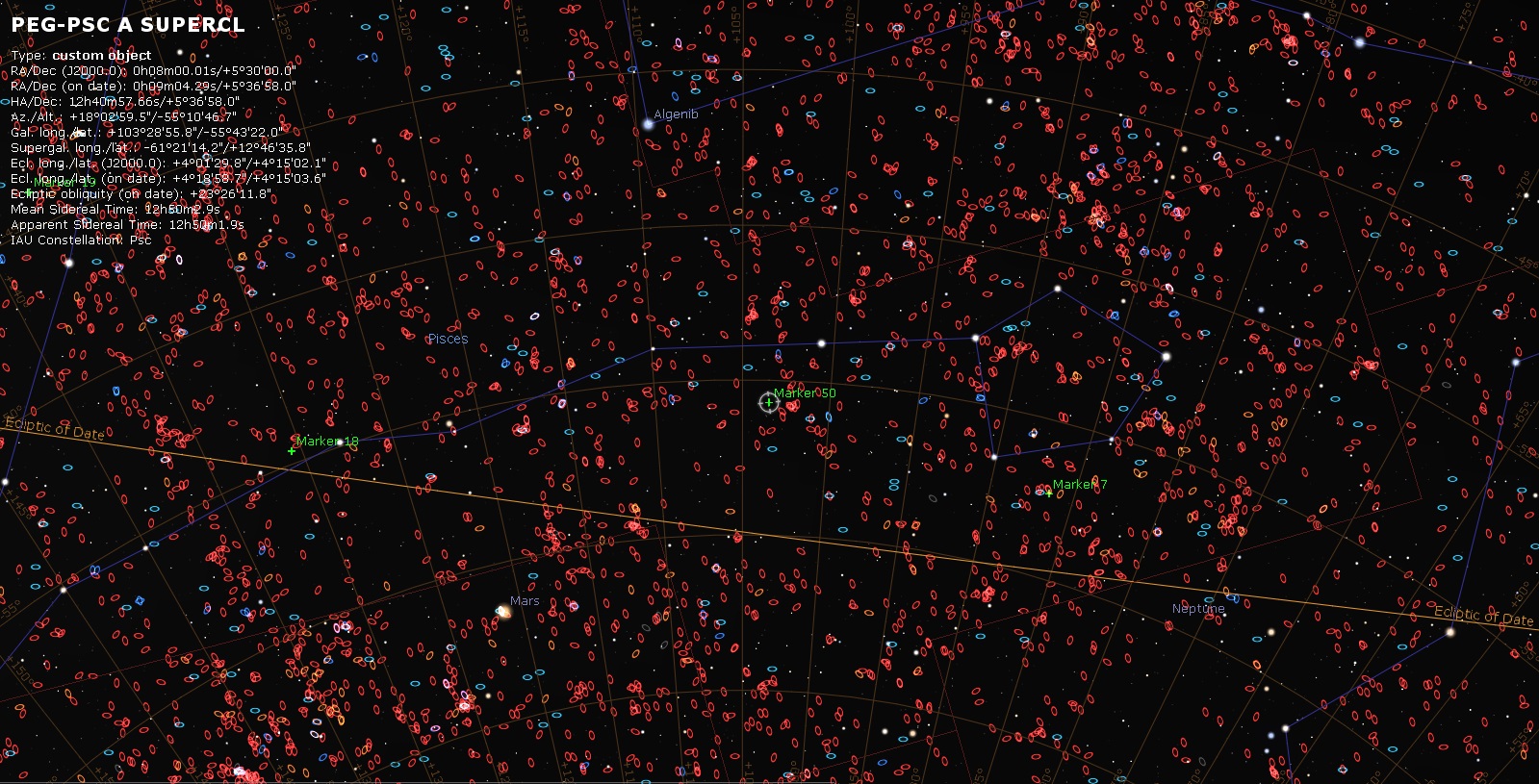
MARKER 50: SCL-03 - PERSEUS-PEGASUS SUPERCLUSTER
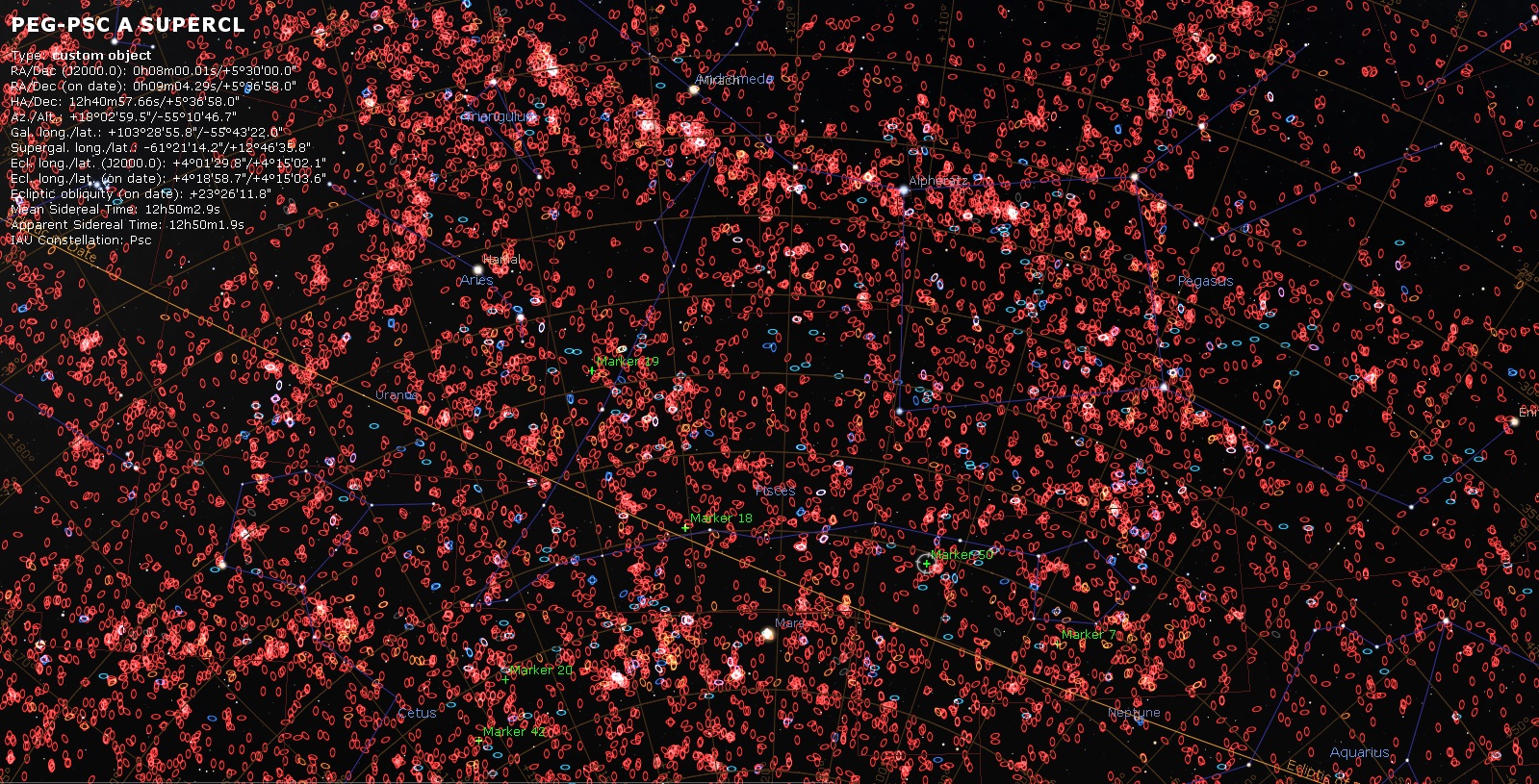
MARKER 50: SCL-03 - PERSEUS-PEGASUS SUPERCLUSTER
Perseus–Pegasus
Supercluster Filament
Perseus–Pegasus Filament is a galaxy filament containing the Perseus-Pisces Supercluster and stretching for roughly
a billion light years (or over 300/h Mpc). Currently, it is considered to be one of the largest known structures in the universe.
This filament is adjacent to the Pisces–Cetus Supercluster Complex.
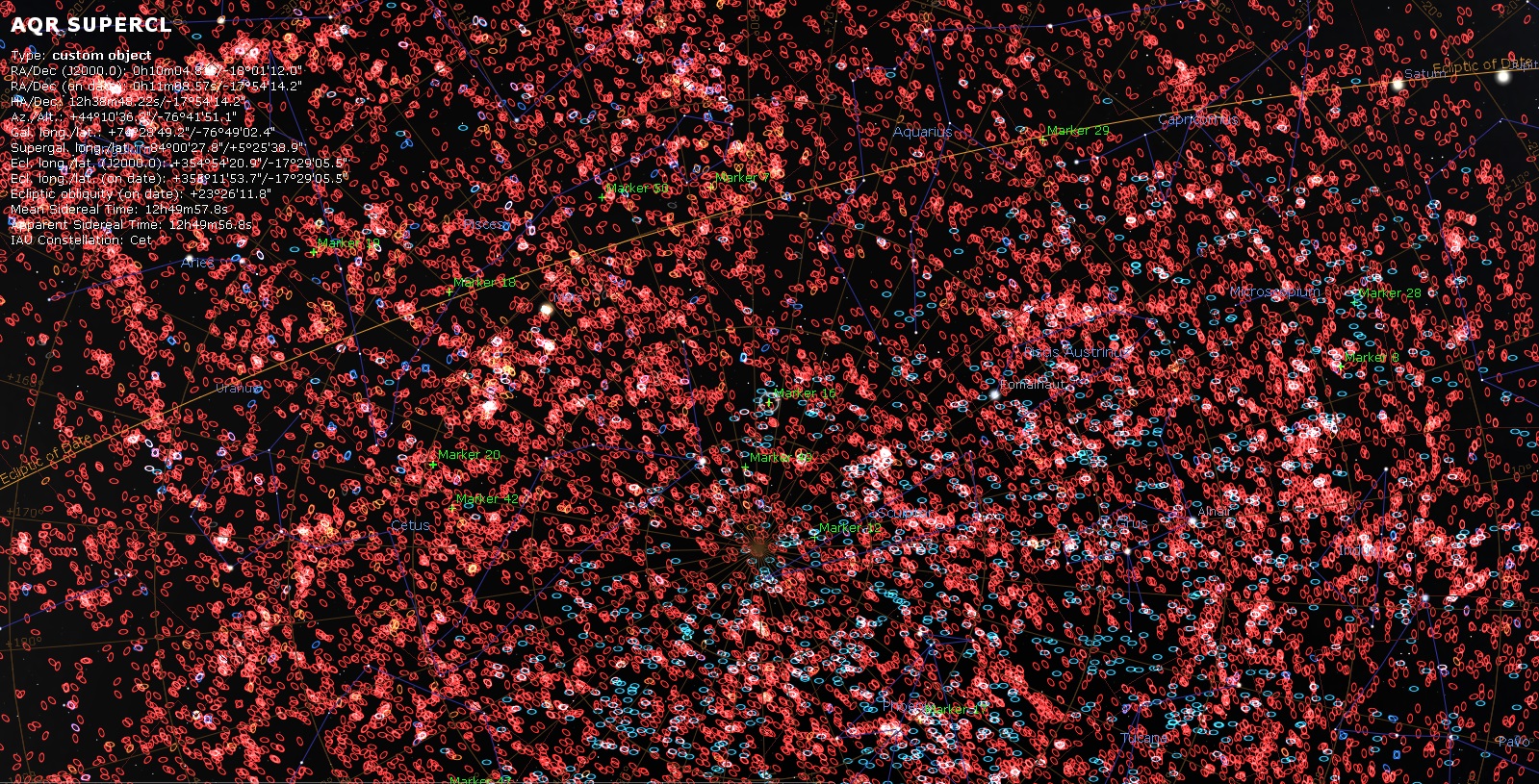
MARKER 16: SCL-04 - AQUARIUS SUPERCLUSTER
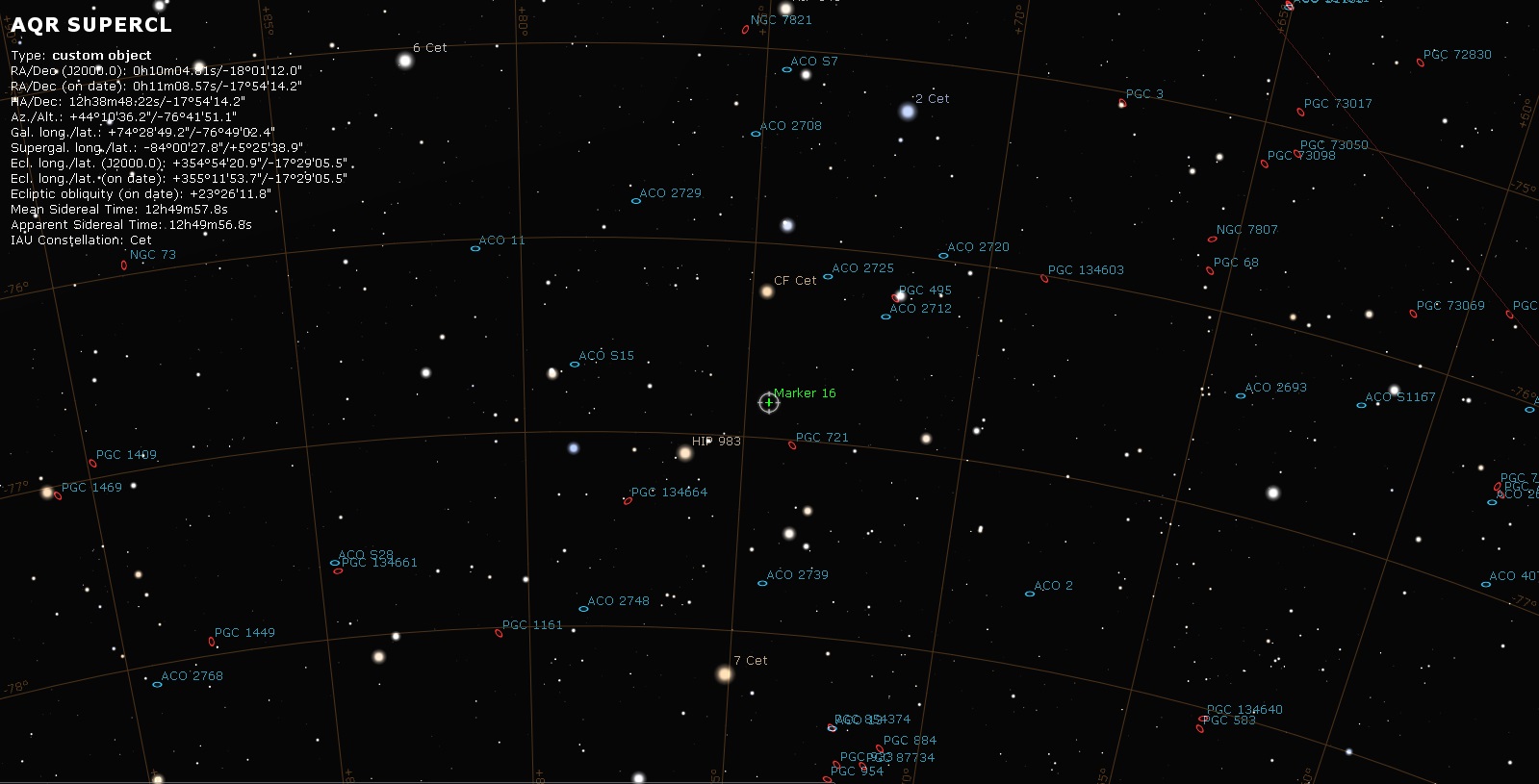
MARKER 16: SCL-04 - AQUARIUS SUPERCLUSTER
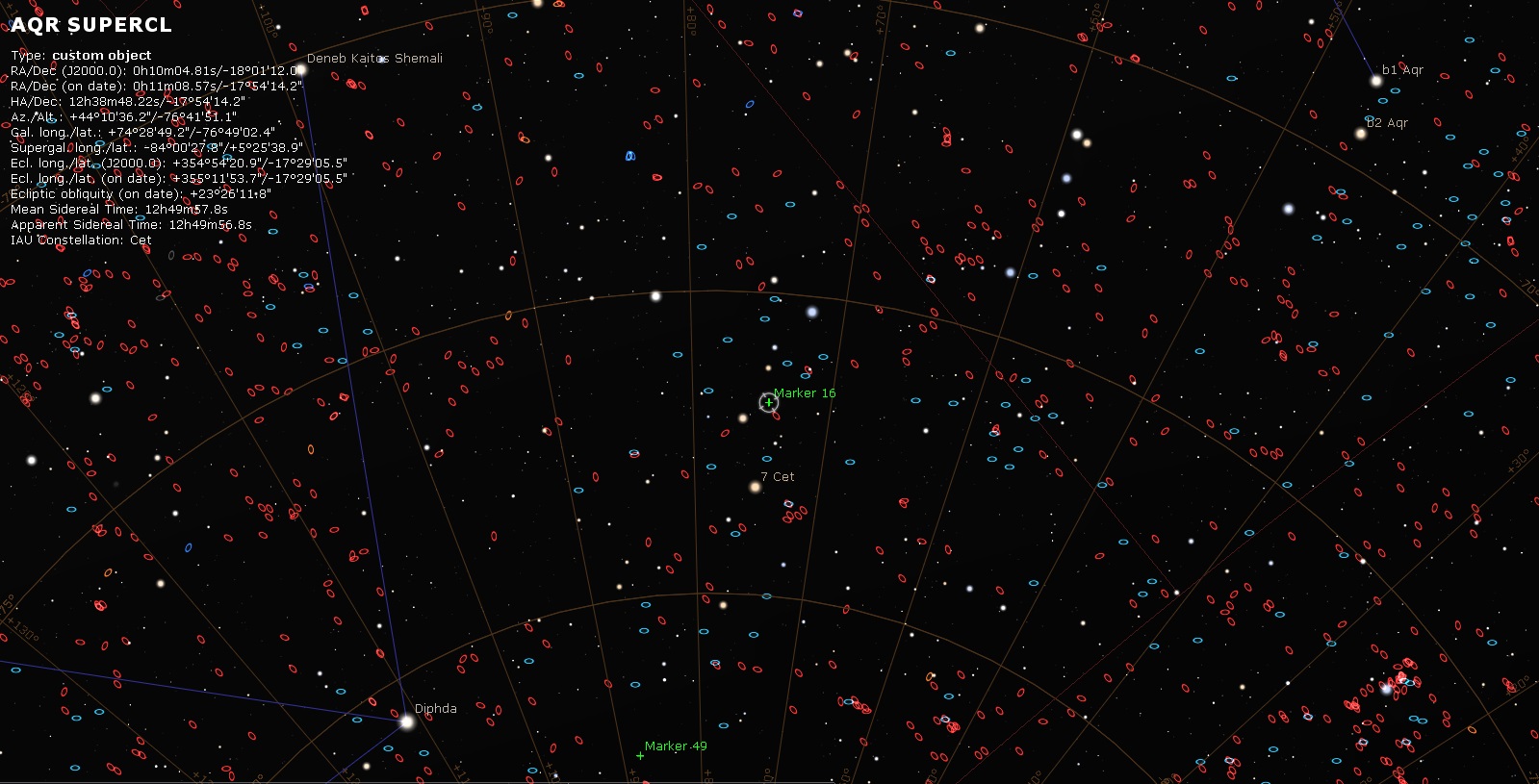
MARKER 16: SCL-04 - AQUARIUS SUPERCLUSTER
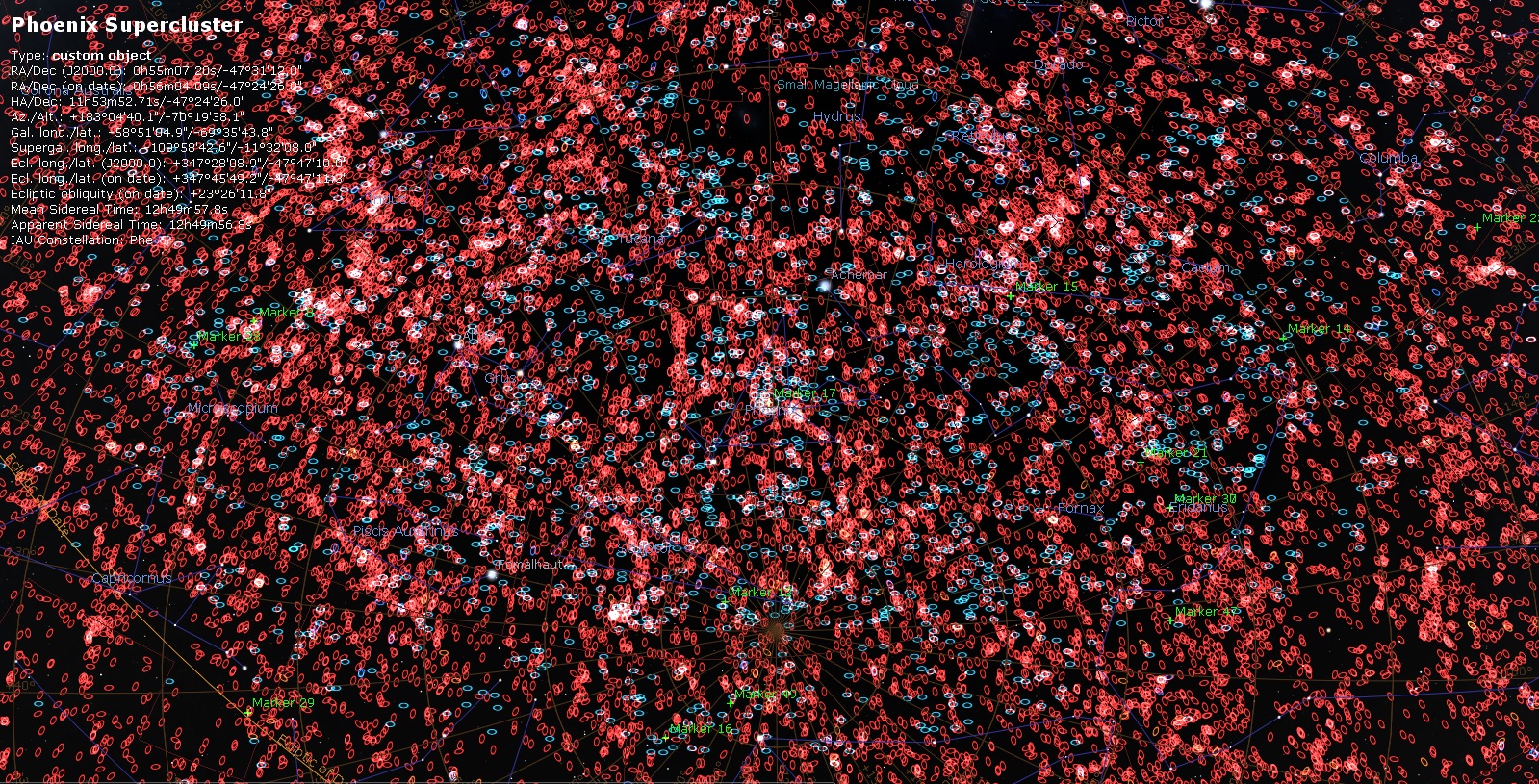
MARKER 17: SCL-18 - PHOENIX SUPERCLUSTER
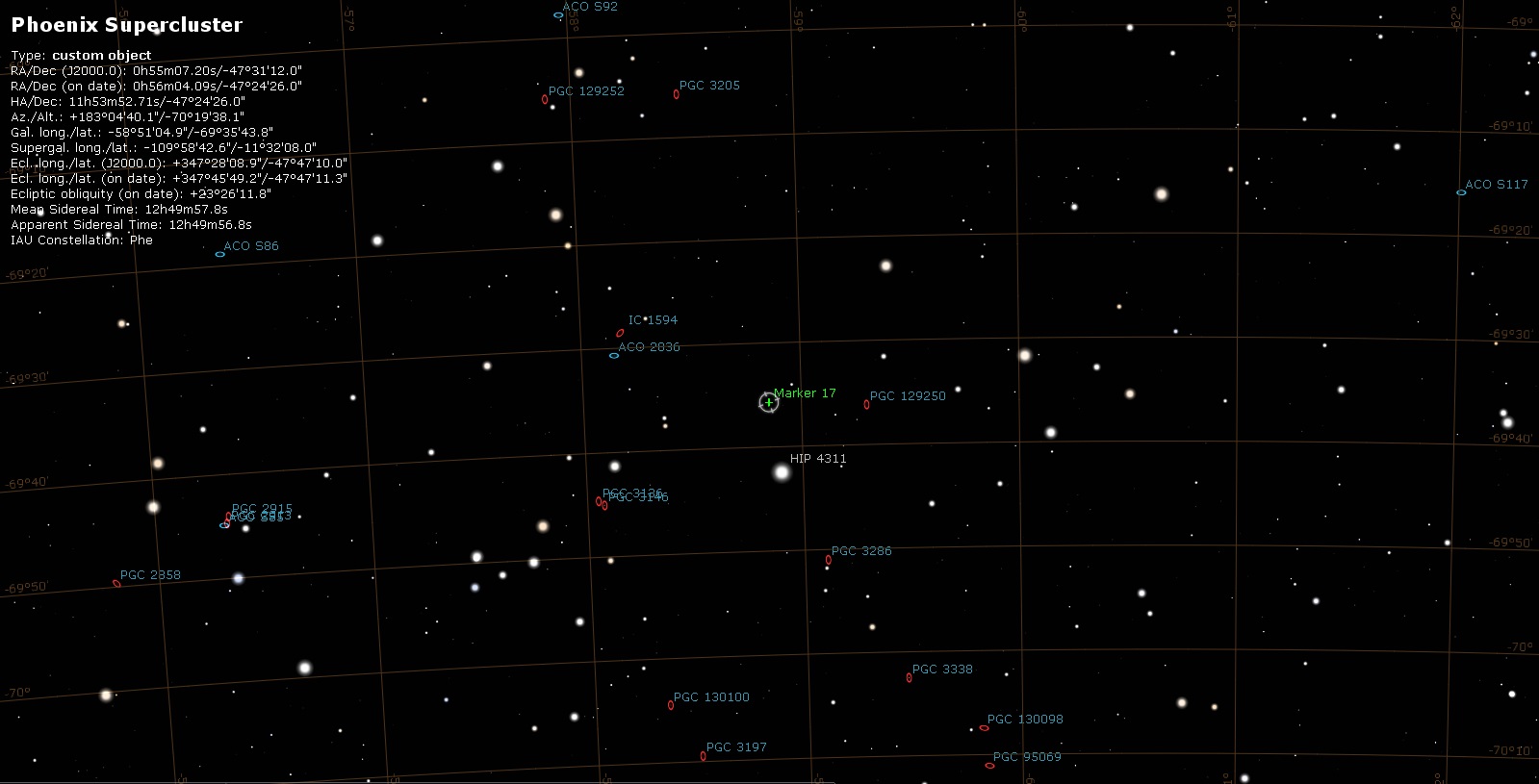
MARKER 17: SCL-18 - PHOENIX SUPERCLUSTER
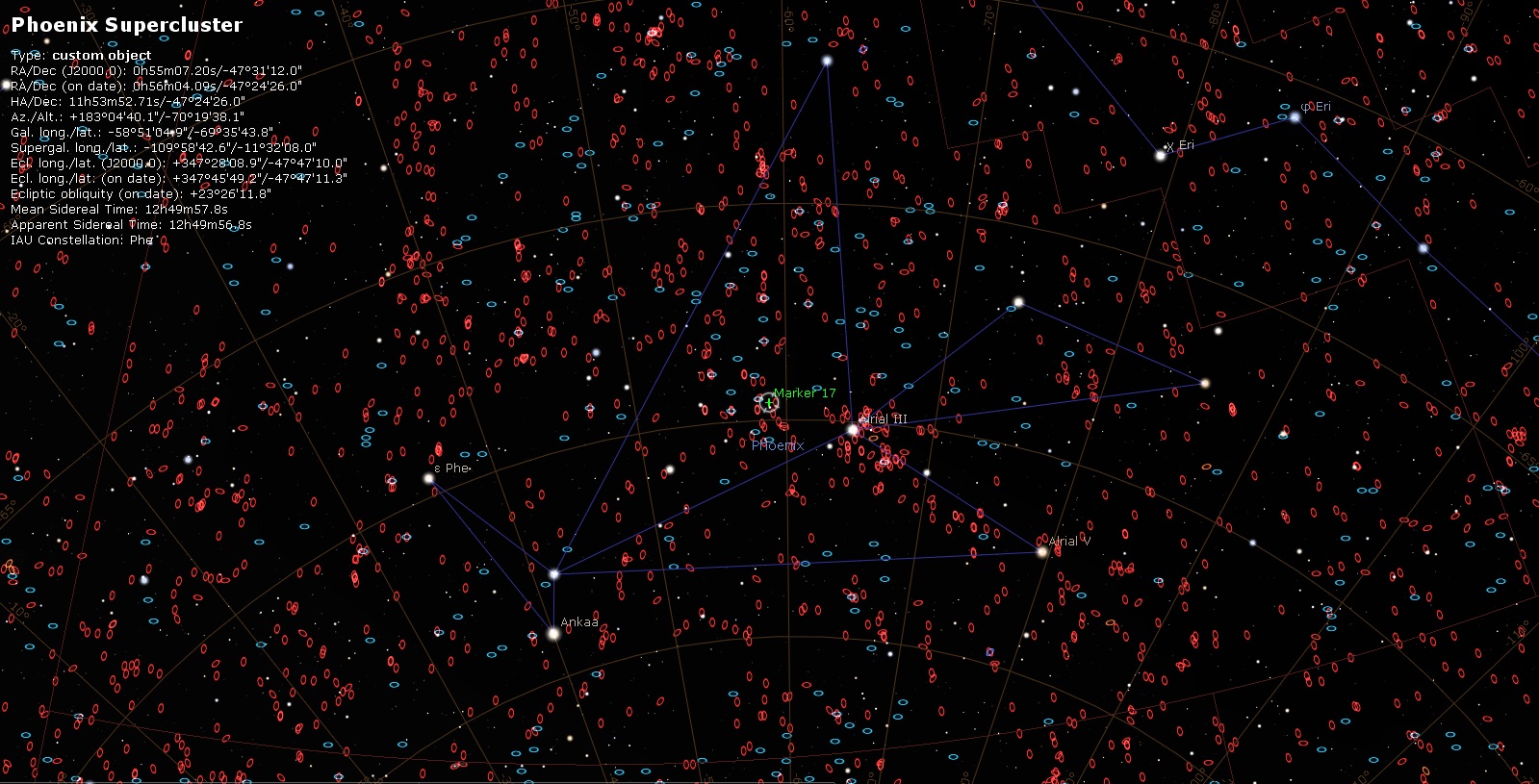
MARKER 17: SCL-18 - PHOENIX SUPERCLUSTER
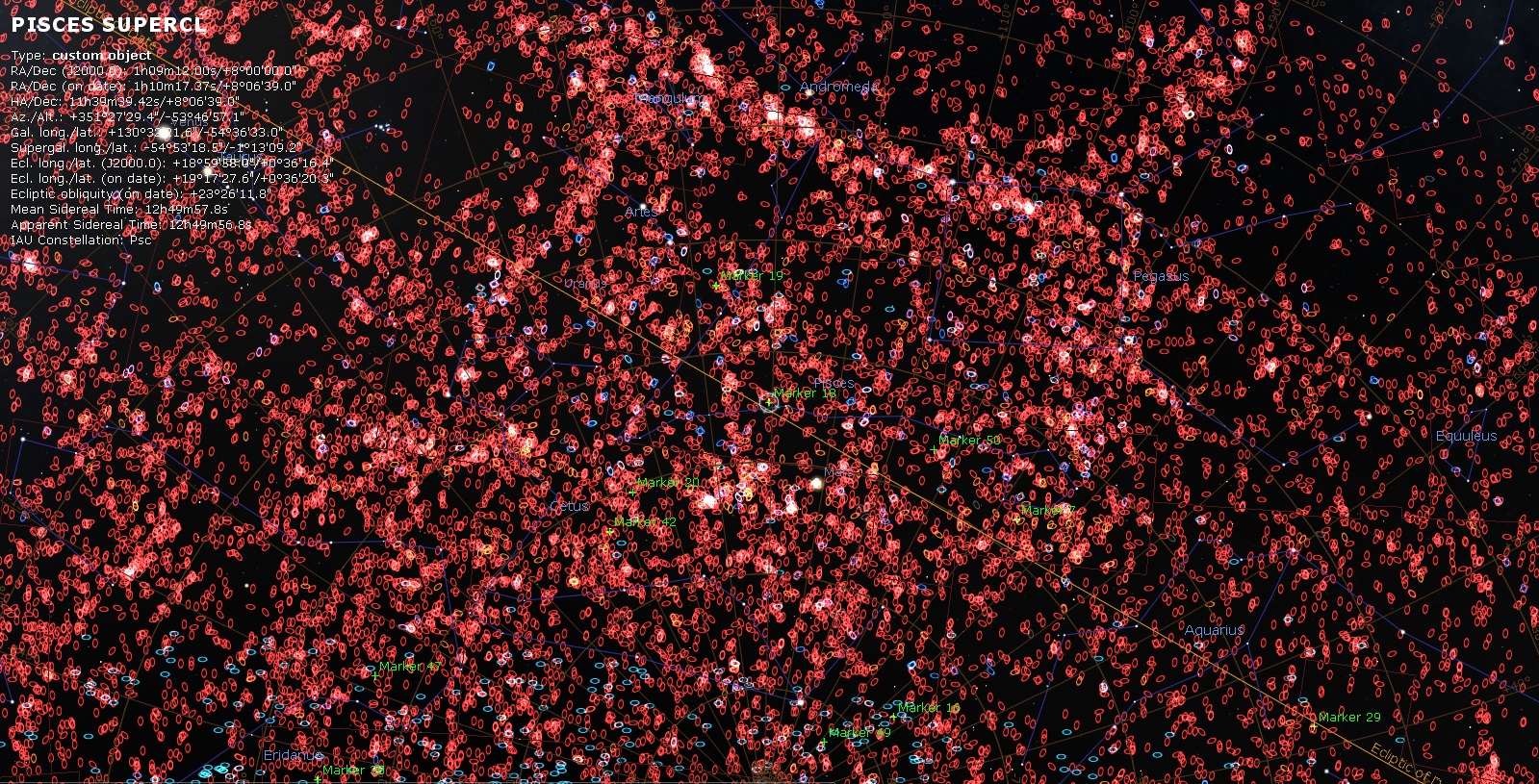
MARKER 18: SCL-24 - PISCES SUPERCLUSTER

MARKER 18: SCL-24 - PISCES SUPERCLUSTER
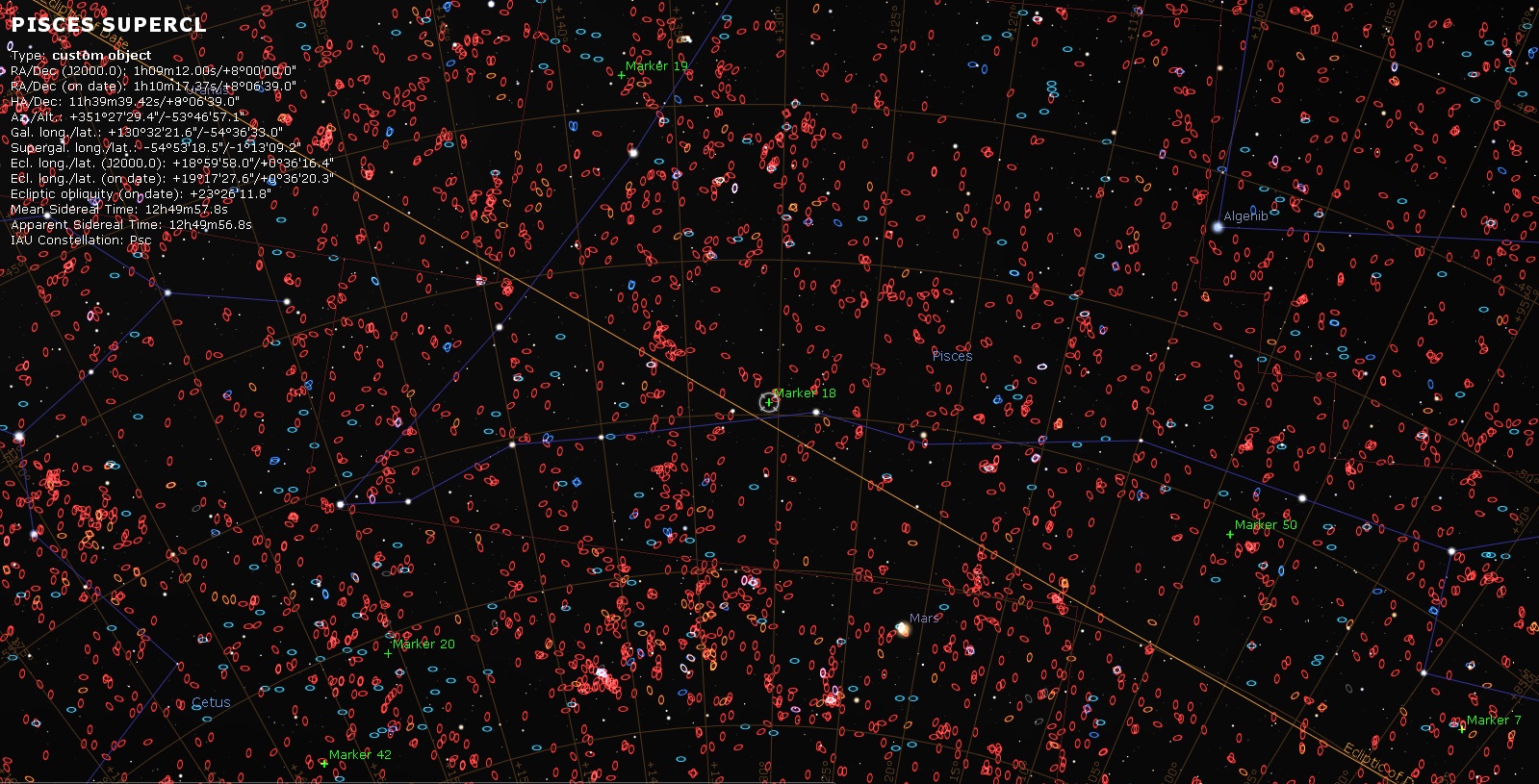
MARKER 18: SCL-24 - PISCES SUPERCLUSTER

MARKER 19: SCL-30 - PISCES-ARIES SUPERCLUSTER
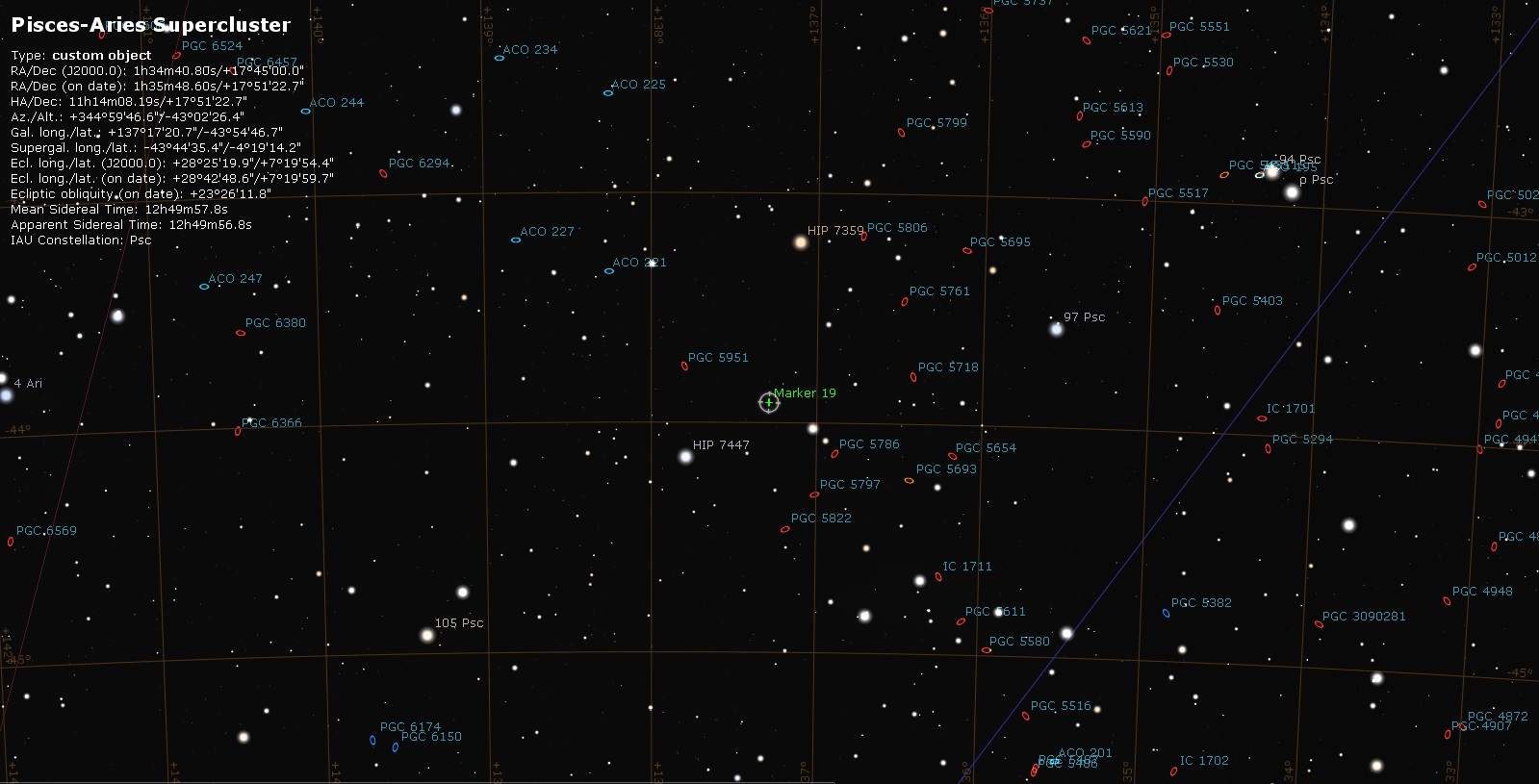
MARKER 19: SCL-30 - PISCES-ARIES SUPERCLUSTER
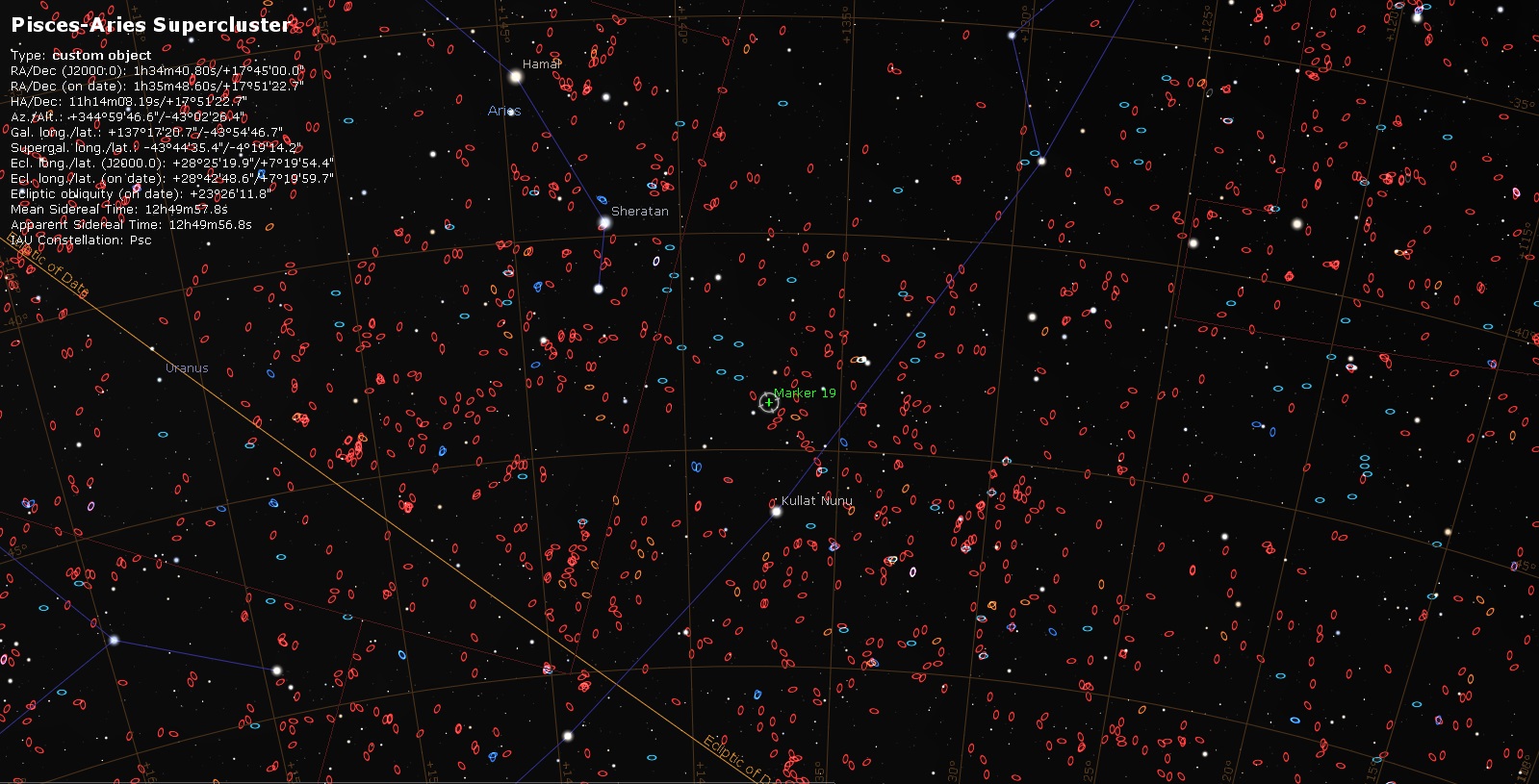
MARKER 19: SCL-30 - PISCES-ARIES SUPERCLUSTER
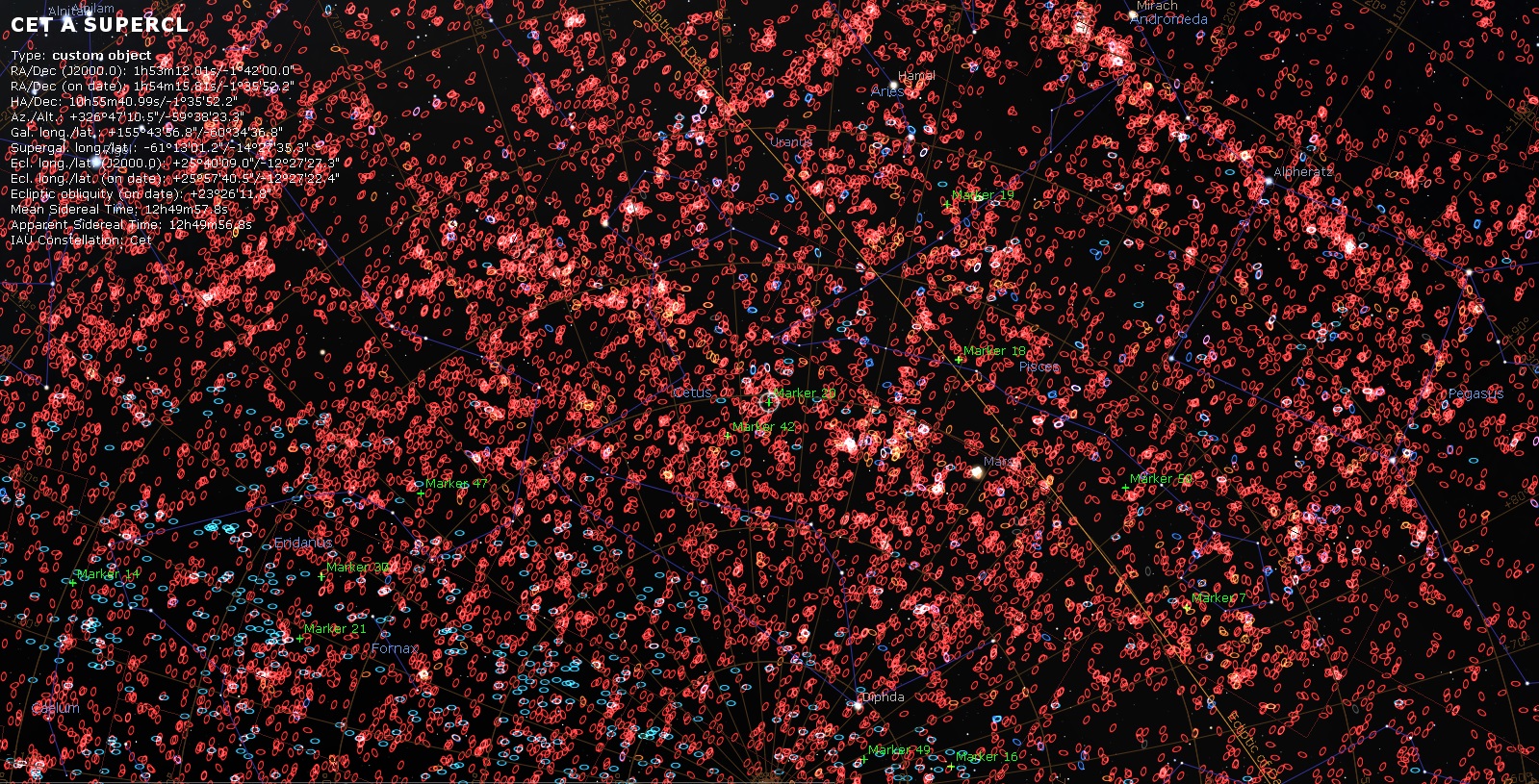
MARKER 20: SCL-34 - CETUS A SUPERCLUSTER
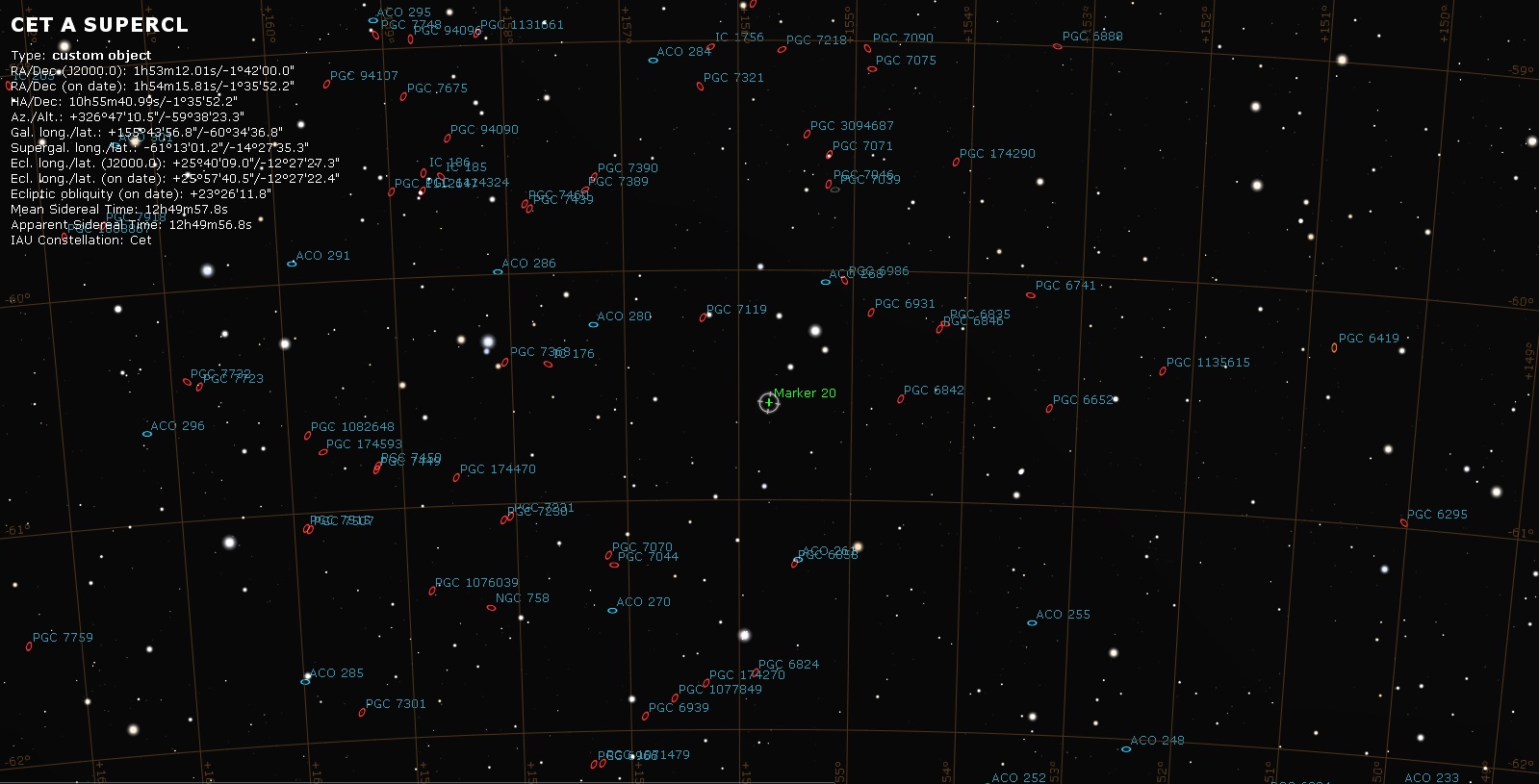
MARKER 20: SCL-34 - CETUS A SUPERCLUSTER
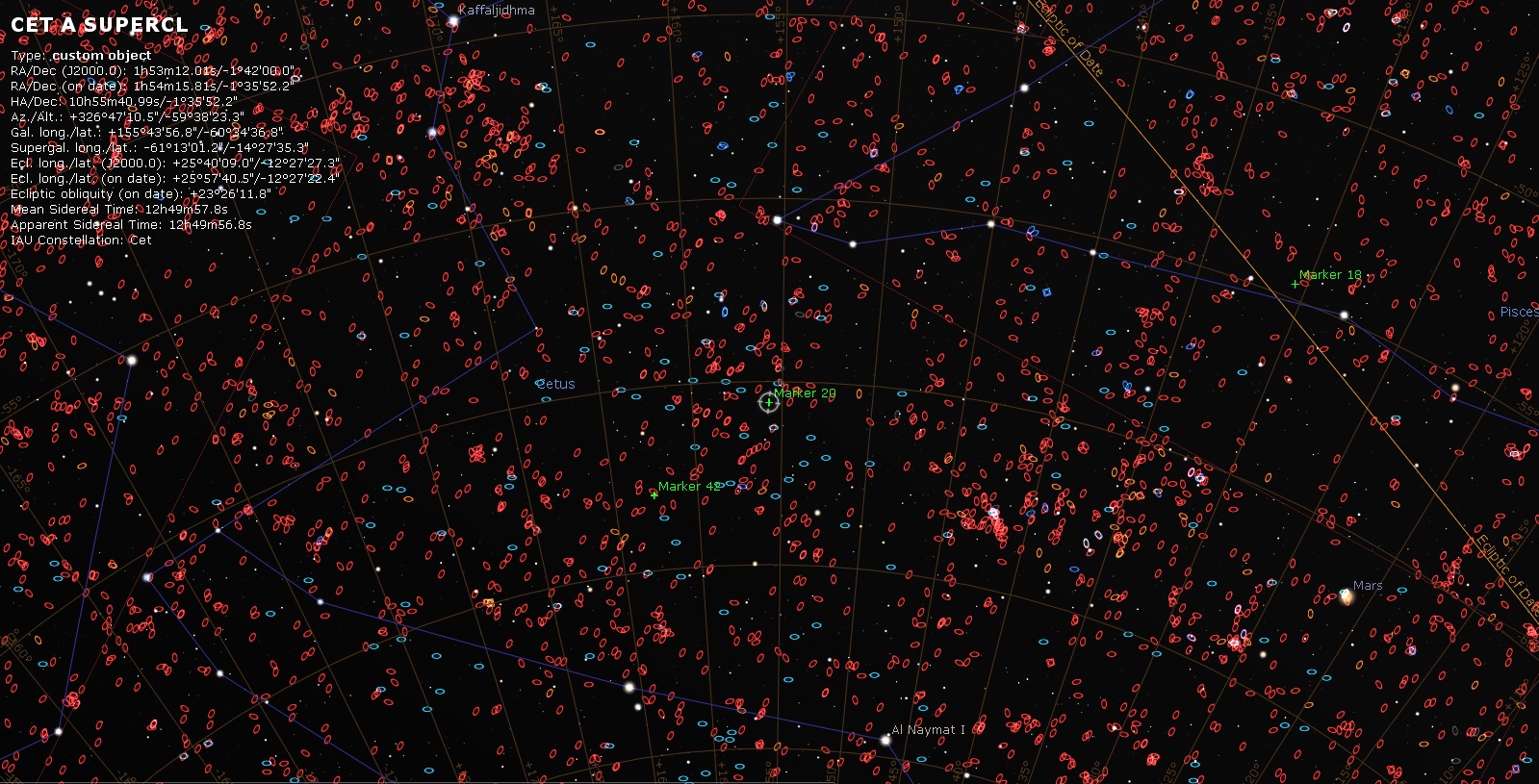
MARKER 20: SCL-34 - CETUS A SUPERCLUSTER
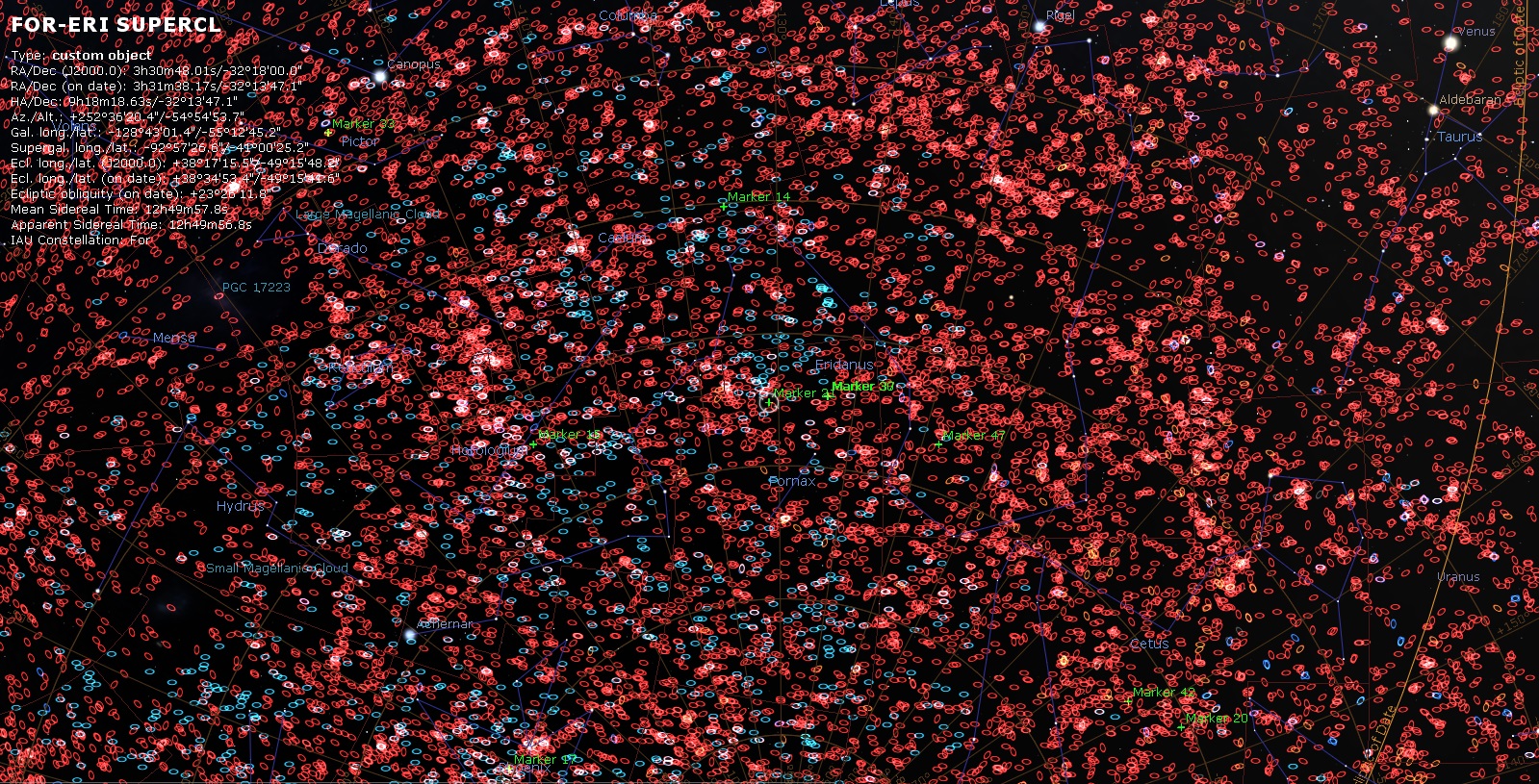
MARKER 21: SCL-53 - FORNAX-ERIDANUS SUPERCLUSTER
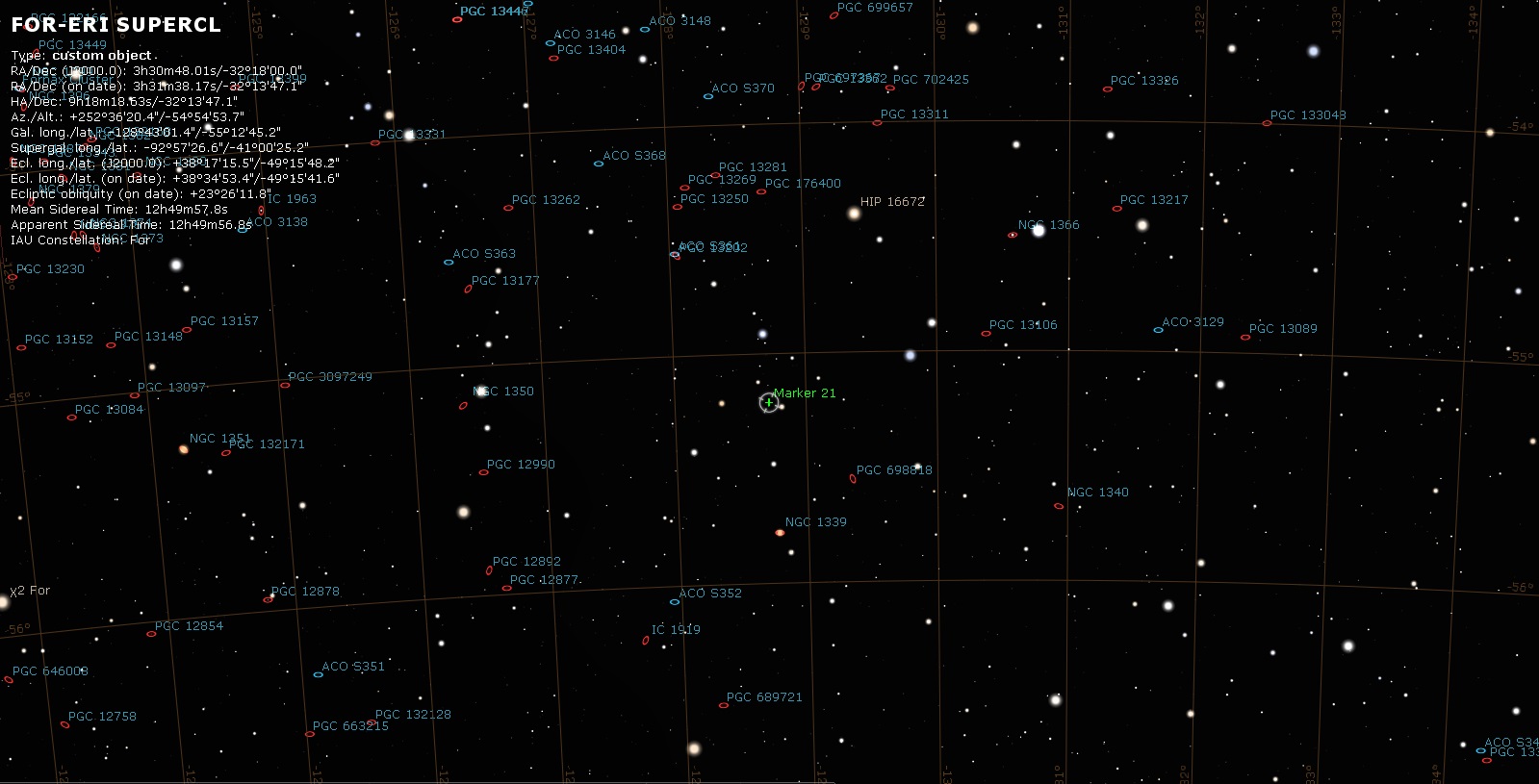
MARKER 21: SCL-53 - FORNAX-ERIDANUS SUPERCLUSTER
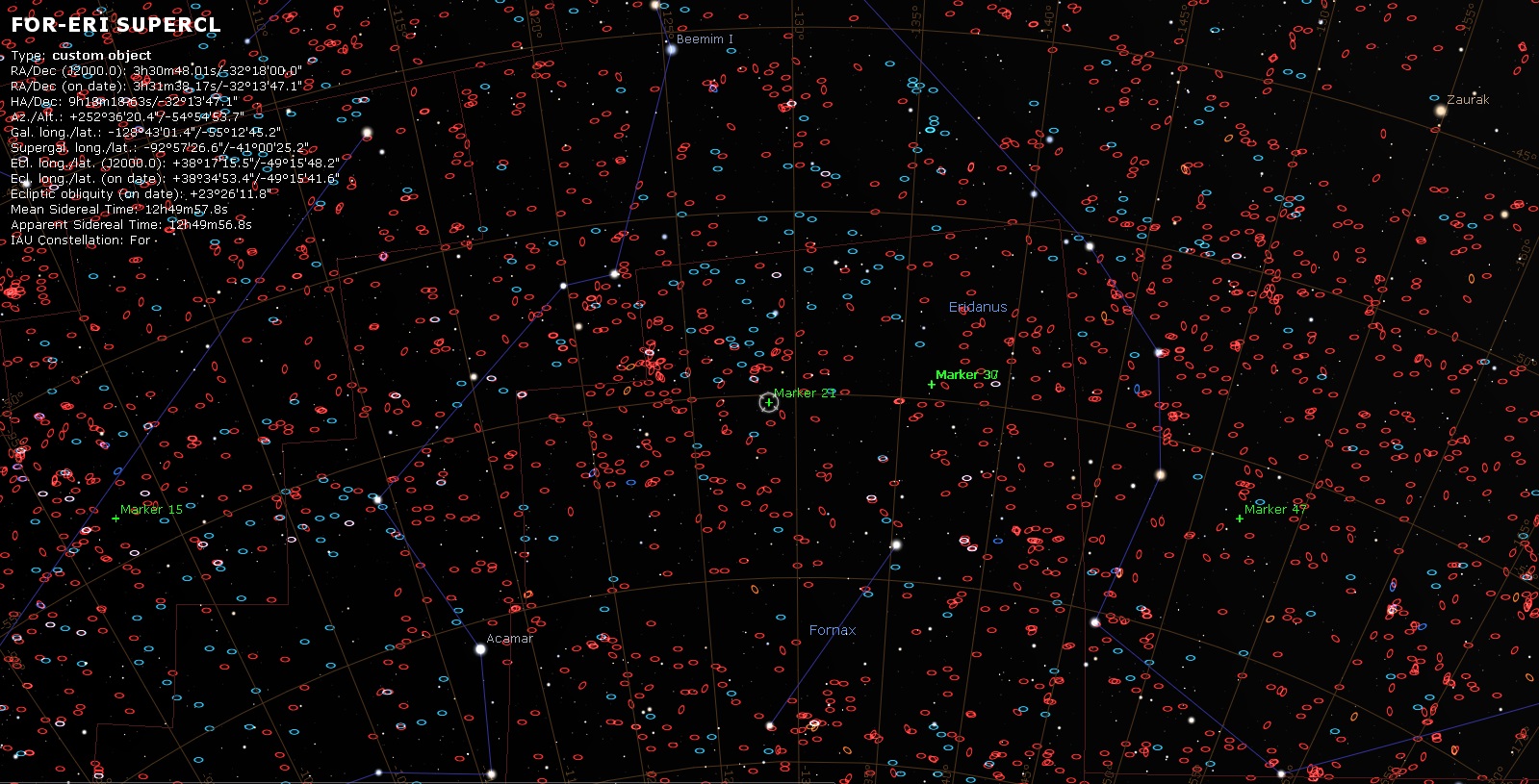
MARKER 21: SCL-53 - FORNAX-ERIDANUS SUPERCLUSTER
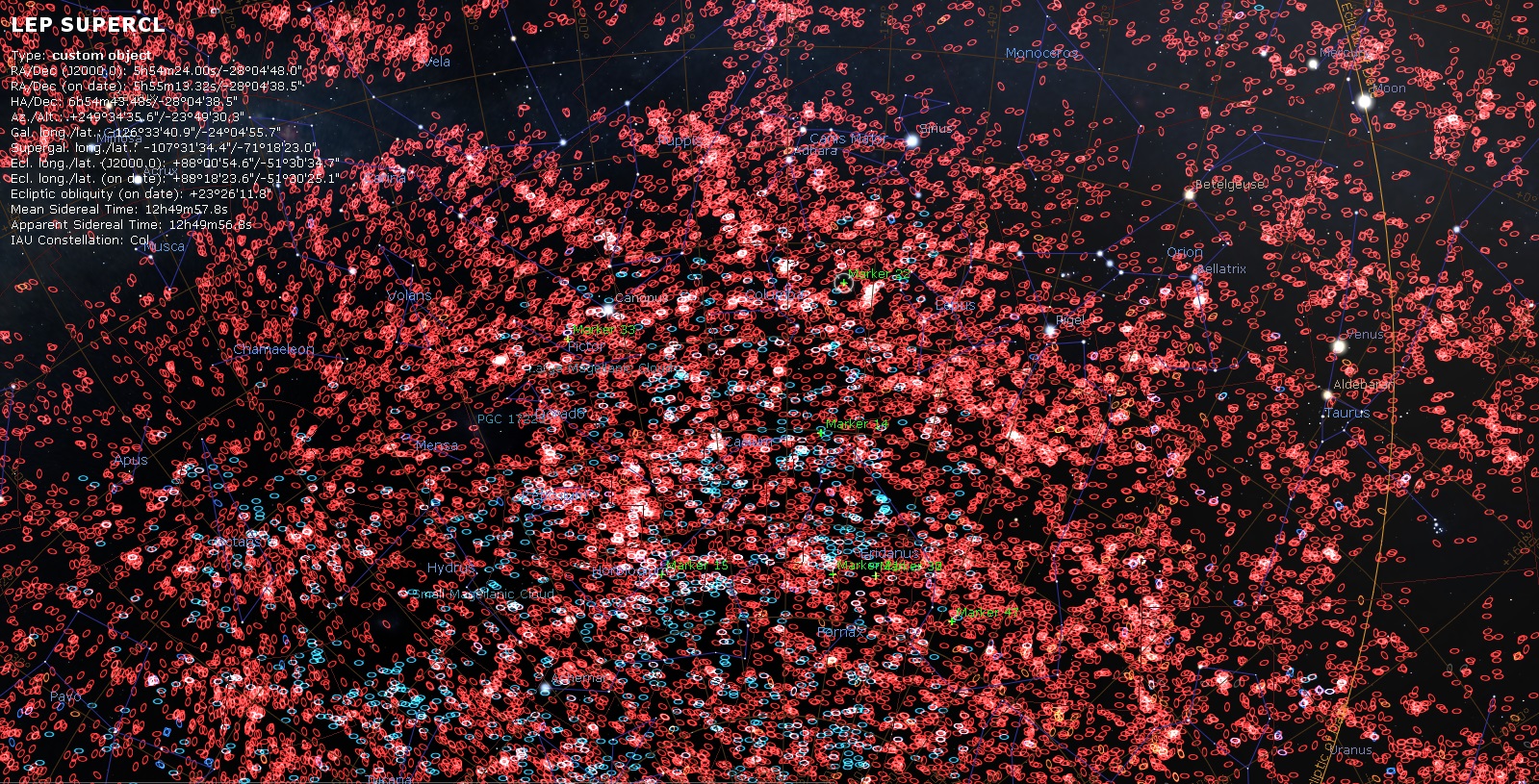
MARKER 22: SCL-67 - LEP SUPERCLUSTER
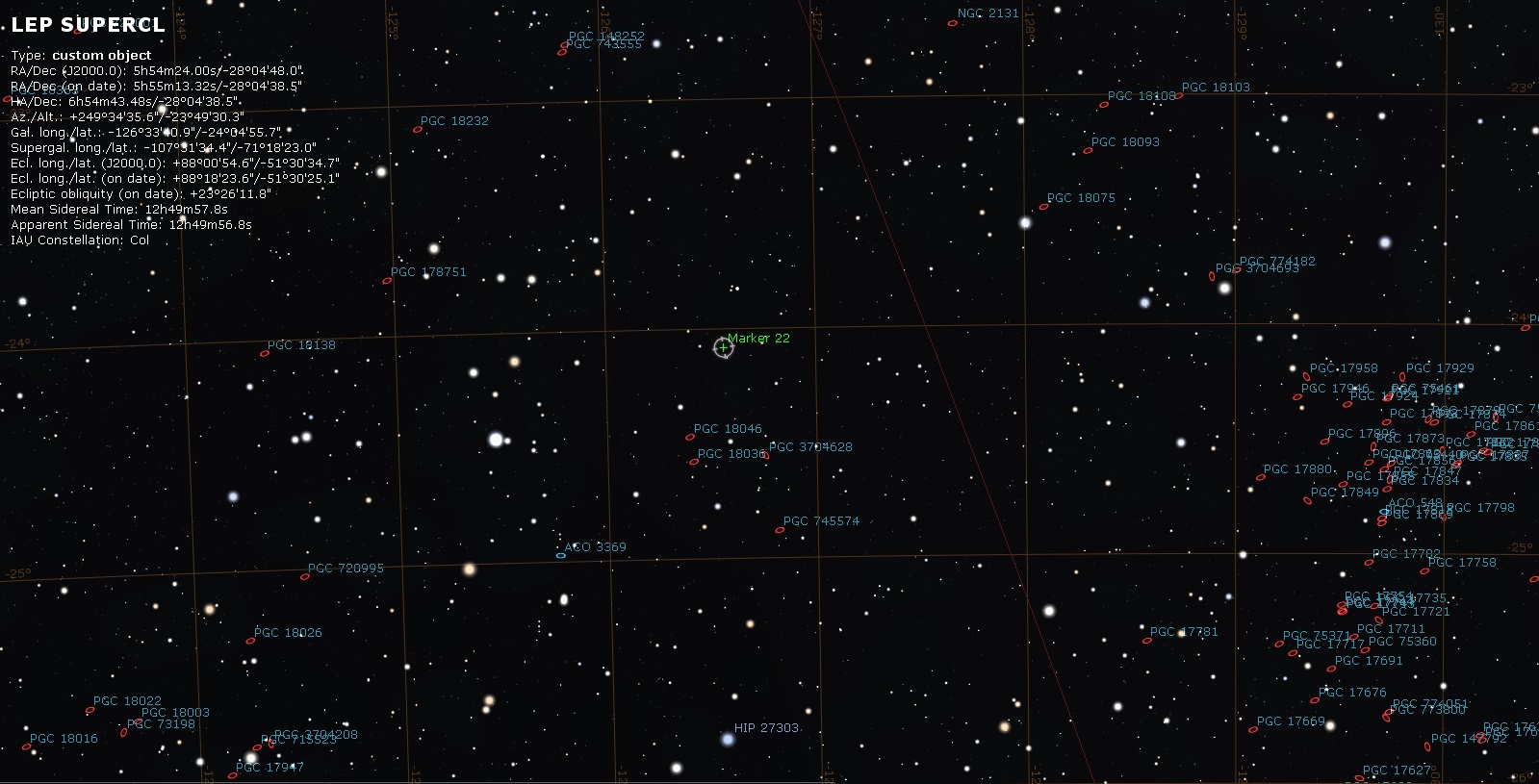
MARKER 22: SCL-67 - LEP SUPERCLUSTER
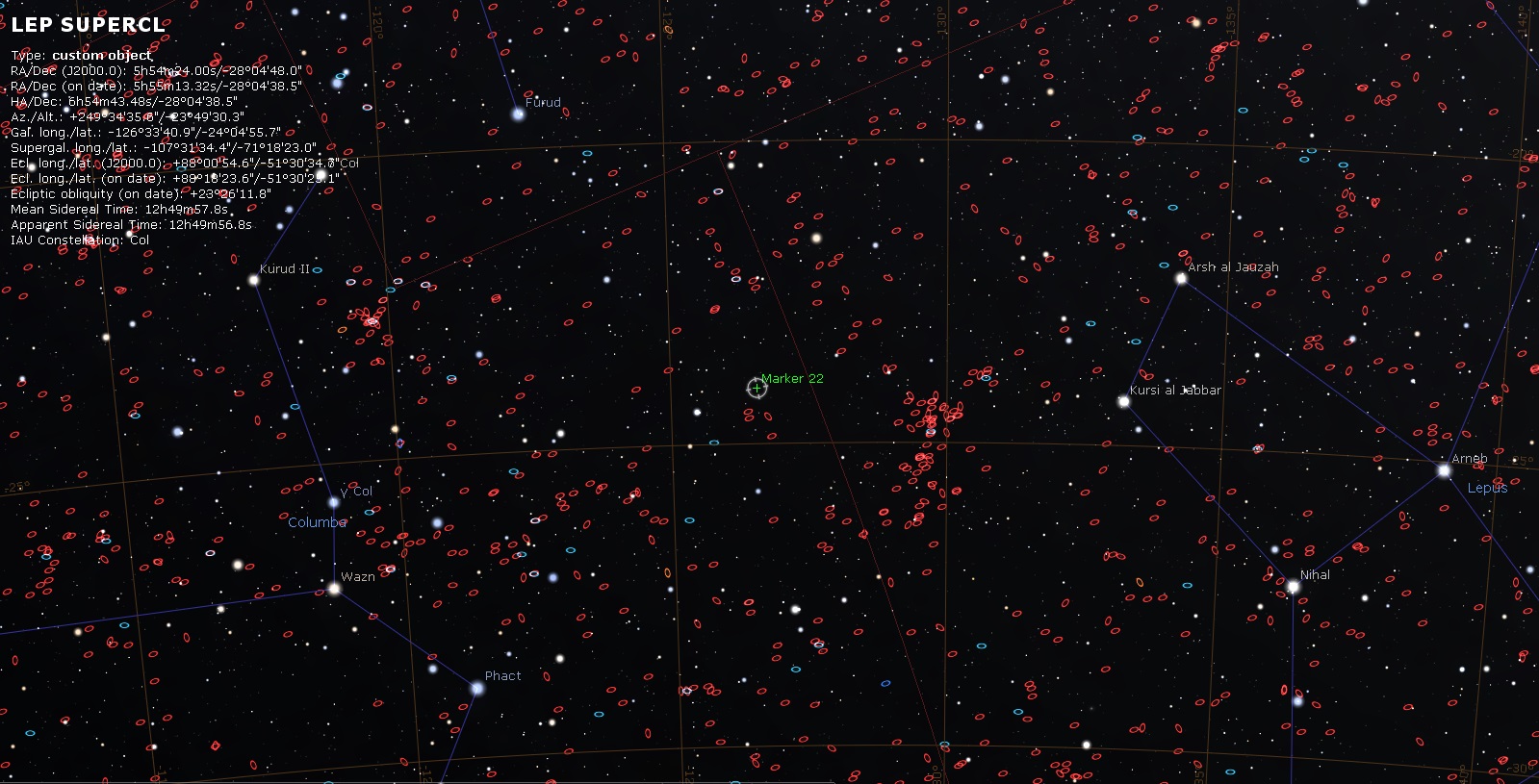
MARKER 22: SCL-67 - LEP SUPERCLUSTER
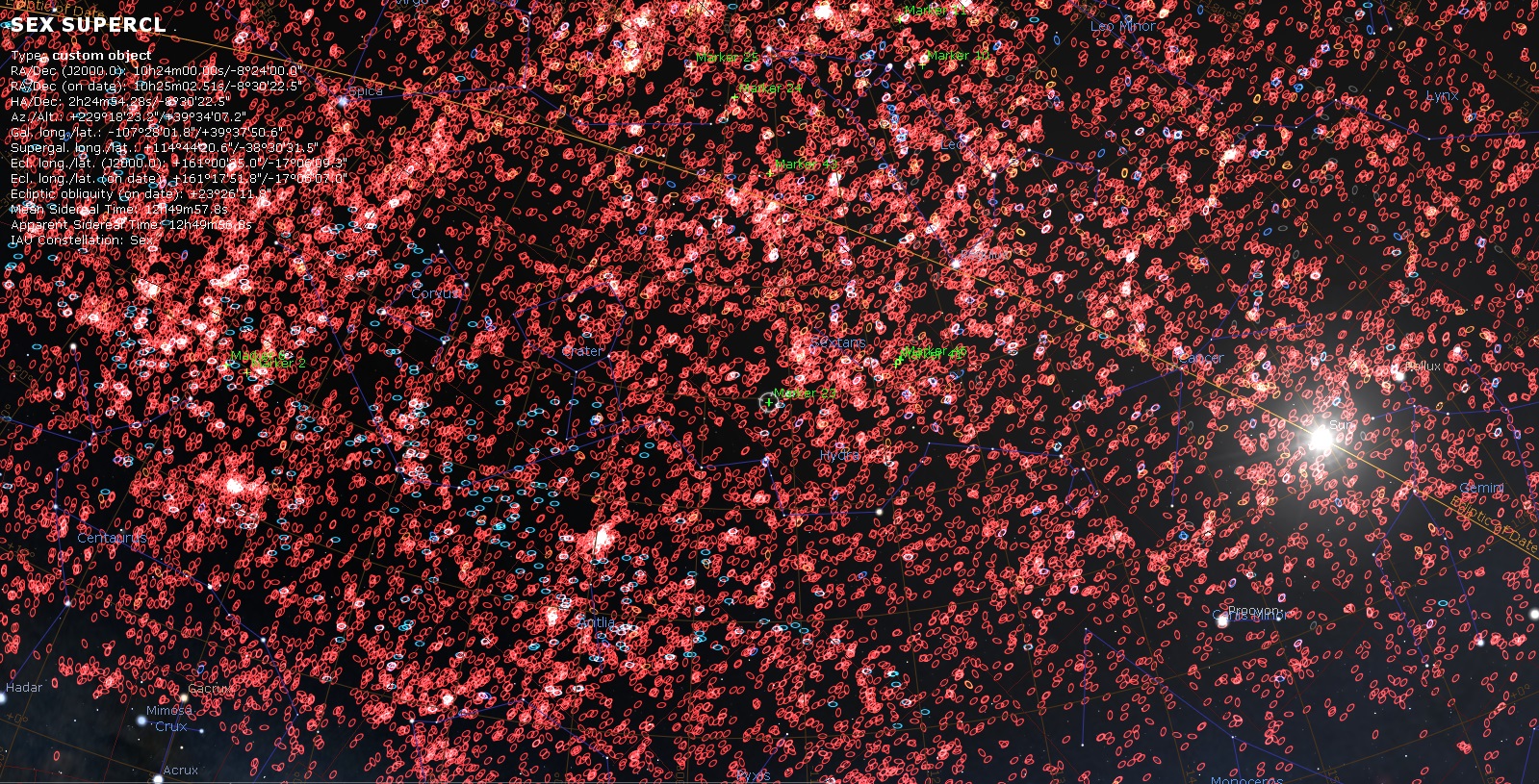
MARKER 23: SCL-88 - SEXTANS SUPERCLUSTER
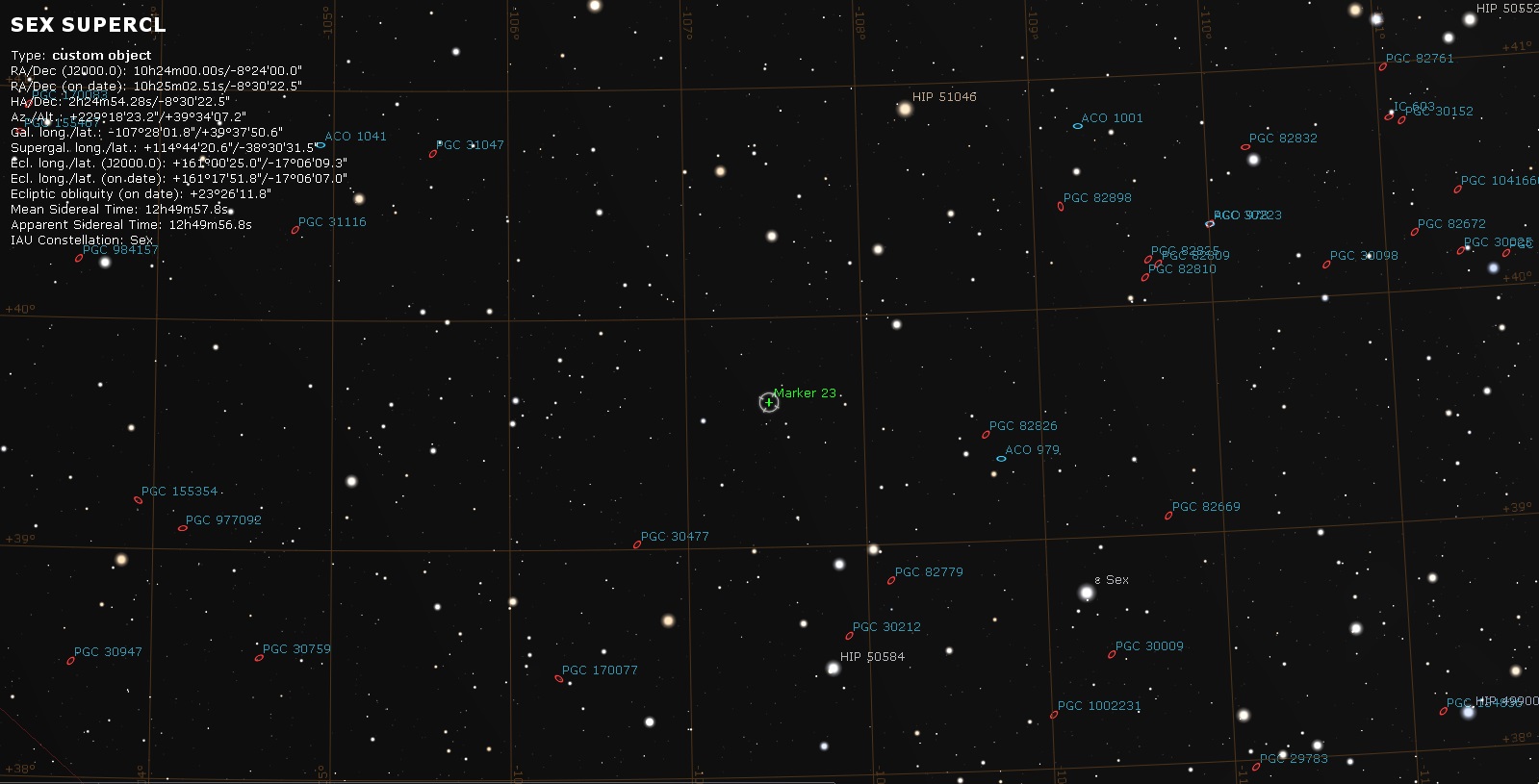
MARKER 23: SCL-88 - SEXTANS SUPERCLUSTER
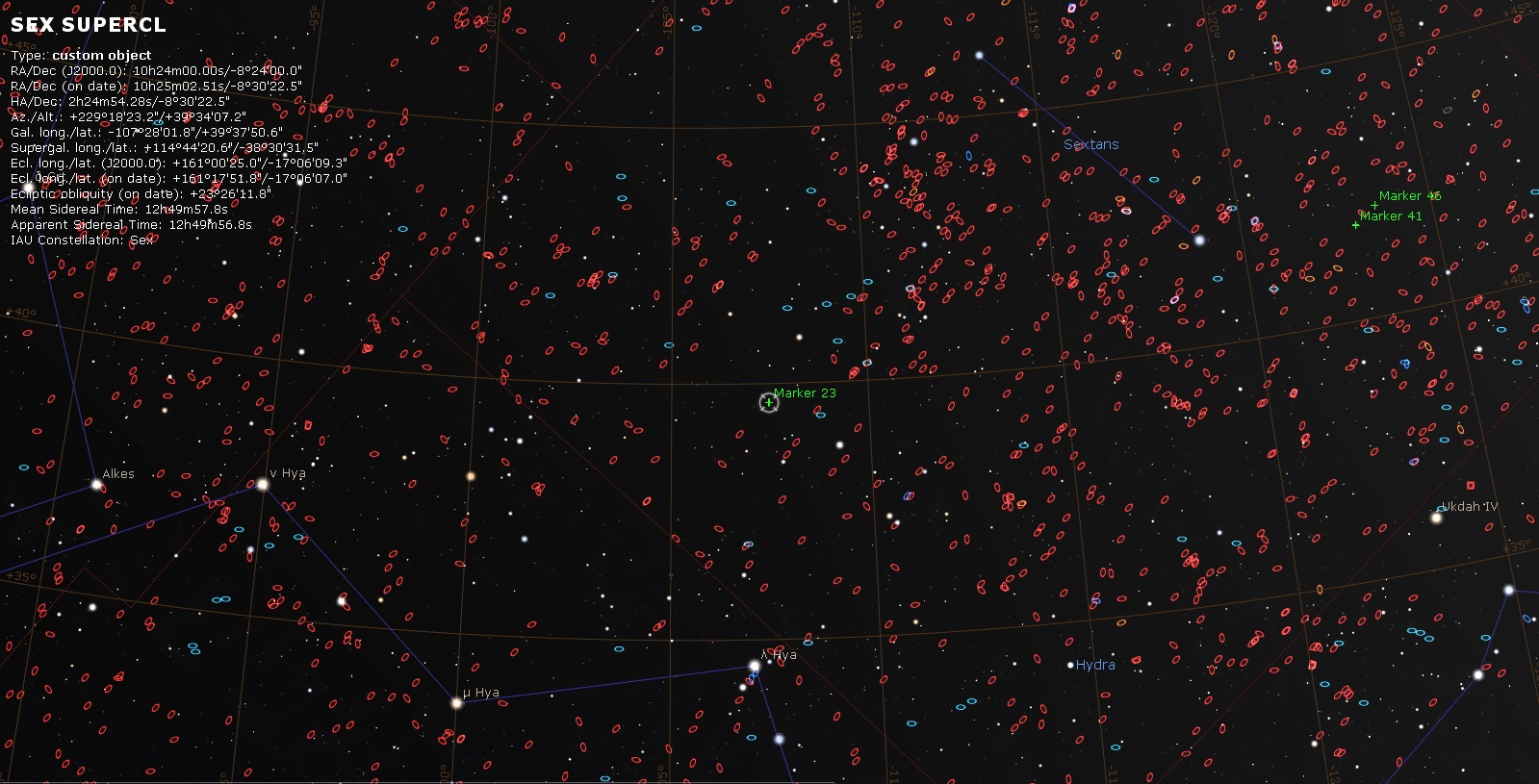
MARKER 23: SCL-88 - SEXTANS SUPERCLUSTER
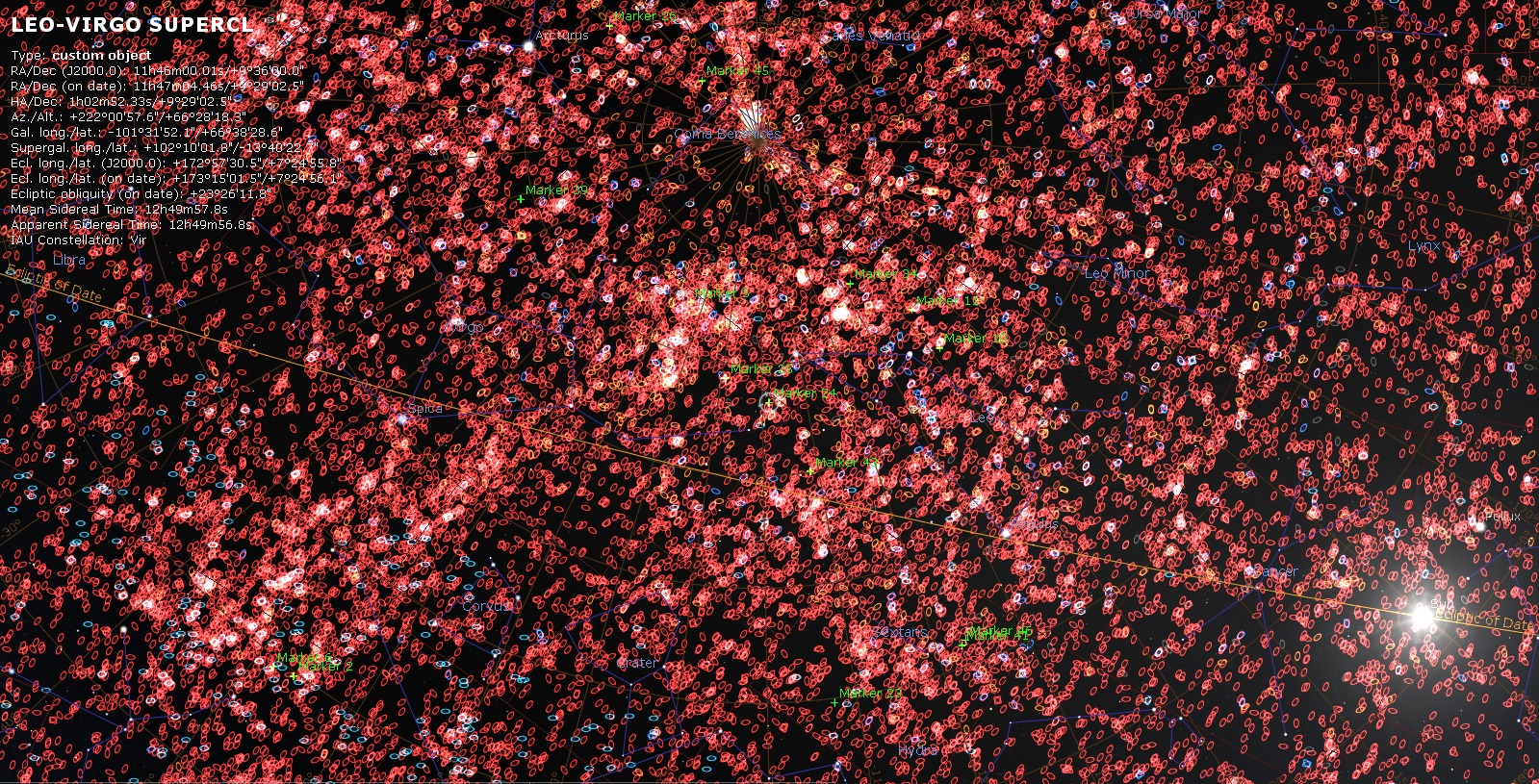
MARKER 24: SCL-107 - LEO-VIRGO SUPERCLUSTER
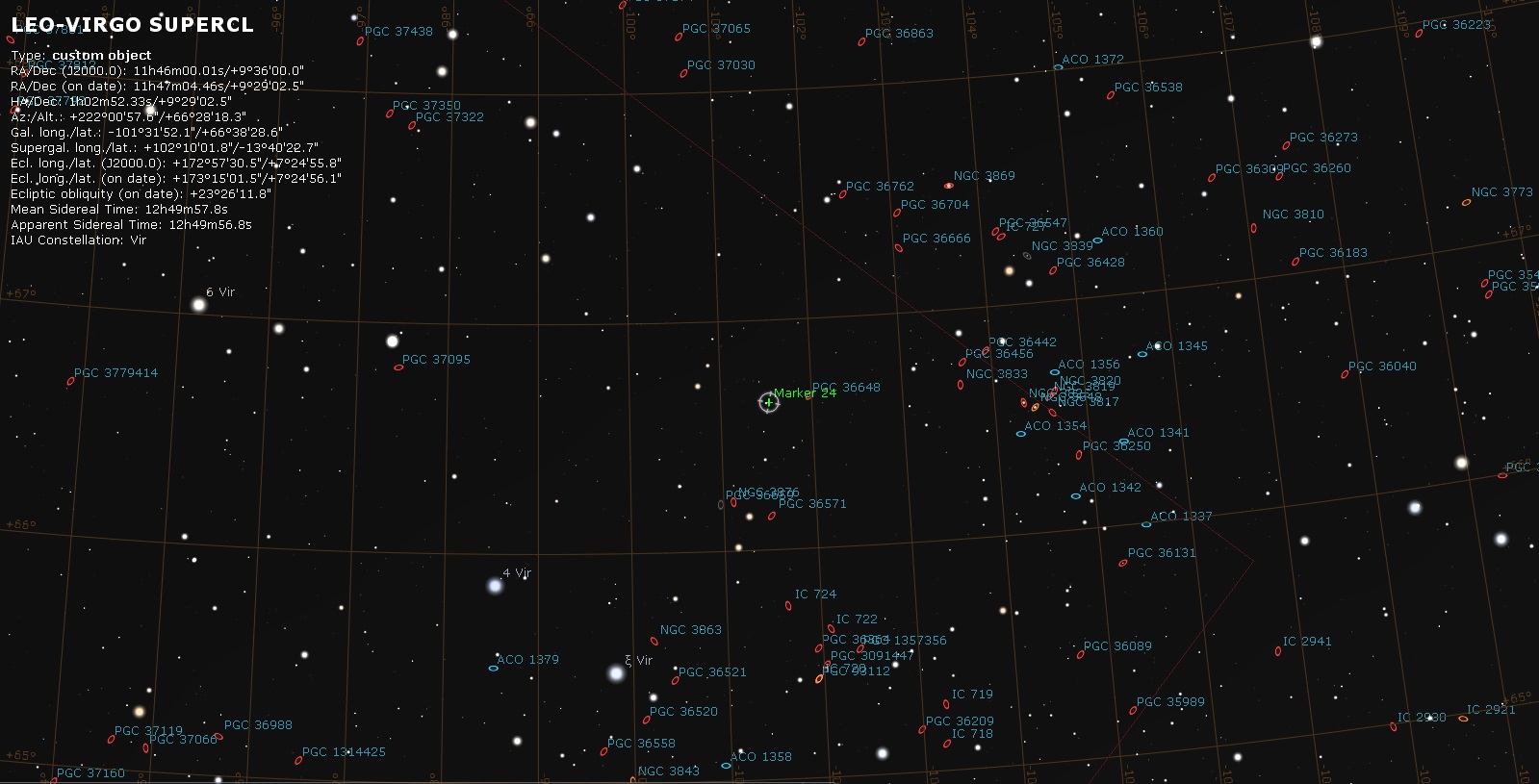
MARKER 24: SCL-107 - LEO-VIRGO SUPERCLUSTER
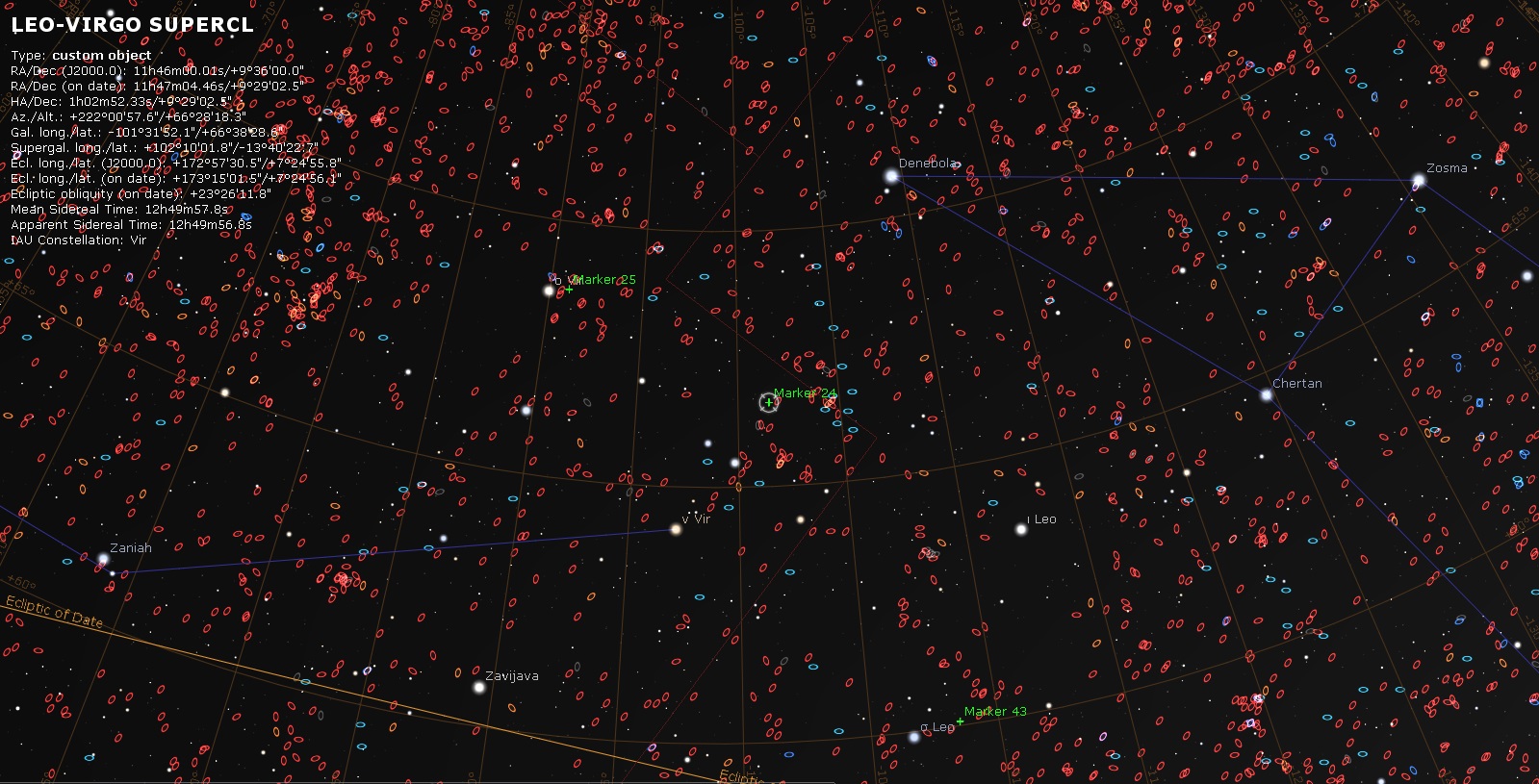
MARKER 24: SCL-107 - LEO-VIRGO SUPERCLUSTER

MARKER 25: SCL-111 - VIRGO-COMA SUPERCLUSTER
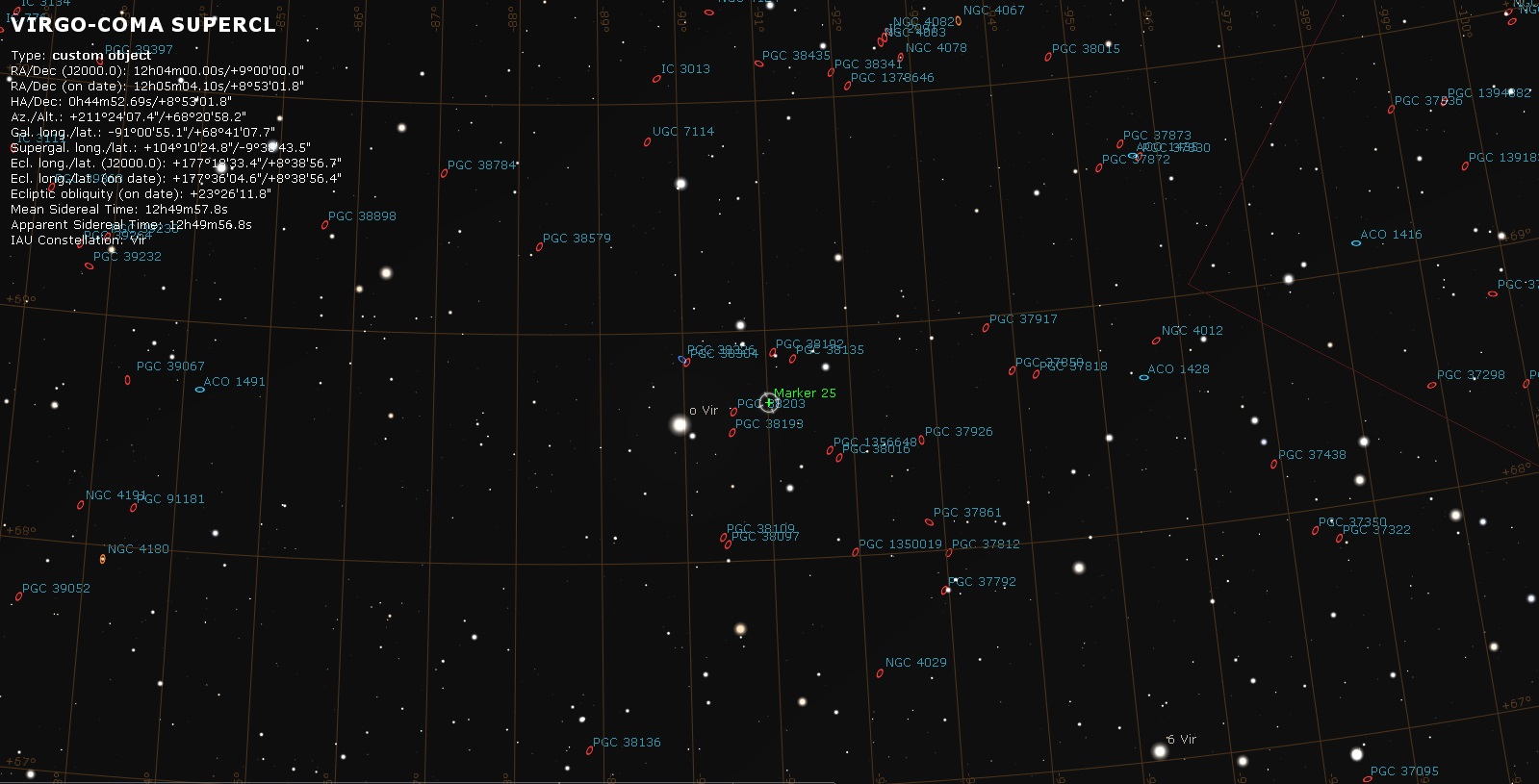
MARKER 25: SCL-111 - VIRGO-COMA SUPERCLUSTER
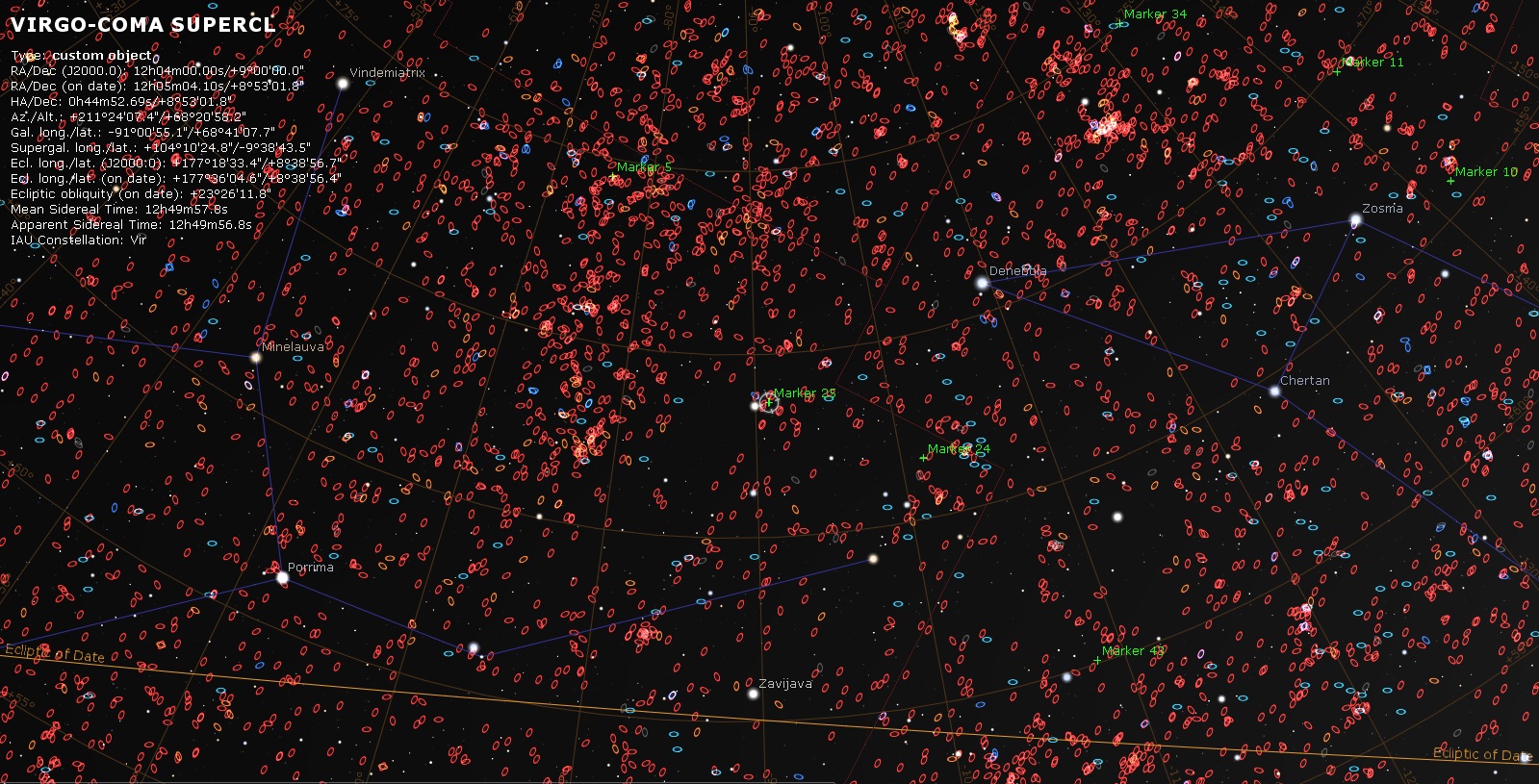
MARKER 25: SCL-111 - VIRGO-COMA SUPERCLUSTER
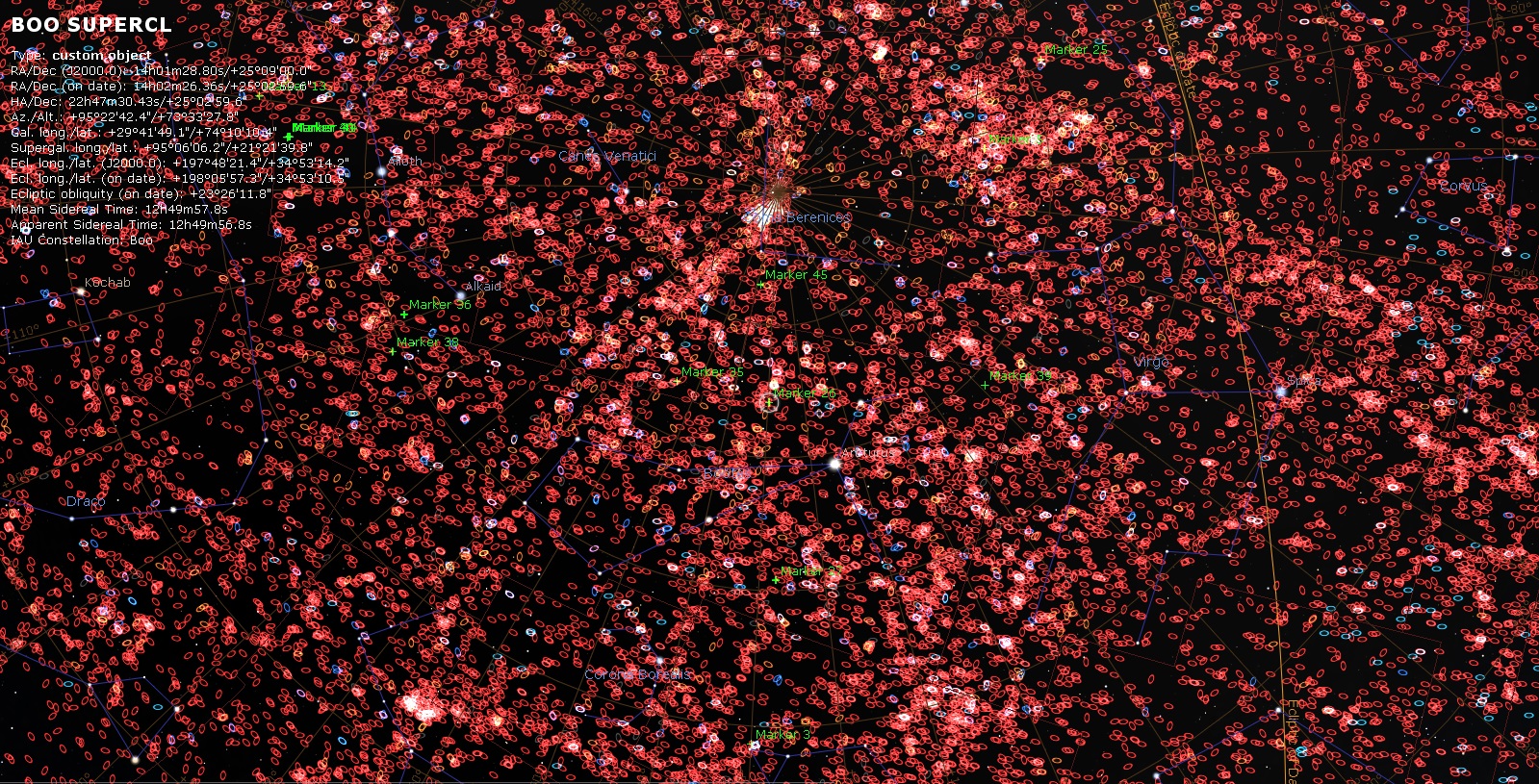
MARKER 26: SCL-138
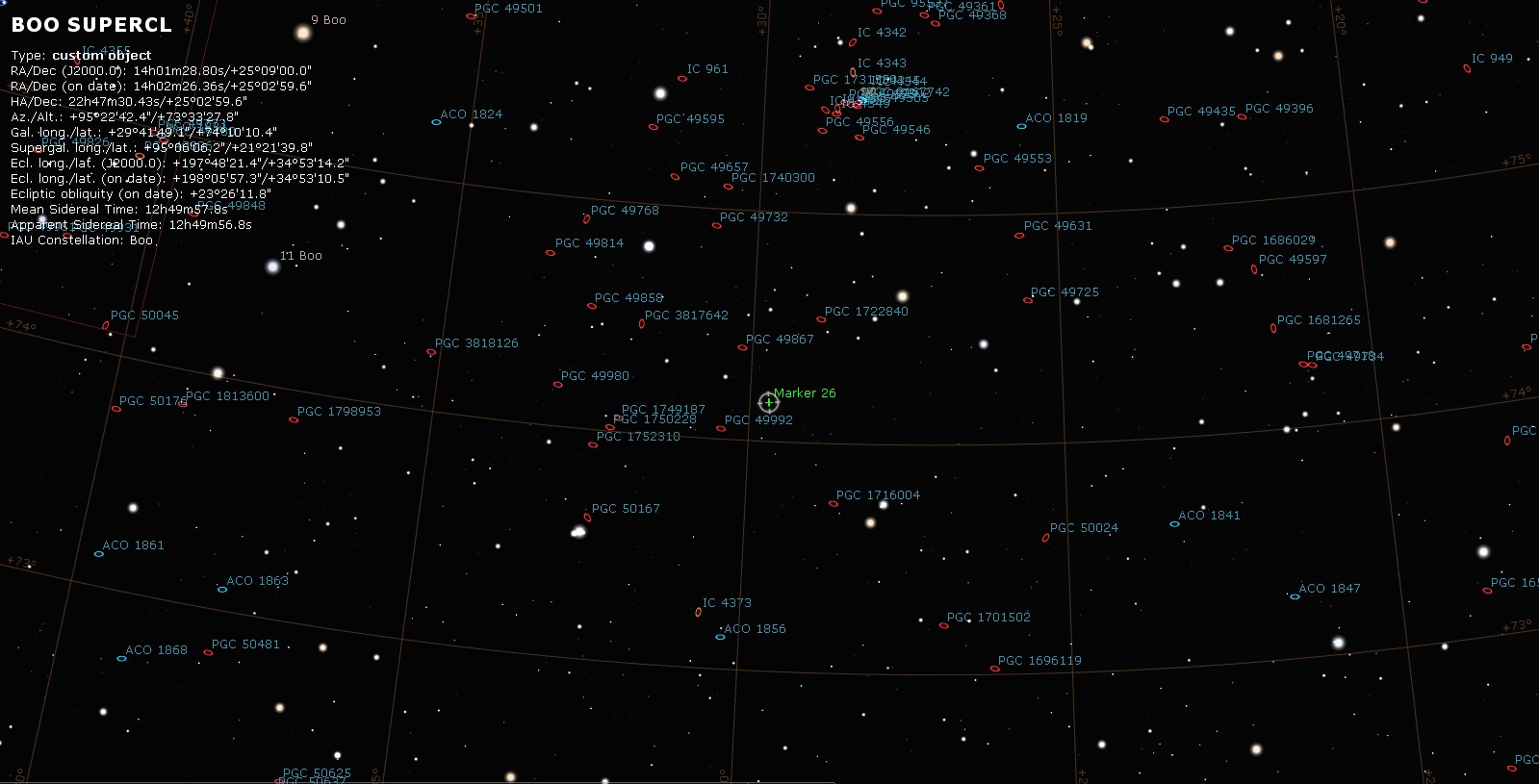
MARKER 26: SCL-138
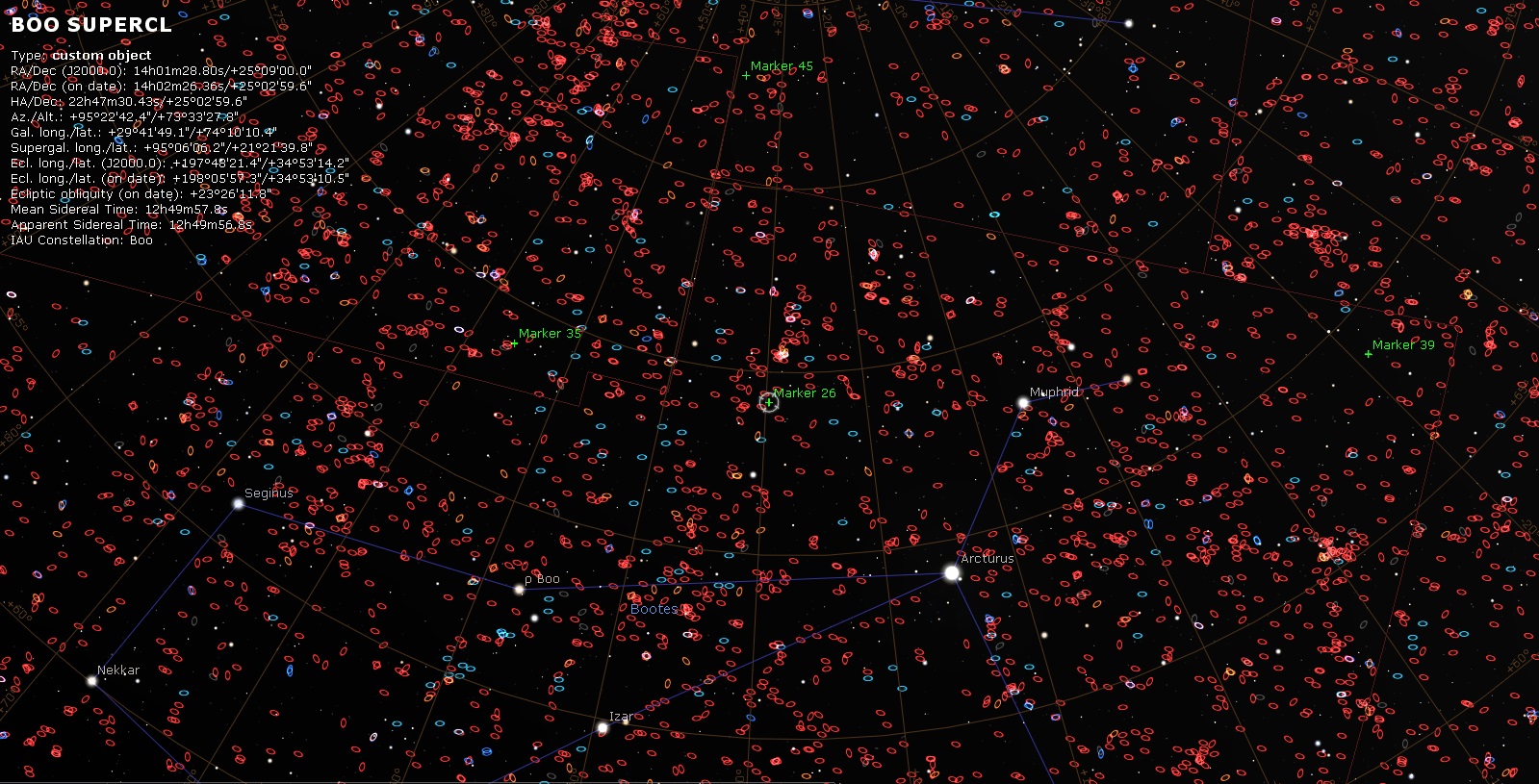
MARKER 26: SCL-138
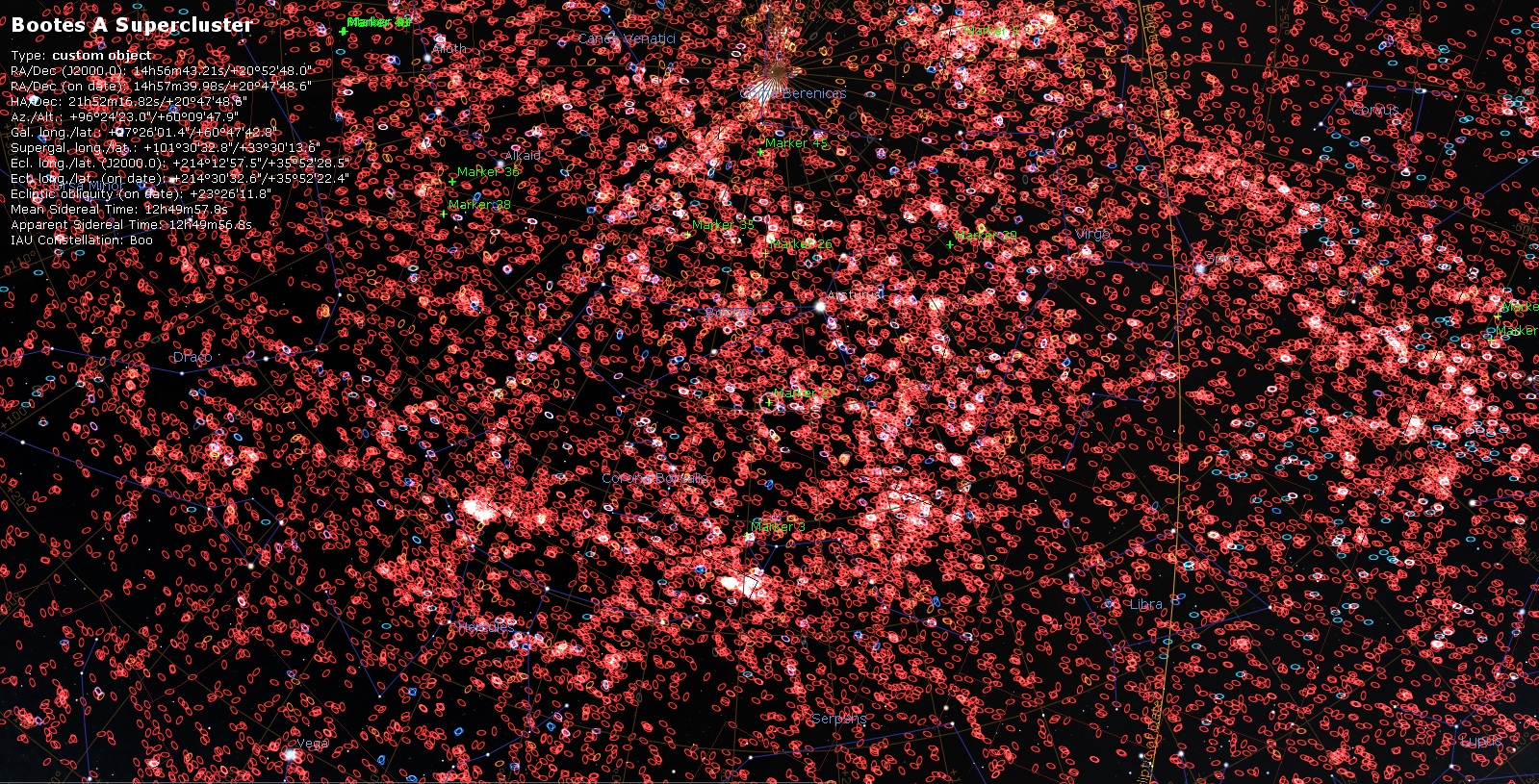
MARKER 27: SCL-150
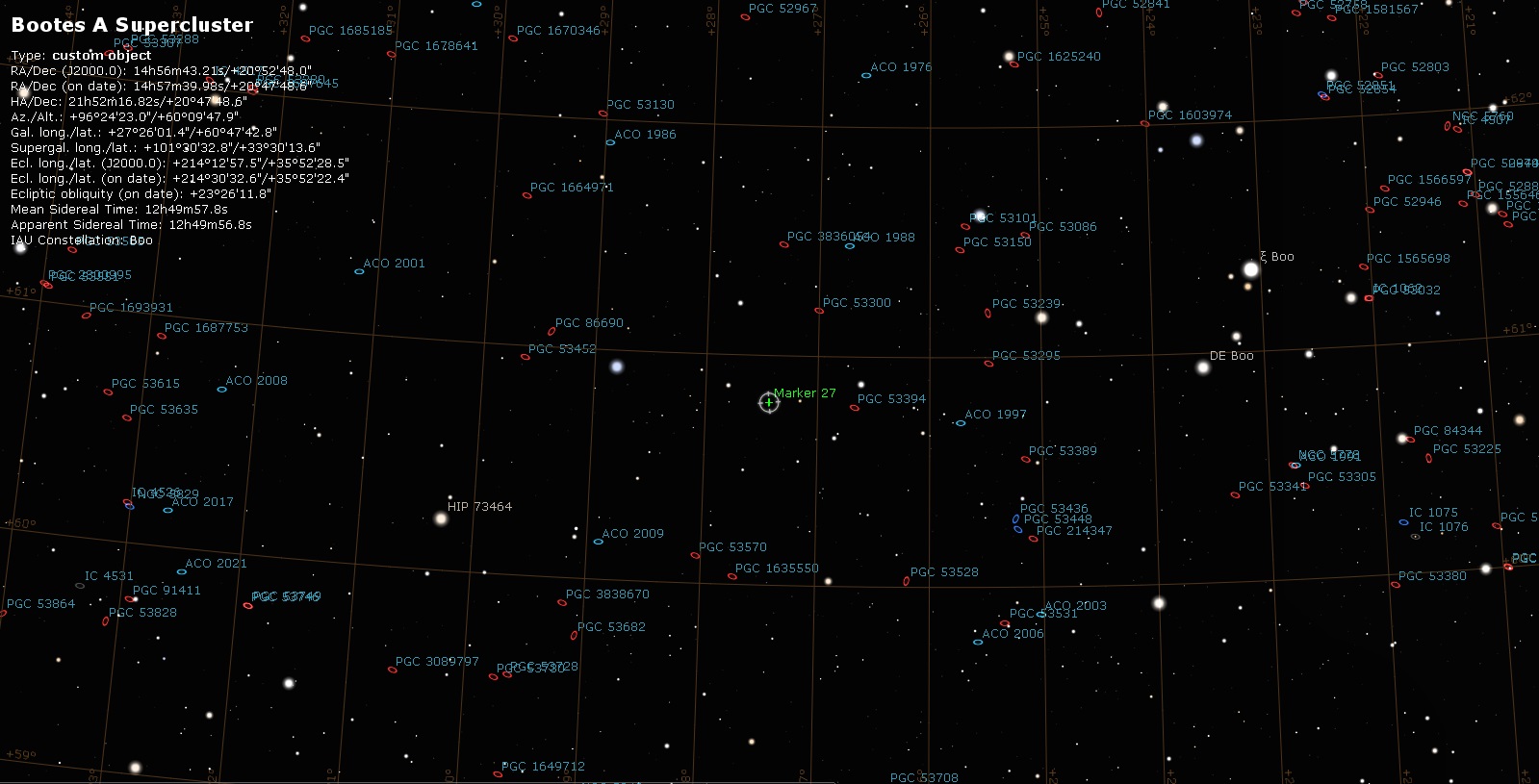
MARKER 27: SCL-150
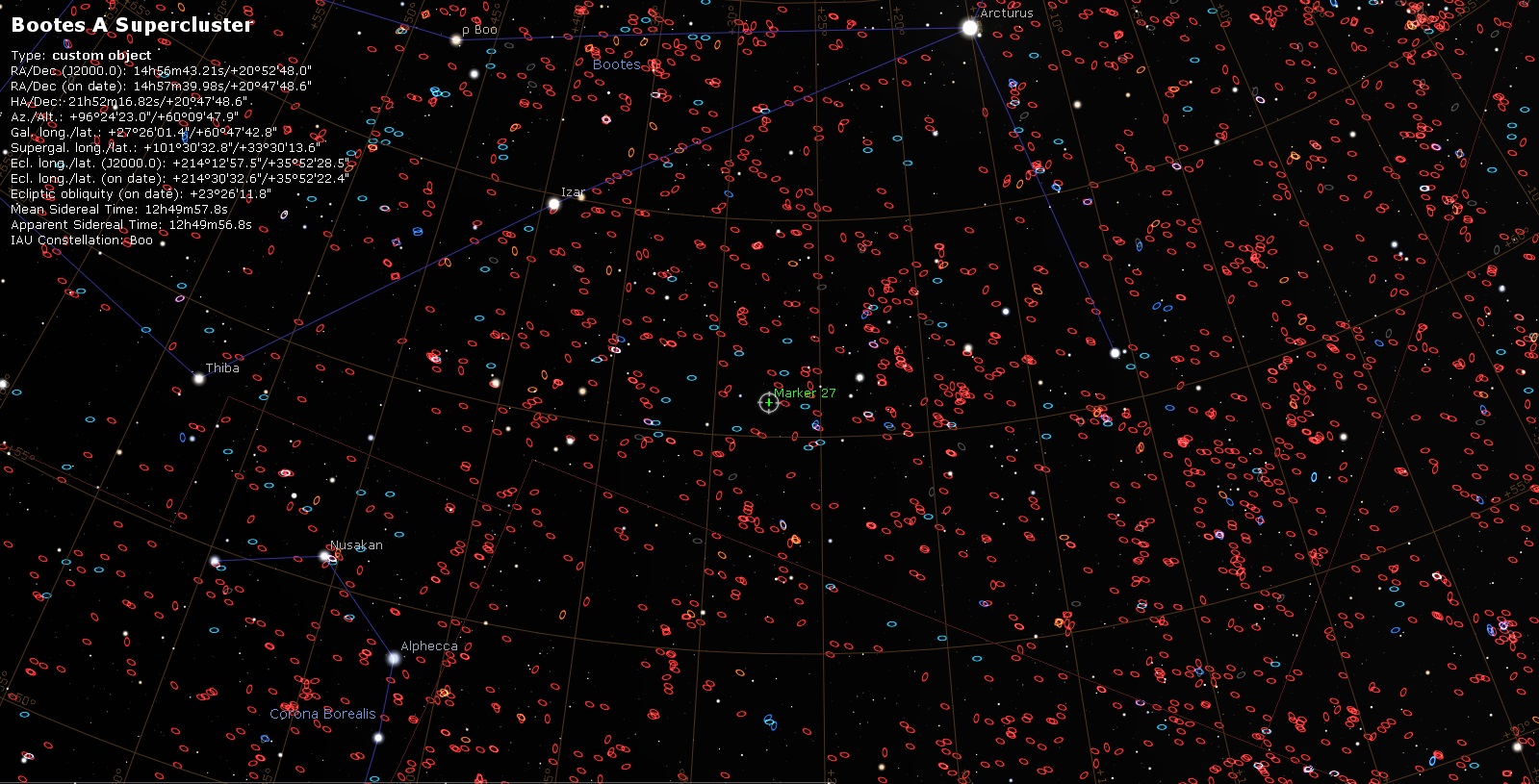
MARKER 27: SCL-150
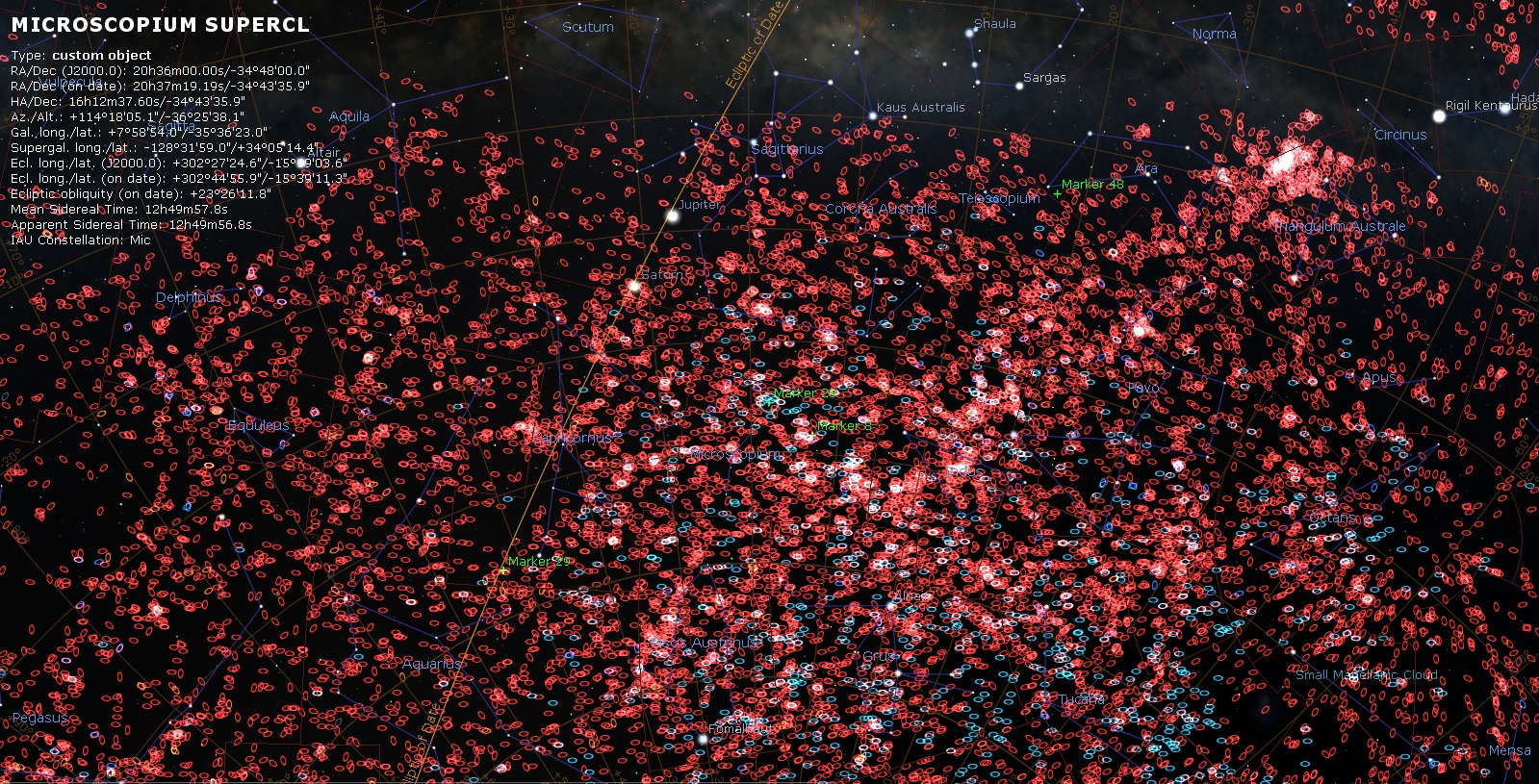
MARKER 28: SCL-174 - MICROSCOPIUM SUPERCLUSTER
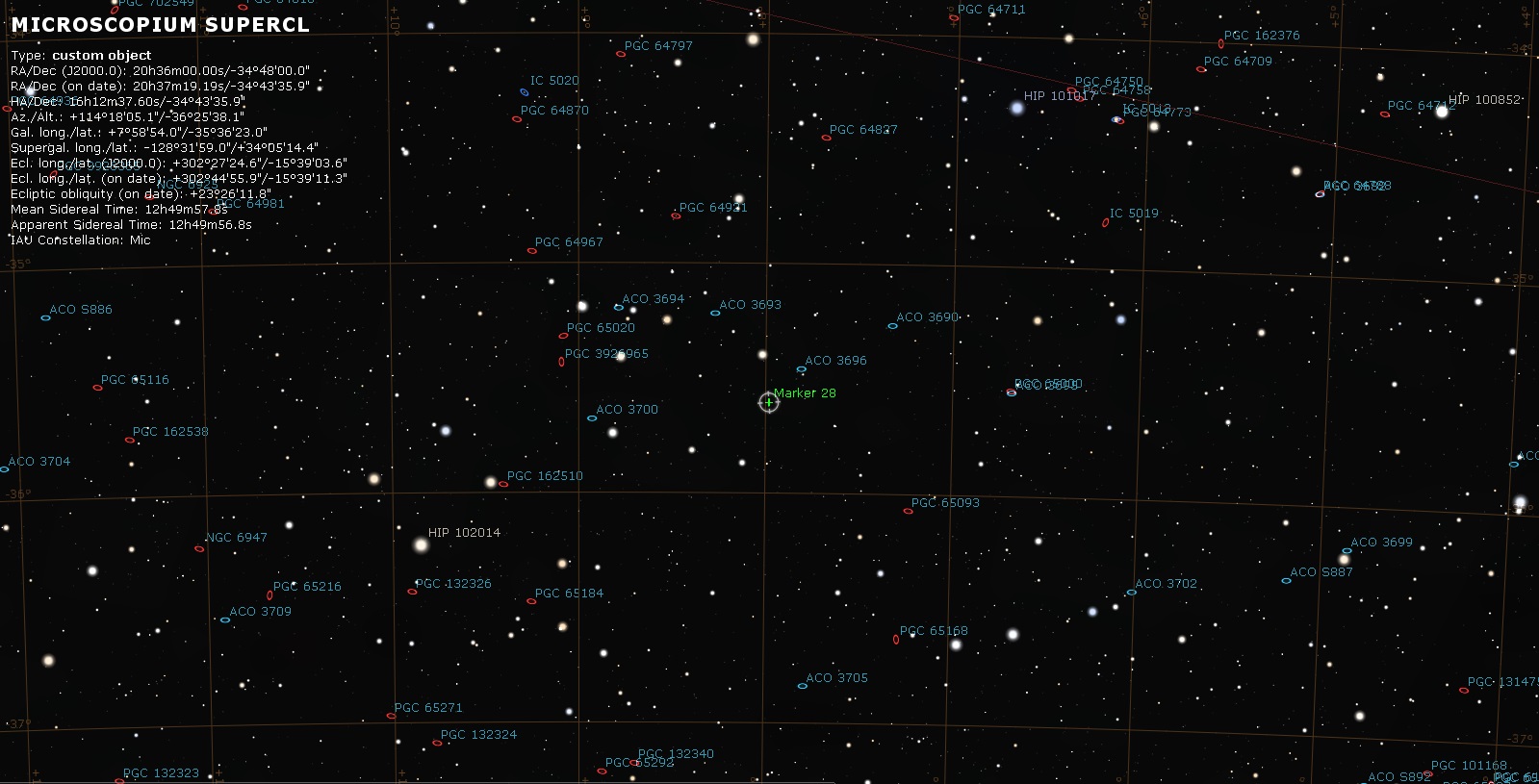
MARKER 28: SCL-174 - MICROSCOPIUM SUPERCLUSTER
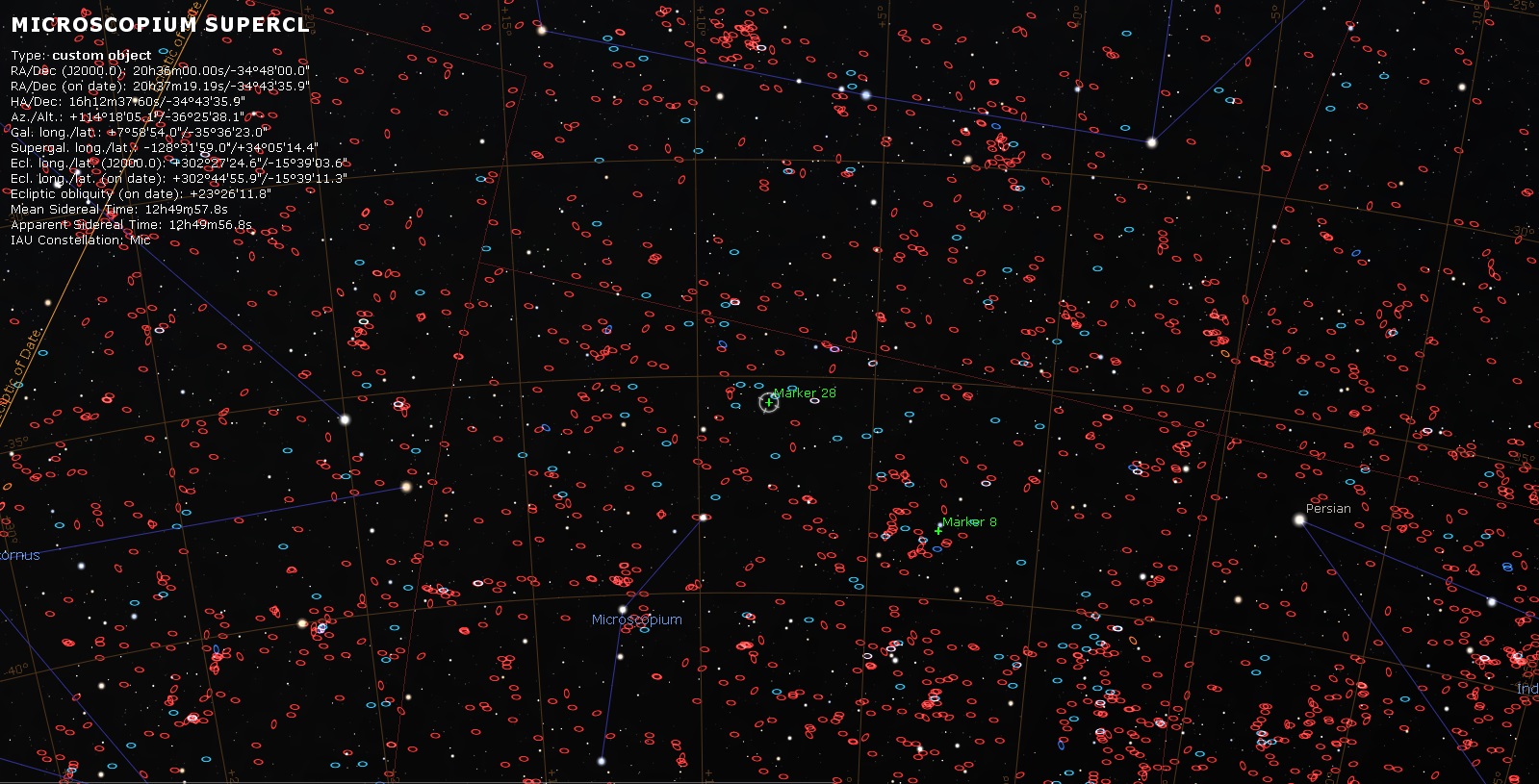
MARKER 28: SCL-174 - MICROSCOPIUM SUPERCLUSTER
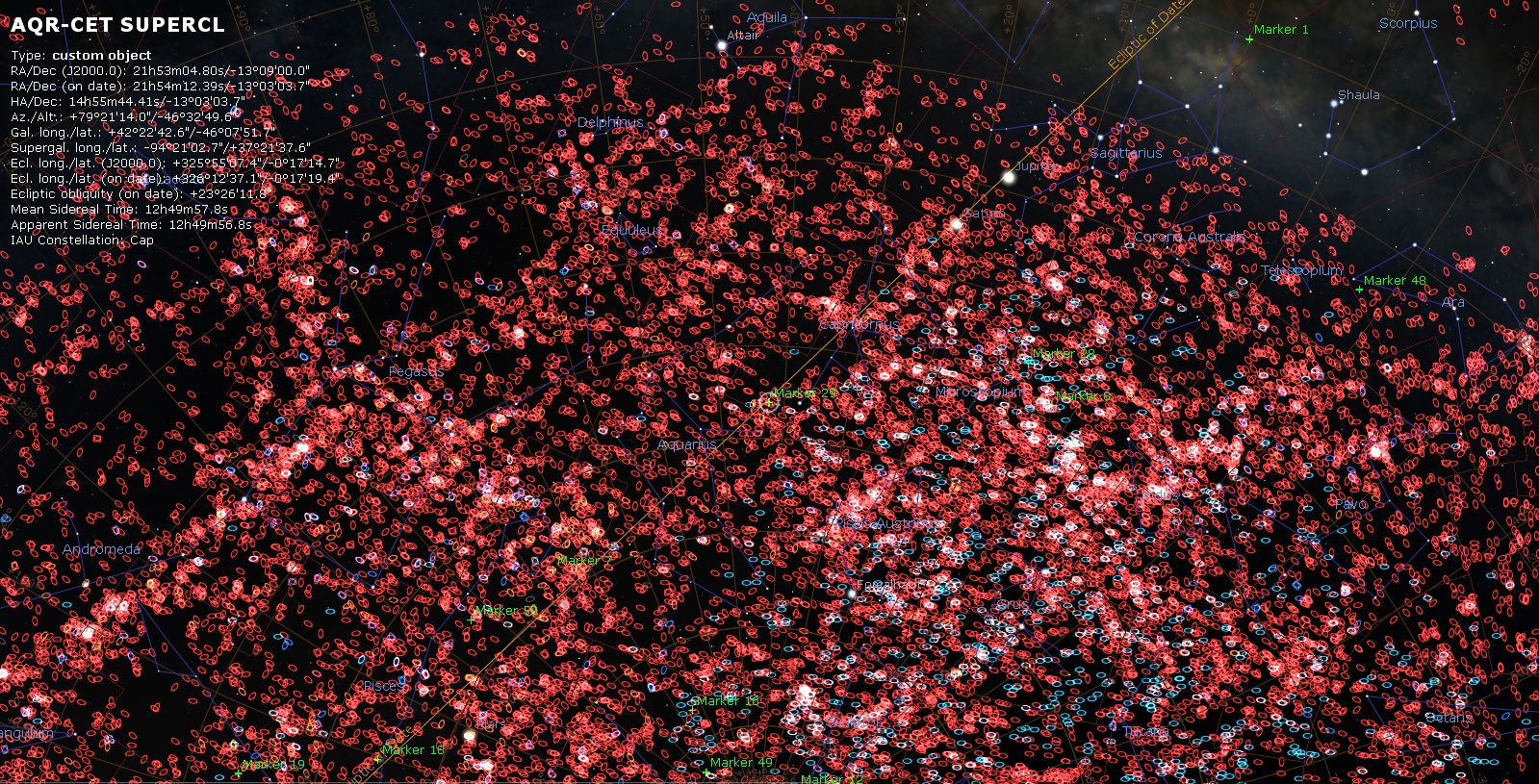
MARKER 29: SCL-188
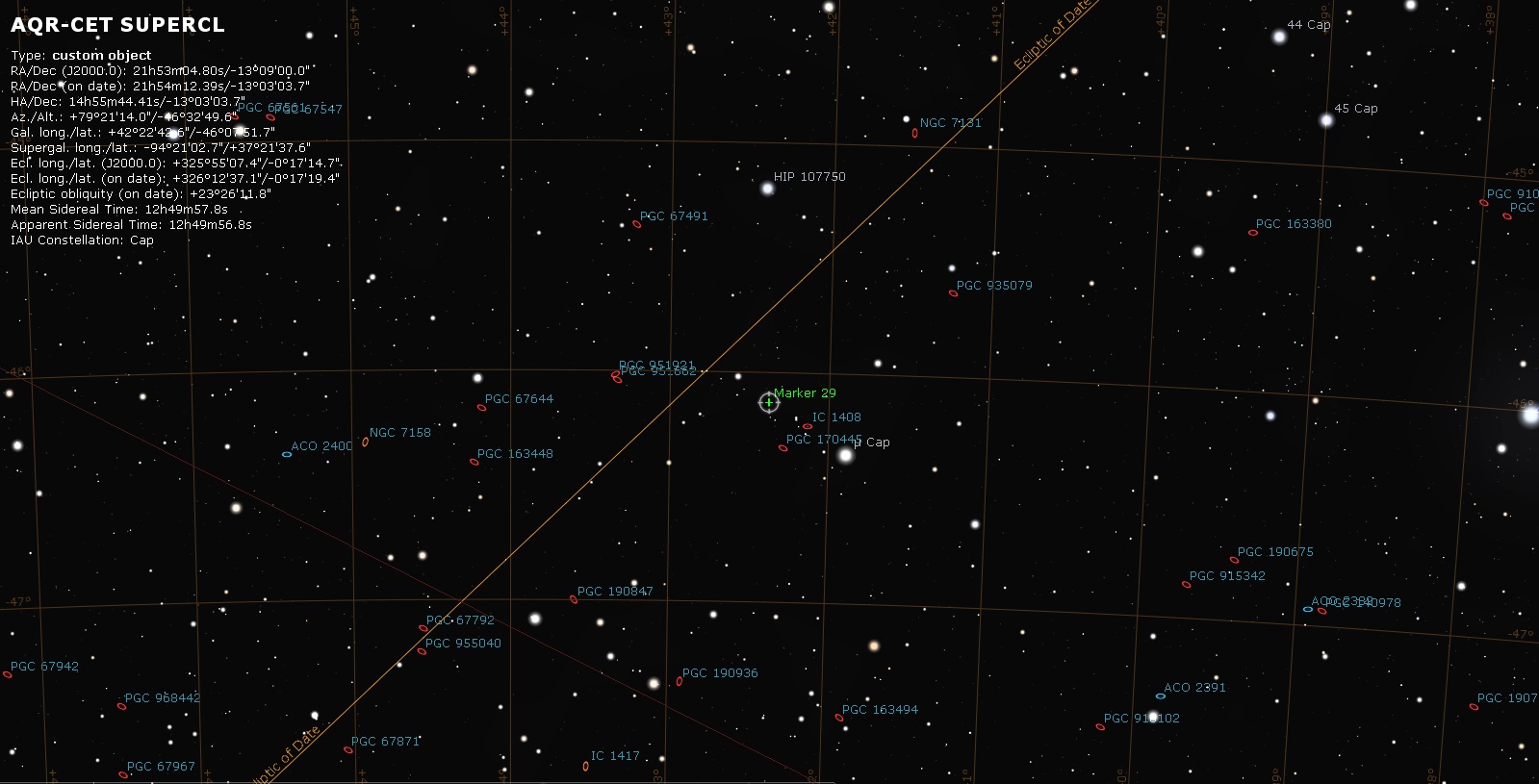
MARKER 29: SCL-188
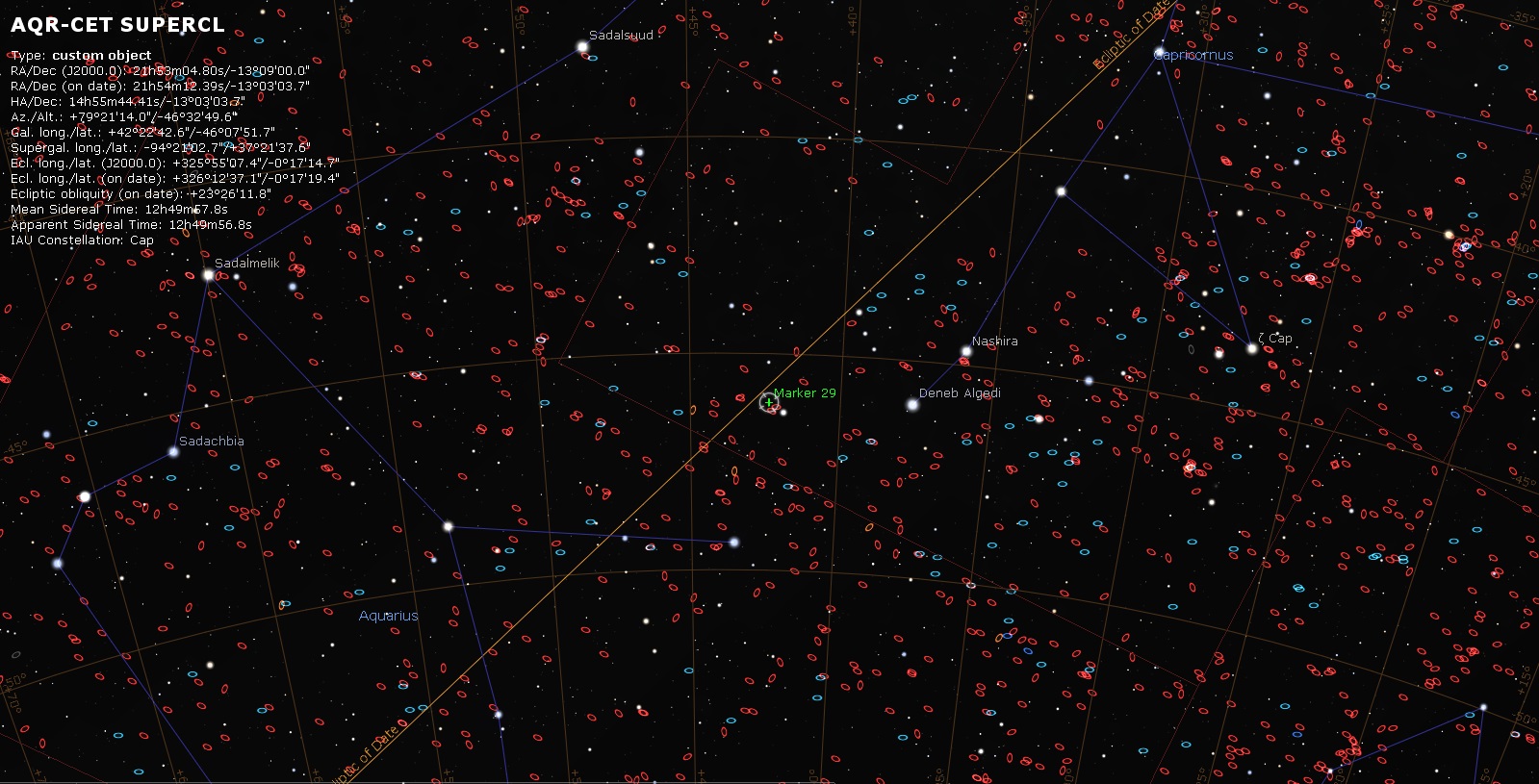
MARKER 29: SCL-188
THE MOST DISTANT OBJECTS
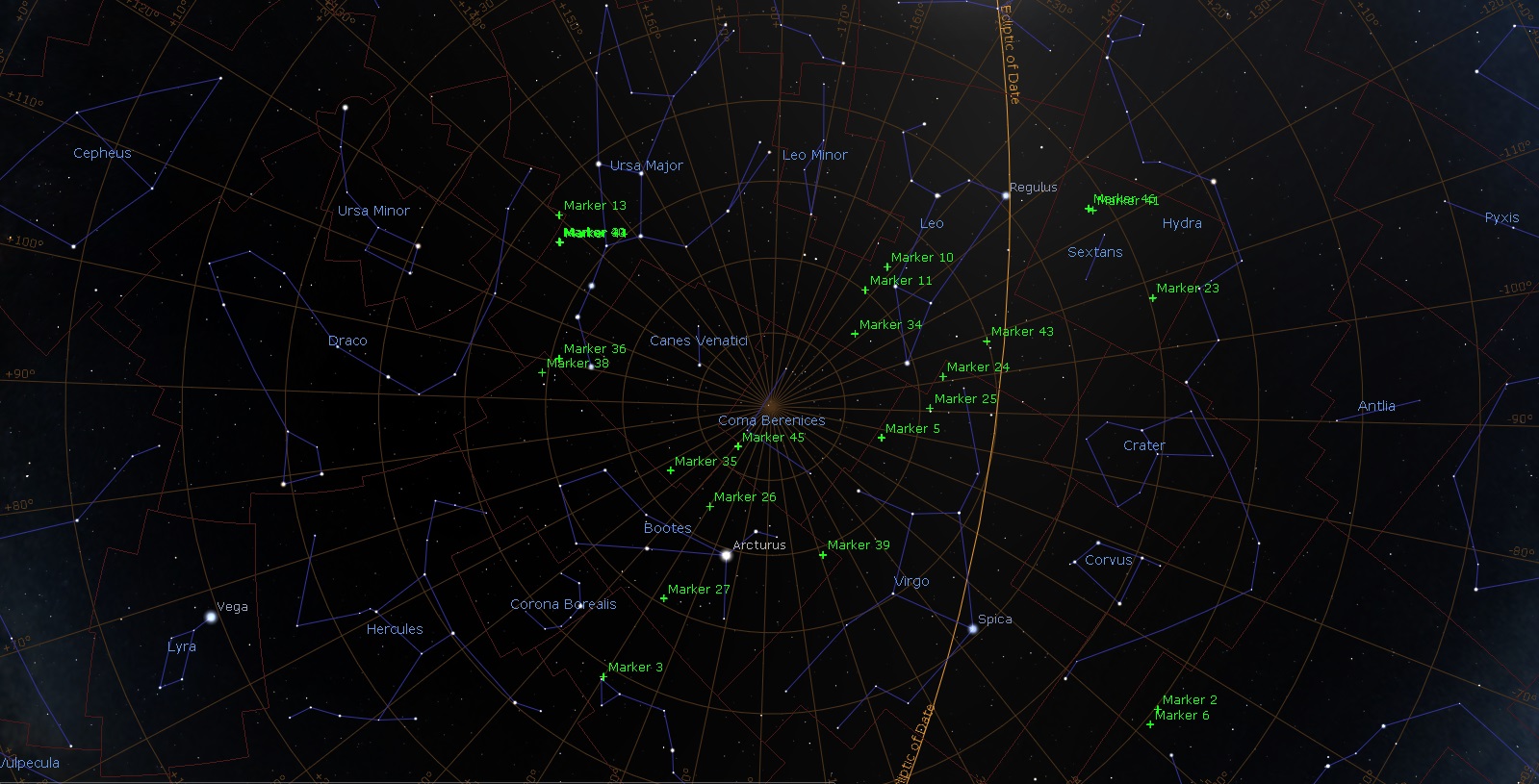
GALACTIC NORTH POLE MAP
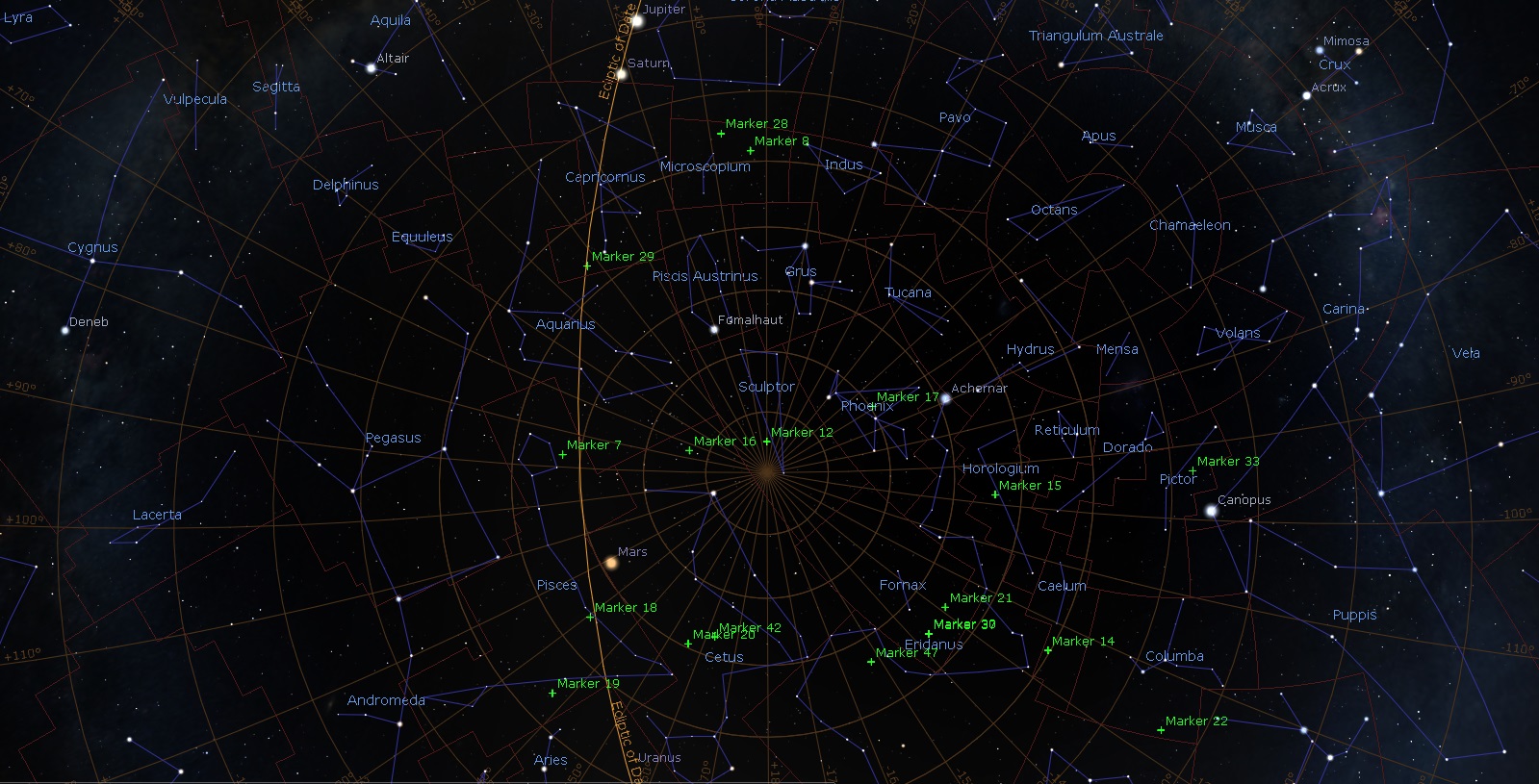
GALACTIC SOUTH POLE MAP
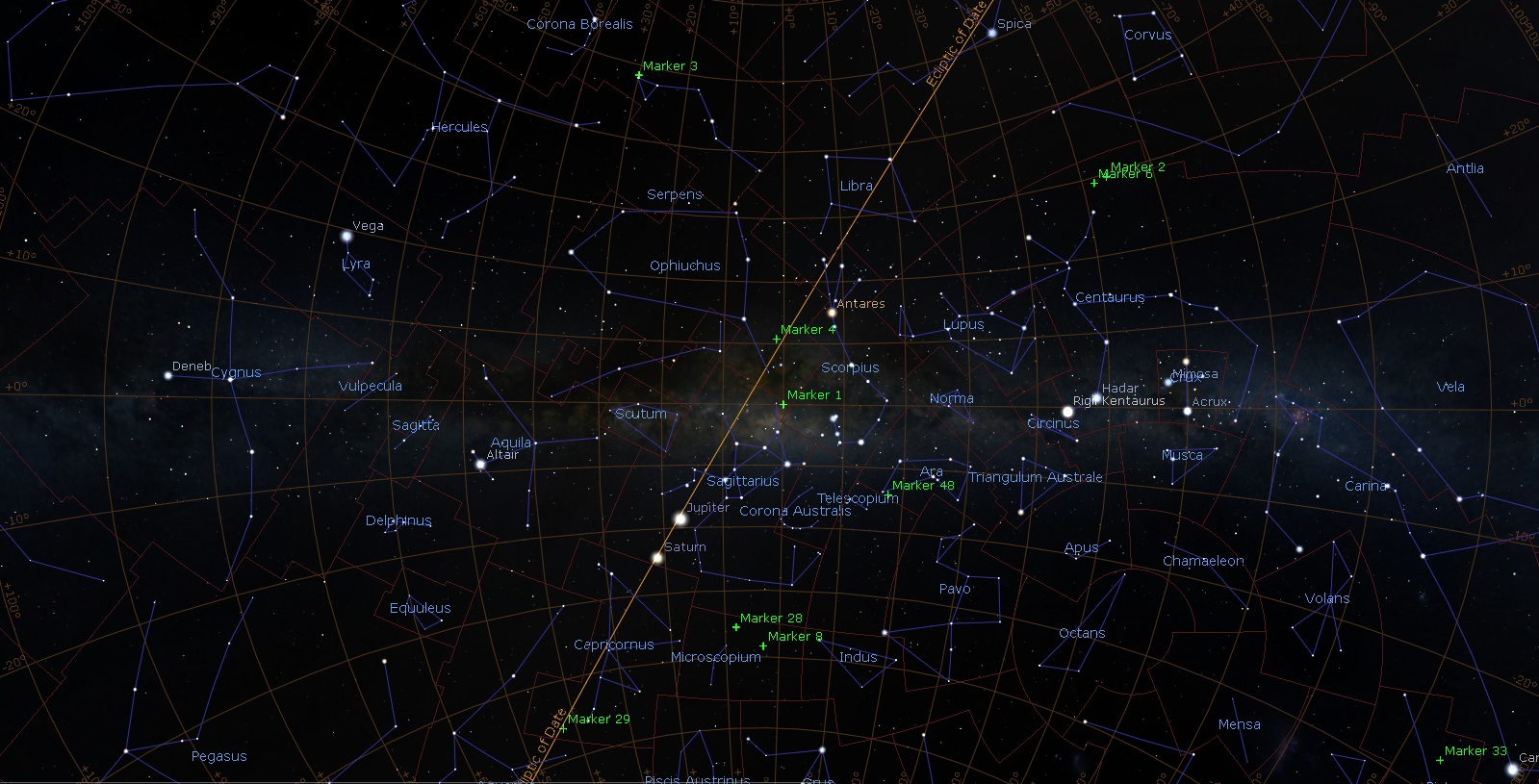
GALACTIC CENTER

GALACTIC 90
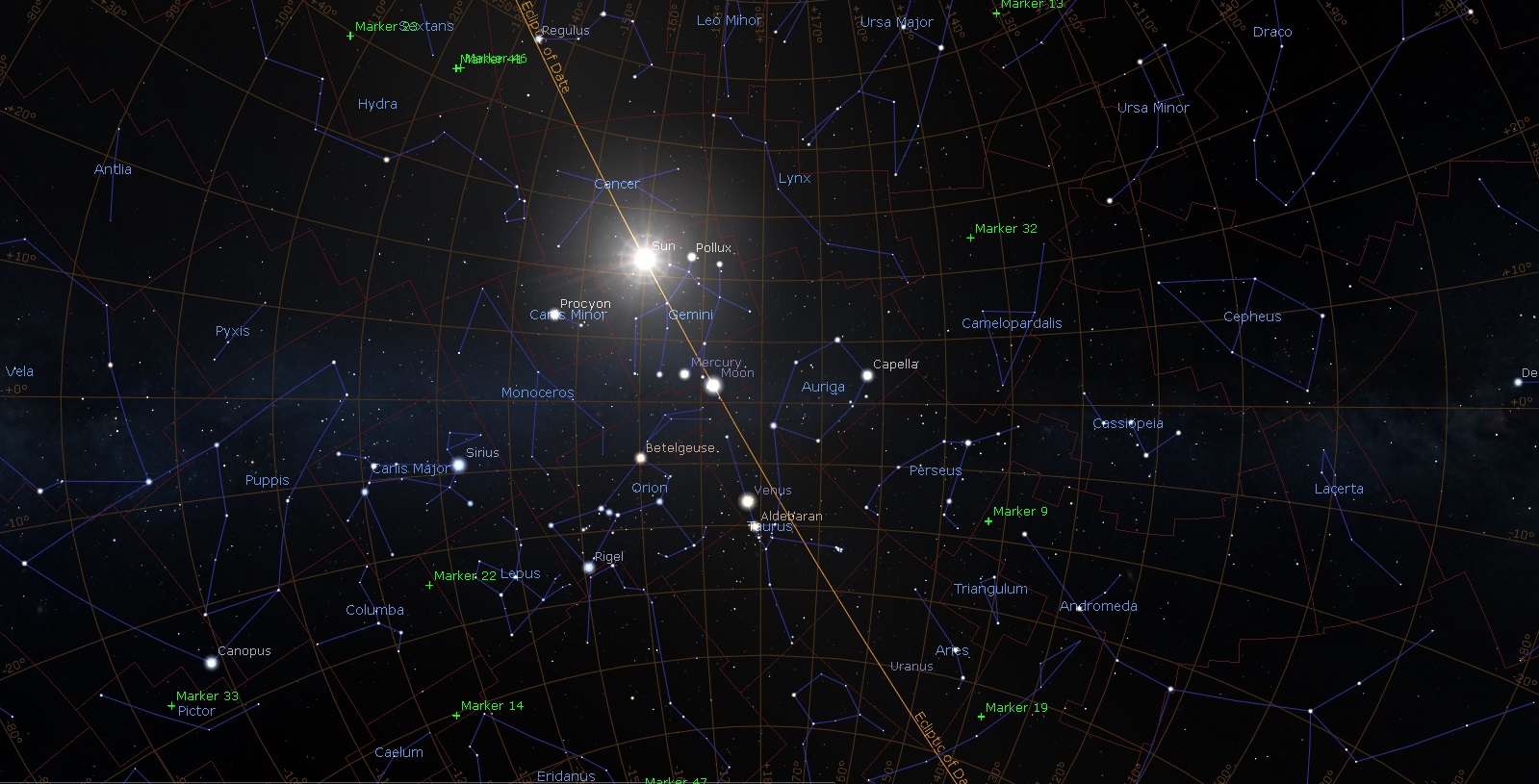
GALACTIC 180
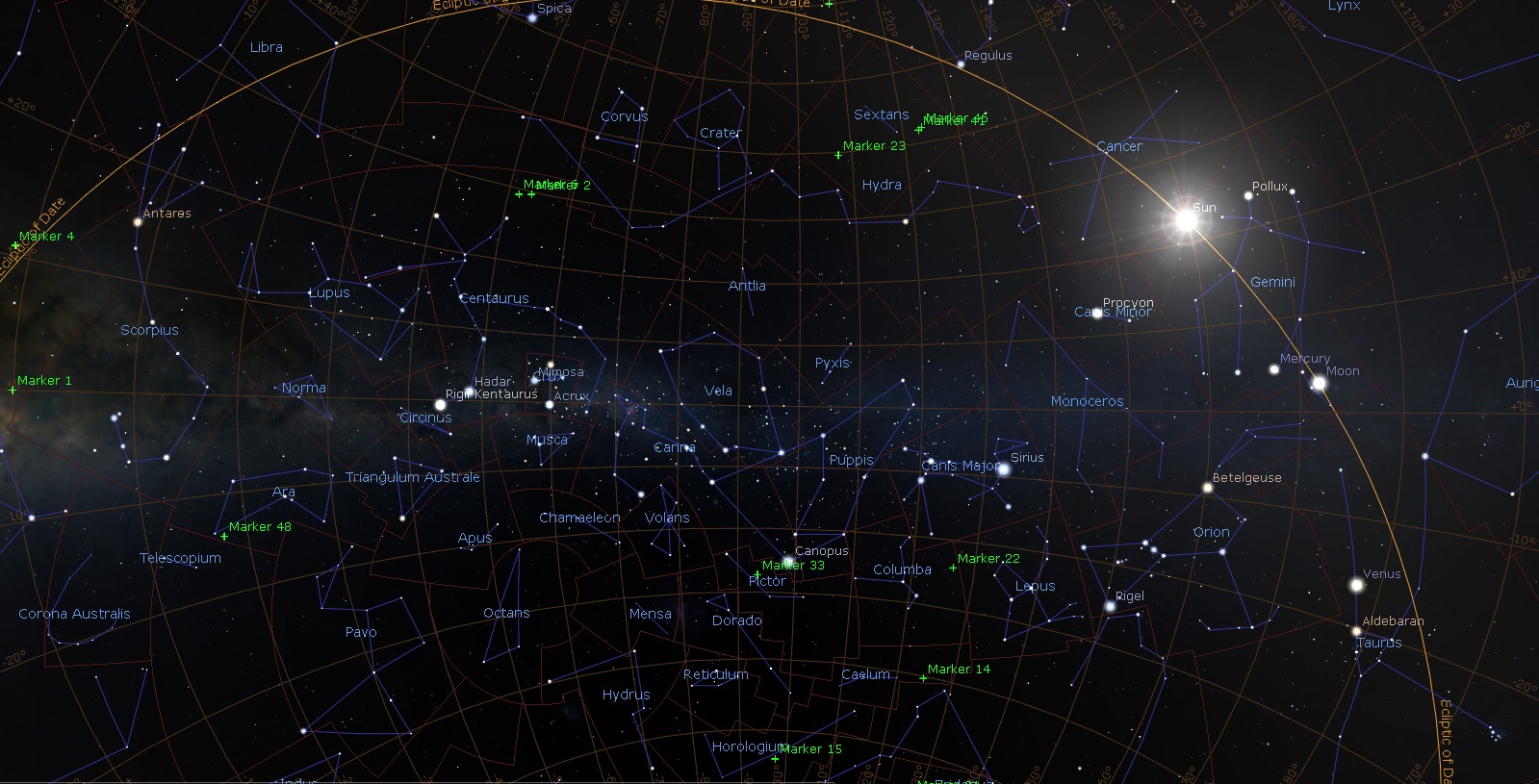
GALACTIC 270
NUMBER ONE - MARKER 30

MARKER 30 - MARKER 37
UDFj-39546284
UDFj-39546284, located in the Fornax constellation.
Constellation: Fornax
Redshift: Uncertain (Z=11.90)
Right ascension: 03h 32m 39.54s
Declination: -27° 46' 28.4?
NUMBER TWO - MARKER 31
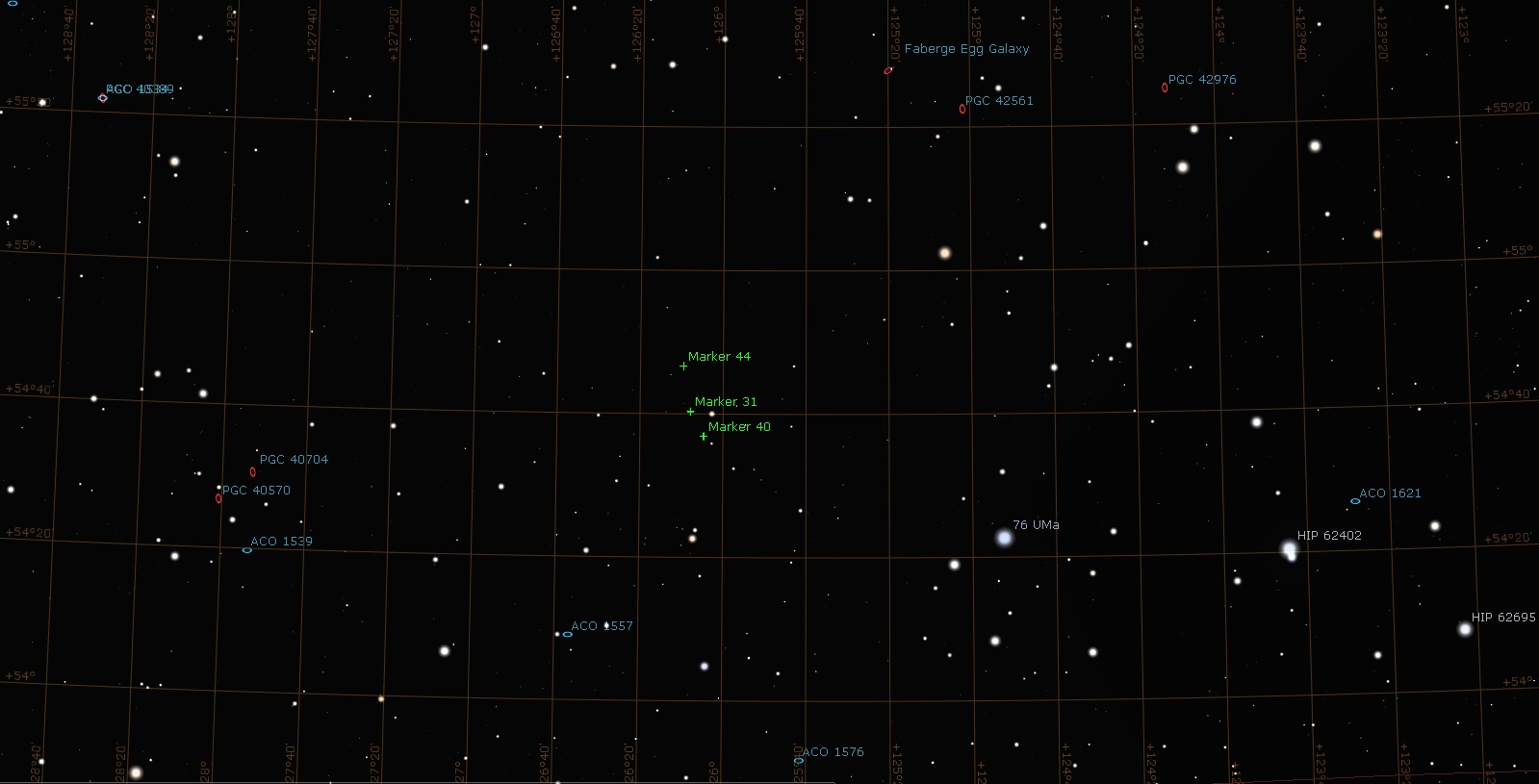
MARKER 31 - MARKER 40 - MARKER 44
GN-z11
GN-z11 is a high-redshift galaxy found in the constellation Ursa Major. GN-z11 is currently the oldest and most distant known galaxy in the observable universe.
Constellation: Ursa Major
Right Ascension: 12h 36m 25.46s
Declination: +62° 14' 31.4?
Redshift: 11.09+0.08
Distance: 13.4 billion ly (4.1 billion pc)(light-travel distance)
Distance: 32 billion ly (9.8 billion pc)(proper distance)
NUMBER THREE - MARKER 32

MARKER 32
MACS0647-JD
MACS0647-JD is the farthest known galaxy from the Earth based on the photometric redshift. It has a redshift of about z = 10.7, equivalent to a light travel distance of 13.26 billion light-years (4 billion parsecs). If the distance estimate is correct, it formed about 427 million years after the Big Bang.
Constellation: Camelopardalis
Right Ascension: 06h 47m 55.73s
Declination: +70° 14' 35.8?
Redshift: 10.7
Distance: 13.3 billion light years
Distance: 32 billion light years (comoving distance)
NUMBER FOUR - MARKER 33
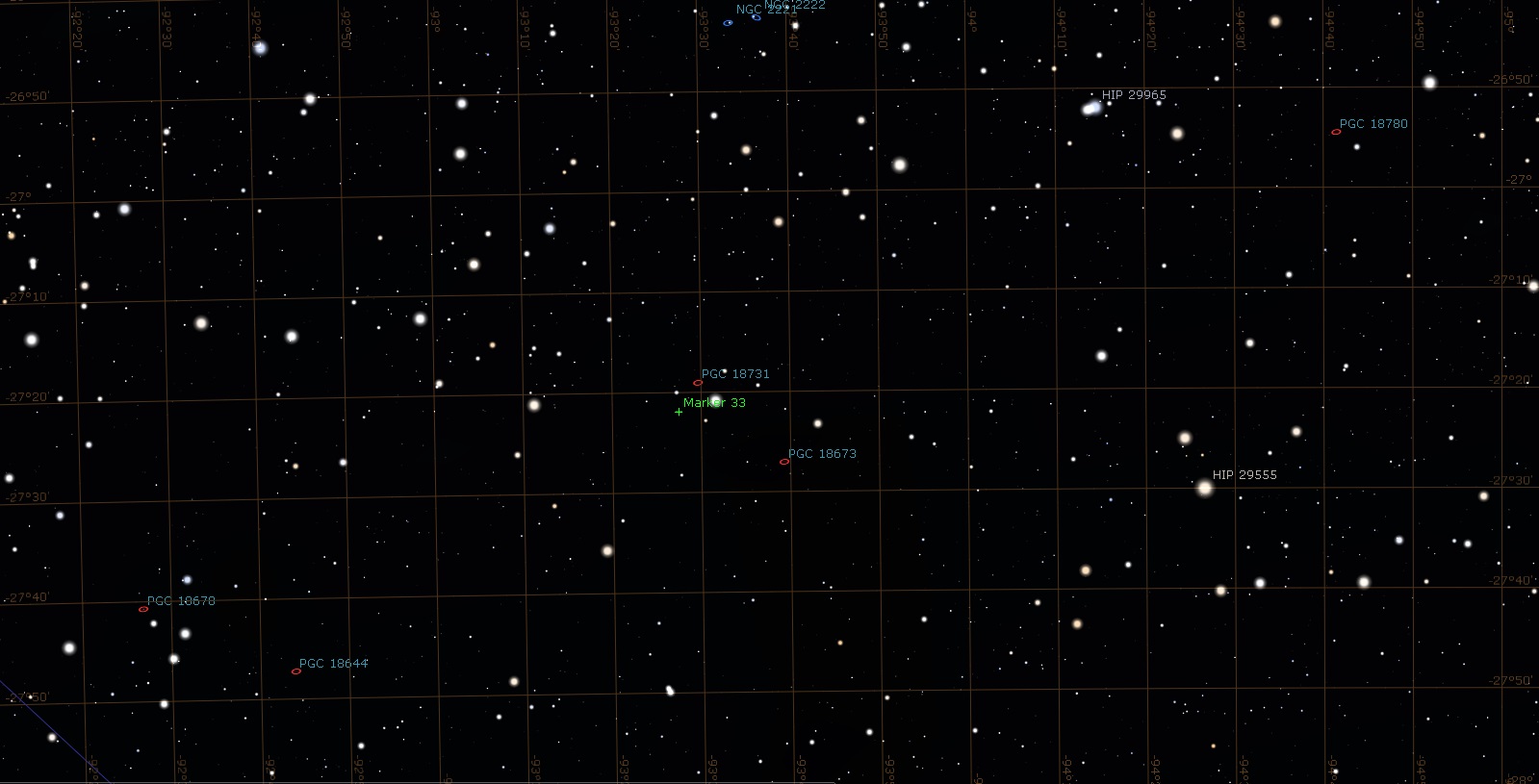
MARKER 33
SPT0615-JD
SPT0615-JD is a dwarf galaxy situated within the constellation Pictor, and is the farthest galaxy ever imaged by means of gravitational lensing.
Constellation: Pictor
Right Ascension: 06h 15m 55.03s
Declination: -57° 46' 19.56?
Redshift: 9.9
Distance: 13.27 billion light-years (light travel time)
Distance: 31.4 billion light-years (comoving distance)
NUMBER FIVE - MARKER 34
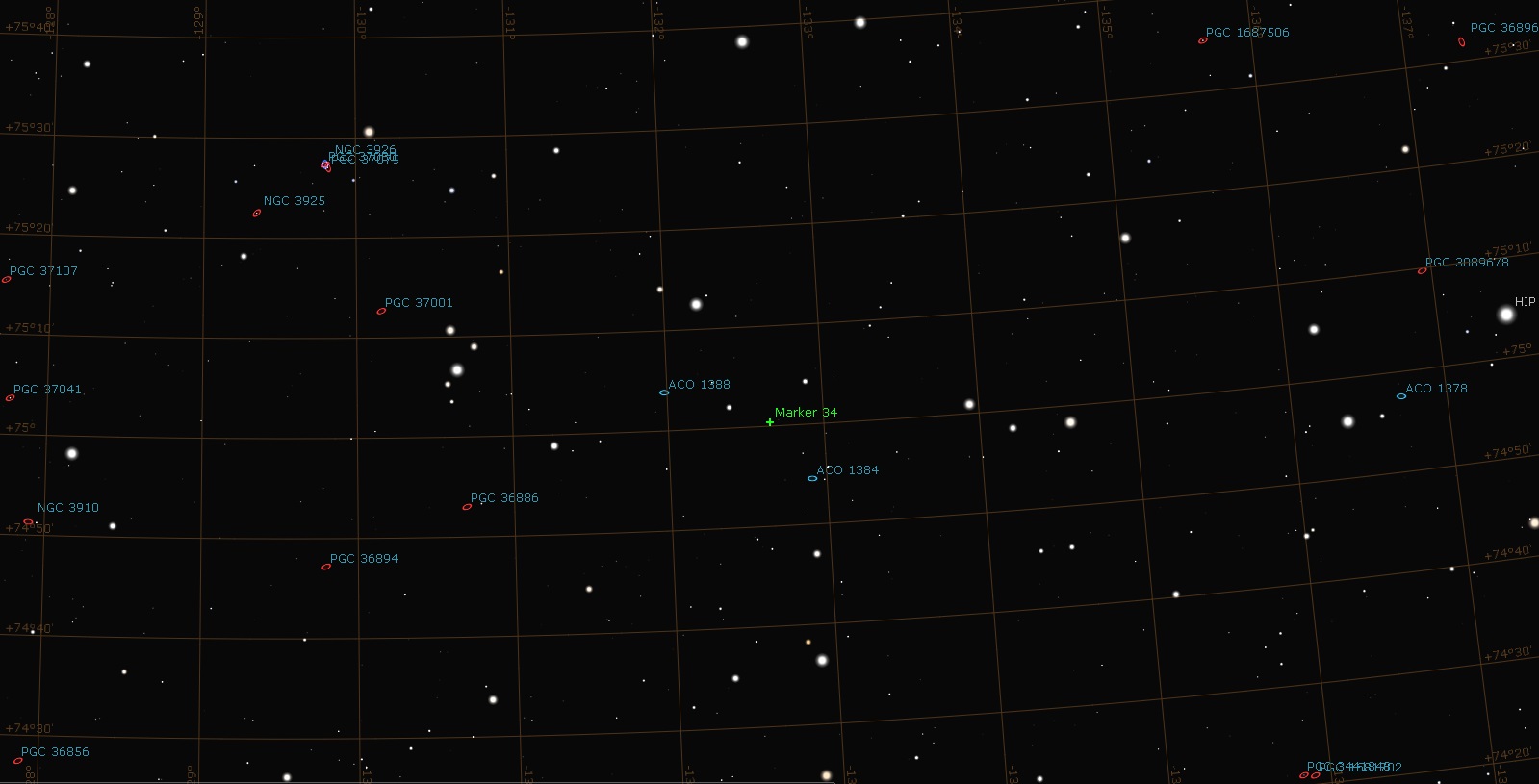
MARKER 34
MACS1149-JD1
MACS1149-JD1 (also known as PCB2012 3020) is one of the farthest known galaxies from Earth and is at a redshift of about z=9.11.
Constellation: Leo
Right Ascension: 11h 49m 33.584s
Declination: +22° 24' 45.78?
Redshift: 9.1096±0.0006
Distance: 13.28 Gly (4.07 Gpc)(light travel)
Distance: 30.37 Gly (9.311 Gpc)(co-moving)
NUMBER SIX - MARKER 35
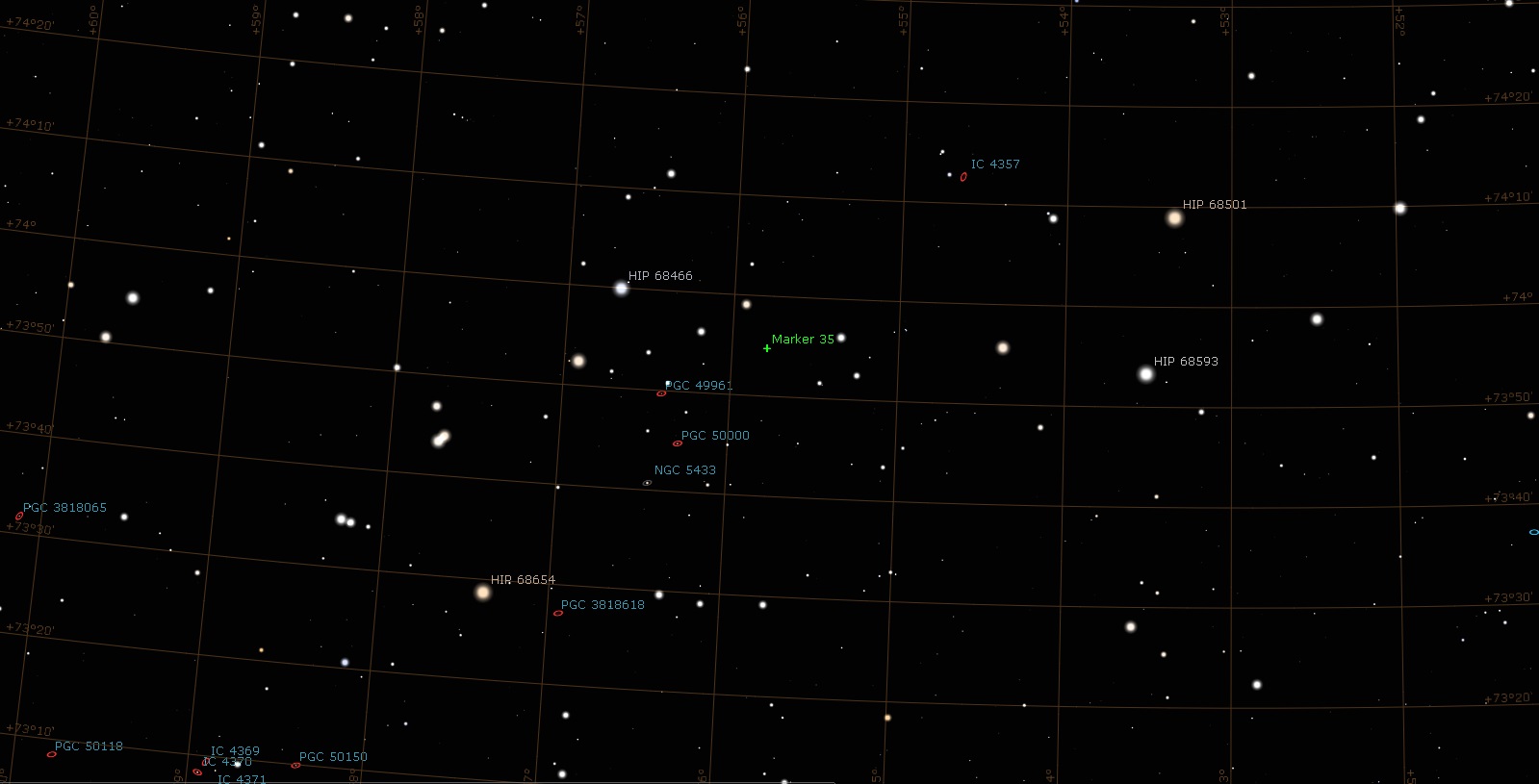
MARKER 35
GRB 090429B
GRB 090429B was a gamma-ray burst observed on 29 April 2009.
Constellation: Canes Venatici
Right Ascension: 14h 02m 40.10s
Declination: +32° 10' 14.6?
Redshift: 9.06
Distance: 13.14 billion light-years
Total energy output 3.5 × 1052 erg
NUMBER SEVEN - MARKER 36
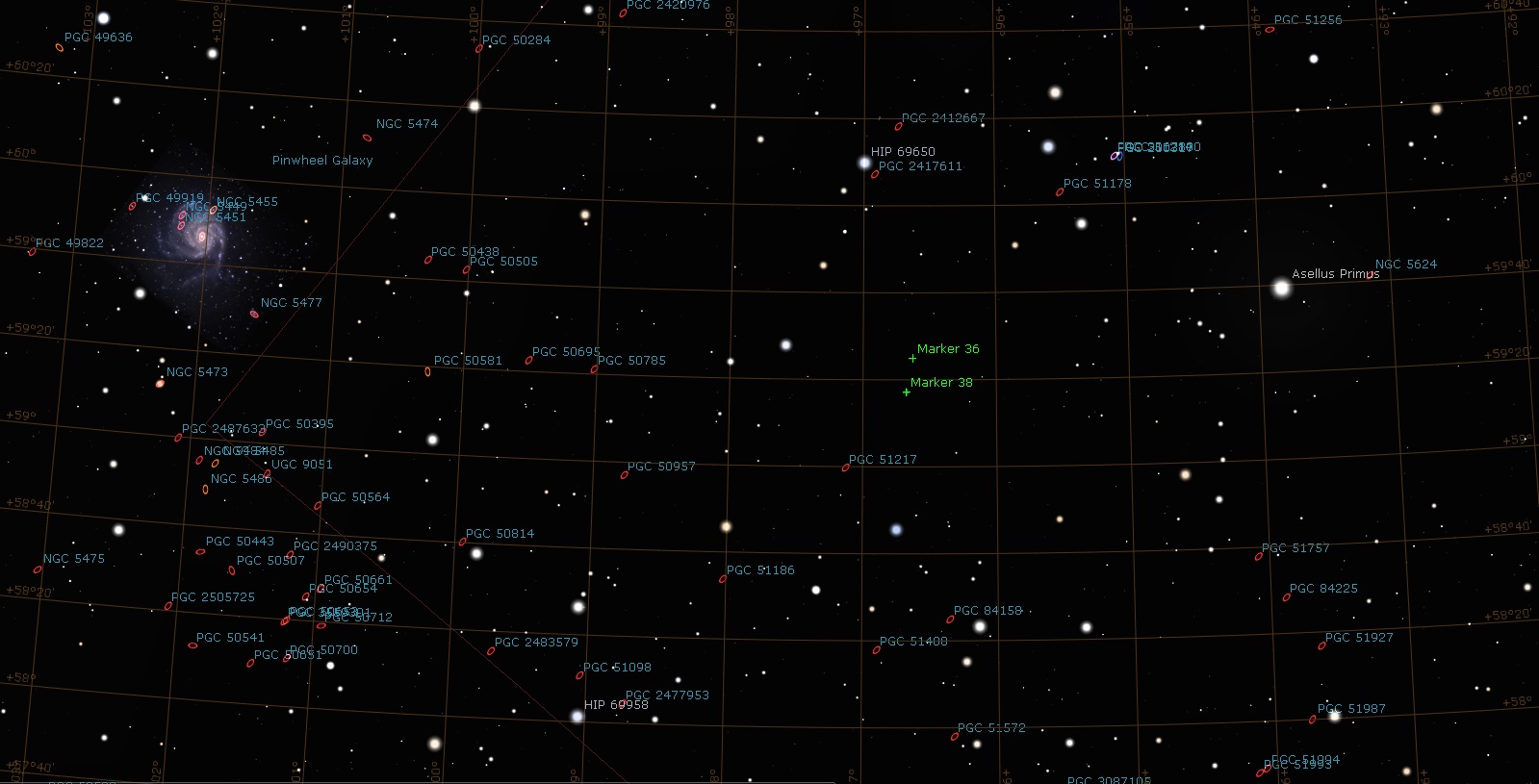
MARKER 36 - MARKER 38
EGSY8p7
EGSY8p7 (EGSY-2008532660) is a distant galaxy in the constellation of Boötes, with a spectroscopic redshift of z = 8.68 (photometric redshift 8.57), a light travel distance of 13.2 billion light-years from Earth. Therefore, at an age of 13.2 billion years, it is observed as it existed 570 million years after the Big Bang.
Right Ascension: 14h 20m 08.50s
Declination: +52° 53' 26.60?
Redshift: 8.68
Distance: 13.2 billion ly (4.0 billion pc)(light travel distance)
Distance: 30.5 billion ly (9.4 billion pc)(co-moving distance)
NUMBER EIGHT - MARKER 37
EGSY8p7
The galaxy UDFy-38135539 is located in the constellation Fornax, and is estimated to have contained roughly a billion stars.
Constellation: Fornax
Right Ascension: 03h 32m 38.13s
Declination: -27° 45' 53.9?
Redshift: 8.6
Distance: 13.1 billion light-years (4.0 billion parsecs)(light travel distance)
Distance: 30 billion light-years (9.0 billion parsecs)(present proper distance)
NUMBER NINE - MARKER 38
EGS-zs8-1
EGS-zs8-1 is a high-redshift Lyman-break galaxy found at the northern constellation of Boötes. In May 2015, EGS-zs8-1 had the highest spectroscopic redshift of any known galaxy, meaning EGS-zs8-1 was the most distant and the oldest galaxy observed.
Constellation: Boötes
Right Ascension: 14h 20m 34.89s
Declination: +53° 00' 15.4?
Redshift: 7.7
Distance: 13 billion ly (4.0 billion pc) (light travel distance)
Distance: 29.5 billion ly (9.0 billion pc)(comoving distance)
NUMBER TEN - MARKER 39
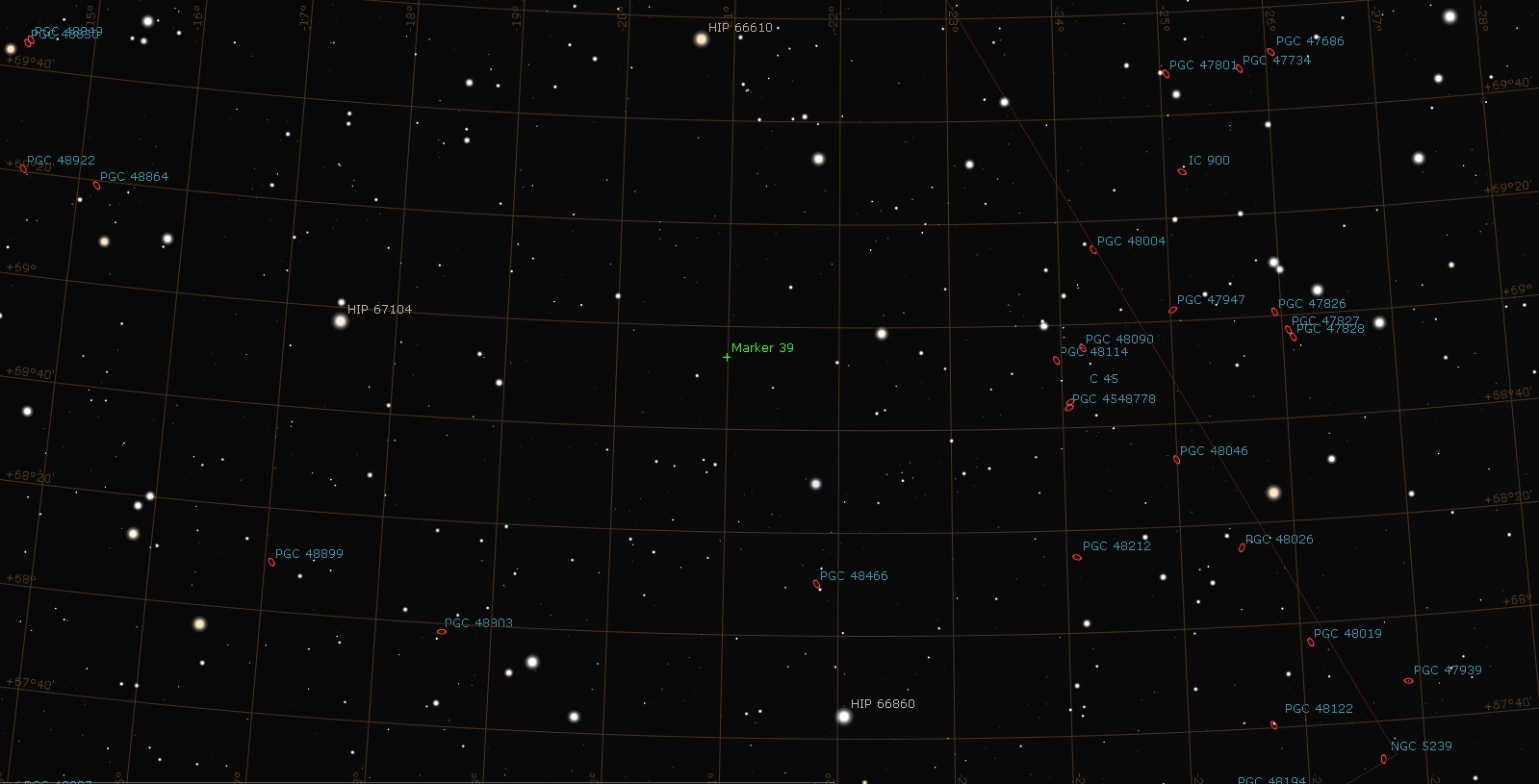
MARKER 39
ULAS J1342+0928
ULAS J1342+0928 is the most distant known quasar detected and contains the most distant and oldest known supermassive black hole, at a reported redshift of z = 7.54, surpassing the redshift of 7 for the previously known most distant quasar ULAS J1120+0641.
Constellation: Boötes
Right Ascension: 13h 42m 08.10s
Declination: +09° 28' 38.61?
Redshift: 7.54
Distance: 13.1 Gly (4.0 Gpc)(light travel distance)
Distance: 29.36 Gly (9.00 Gpc)(comoving distance)
NUMBER ELEVEN - MARKER 40
z8_GND_5296
z8_GND_5296 is a dwarf galaxy discovered in October 2013 which has the highest redshift that has been confirmed through the Lyman-alpha emission line of hydrogen, placing it among the oldest and most distant known galaxies at approximately 13.1 billion light-years (4.0 Gpc) from Earth. It is "seen as it was at a time just 700 million years after the Big Bang.
Constellation: Ursa Major
Right Ascension: 12h 36m 37.892s
Declination: +62° 18' 08.54?
Redshift: 7.5078±0.0004
Distance: 13.1 billion ly (4.0 billion pc)(light travel distance)
Distance: 30 billion ly (9.2 billion pc)(comoving distance)
NUMBER TWELVE - MARKER 41
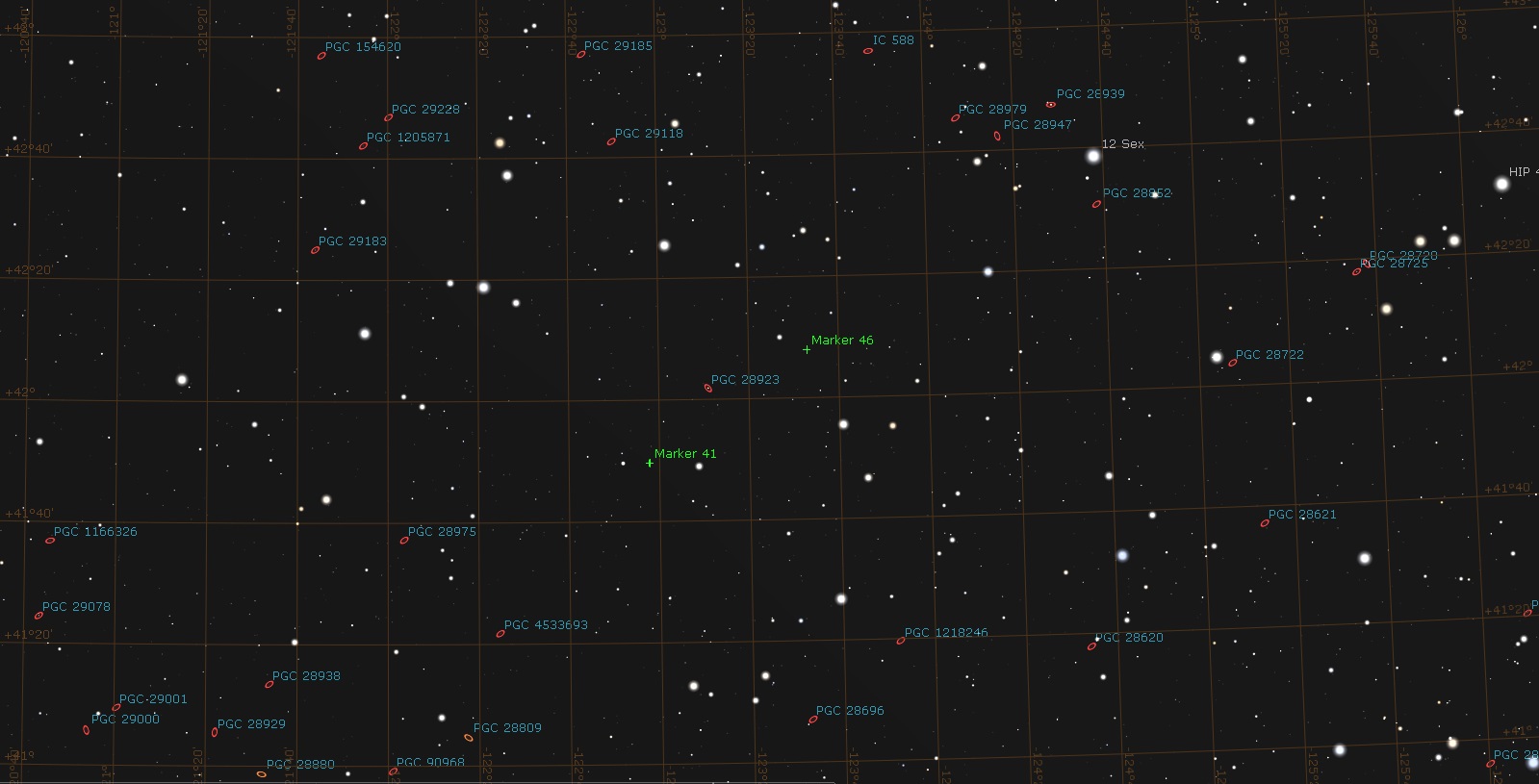
MARKER 41 - MARKER 46
CR7
Cosmos Redshift 7 (also known as COSMOS Redshift 7, Galaxy Cosmos Redshift 7, Galaxy CR7 or CR7) is a high-redshift Lyman-alpha emitter galaxy. At a redshift z = 6.6, the galaxy is observed as it was about 800 million years after the Big Bang, during the epoch of reionisation.
Constellation: Sextans
Right Ascension: 10h 00m 58.005s
Declination: +01° 48' 15.251?
Redshift: 6.604
Distance: 12.9 billion light-years
NUMBER TWELVE - MARKER 42
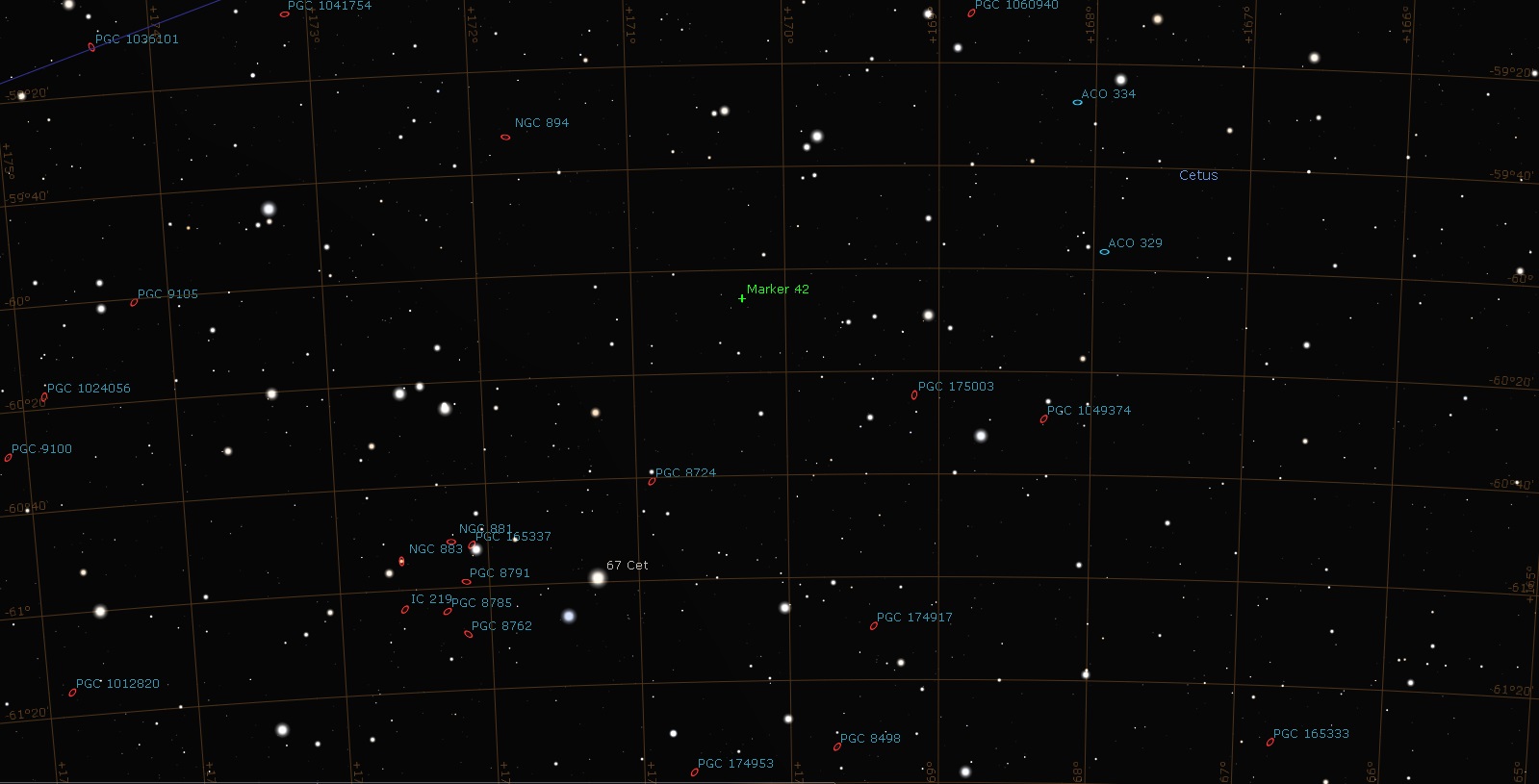
MARKER 42
z8_GND_5296
SXDF-NB1006-2 is a distant galaxy located in the Cetus constellation, with a spectroscopic redshift of z = 7.213 or 12.91 billion light-years away.
Constellation: Cetus
Right Ascension: 02h 18m 56.5s
Declination: -05° 19' 58.9?
Redshift: 7.213
Distance: 12.9 billion light-years(light travel distance)
Distance: 29 billion light-years(proper distance)
NUMBER THIRTEEN - MARKER 43
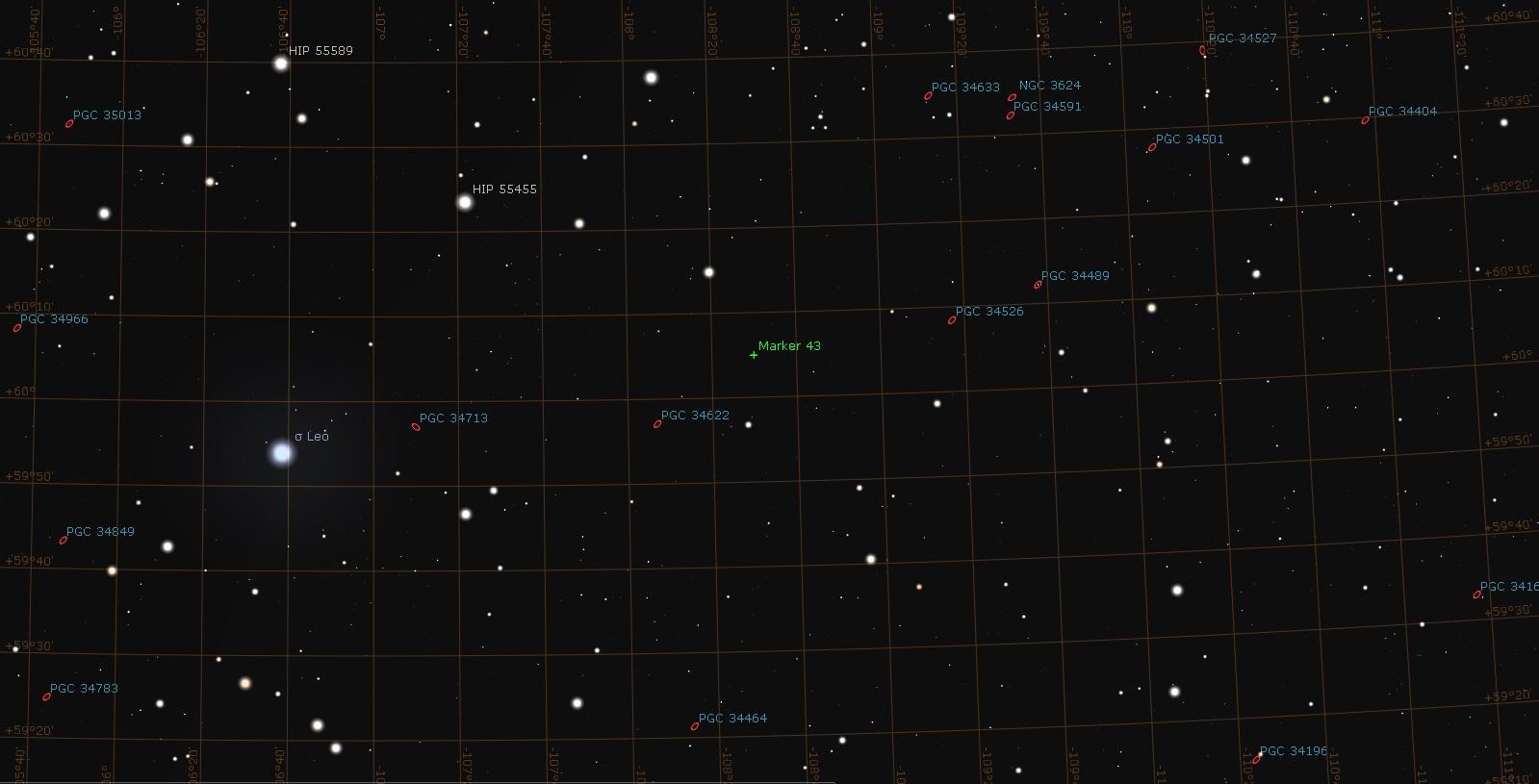
MARKER 43
ULAS J1120+0641
ULAS J1120+0641 is the second most distant known quasar as of 6 December 2017.
Constellation: Leo
Right Ascension: 11h 20m 01.48s
Declination: +06° 41' 24.3?
Redshift: 7.085±0.003
Distance: 12.9 Gly (4.0 Gpc) (light travel)
Distance: 28.85 Gly (8.85 Gpc) (co-moving)
NUMBER FOURTEEN - MARKER 44
GN-108036
GN-108036 is a distant galaxy;the redshift was z = 7.2, its formation dates back to 750 million years after the Big Bang.
Constellation: Ursa Major
Right Ascension: 12h 36m 22.68s
Declination: +62° 08' 07.5?
Redshift: 7.2
Distance: 12.9 billion ly (4.0 billion pc)(light travel distance)
Distance: 29 billion ly (8.9 billion pc)(present proper distance)
NUMBER FIFTEEN - MARKER 45
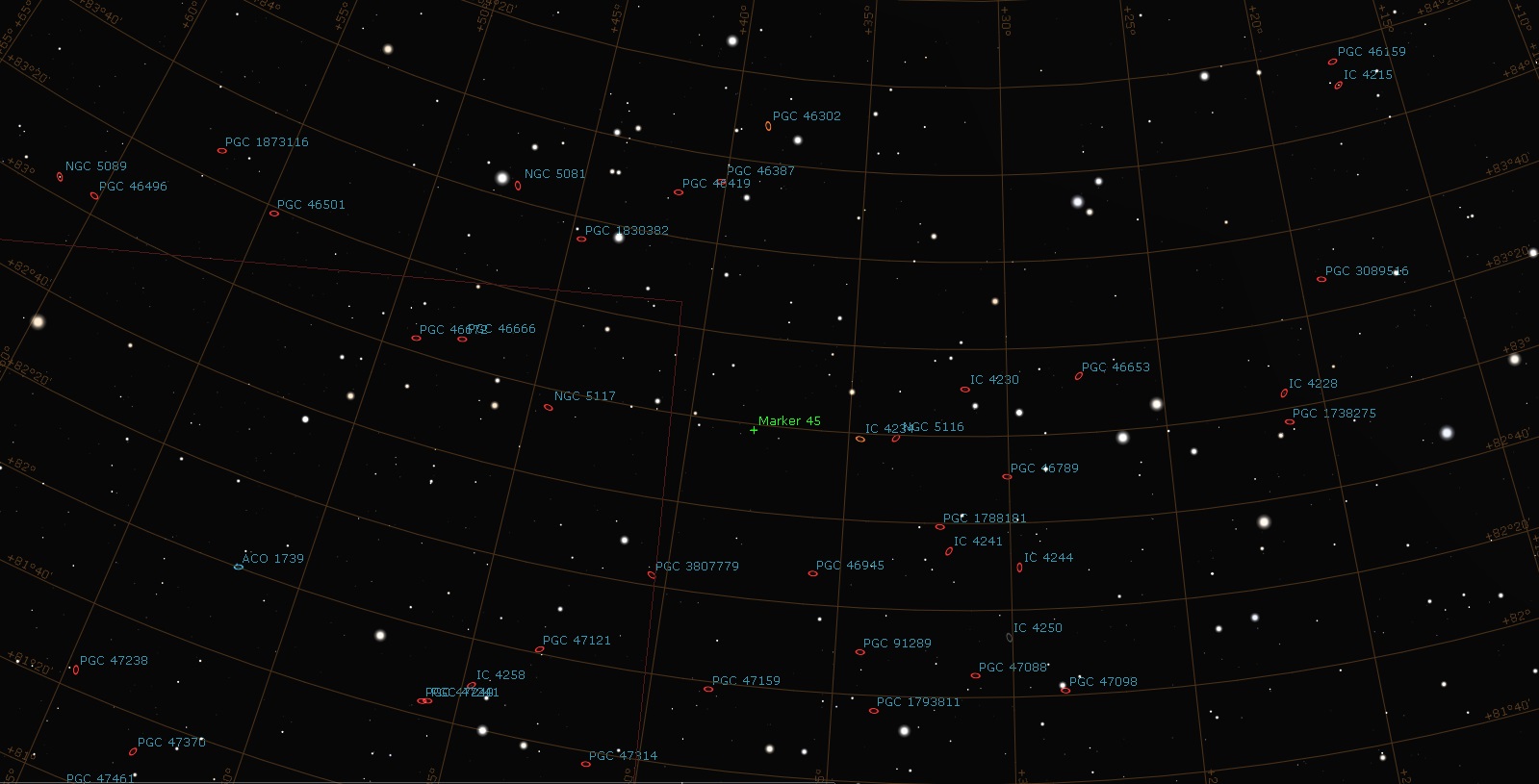
MARKER 45
IOK-1
IOK-1 is a distant galaxy in the constellation Coma Berenices. When discovered in 2006, it was the oldest and most distant galaxy ever found, at redshift 6.96, corresponding to just 750 million years after the Big Bang.
Constellation: Coma Berenices
Right Ascension: 13h 23m 59.8s
Declination: +27° 24' 56?
Redshift: 6.96
Distance: 12.88 billion light-years (3.95 Gpc)
NUMBER SIXTEEN - MARKER 46
CL J1001+0220
CL J1001+0220 is, as of 2016, the most distant known galaxy cluster.
Constellation: Sextans
Right Ascension: 10h 00m 56.96s
Declination: +02° 20' 09.32?
Redshift: 2.506
Distance: 3.40 Gpc (11.1 billion light-years)
Number of Galaxies: 17
NUMBER SEVENTEEN - MARKER 47
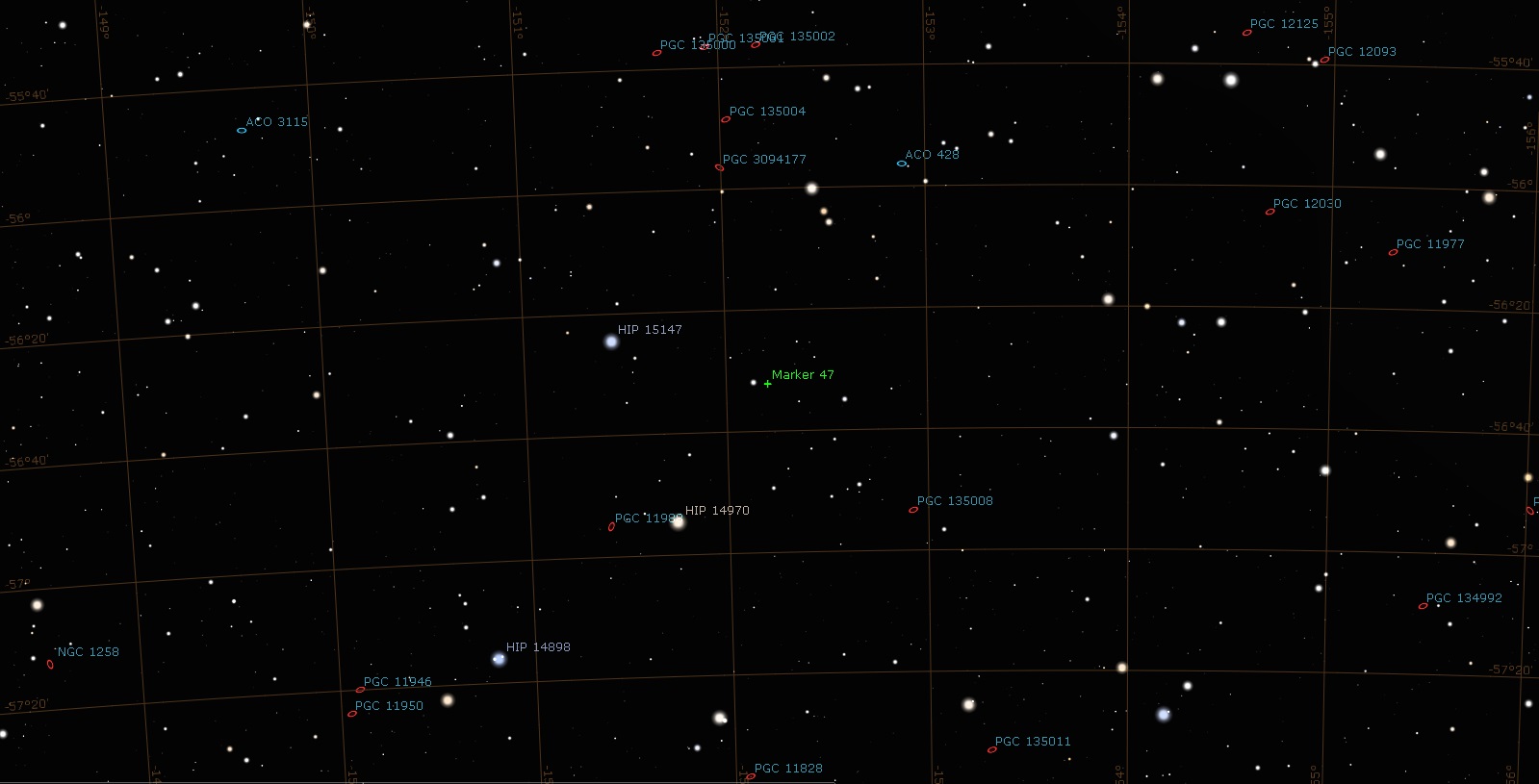
MARKER 47
CMB Cold Spot
The CMB Cold Spot or WMAP Cold Spot is a region of the sky seen in microwaves that has been found to be
unusually large and cold relative to the expected properties of the cosmic microwave background radiation (CMBR).
The "Cold Spot" is approximately 70 µK (0.00007 K) colder than the average CMB temperature (approximately 2.7 K), whereas the root mean square of typical temperature variations is only 18 µK. At some points, the "cold spot" deviates 140 µK colder than the average CMB temperature.
It could be the imprint of another universe beyond our own, caused by quantum entanglement between universes before
they were separated by cosmic inflation. Laura Mersini-Houghton said, "Standard cosmology cannot explain such a giant cosmic hole"
and made the remarkable hypothesis that the WMAP cold spot is "… the unmistakable imprint of another universe beyond the edge of our own."
If true, this provides the first empirical evidence for a parallel universe (though theoretical models of parallel universes existed previously).
It would also support string theory.
Right Ascension: 03h 15m 05s
Declination: -19° 35' 02"
THE BIG BANG STAR IN THE MILKY WAY GALAXY
MARKER 18/48: THE MILKY WAY'S OLDEST STAR
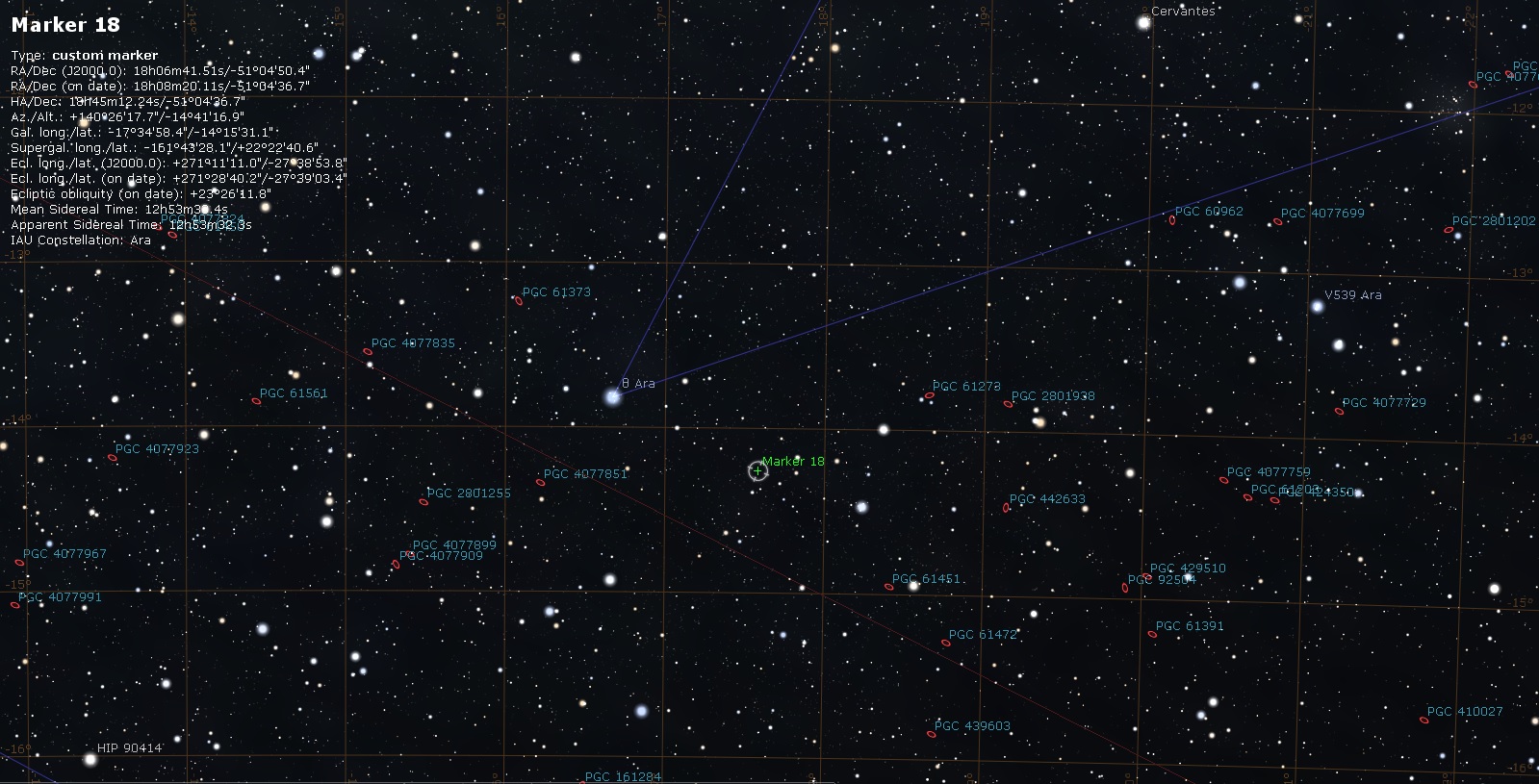
MARKER 18: 2MASS J18082002-5104378
MARKER 18/48
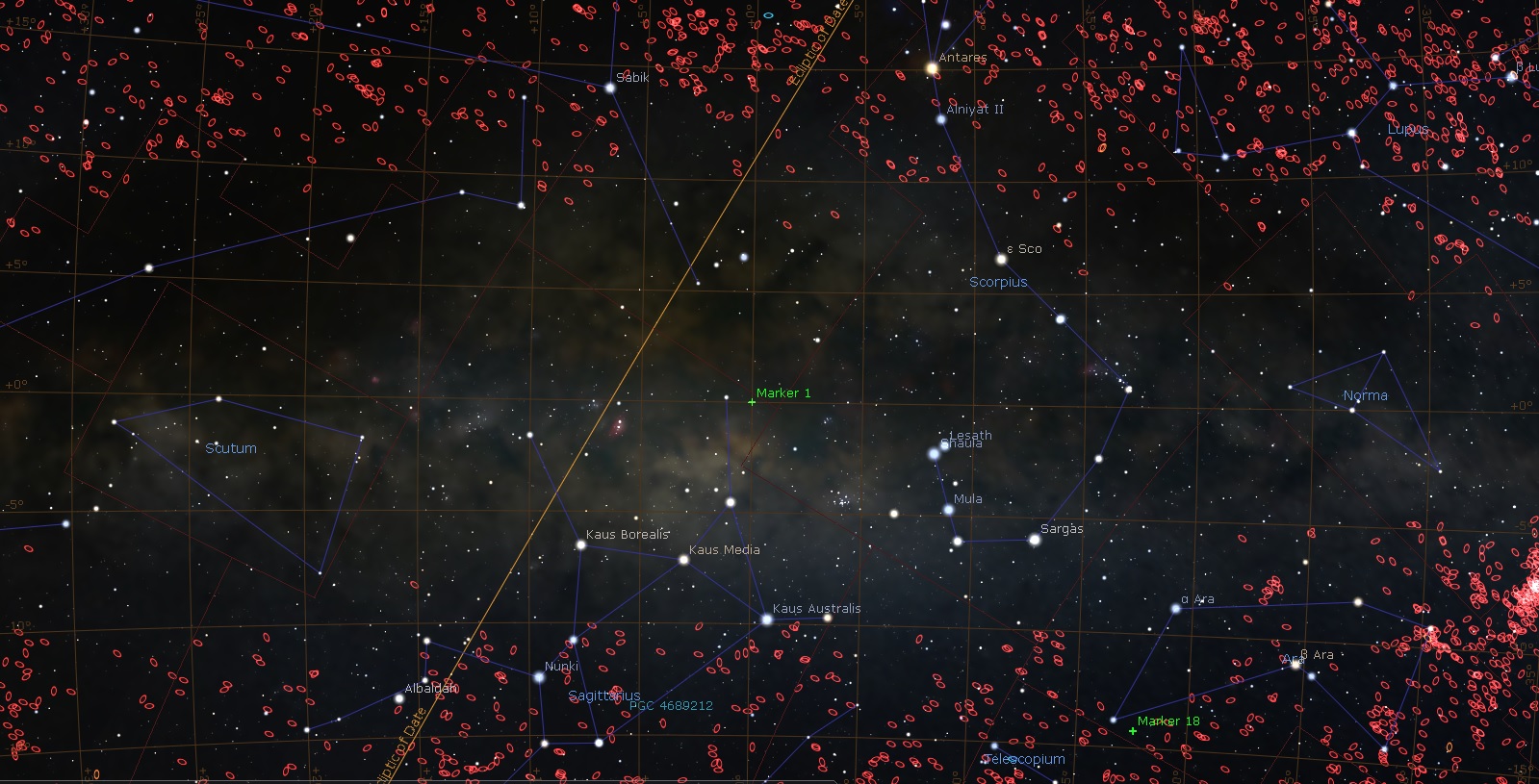
MARKER 18/48: 2MASS J18082002-5104378
Constellation Ara
Right Ascension: 18h 08m 20.02s
Declination: -51° 04' 37.8?
Copyrighted material on this website is cited when possible and for Fair Use in criticism and for public information purposes only.
Contact: TheAgeofDesolation@hotmail.com